Nadir Maguet
Athlete of Centro Sportivo Esercito, last summer he established three new FKTs on three symbolic mountains of the Alps.

The charm of Ortles
A peak whose beauty leaves a deep mark on anyone who tries to conquer it.
UTMB Chamonix
The biggest race in the world and also one of the central moments in the economy of this sport, for better or for worse.
€6
It’s more than a jacket. It’s Athlete Tested, Expedition Proven.




 Christina Lusti / Baffin Island
Christina Lusti / Baffin Island
Recently a dear friend, whose opi nion is worth a lot, accused me of having a sad voice in my last words. Choosing to see things for what they are, dear D., without burying your head in the sand, is to be re alistic, not pessimistic. I believe in the future. I believe in the strength of my generation and in that new born hope sung by Guccini in "God is dead". Because like him I also be lieve that "If God dies, it is for just three days untile he rises again."
I leave you the last letter written by Dheli to another dear friend, M. Hoping you want to publish this food for the soul that has a lot to do with the desire to change and im prove and little with sadness.
"From my last trip to the East, the third in a couple of years, I come back tired. Only if the time ma chine existed, could we still define ourselves as “travelers”? It seems
EDITO
BY CHIARA GUGLIELMINA
that everything is polluted and the air, perhaps, is not the worst of all.
I visited the Lamayuru Monastery, built high, in white painted sto ne and sturdy wood. A white and shiny parallelepiped, perched on crumbly soil, overlooking a basin cracked at the bottom by a river of mud. If it weren't for that hor rendous tar line that follows the murky water over there. Or if you weren't greeted by a listless monk, with a Nike cap on his head, Suzuki keys in his hand, and an Apple Wa tch on his wrist. If they had kept the sandals instead of the Crocs. Or if rather all of us were still able to walk barefoot in the world, perhaps finding an answer to the question "why we exist" would seem easier. When I'm out of breath, I repeat to myself: “remember to breathe”. It is my mantra and often leads me to look for high places. No need to conquer them, it is that at the top it
seems to me to breathe better, and to see further. On this thin crest of stones, a chörten submerged by colored flags is my refuge. Tho se tattered clothes, piled up like everything in India, hit my face. They are slaps, not caresses. I grab one, I'm not an expert but they are certainly held together by polyester fibers. Plastic. I don't want to think about it, I force myself not to, but it seems to me another good excuse to pollute: faith. Buddhism, however, is far older than petroleum deriva tives. I imagine those same prayers painted on cotton cloths, the image of the monk a little while ago, who scrolls through the Facebook feed while stamping my ticket, makes every imagination difficult, but I don't give up.”
And I see a luminous, albeit diffi cult, path to follow. Isn't this then, what going to the mountains mean?

2

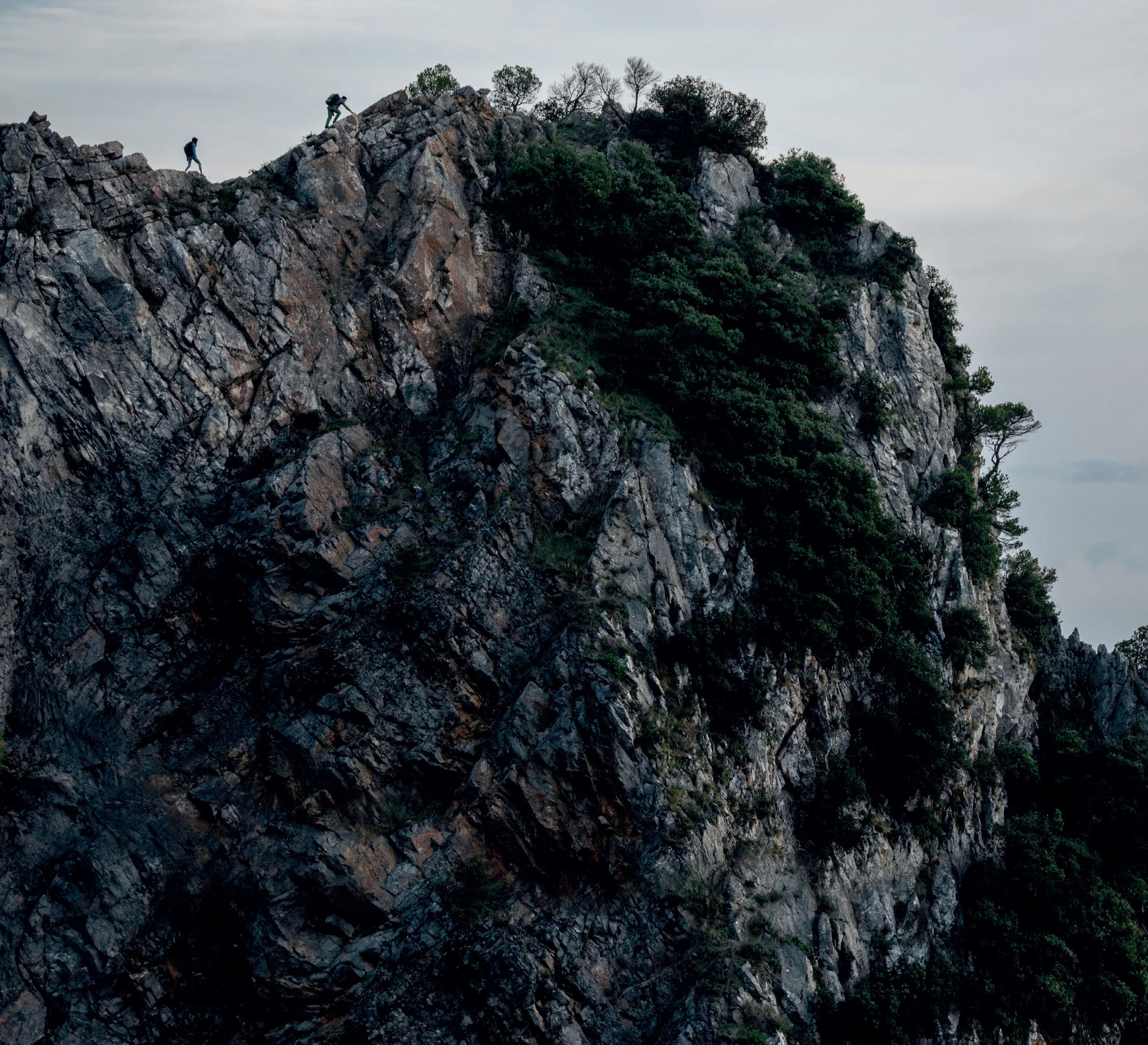






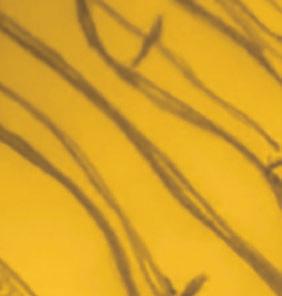









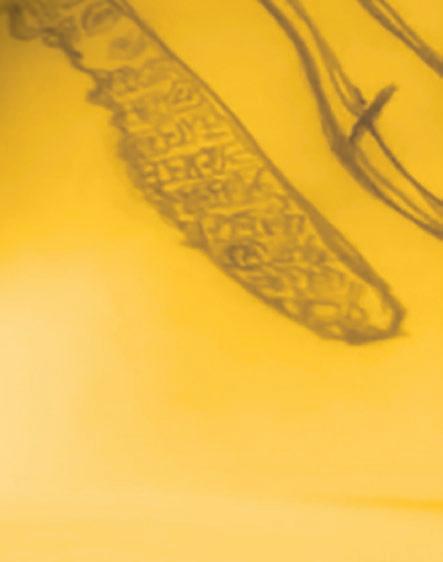
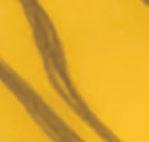
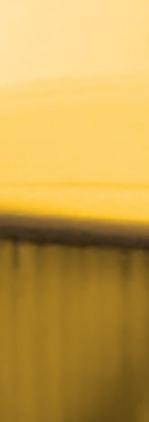

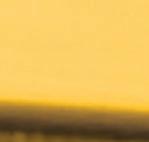


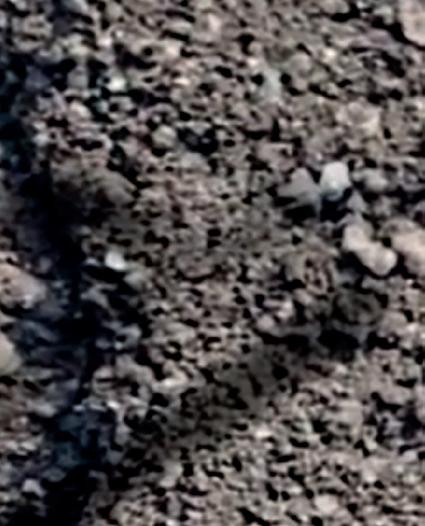

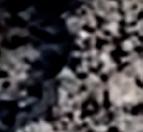










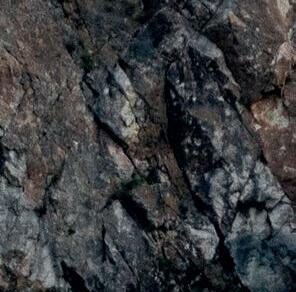

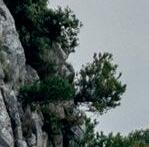
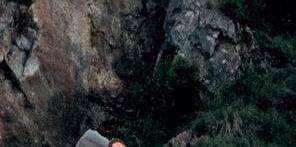


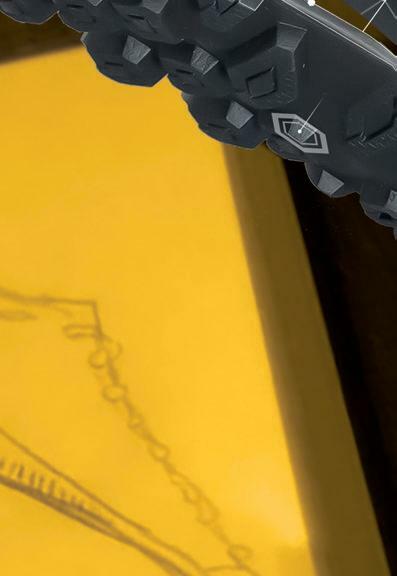


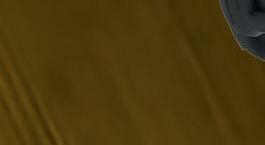







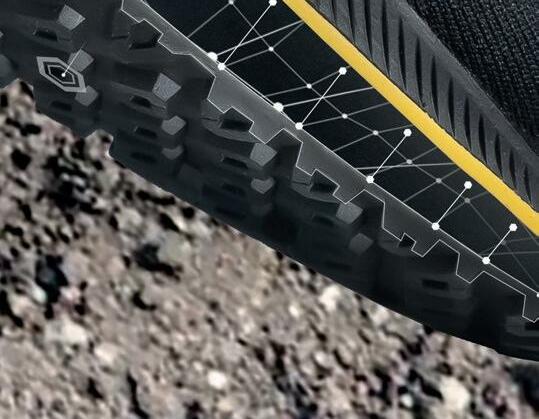

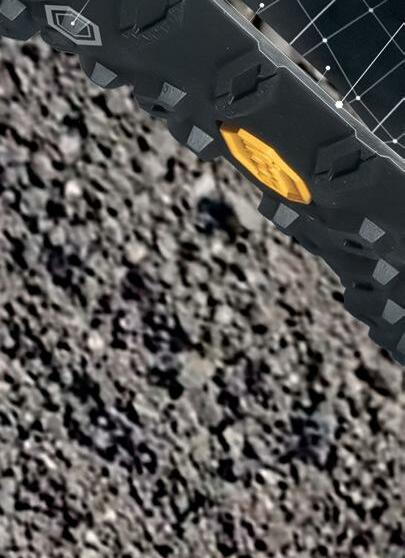
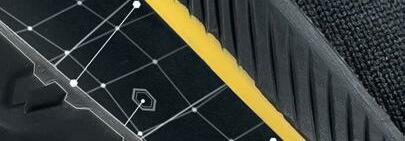




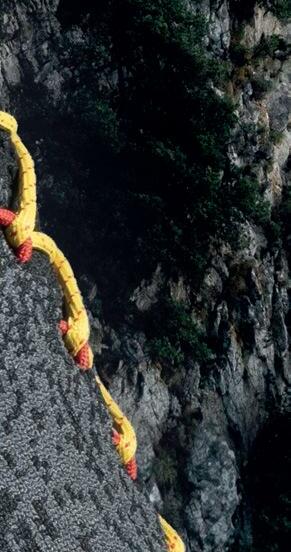




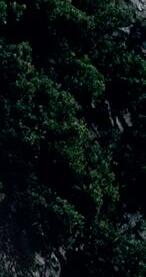
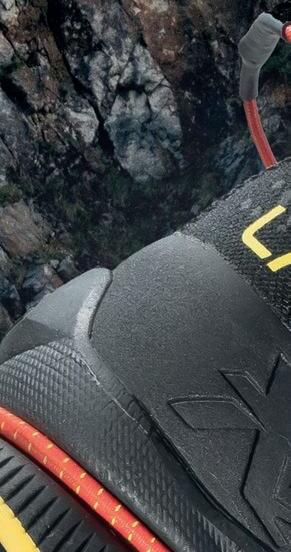



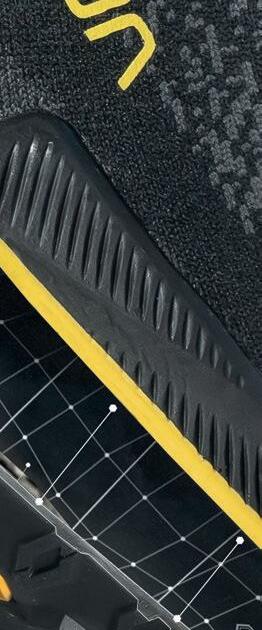



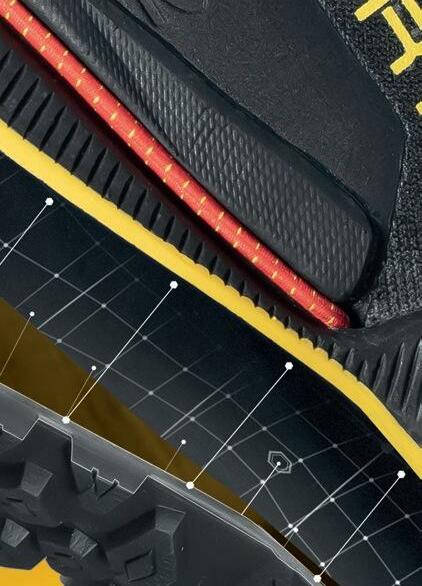










TX2 EVO SHOP NOW ON WWW.LASPORTIVA.COM RESOLE PLATFORM
PRODUCTION
The Pill Agency | www.thepillagency.com
EDITOR IN CHIEF
Denis Piccolo | denis@thepillagency.com

EDITORIAL COORDINATORS
Davide Fioraso, Filippo Caon, Chiara Guglielmina, Ilaria Chiavacci
EDITING & TRANSLATIONS
Silvia Galliani
ART DIRECTION
George Boutall | Evergreen Design House
Niccolò Galeotti, Francesca Pagliaro
THEPILLMAGAZINE.COM
Ludovica Sacco | ludovica@thepillagency.com
PHOTOGRAPHERS & FILMERS
Matteo Pavana, Thomas Monsorno, Camilla Pizzini, Chiara Gugliel mina, Silvia Galliani, Francesco Pierini, Elisa Bessega, Andrea Schi lirò, Denis Piccolo, Achille Mauri, Simone Mondino, Alice Russolo, Patrick De Lorenzi, Giulia Bertolazzi, Tito Capovilla, Luigi Chiurchi, Isacco Emiliani, Pierre Lucianaz

COLLABORATORS
Filippo Caon, Chiara Guglielmina, Marta Manzoni, Sofia Parisi, Fabrizio Bertone, Eva Toschi, Luca Albrisi, Luca Schiera, Giulia Boccola, Valeria Margherita Mosca, Lisa Misconel
SHOP & SUBSCRIPTIONS
SHOP MAGAZINE MAP
COMPANY EDITOR
Communication, Via Piave 30, Saluzzo CN 12037, Italy
COVER Federico Epis Salewa Ortles Jacket
PRINT
Savigliano, Savigliano - Cuneo - Italy, lartisavi.it
DISTRIBUTION
copies distribuited in 1100 shops in Italy, Switzerland, Austria, Germany, France, Belgium, Spain, England & The Netherlands
ADVERTISING
FOLLOW US
Instagram.com/thepilloutdoor
333.7741506
The Pill rivista bimestrale registrata al
Milano
4 THE CREW
PHOTO
FEDERICO MODICA
www.thepilloutdoorshop.com
www.thepilloutdoor.com/magazine-finder
Hand
hello@thepillagency.com
L'artistica
25.000
hello@thepillagency.com | +39
www.thepilloutdoor.com www.facebook.com/thepilloutdoot
tribunale di
il 29/02/2016 al numero 73

THE LIGHTEST SPEED TOURING SYSTEM LIGHT

6 ISSUE 57 PHOTO TUCKER PRESCOTT THE DAILY PILL BEST MADE KILLER COLLABS ECO SEVEN MIZUNO WAVE NEO KAYLAND STELLAR CAMPZERO SLOW TRAVEL BLACK DIAMOND GLOVES CHIARA GUGLIELMINA STEFANO GREGORETTI AL TOR CON SCARPA ANDREAS REITERER P.8 P.12 P.16 P.20 P.24 P.26 P.28 P.32 P.36 P.40 P.42 P.46 P.50 P.54 P.58 P.64 P.70 P.74 P.82 P.90 P.96 P.104 P.112 P.120 P.130 P.142 FJALLRAVEN CLASSIC FREE TO RUN THROUGH THE FOREST 4T2 GONE RUNNING WESTERN STATES FROM ROCKS TO WAVES DOLOMITI DI BRENTA TRAIL A MARRIAGE WITH TOR MAIRA OCCITAN TRAIL THE CHARM OF ORTLES NADIR MAGUET UTMB CHAMONIX VAST LADAKH
The new shoe for rough terrain, powered by Carbon

“With these rockets on my feet
get used to going faster, quick to my dreams” Manuel Merillas, Mont Blanc and Monte Rosa
with Golden Gate Kima
August
Rebound
Technology.
I
FKT
RT,
2021. SCARPA.COM GOLDEN GATE KIMA RT THE ALPINE ELEVATOR.
PILL
BY LUDOVICA SACCO
ATOMIC EXCLUSIVE TECHNICAL SPONSOR OF SCI CLUB CORTINA
Sci Club Cortina and Atomic continue the collaboration started two years ago, in 2020. The Austrian company will continue to be a supplier of technical equipment for ath letes, members and coaches: skis, boots, bindings, but also goggles and accessories such as protections, backpacks, bags and pouches. Furthermore, starting from the 22/23 season, Atomic will also support cross-country skiing athletes with a specific program for whom dedicated material has been provided. A successful team, with the same values of passion and competition, which will remain linked until 2024.
NATURE BATHING, THE NEW ASICS COLLECTION
ASICS has launched Nature Bathing, its first hybrid collection with road running shoes redesigned for off road. The line is inspired by the Japane se phrase "shinrin-yoku" that means "walking in a forest to seek peace of mind", a concept known in many cultures as nature bathing. The collection includes four men's and women's shoes: Novablast 3 TR, Gel-Nimbus 24, Gel-Cumulus 24 TR and the GT-1000 11 TR. The line is completed with a head-to-toe look with a long-sleeved shirt and running shorts for men, and a high-waisted cyclist-cut top and trousers for women.
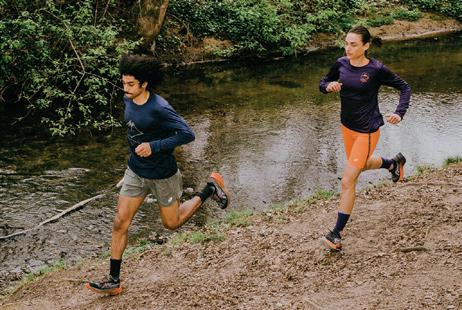
THE NORTH FACE X URBAN WALL
On Wednesday September 21st, 2022, the climbing gym Urban Wall, based in Pero, near Milan, saw many enthusiasts gather to climb together, challen ge each other in the boulder and lead marathons and, above all, test the new Urban Tower structure thanks to the event organized by The North Face. Urban Wall has become the first Italian climbing gym chosen by The North Face for a collaboration of this type and the two have joined forces to create a unique event, in the presence of The North Face athlete Stefano Ghisolfi.

ORTOVOX: ZERO IMPACT FOR WINTER 2023
Ortovox has announced its ski mountaineering and freeride collections for winter 2023, both defined as carbon neutral. The impact of their production is minimized and compensated, from the production of the raw material to the production and distribution chain. This comes as the result of years of work, in particular starting from 2018 when the internal ProtACT 2024 project was launched which defines the brand's carbon impact reduction and compensation aim. These goals have already been achieved for this sea son, 18 months ahead of schedule.


FACTION SKIS BECOMES B CORP CERTIFIED
Faction is a company that intends to best respect social and environmental performance standards with the utmost transparency and responsibility. This commitment was recognized through the B Corp certification: the com pany, in fact, passed the evaluation criteria regarding its approach to wor kers, consumers, suppliers, communities and the environment, obtaining a score of 93.5 and exceeding the 80 points required. Faction earned a large part of the score because it produces skis in a 100% renewable energy facility, reducing the product's carbon emissions by nearly 50%.
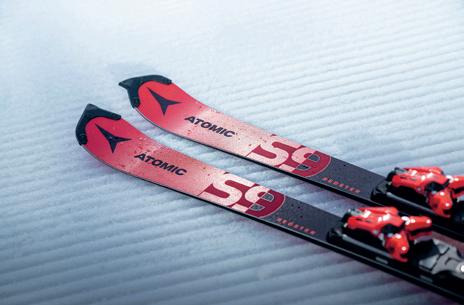
8
THE DAILY
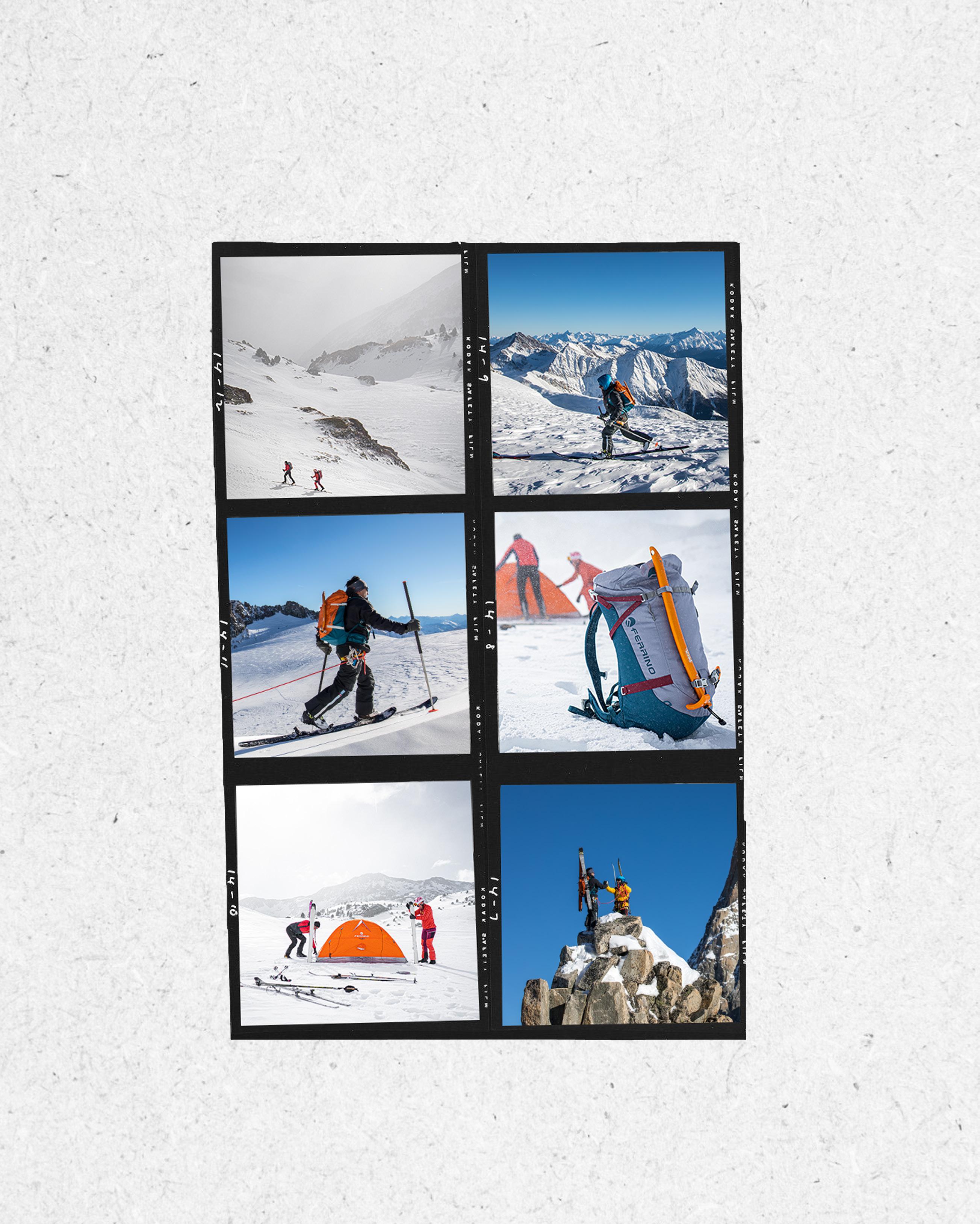
 BY LUDOVICA SACCO
BY LUDOVICA SACCO
YVON CHOUINARD SELLS PATAGONIA TO THE PLANET

“Our only shareholder is now the planet”: these are the first words of Yvon Choui nard in his letter in which he announces to the world that he will sell his company to save the planet. In the letter he writes: “We were doing our best to fight the environmental crisis, but unfortunately it wasn't enough.” Chouinard's so lution was therefore to sell 100% of the voting shares to the Patagonia Purpose Trust, created to protect corporate values. 100% of the non-voting shares, on the other hand, will go to Holdfast Collective, a nonprofit association that is committed to fighting the environmental crisis and defending nature.
FERRINO AND THE “CAMMINAUTISMO A SANTIAGO 2022” PROJECT

Also this year the Camino de Santiago ended and with it the "CamminAu tismo a Santiago 2022", an initiative of the children of the Mulino Sambuy association of San Mauro Torinese. The project involved the children, their families and their educators along the final 114km of the Way, or the last six stages. Ferrino, based in the same municipal area, has decided to enthusia stically support the initiative by equipping the group at best with Finisterre backpacks, the brand's iconic product.
NORTHWAVE CELEBRATES RIDERS WITH #RIDEYOURWAY
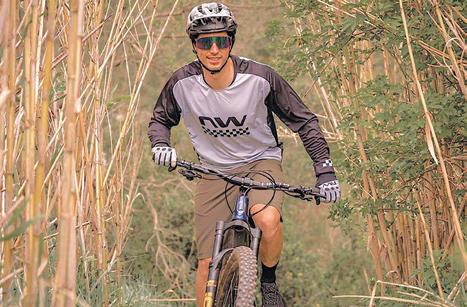
Northwave celebrates riders who love to experience sport outdoors and in nature, a context that allows everyone to develop their own riding style. The brand does this through a series of documentaries on YouTube called #Ri deYourWay, which will feature some of the best riders in the world, whether they are riding a MTB or drawing the best powder lines with their snow boards. In this way, Northwave encourages all riders to express their style, explore their creativity and never lose their passion for these disciplines.
THE TASTE OF WALKING: THE COLLAB BETWEEN SCARPA AND SLOW FOOD EDITORE
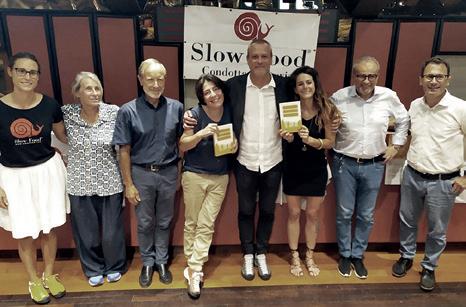
“The taste of walking” is the new book by Slow Food Editore in collaboration with Club Alpino Italiano and the outdoor footwear company SCARPA, dedicated to those who choose to discover our country and its rich gastronomic and naturalistic culture at a slow pace. This book contrasts two gestures characterized by slowness, such as walking and tasting, today almost subversive and unconventional, against such a frenetic daily life. Rediscovering them, however, will allow us to enhance the small details, to expand the wonder of every moment and restore intensity to life.
ON EXPANDS ITS RANGE OF OUTDOOR SHOES
On recently updated its collection of outdoor shoes, introducing Clou dwander Waterproof, Cloudvista Waterproof and Cloudrock 2 Water proof. In addition, it has improved its Missiongrip technology used in the outsoles, now with greater grip and traction on all terrains. Olivier Withworth, footwear developer at On, says: “The new Missiongrip is our best performing adhesive rubber. Its wet grip has been improved by 30% while maintaining a highly abrasive compound. It is a real game changer that places us at the level of other market leaders.”

10
THE DAILY PILL

1.BARBOUR
RHOBELL FLANNEL OVER SHIRT

The beginning of the cold season marks the return of flannel, a soft and comfortable fabric with a twill weave. The Rhobell shirt features a blend of 67% cotton and 33% polyester, with a brushed finish that gives it a worn look right from the first use. Bold check pattern with corduroy patches and edges.
4.RUMPL
B EER BLANKET
Cold beer? Good. Cold hands? Bad. Rumpl took care of this with the drink blanket in 100% post-consumer recycled polyester with a stain resistant DWR finish. And once you're done drinking (responsibly), you can sque ezes it into its pocket. Available in do zens of designs, it fits all 33 or 50cl cans.
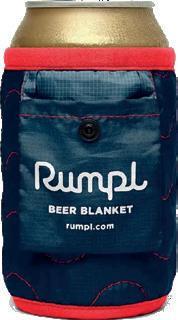
MADE
2.CAMELBAK
M ULTIBEV 2-IN-1

The ultimate solution: thermos, water bottle and travel mug in one product. For coffee in the morning, water du ring the day and a beer outdoors. Dou ble-walled insulated stainless steel ke eps drinks hot for 14 hours or cold for 20. The Roll and Fold folding lid fits into the Pak stopper and disappears as long as you don't match it with the pull-out cup.
5.DJI
O SMO ACTION 3
Push every adventure to the limit with Osmo Action 3. All-new quick release design for quick horizontal or vertical installation and a dual touchscreen (front/rear) for convenient parameter and playback control. Improved capa bilities in terms of cold resistance, bat tery life and waterproofness.
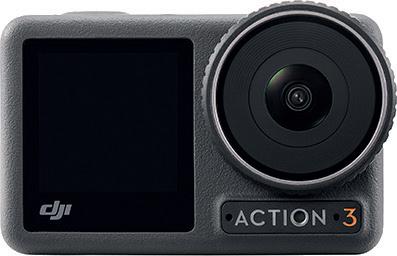
3.LA SPORTIVA
T X 2 EVO
The lightest shoe in the Traverse X ap proach series: it meets the needs for grip, protection, minimum bulk and lightnweight required in technical approaches and during multi-pitch routes. It adopts a sole package with a 100% resolable tread that doubles its life cycle and uses recycled materials for a lower environmental impact.

6.ZIPPO
FIRE STARTING MULTI TOOL
Z ippo Fire Starting has everything you need to start a fire reliably, qui ckly and easily. This compact multi tool includes a flint wheel, 38cm of fire paracord, carbon steel blade, double-edged saw blade, flathead screwdriver, bottle opener and a small space to deposit the flint.

12 1. 2. 3. 4. 5. 6. BEST
BY DAVIDE FIORASO
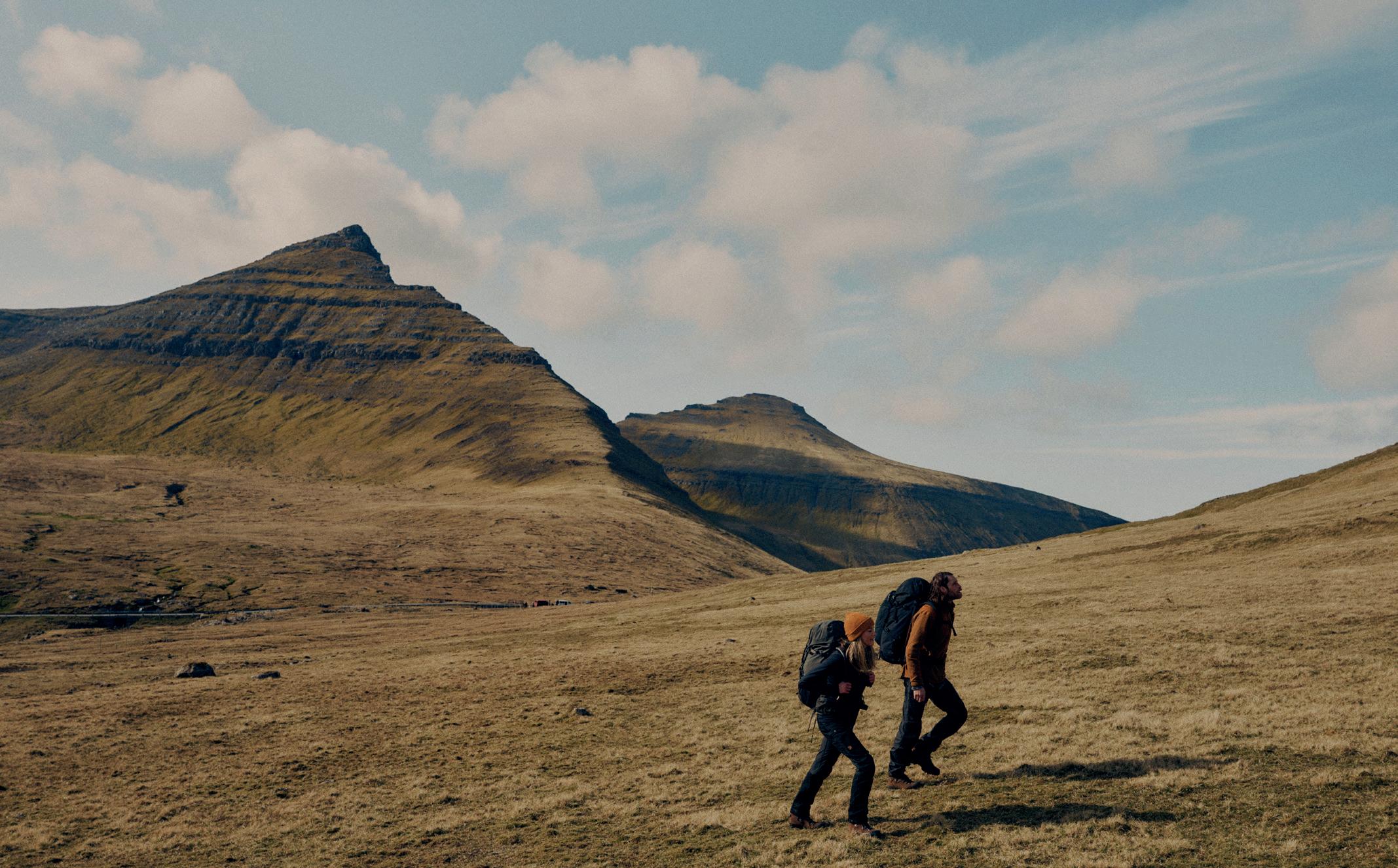
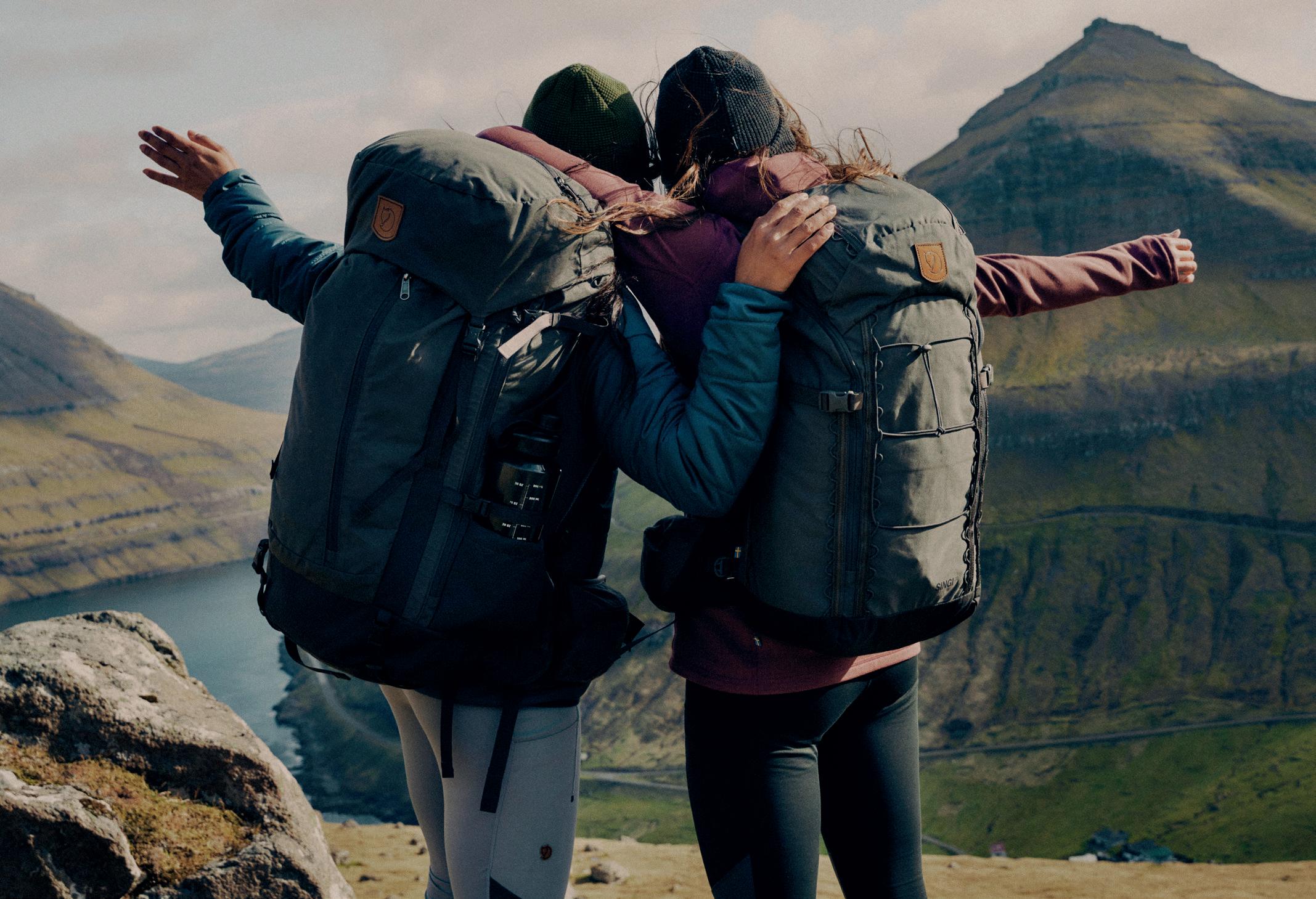
www.fjallraven.com
7.SALEWA FANES ENGINEERED AL
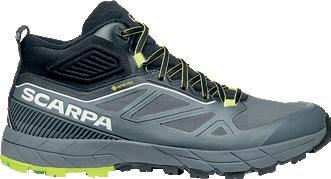
PINE MERINO HYBRID JACKET - WOMEN
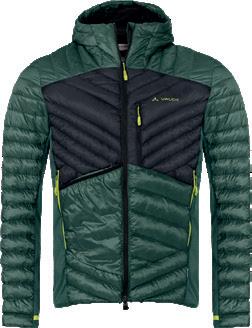
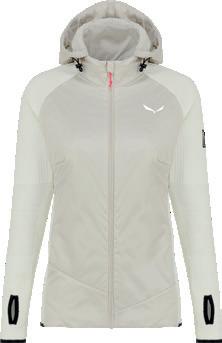
Made with over 50% natural fibers, engineered to create a breathable gar ment that offers effective protection from cold and wind. In addition the TirolWool Responsive padding recycles the heat emitted from the body. The micro-waffle structure of the sleeves ensures a pleasant soft ness and elasticity.
10.VAUDE
SESVENNA PRO JACKET
Thermal jacket developed for ski touring and mountaineering, ideal for low temperatures. HeatSphere Eco synthetic insulation techno logy formed by soft spheres made with 100% recycled PET bottles. Functional hybrid construction to ensure excellent breathability and a comfortable fit.
MADE
8.THE NORTH FACE

B ASE CAMP VOYAGER LUNCH COOLER
M ade with the iconic Base Camp Voyager fabric (durable, water-re sistant and completely recycled), this lunch box features a large com partment with zip and top handle for storing, carrying and keeping food and drinks cool. An internal mesh section allows you to separate objects.
11.SOLO STOVE

M ESA TABLETOP FIRE PIT
The latest addition to Solo Stove is called Mesa, a table brazier that enhances the aesthetics of any out door space. It allows anyone to expe rience a crackling and smoke-free fire thanks to the Signature 360° Airflow system and the Dual Fuel power sup ply that allows it to work with pellets or traditional wood.
9.MIZUNO W AVE NEO WIND

Recycled PET, Bio-based PEBAX mid sole, Bloom algae infused insole. With 60% eco-friendly materials (and 100% water saved in the coloring process), Neo Collection is the most sustainable footwear line in Mizuno's history. Wave Neo Wind is the version desi gned to provide maximum propulsion in the transition phase.
12.SCARPA
R APID MID GTX
Approach shoe designed following the Fast & Light philosophy to move qui ckly on mountain terrains with the right support and protection. A light, versati le and flexible model that represents the meeting point between hiking, running and climbing shoes. 3D Autofit collar that wraps around the ankle accom panying it in its movements.
14 7. 8. 9. 10. 11. 12. BEST
BY DAVIDE FIORASO

1.HELLY HANSEN X SEIKO
PROSPEX SBDC181

Taking inspiration from its Tactician Gore-Tex Race Jacket HH12050, Hel ly Hansen collaborated with Seiko for this limited edition based on the 1970 Mechanical Divers Willard mo del. The e watch, called Prospex 1970 Mechanical Divers SBDC181, will be available in just 550 units.
4.ROARK RUN AMOK X MOTÖRHEAD BOMMER 2.0 SHORT 7”

Roark announces its first collection born from the encounter between music and running: 14 technical garments that em body the style of Run Amok and the Bri tish heavy metal group Motörhead: un bridled chaos and freedom to move at your own pace. Bommer 2.0 is the most versatile eco-friendly short of the series made from Repreve recycled polyester.
KILLER COLLABS
2.PUMA X TRACKSMITH
SPEED CITY SINGLET

With a truly exclusive capsule Puma and Tracksmith celebrate the legacy of Speed City, the program of the State University of San Josè that in the mid-20th century forged medal machines such as Tommie Smith and John Carlos. Classic looks reinvented in technical fabrics and mo dern silhouettes, like the tank top with dryCELL anti-humidity technology.
5.MATADOR X VOLCOM
FREERAIN 22 PACKABLE BACKPACK
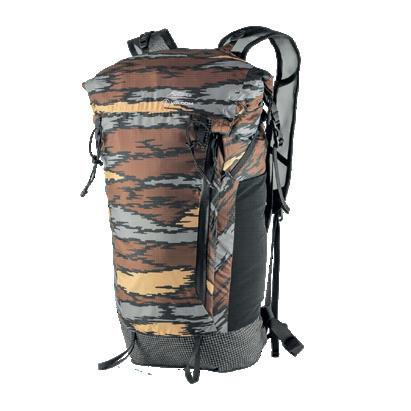
Building on the successful 2021 colla boration, award-winning travel equi pment manufac-turer Matador and Volcom, the iconic board sports brand, have announced the new Bark Camo collection, a robust product assort ment that includes Freerain22, a hi gh-performing, waterproof and com pressible, ideal for travel.
3.SALOMON X TEMPLIN
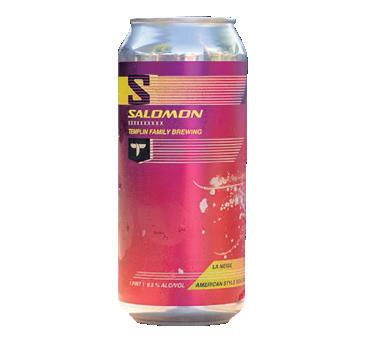
FAMILY BREWING LA NEIGE IPA
Salomon North America and T.F. Brewing, a family-owned brewery based in Salt Lake City, presented La Neige, an easy-to-drink West Co ast-inspired IPA featuring Cascade and Strata hops. Produced to celebra te the 75th anniversary of the French brand, a percentage of the proceeds will go to Protect Our Winters.
6.KITH X BIRKENSTOCK
ARIZONA SHEARLING
The beloved Birkenstock Arizona in suede is shown in a particularly comfortable and soft winter version, thanks to the natural lamb fur pre sent in the insole and in the inner lining of the straps. Exclusive Mink/ Dark Brown version by Kith, a New York brand with 7 flagship stores un der its belt.

16 1. 2. 3. 5. 6.
BY DAVIDE FIORASO

www.4T2.run
7.INJINJI X KNOCKAROUND

P REMIUM SPORT SUNGLASSES

An all-Californian collaboration between Injinji and Knockaround, a sunglasses brand founded in 2005 by Adam Moyer. The Sorrento Valley li mited edition presents Premium Sport, a unisex model for outdoor activities equipped with a non-slip rubberized frame and nose pad and impact-resi stant UV400 polarized lenses.
10.FILSON X BUCK
104 COMPADRE CAMP KNIFE
Filson and Buck Knives, two iconic brands with more than a century of history. From the Pacific Northwest co mes an all-round knife for lovers of the outdoors: hollow teardrop blade in 5160 spring steel with Cerakote finish that protects against rust and corrosion. Micarta handle impermeable to water and sweat. Personalized leather sheath.

KILLER
8.ELEMENT X MILLET

CONCRETE JUNGLE COLLECTION
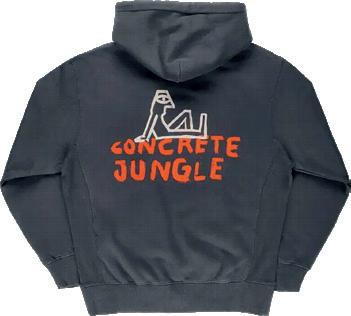
Element, the skateboarding brand that gravitates in the orbit of the American giant Boardriders, has joined Millet in a multifaceted and attractive collection for next fall/ winter season. Products designed to mix streetwear, climbing and outdo or activities, with a widespread use of recycled materials.
11.TOPO DESIGNS X REDINGTON FLY FISHING KIT
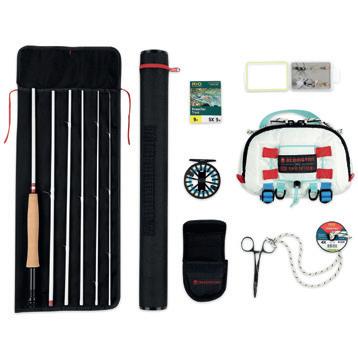
A sensational kit dedicated to anyone who wants to always carry a fly rod with them. Thanks to the meeting with the Far Bank brand specialized in fly fishing, the Mountain Hip Pack by Topo Designs is completed with a 6-piece rod, pre-spooled Redington Zero Fly Reel, set of 6 dry flies, fly box, leader and final.
9.HAPPY SOCKS X WWF
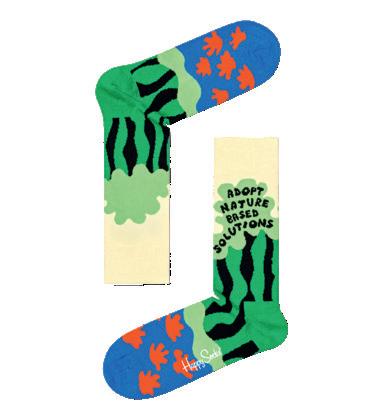
ADOPT NATURE BASED SOLUTIONS SOCKS
Wear on your feet a slogan that looks to the future. The new Happy Socks collection, made of organic cotton and recycled polyamide, highlights the ef forts made by the WWF, paying homa ge to the most recent trends and to the most important steps in its work to pro tect the environment. Until 2024 Happy Socks will allocate 10% of sales to WWF.
12.ATHLETIC BREWING COMPANY X KANE FOOTWEAR EVINE
Athletic Brewing Company, one of TI ME's 100 most influential companies of 2022, joins Kane Footwear for a partner ship that symbolizes shared commit ment to making the world a better place. Revine, with BounceBack foam derived from sugar cane, is inspired by the colo ring of Run Wild, the non-alcoholic IPA Made in Connecticut.
18 7. 8. 9. 11.10. 12.
COLLABS BY DAVIDE FIORASO

ECO SEVEN
BY DAVIDE FIORASO
C ONSERVATION ALLIANCE LAUNCHES THE 2022 CONFLUENCE PROGRAM
The Conservation Alliance (TCA), an organization that har nesses the collective power of business to support the pro tection of the wild areas of North America, has announced the launch of the 2022 Confluence Program. TCA will award 4 multi-year grants to groups led by communities histori cally excluded from the racial point of view. Each benefi ciary will receive $50,000 in 2022 and an additional $50,000 in 2023 to support efforts to protect and conserve land and water by promoting a planet where natural places, wildlife and people can live together.
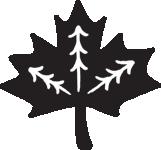

T HE OBERALP GROUP P RESENTS PRODUCTS MADE WITH HEMP

O n the occasion of an intersectoral event on the theme of hemp, the Oberalp Group presented the Alpine Hemp collection by Salewa. For several years, the sports brand and some partner companies have been collaborating on the project to bring back and rediscover industrial hemp, with the aim of returning to cultivate it in South Tyrol and North Tyrol and process it from stems to seeds, as it was done in the past. To achieve autonomous production to be integrated into its product line, the company has cal culated a time period of 10 years.
T HE NEW GORE-TEX CAMPAIGN SHOWS T HE COMMITMENT TO SUSTAINABILITY
The Fabrics division of W. L. Gore & Associates has intro duced a new Gore-Tex campaign titled "Our Work is Ne ver Done". Created by the Berlin studio AKQA, and laun ched on digital channels around the world, the campaign celebrates the introduction of new Gore-Tex products in the AW22 season, showcasing four decades of innovation from the textile division. The new slogan "Going further, together" introduces innovations that will represent a mi lestone in the current path of responsibility and sustaina bility of the company.
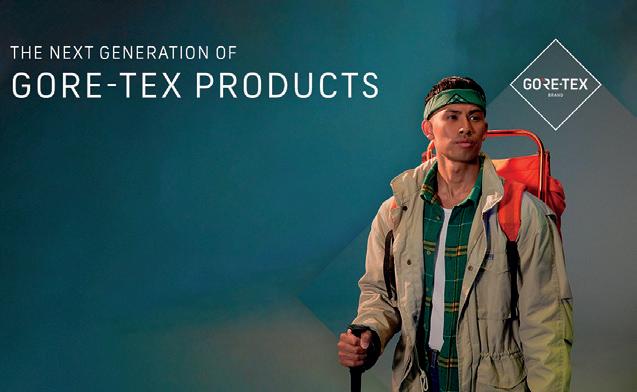
20
NEW SESSION GLOVES
133g PrimaLoft® Gold Cross Core insulation on the back, 60g PrimaLoft Gold Eco Insulation with Grip Control on the palm
Goat leather construction is the perfect blend of durability and flexibility
The single piece knit cuff features a custom blend of yarns, creating a revolutionary construction that perfectly blends weather resistance, dexterity, warmth and maximum breathability
THE SESSION
By combining engineered knit technology that’s water resistant, stretchy and breathable with premium goat leather construction and PrimaLoft® Gold Cross Core insulation, the Session Knit Glove offers best-in-class dexterity and performance while maintaining maximum comfort for everyday shredders.
SHOP NOW AT BLACKDIAMONDEQUIPMENT.COM
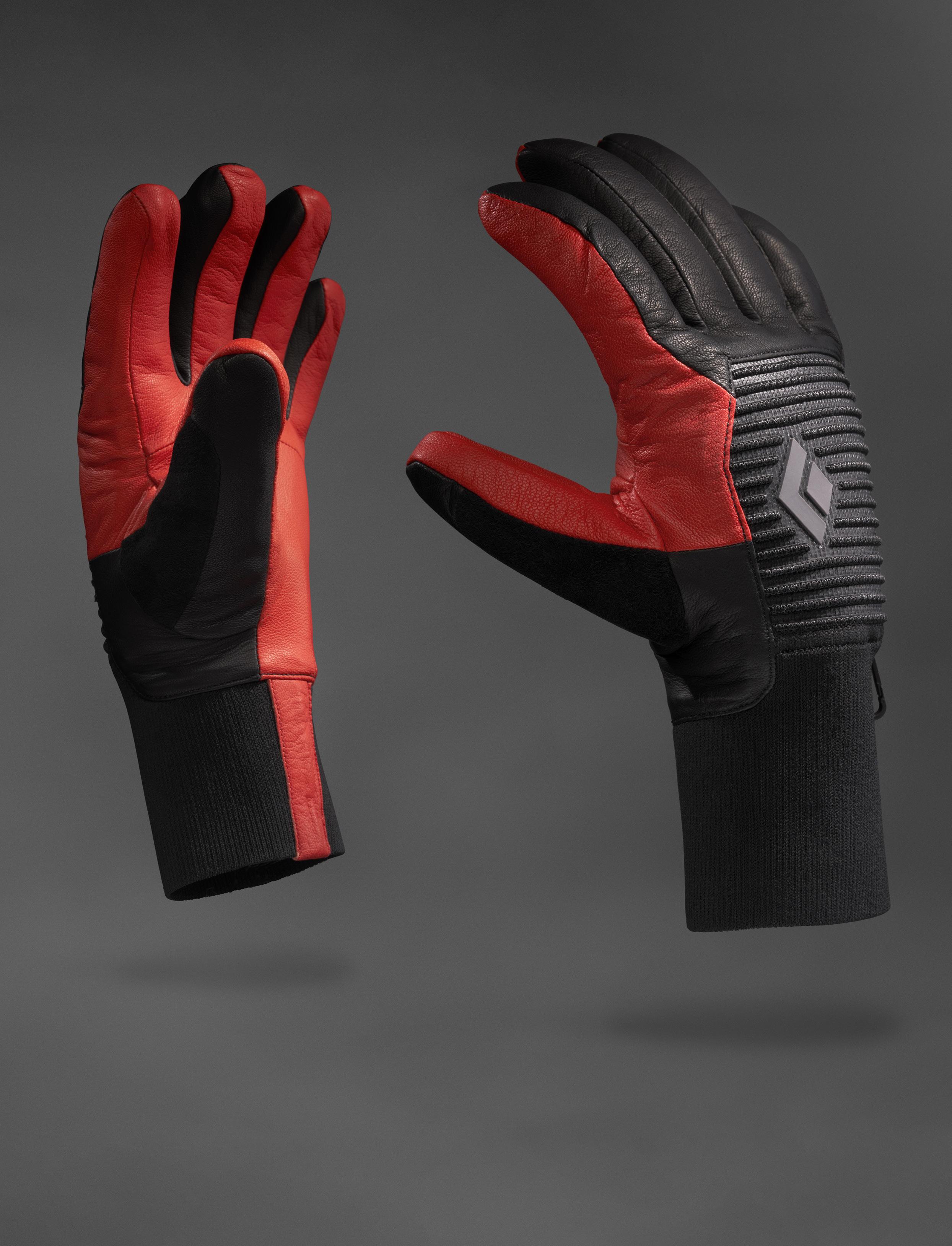
ECO SEVEN
BY DAVIDE FIORASO
N ORRØNA AIMS TO REDUCE T HE ENVIRONMENTAL IMPACT THROUGH AN AMBITIOUS ROADMAP
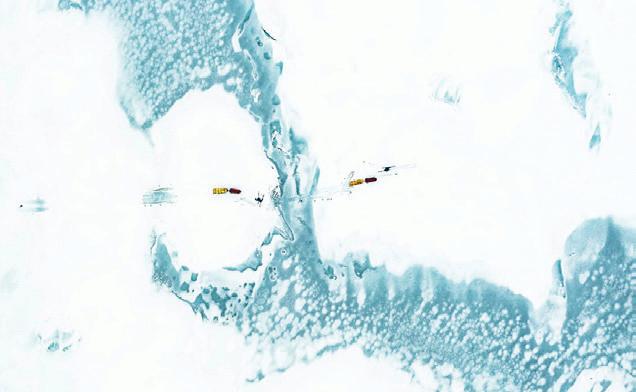
The Norwegian brand has announced its line of action towards change in environmental and social responsibili ty: 10 transparent and ambitious goals that will involve all parts of the company, aligning itself on the occasion of its centenary. The roadmap takes into account the entire value chain, regarding issues relating to the ecological footprint, materials, traceability, proper land use, biodiversity, waste, animal freedom and working conditions. Details of the 2029 Roadmap can be found at www.norrona.com.
J ACK WOLFSKIN INTRODUCES ZERO TAPE TECHNOLOGY IN ITS NEW TAPELESS JACKET
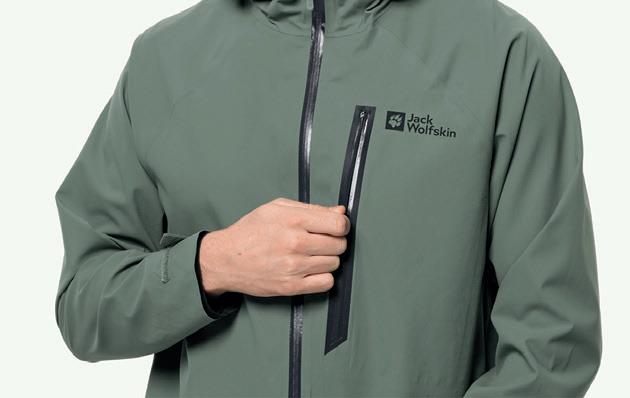
Waterproof, even without taped seams. Jack Wolfskin, one of Europe's leading outerwear manufacturers, updates its line of sustainable products with the Tapeless jacket, whi ch removes approximately 18 meters of tape from each garment. The weight of the seam tape (and the glue used to hold it in place) limits the breathability, mobility and durability of the products. Jack Wolfskin's Zero Tape tech nology is an innovative solution that creates an even more breathable alternative to seam tape with premium comfort and performance.
D OLOMITE RENEWS THE AGREEMENT W ITH NATURE TOGETHER WITH THE T RENTINO TREE AGREEMENT PROJECT
As a commitment to practice and communicate a sustainable life style, Dolomite renews the pact with nature in collaboration with the Trentino Tree Agreement, the fundraising project promoted by the Autonomous Province of Trento for the recovery of the wo ods destroyed by the "Vaia" storm. Dolomite not only financially supports the project, but through wider cooperation it will provi de a voice and an image with the aim of raising awareness among current and future generations. The project starts from the recon struction of the woods as a propeller of a wider and deeper change.
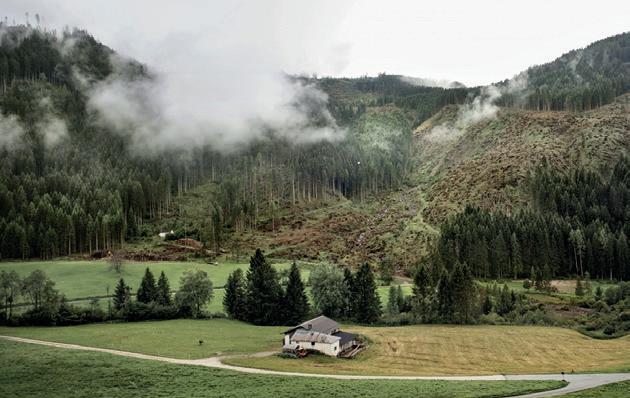
R ECORD DONATION FROM THE FOUNDER OF LULULEMON TO BC PARKS FOUNDATION
Dennis "Chip" Wilson and his wife Summer donated a re cord $100 million to the BC Parks Foundation to protect and enhance the wilderness of British Columbia. The donation, announced during an event at Stanley Park in Vancouver, will be part of the multi-year 25x25 campaign and immedia tely used in three ecosystems: the Falling Creek Sanctuary, the Teit Sanctuary and the Bourguiba Springs. The Canadian billionaire and philanthropist is the founder and former CEO of the athleisure brand Lululemon and has stakes in the mul tinational company Anta Sports.

22


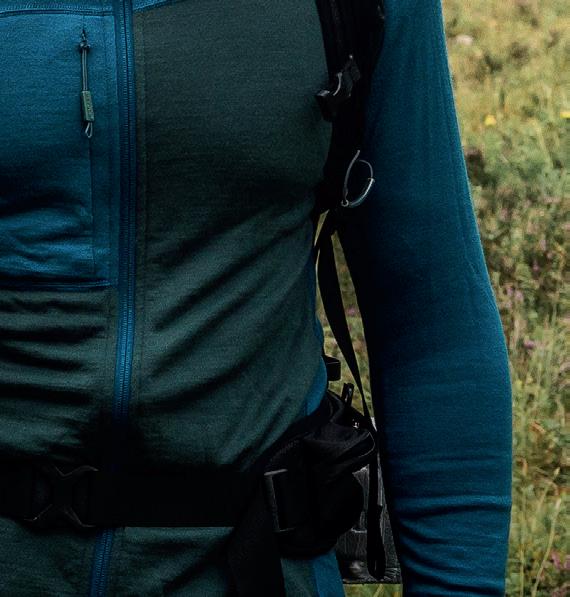


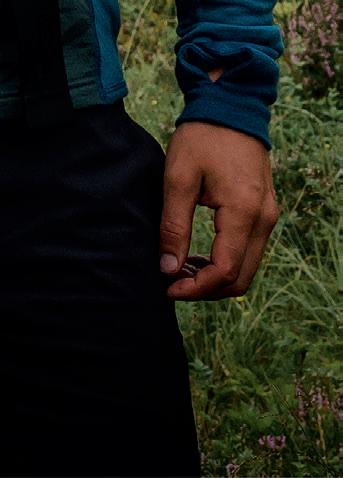
THE PILL PRODUCTS
BY LUDOVICA SACCO
Mizuno’s Wave Neo Collection
With the arrival of the winter season, the Japanese company presents its first eco-friendly running line capable of offering a performance-oriented run.

Also for this season, Mizuno has tri ed to take some steps towards inno vation and sustainability, the result is Wave Neo Collection, a running line inspired by nature and made with an eco-friendly goal. Wave Neo Ultra and Wave Neo Wind sho es are designed to meet the new demands of consumers, driven by a spirit that is more respectful of the planet and in harmony with nature.
In order to be able to claim to have an eco-friendly product in its hands, Mizuno researched processes and materials that have less impact on the planet. An example is the use of technological components in 100% recycled PET and the undyed upper to avoid the use of water. In addi tion, both shoes feature the midso le and the Wave plate in bio-based Pebax, made by working with ca stor seeds. This process allows to reduce the CO2 production by 25%. Another innovation involves the processing of Mizuno Enerzy Foam and the insole, both produced with Bloom algae infusion through a process that transforms air and wa ter pollution into a renewable plant biomass with thermoplastic proper ties. But let's get into the technical details to better understand Mizu no's new line.

Wave Neo Ultra
A shoe characterized by high cu shioning mainly given by the sole composed of a mix of Mizuno Ener zy Core, Mizuno Enerzy Lite and Mizuno Enerzy. The Wave tech nology works with the dual-den sity two-layer midsole to offer a comfortable and stable support. The G3 sole gives a constant feeling of lightness and an optimal grip that allows the right discharge of forces favoring greater propulsion. This shoe is made of 70% of eco-friendly materials
Wave Neo Wind
A model that focuses its attention on maximum propulsion in transi tion. The upper is lightweight and breathable and uses a knit made from a monofilament material. The
sole is composed of Mizuno Ener zy Lite, Mizuno Wave plate and Mizuno Enerzy in the lower part of the midsole, a composition that guarantees high reactivity. 60% eco-friendly materials were used to realize Wave Neo Wind.
The entire Wave Neo collection has allowed an overall reduction in CO2 emissions ranging from 10 to 13%. But this is not the only step forward taken by Mizuno towards a more sustainable future. The Ja panese company, in fact, has joined the National Forest Foundation program which consists of plan ting two trees for each pair of Neo Collection sold in order to offset the CO2 emissions resulting from their production.
24




THE PILL PRODUCTS
BY LUDOVICA SACCO
Kayland Stellar A collection dedicated to technical and fast mountaineering
Kayland, a manufacturer of outdoor footwear, recommends for winter mountaineering its Stellar line, currently represented by three models: Stellar GTX, Stellar AD GTX and Stellar GTX Nubuk.

Stellar GTX
An altitude cramponable shoe that maintains high levels of comfort and agility, useful for fast use on mixed terrain, rock, snow and ice. In parti cular, it is characterized by the new construction technique of the Vibram Stellar sole block: the foot comes into contact with the PU midsole, capable of maximizing the benefits of cu shioning even in the support phase as well as in impact with the ground. The internal construction of the sole integrates a honeycomb drain able to lighten the structure and to ensure a shock-absorbing effect. The upper is made of microfiber and abrasion re sistant fabric and has a rubber rein forcement on the toecap to guarantee greater protection. Its waterproof ness and breathability, fundamental aspects in mountaineering, are sug gested by the name of the shoe itself: Stellar GTX, in fact, uses a Gore-Tex Extended Comfort membrane.

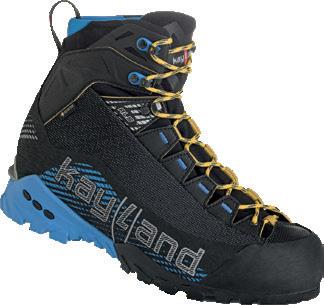
Stellar AD GTX
Sister of the Stellar GTX but lighter and more unstructured, ideal for those looking for a cramponable shoe for altitude but with a lower construction for a multiactivity use. It maintains the Vibram Stellar sole block of the Stellar GTX, once again ensuring cushioning and comfort. The upper is in fabric with abrasion resistant PU applications and a rub ber reinforcement on the toe cap. The fit is quick and easy thanks to the Smart Lance System double lance stopper button that helps to obtain precisely the desired fit.
Stellar GTX Nubuk
A combination of performance, in novation and quality of the mate rials used. The Nubuk upper works together with the Gore-Tex Perfor mance Comfort membrane to gua rantee comfort and protection from water and snow. The construction of the boot allows an enveloping but above all safe fit thanks to the pro tective edge and to the lycra collar. It mounts the Vibram Stellar sole whi ch integrates the insert for the pre disposition to use the semi-automa tic crampons, the internal wedge in dual density PU foam is positioned over the perforated PU mounting in sole to relieve weight and to increase torsional stability, reducing the risk of injury.
26
STELLAR GTX
STELLAR AD GTX
STELLAR GTX NUBUCK
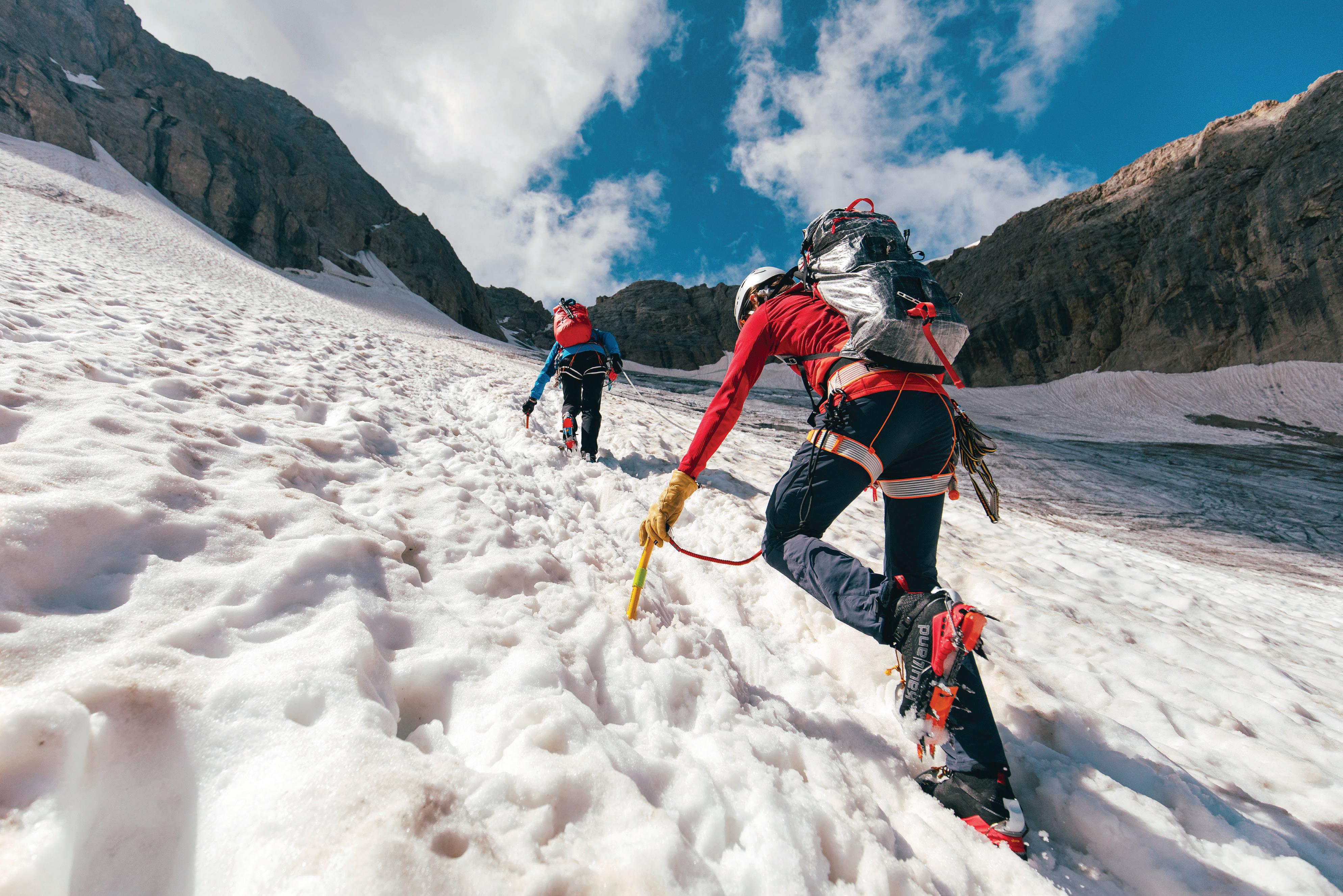


THE PILL RESORT
BY DENIS PICCOLO
CampZero
From rock in the woods to Active Luxury Resort
Recently I’ve been a guest of CampZero, a characteristic Luxury Resort hidden in the pine forests of Champoluc. It’s so special not just because of its location, but also because it offers to its guests a varied choice of sports: climbing, hiking, trekking, ice climbing, cycling, trail running and many more. To learn more about past, present and future of this gem in the middle of the forest I had a chat with Rudy Perronet, Mountain Guide and General Manager of CampZero.
Tell us how was born, in 2018, the idea of this hotel. The idea was born from the innovative mind of Silvio Sca glia, already founder of Fastweb. Silvio used to spend a lot of time in 5-star hotels because of his work and I knew him because I was the Mountain Gui de of his family. He used to say: “Rudy, I spend my life in 5-star hotels but there’s always something missing, they’re really boring. We should do something special, combining luxury and sport.” There was this big meadow among pine trees and Silvio saw there CampZero, the place was huge, I can assure you that we di dn’t cut any trees. At the beginning of the project, Silvio used to say: “To bu ild CampZero we have to start from a rock, imagine a rock in the woods: that’s our con crete block that will become the gym and the climbing wall.” Everything started from there and even today that’s the heart of CampZero. Around that idea the who le project was built. The climbing gym
has 40 climbing routes from 3 to 8a. In winter our “rock” becomes an ice fall to practice ice climbing: maybe not all of our guests choose to challenge them selves on it but they definitely stop to take pictures. So in the end, CampZero is a new concept of a 5-star hotel in Champoluc, but above anything else is a new concept of high level sport and luxury in Europa. For us luxury is not just inside CampZero but also outdo ors, we invite people to come here to enjoy a lot of experiences in our sur roundings.
Who’s the architect who designed CampZero? It is a local architectural firm called BladIdea, based Saint Vin cent. CampZero was their first project of a hotel.
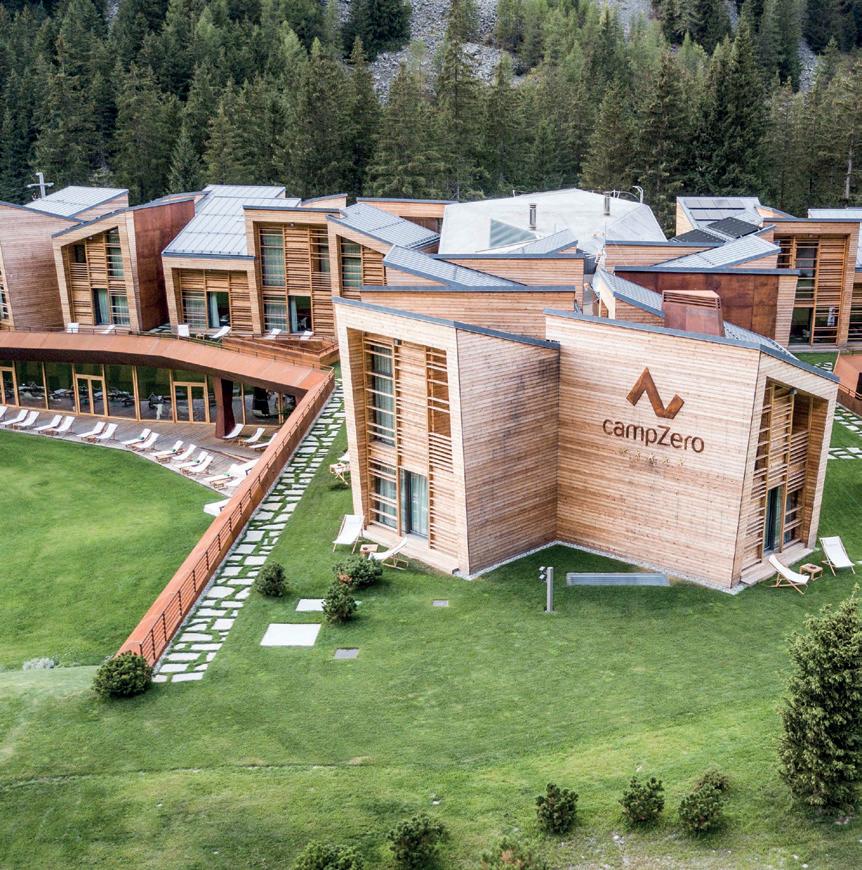
I’ve noticed you used many diffe rent materials in the construction of the building. Why this choice? The concrete used is Béton brut or raw
concrete and we decided to leave it gray to maintain its material perception, so as to represent our rock. We also used larch, a local wood, treated only in an autoclave and an alloy of copper and steel that rusts naturally and integrates well with the environment. We recent ly won an award as the third eco-ho tel in the world, in fact we really care about sustainability. This attention goes through the use of electric cars, the type of detergent, the zero waste cuisine, the underfloor heating with pellets, the photovoltaic panels and much more. We try to be guests of what surrounds us, rather than having an in vasive attitude.
I’ve seen you’re collaborating with many different brands. Yes, but for us the most important thing is to colla borate with local realities: in particular we try to hire employees living in the area. We also collaborate with brands and suppliers, such as Grivel who tru
28
THE PILL RESORT
BY DENIS PICCOLO
sted us from the beginning and who provides us with technical equipment. Furthermore, we host a permanent exhibition of Grivel’s gear in our Boul der Bar. Recently SCARPA joined our project. As for collabs with the automo tive sector we turned to Lexus, leader brand when it comes to hybrid and electric cars.
You have a desk counting many Mountain Guides and experts. That’s totally true, for example I’m both Mountain Guide and Sport Manager. We created another profile working in hospitality called Sport and Adventure Manager, that is someone who can ad vise you about the experience you can do outdoors and the right people who you can turn to for those activities. It’s a kind of professional that many all over Europe copied from us.

What kind of activities can expe rienced by the people who arrive at CampZero? Monte Rosa is an easy peak and that allows everyone to expe rience it: it’s the perfect place where to move your first steps in the mountains. You can start form easier hikes such as Lac Bleu that can please everyone be cause it’s very close to the glacier. Then there are many beautiful alpine refuge es like Quintino Sella of Mezzalama. The final step is a four-thousander, a one-day hike to Breithorn or climbing Castor in two days. We also have many trail running and cycling routes (we can provides bikes), and both trekking routes and gravel roads. In winter we suggest our guests to venture in backcountry, which is a sport born in this area, or freeriding tours, a discipli ne for which we have a dedicated rental service.
Any future development? We’re planning to add new rooms, probably expanding our range with tempting proposals such as suits with sky views. Another improvement will come from the frequent question of our guests: “Where do we go for a vacation at Cam
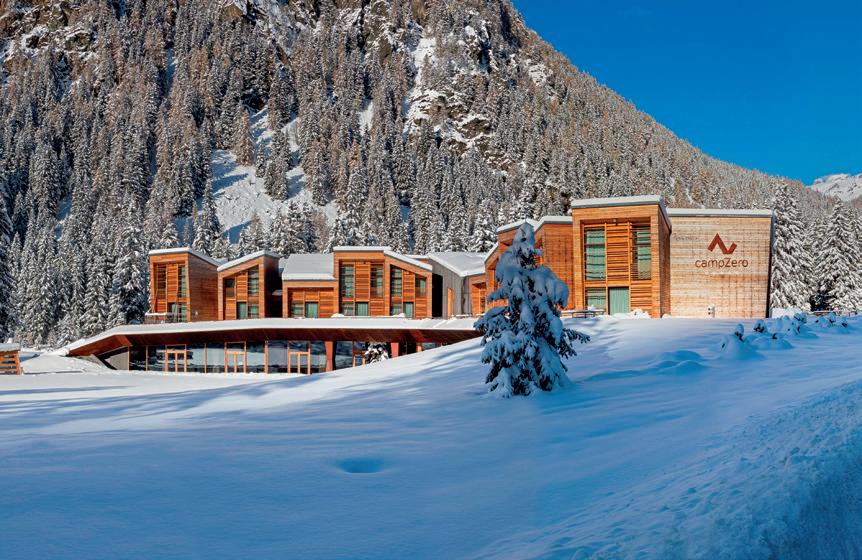

29
pZero but in another part of the world?” We’re surely going to replicate the con cept, maybe by the seaside in order to practice summer and water sports such as climbing, sailing, diving, surfing, canoeing, running, cycling.
Where does the name CampZero come from? It’s inspired by Hima layan mountaineering, in that sense CampZero corresponds to the Base Camp. We define ourselves as a star ting point towards great adventures where to start from, come back, rigene rate and go out again.
Who’s your average client? 80% fo reigners, 20% Italians. Of that 80% of foreign people, 50% come from Scandi navia and UK, the remaining 30% from the rest of the world.
How did the local react to CampZe ro? Before we open it they had many doubts and perplexities but now they’re ok with it because we do not compete with other structures since our prices are usually higher: during high season the highest rate you can find in the vil lage is 250 euro per night while ours can reach 800. Another reason is that our guests spend much more money in local activities. From statistics it would appear that 5-star hotels guests spend more than 100 euros a day on local pro ducts and goods.
Another improvement will come from the frequent question of our guests: “Where do we go for a vacation at CampZero but in another part of the world?” We’re surely going to replicate the concept, maybe by the seaside in order to practice summer and water sports such as climbing, sailing, diving, surfing, canoeing, running, cycling.
THE PILL RESORT
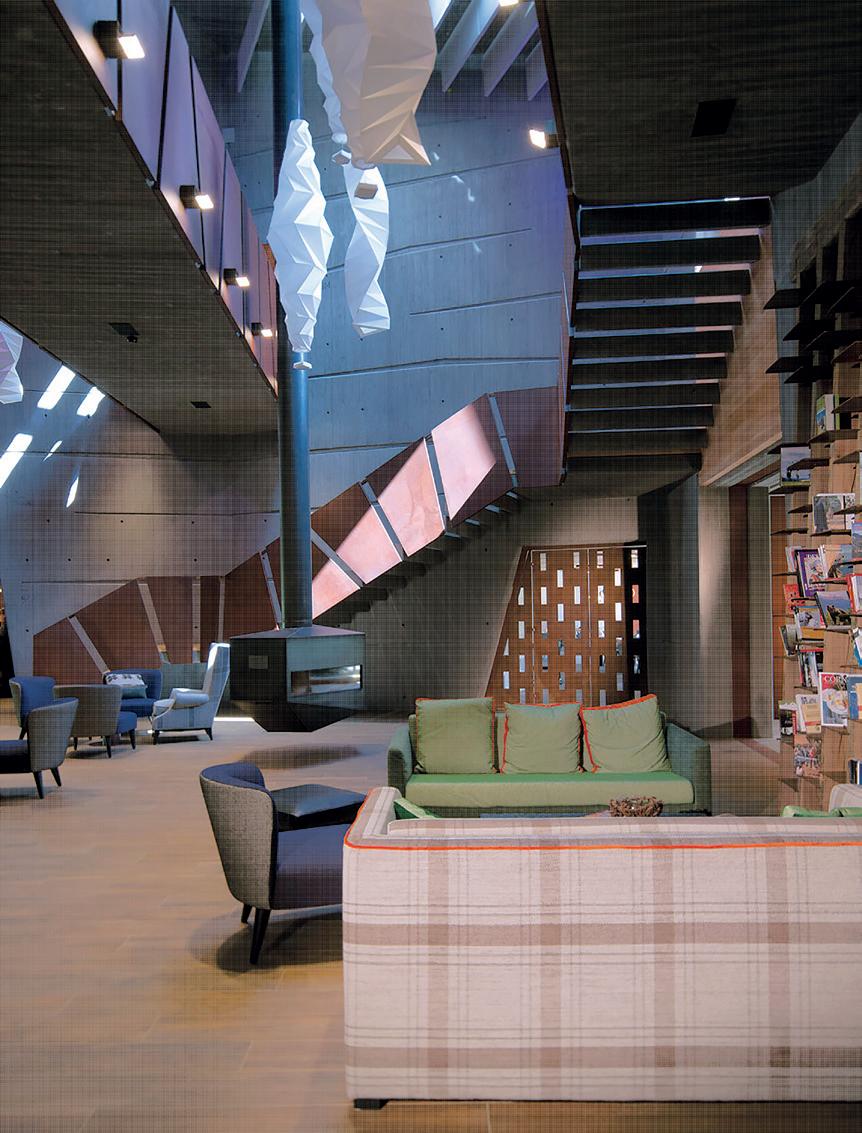
 BY DENIS PICCOLO
BY DENIS PICCOLO
30

THE PILL STORIES
BY LUDOVICA SACCO
The value of slow travel
Myra Stals discovered her love for the mountains only in 2012, when she moved to Italy from the Netherlands. At the beginning she worked in the academic field in Florence but as soon as she discovered Italy while cycling, her love for the outdoors and for slow traveling took over. Right now she’s part of the communication team of the European Association of the Via Francigena ways. In 2020 she gave birth to her environmental project called Cycle to Recycle, while in 2021 she walked all the 3200km of Via Francigena as social media manager of the relay race Road to Rome 2021.
What is your role in the European Association of the Via Francigena ways? I started working in the EAVF for a European project called rurAl lure but after a few months I star ted dealing with the Road to Rome event, held last year to celebrate the twentieth anniversary of the Via Francigena. The Road To Rome con sists in covering all 3200km of the Via Francigena in a sort of relay race in which municipalities, regions, etc. have been involved. In this case, I told the whole Road to Rome as a So cial Media Manager.
So did you walk the whole 3200km? Sure! It took me 4 months, we left on June 15th, 2021 from Can terbury and arrived in Santa Maria di Leuca, in Apulia, October 18th, 2021.
Do you think you’ve learned so mething from that experience? I had been working for the European
Association of the Via Francigena ways for only 4/5 months, so I le arned a lot both about the Via and about myself. I have met many peo ple, cultures, stories, gastronomies: traveling slowly you perceive every little change.

Of all the places you have visited along the Via Francigena, which one has impressed you the most? This is a very difficult question to answer. But I can tell you a couple of areas that impressed me more than others, for example Lunigiana, in Tuscany, was a special place for me. Authentic, with a lot of development potential. I also liked the Swiss side a lot, especially as it is surrounded by mountains!
Did you meet someone that you particularly remember? I met so many different people and each one of them left me something special, it is difficult to choose a particular me
32
THE PILL STORIES

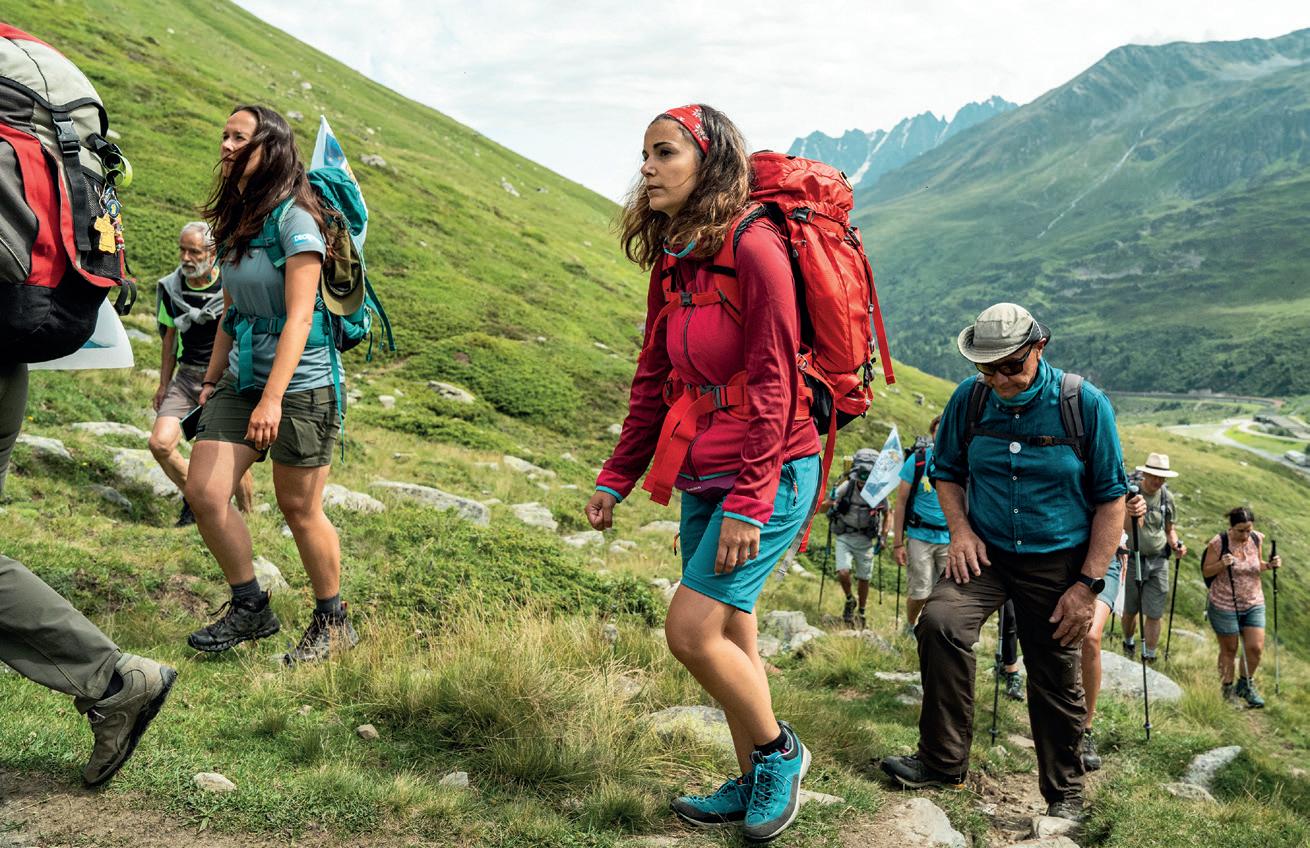 BY LUDOVICA SACCO
BY LUDOVICA SACCO
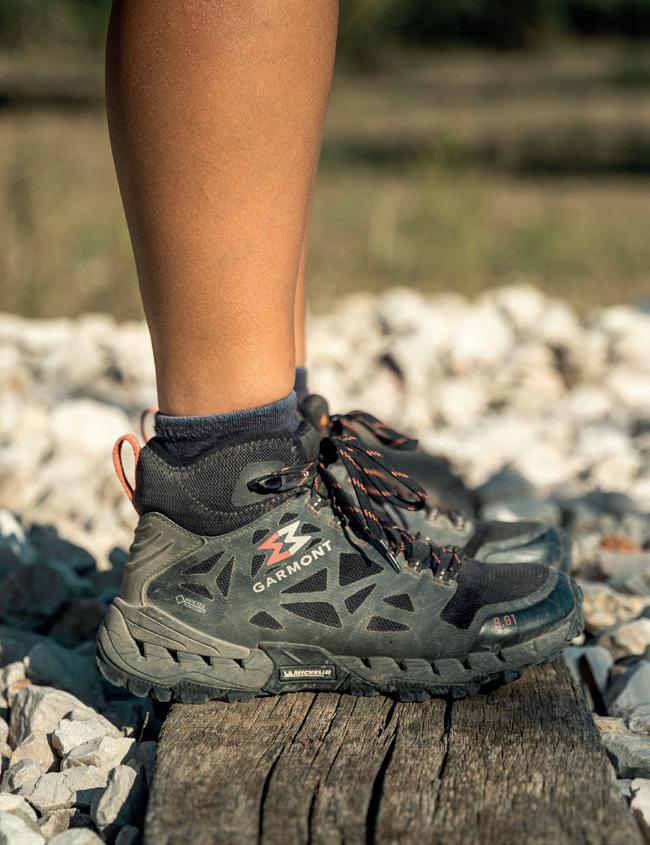
33
eting. I remember a person I met in Fondi, in Lazio. Over there there is the San Magno Monastery run by a priest who is often dressed casually and was a DJ in the past. After some difficult moments he passed from the world of music to the religious one and gave birth to a modern en vironment, where religion finds its place in the contemporary world. It is a cozy and peaceful place, you can feel at home there.
On Road to Rome you walked we aring Garmont’s 9.81 N Air G 2.0 Mid WMS GTX. How was it? I've always been a cyclist and had never done long walks, so I was really cu rious to see how my feet would react. I can only say that it was amazing. Of course I also had good socks, but in 3200km I had absolutely no blisters or pain. Honestly, I didn't expect it, I was ready to feel some discomfort, but nothing! I used a mid cut model
THE PILL STORIES
BY LUDOVICA SACCO
to better protect my ankles and ho nestly didn't even feel the heat, even though it was the middle of summer.
What is Cycle to Recycle? It is an environmental project that I con ceived in 2019 while watching a do cumentary about plastic pollution. I had already done two important bike tours through Europe and Italy and, indeed, there is really plastic everywhere. So I combined the two things: leaving for a bike trip all over Italy and collecting the plastic I found on the way. There was no space on my travel bike, so I used a cargo bike for the first time just to be able to collect as much plastic as possible.
How many plastic did you collect?
During my tour I crossed 16 Italian regions, in 107 days I collected just over 78kg. It may seem few, but it must be considered that an emp
ty half-liter bottle weighs about 10 grams, so you get to almost 8000 bottles. And, unfortunately, I only managed to collect a small part of it.
One last tip for those who want to tackle the Via Francigena? Su rely don't expect a second Camino de Santiago, the Via Francigena is very different. Do it with an open mind! A tip in particular for women: do not be afraid to walk the Via alone. I am often asked if it is safe for a wo man alone, I can confirm that it is. Of course, you have to be realistic and be careful, but both I and many other women have traveled alone and have never felt in danger. But I under stand that those who have not tried it yet may be afraid. Don't be limi ted by these fears! Personally I have grown a lot traveling alone and it is not fair that someone should deprive themselves of it.

34

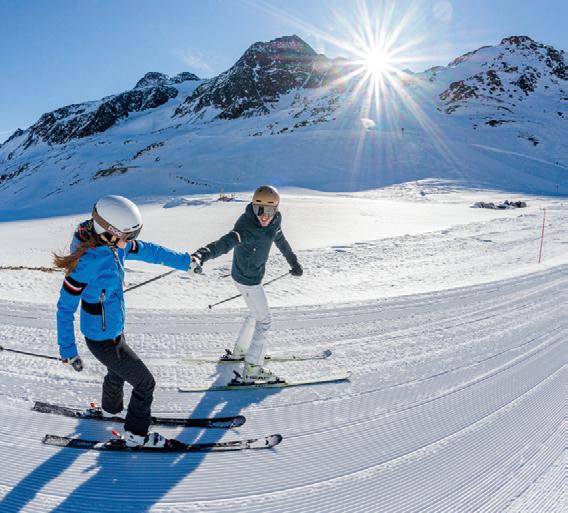




THE PILL PRODUCTS
BY SILVIA GALLIANI
Black Diamond Gloves
Finding the perfect pair of gloves can elevate our time spent outdoors from a miserable day in the cold to a fun experience in a winter wonderland. Black Diamond, since 1957, works in that direction and over the years has built a sterling reputation on the foundation of challenging the elements, while providing quality, comfort, and innovation to all lovers of outdoor activities.
Whether crossing a glacier or bu ilding a snowman, Black Diamond provides us with the right pair of gloves to keep our hands warm, dry and ready to use all the tools we may need in the mountains. We di scussed it with Loïc Tonnot, Product Manager Europe of Black Diamond’s Ski & Mountain Category, who also explained us the brand's new models for the upcoming winter season.
Black Diamond's expertise in ma king gloves and mitts goes back a long way. What is the brand’s strength in this specific sector? Black Diamond was born in the 1950s in the Yosemite Valley, Califor nia, as a climbing equipment brand. We started making gloves more than 30 years ago because we wanted to give mountaineers the opportunity to pursue their activity in the moun tains while protecting their hands from the elements and at the same time using them as a real tool. Over
the years, we have always made new improvements and innovations to the glove category, which now offers a wide range of products for every mountain activity.
Black Diamond has been among the first brands to realize two-pie ce gloves with one part specifical ly designed for fingers. Where did the idea come from? What's the advantage of that? The idea was born about 30 years ago with our first models. The particular design allows a better articulation of the fingers. On the one hand, this makes the rest position more comfortable, on the other it allows you to grip and use the equipment to the fullest.
How important are gloves and mitts during winter outdoor acti vities? It’s a piece of survival equip ment. A glove that does not perform at its best in a given situation can lead to the failure of the entire project, or
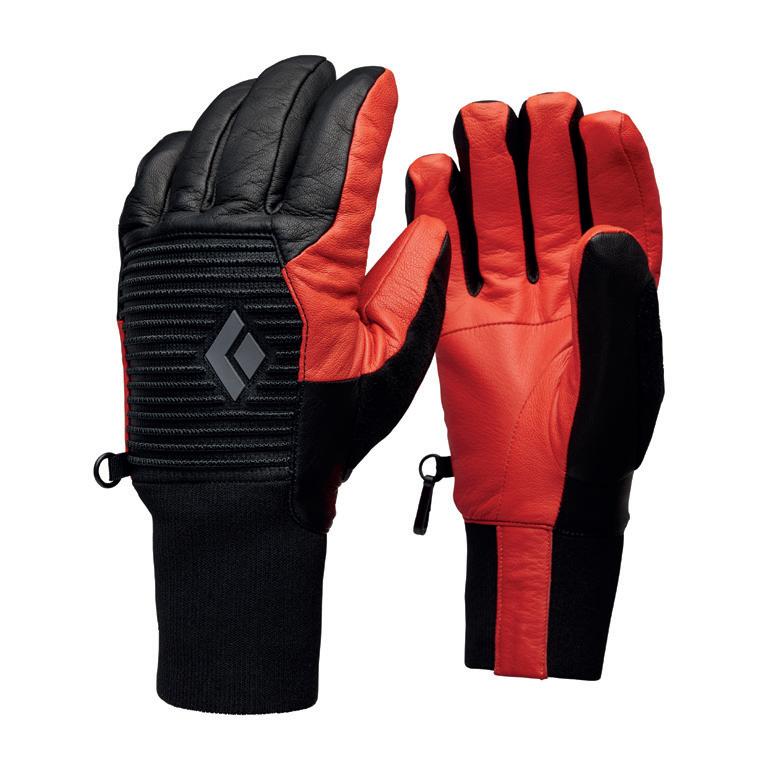
in any case to a series of unpleasant situations. The ideal model must keep your hands warm thanks to the correct insulation, but it must also be robust enough and last over time. Fit is also important in order to grip and use the equipment in the best possi ble way. The glove must make sure that our hands become an additional tool to be used.
How did the design and develop ment of a glove start? When desi gning new gloves, there is usually a fundamental aspect that we take into consideration, which is the specific requests that the activity for which the glove is created will require. For example, when we started develo ping products for ice climbing, there was a specific demand from athletes to have very robust yet thin products and from that point on we started to work. We try to make the best possi ble glove for the specific activity that will be undertaken and from that
36

37 THE PILL PRODUCTS ITW TO LOÏC TONNOT
THE PILL PRODUCTS
BY SILVIA GALLIANI
point on we build the entire range. We currently have 7 different catego ries (8 if you count the kids line). The pro series is made for mountain pro fessionals, guides, professional ath letes and all those people who work using gloves in ski resorts. For less technical uses we start from those same pro models, making them with different materials and consequent ly placing them in a different price range. Each model is therefore desi gned for a specific need, multipur pose products exist but it is essential to have clear in mind what you are going to do with that glove in order to make the best purchase in terms of technology, fit, insulation, etc.
What are the essential features that a glove must have? Obviously they vary depending on the activity that will be carried out because each glove is built differently based on the use for which it was designed. However, there are two aspects to consider when choosing a glove: the fit of the model and at what tempe rature it will be used. For example, a snowboarder will simply need a warm mitt because he won't use his hands so much, instead a ski tourer needs a different product, with more insulation on the outside of the glo ve to protect the hands from the cold and less on the palm in order to have a better fit to grab his poles.
How to choose the perfect product according to the activity we’re going to perform? After evaluating fit and temperature in which we will use a pair of gloves, another series of factors can be taken into considera tion that vary according to the activi ty we are going to carry out: the cuff closure system, the protection that the glove offers with reinforcemen ts, Kevlar stitches against abrasion or even a specific soft leather patch on the thumb to clean sunglasses or taking off sweat, etc.
Tell us something about the new Black Diamond’s lines of gloves and mitts. Where did the idea for these models come from, what are the main features, what are the technological innovations. We have a very successful line of freeriding gloves for years that is constantly being improved and expanded. For the 22/23 season we have expanded the line by intro ducing the Mission series, versatile and reliable thanks to top quality materials including a Gore-Tex li ning and a PrimaLoft Gold insula tion for maximum warmth.
What is Black Diamond flagship model for this winter season? What are its features? I would say Session, a quite unique glove becau se of its inner construction with pre mium goat leather and a PrimaLoft Gold Cross Core insulation combi
ned with an outer engineered knit technology that’s water-resistant, stretchy and breathable, inspired by football shoes. It’s a high-end freeri ding glove with a slim fit in order to better grab your poles and skis.
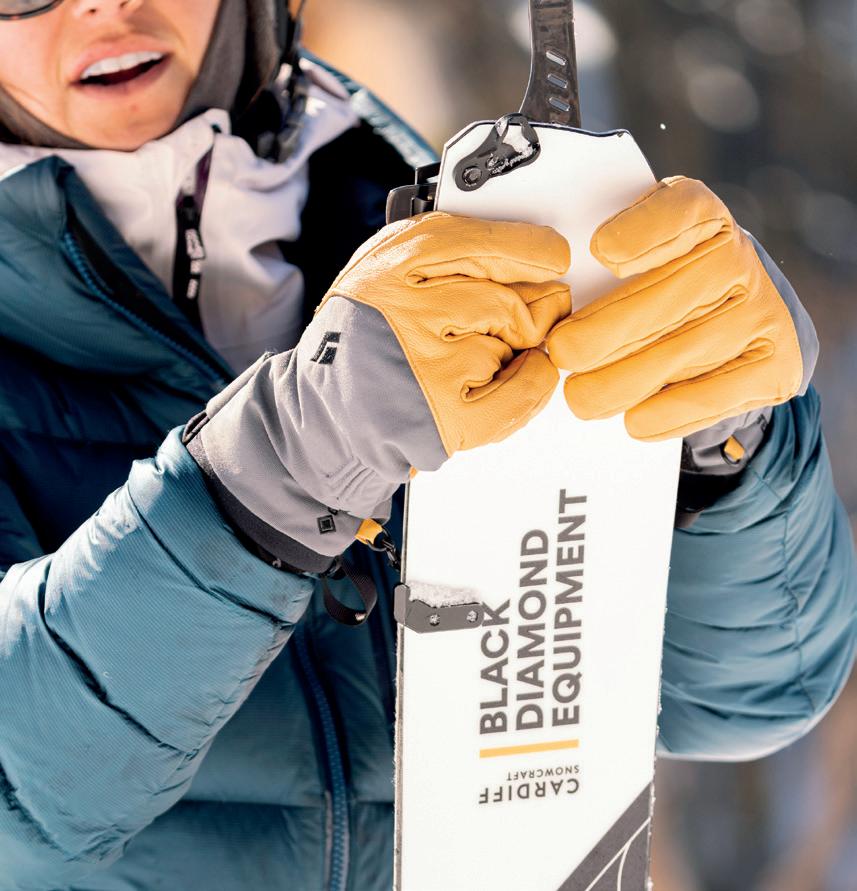
How long does the whole process of creating a new glove model take? It usually takes about 18 mon ths. We have been in the sector for many years, and we have our sup pliers but we constantly try to evolve our creation process also in a more sustainable way.
Speaking of sustainability, how do you approach this issue? Su stainability is a key factor that we try to research as much as possible, obviously it is not always easy, for example you cannot have recycled leather that performs in the way we want. Vegan leather exists but is more used on footwear, and doesn't
38
work as well on gloves. The insula tion of all our models is made with recycled materials, the leather tan ning process does not use toxic che micals and we use PFC-free DWR water-repellent coating.

In what kind of situations and by what pole of testers are the models tested? We have several testers who test the products in the field in different specific activities. All our European and American athletes, but also mountain profes sionals, guides, people who work outdoors or in resorts. All these pe ople constantly give us suggestions, first of all on the fit of the glove, which must be in line with our exi sting models, and then on whether the model meets the expectations of the activity being practiced. Other feedback we get is about the glo ve's breathability, whether it pro
THE PILL PRODUCTS
LOÏC
vides the right warmth, if the lea ther construction is good enough or needs reinforcement, if the cuff is long enough, etc. We collect all these small details and make conti nuous adjustments in order to give the end customer the best outdoor experience.
Future projects? We constantly improve our collection in order to have the clearest and most com prehensive range possible. A sec tor on which we aim and plan to expand is trail running which is seeing a real exponential growth. Our aim is to realize trail running gloves that have specific needs for the discipline such as breathability, waterproofness, etc. This is what we are focusing on at the moment using all the expertise gained over the years.
39
ITW
TO
TONNOT
Sustainability is a key factor that we try to research as much as possible, obviously it is not always easy, for example you cannot have recycled leather that performs in the way we want.
EMPLOYEE OF THE MONTH
BY DENIS PICCOLO
Chiara Guglielmina
Chiara has been working with us for a few years now, we would have a lot to tell you about her because she can do many things and all of them very well, she writes, shoots photos and videos and edits them, and she even got a degree in design. But what we really like about her is the passion with which she literally immerses herself when she tells stories about mountains and people.
Tell me something about yourself and not about your job. It’s hone stly hard for me to talk about myself without talking about my job, I don’t know if that’s a good or a bad thing. All I do for work, such as photography, shooting videos, writing, it’s all part of who I am. When I have some free time I do the same things anyway, I go to take pictures somewhere or I just write down my thoughts. I have many pas sions, maybe too many. For example, I’m a great lover of humanity: I like get ting to know people, from the Nepalese sherpa to my neighbours. Maybe that’s why I love to tell stories. I love cinema and being outdoors but I don’t live it as a challenge to be timed. I like to go searching for mushrooms with my fa mily, go fishing, walking around and running. Of all outdoor sports, skiing is my favorite because I had an important competitive past. I’m a sweet and emo tional person, I could cry for a sunset but I’m also stubborn. I would say I’m a rather complicated person. What do you do for The Pill and what do you do in life? I honestly haven't fi gured it out yet. For The Pill I mostly write and shoot, and I do the same in my personal life. Lately I’ve been wor
king on my first documentaries as art director and editor, but I would like to increasingly direct my path towards photography. Professionally I’m also a ski instructor.
What’s your favorite tool to express yourself? It depends on what I have to say. For example, writing for me is very personal and intimate because I’ve been writing since I was 15 years old. For me writing is important not only to tell stories but also to relax. Anyway, there are different languages you can adopt based on what you want to tell, the tools are the words, photos and videos.
Which outdoor activity do you most practice during the year? I often ski for work while on a personal level I guess my favorite activity is hiking. I really like walking in the mountains.
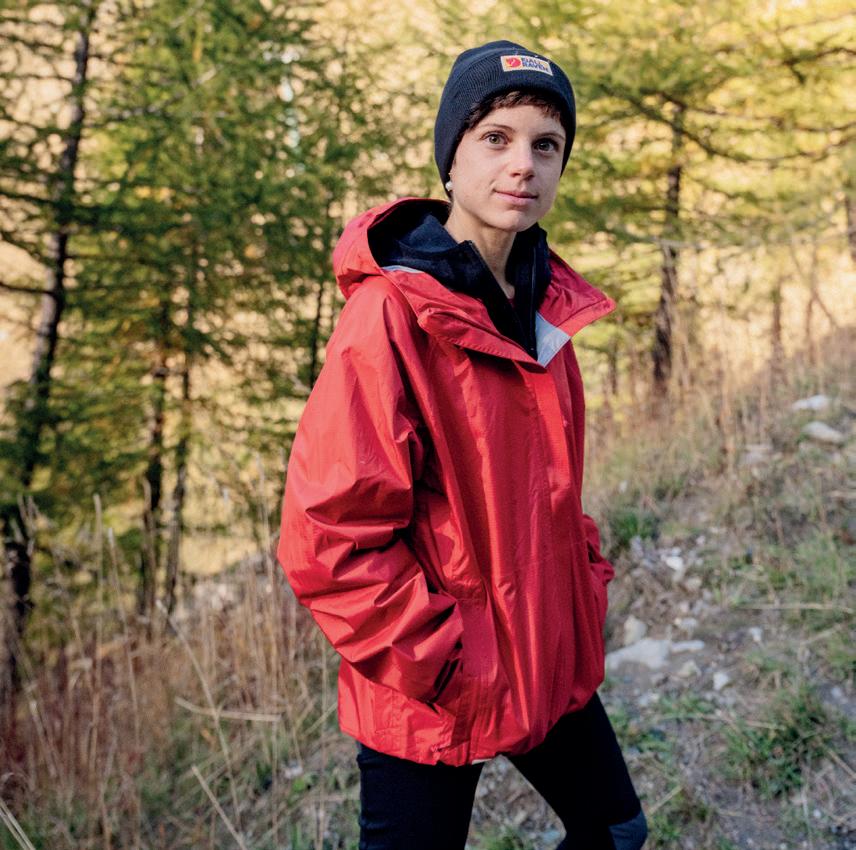
What was your last trip and what will be the next one? My last one was
in Ladakh last August (you ca read the story of this trip on this issue). It is a region in north India between Paki stan and Tibet. It was a beautiful hike in high mountains, always above 4500 and 5500 meters high. My next trip was supposed to be Nepal but unfortuna tely I won’t be able to go there. I hope my next destination will be Iceland or Northern Europe.
If for one day you were to be someo ne else, who would you want to be? Sincerely? Nobody else. Who, among us, really knows other people and their own lives? I already have to understand stuff about myself so I prefer going on working on myself rather than be so meone else. Sure there are people I ad mire and respect but I wouldn’t want to be them. Those people surely achieved important work and personal levels be cause they’re traveled a certain path but I want to follow mine to arrive there. I want to do it while remaining Chiara.
40
EMPLOYEE OF THE MONTH
BY DENIS PICCOLO

41
TOTAL
OUTFIT FJÄLLRÄVEN JACKET HIGH COAST HYDRATIC PANTS ABISKO TREKKING TIGHTS PRO HOODIE KEB FLEECE BEANIE VARDAG CLASSIC
THE PILL HEROES
BY ILARIA CHIAVACCI
A matter of body and mind snatchers Stefano Gregoretti
Rudy Project athlete Stefano Gregoretti was born by the seaside, in Riccione, and as a child he always had great scoliosis problems. Today, in his portfolio he can boast triathlons, ultra trail races and missions in the most inhospitable places in the world, from Arctic Canada in the winter to Death Valley in the summer. There are those who find their comfort zone in the comforts of their own home and those who have to go beyond their limits to "feel at home".
“Mountains have always called me, even when I was a child: my birthday falls on September 2nd, and every year the gift I asked my parents was always the same: to go and spend the day in the mountains. I have never been attracted to the sea and by all the sports that can be practiced there, while my friends and school mates used to sail and windsurf, I devoured Bonatti's books.”
But you didn't become a mountaineer... Let's say that all sports and all activities have always been a me ans for me to be able to pursue my final goal, my real challenges. Then in life everything is connected, it is through triathlon and ultra trail races that I met Ray Zahab, the one guy who crossed Sahara desert on foot for more than 7000 kilometers or the Gobi desert, and with him, thanks to the very strong bond that

we created, then our most recent projects were born. We accompli shed our first expedition together on Baffin Island and from there I en tered his world and he entered into mine, creating incredible ultra en durance experiences: we crossed the entire Patagonian desert together, from the Atlantic to the Pacific, then all Namibia in the middle of sum mer from the border with South Africa to the one with Angola for a 1900 kilometers run, and then again: seven expeditions in the Arctic in cluding the Canadian territories of the north west.
Who knows what the doctors who treated your scoliosis when you were younger think now... You know what? I’ve always liked this world, and since the alternati ve would have been to carry a brace
all my life I have made a particular effort to cure it. I’ve been forced be cause I practiced swimming for ye ars, I went to the pool every day, and I hated it, then things change and I ended up playing water polo for ten years, but for me sport has always been a medicine in the true sense of the word.
You have practiced many sports in an intense way, what are you concentrating on now? Now I’m fully on expeditions, which are quite de licate and complicated already from the preparation, both on a logistical and physical level: I have to consider a time frame of 11 months despite the fact that I am already eighty percent trained for it. But if I have to run in a desert for 70 kilometers a day or pull a 110-pound sled in the Arctic, the preparation clearly changes.
42
THE

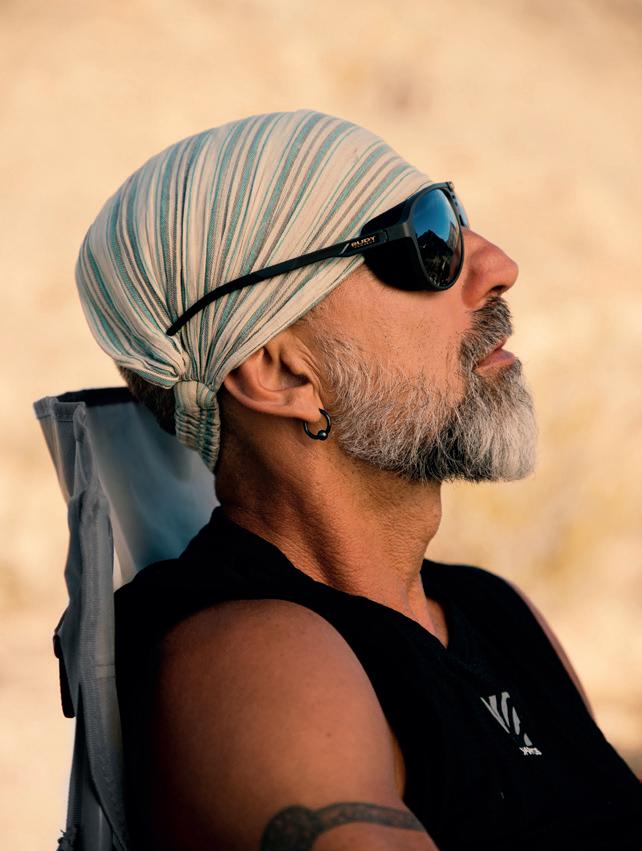
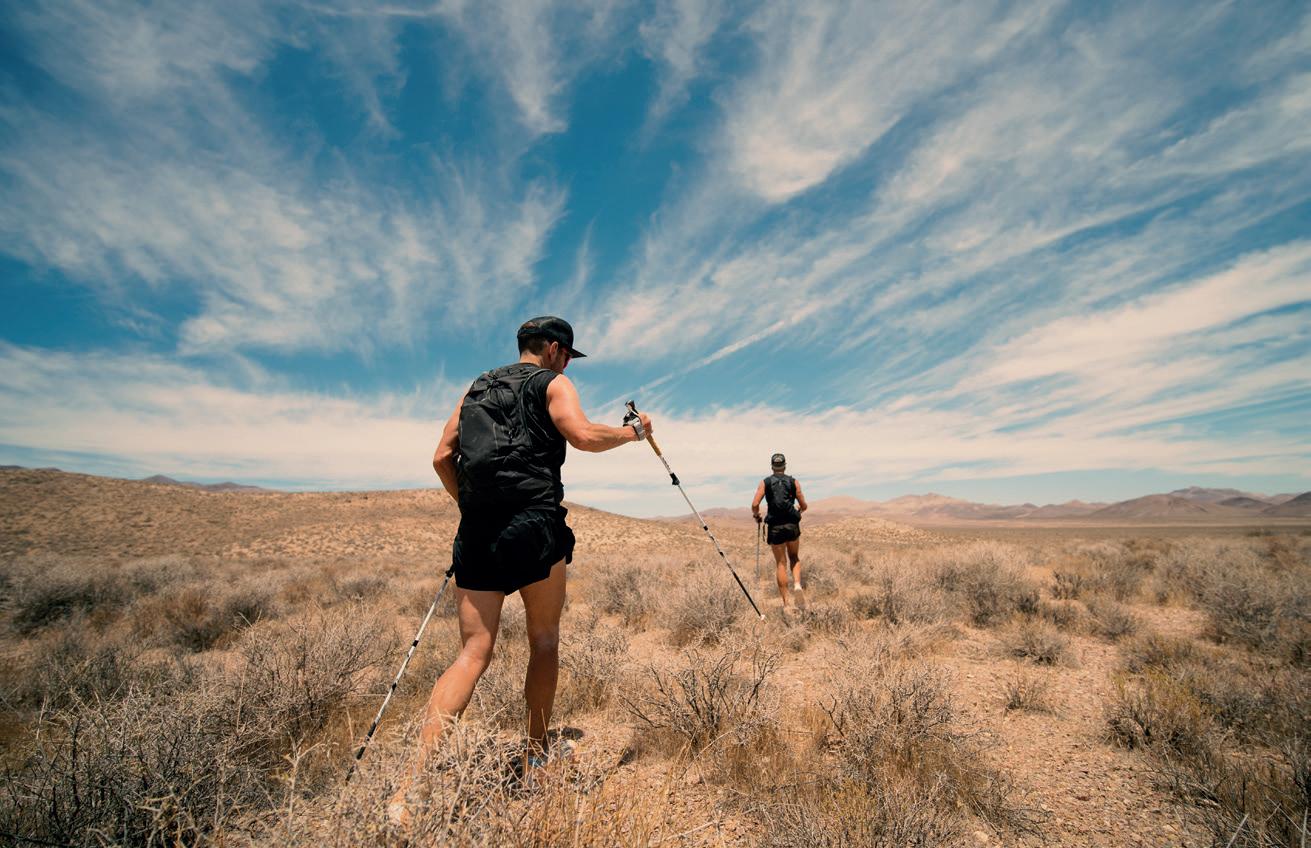
43
PILL HEROES
PHOTOS TUCKER PRESCOTT
THE PILL HEROES
BY ILARIA CHIAVACCI
These are diametrically opposite situations, how do you prepare yourself? These are extreme situa tions both for the body and from a metabolic point of view: in the desert I practically eat only carbohydrates because proteins and fibers cannot be maintained, so I have to adapt the body to have that type of diet whi le in the Arctic the 80% of my diet is made of fat.
Fat? I have the possibility to eat only once a day: even just melting snow to rehydrate meals is an operation that takes many hours and that I cannot do in daylight hours, which are few in a day and I need to run during them.
So now your goal is dedicated yourself to missions? The ultra trail world is fascinating, but it’s all about races: what I've been passio nate about lately are real missions, the philosophy behind them is dif ferent.
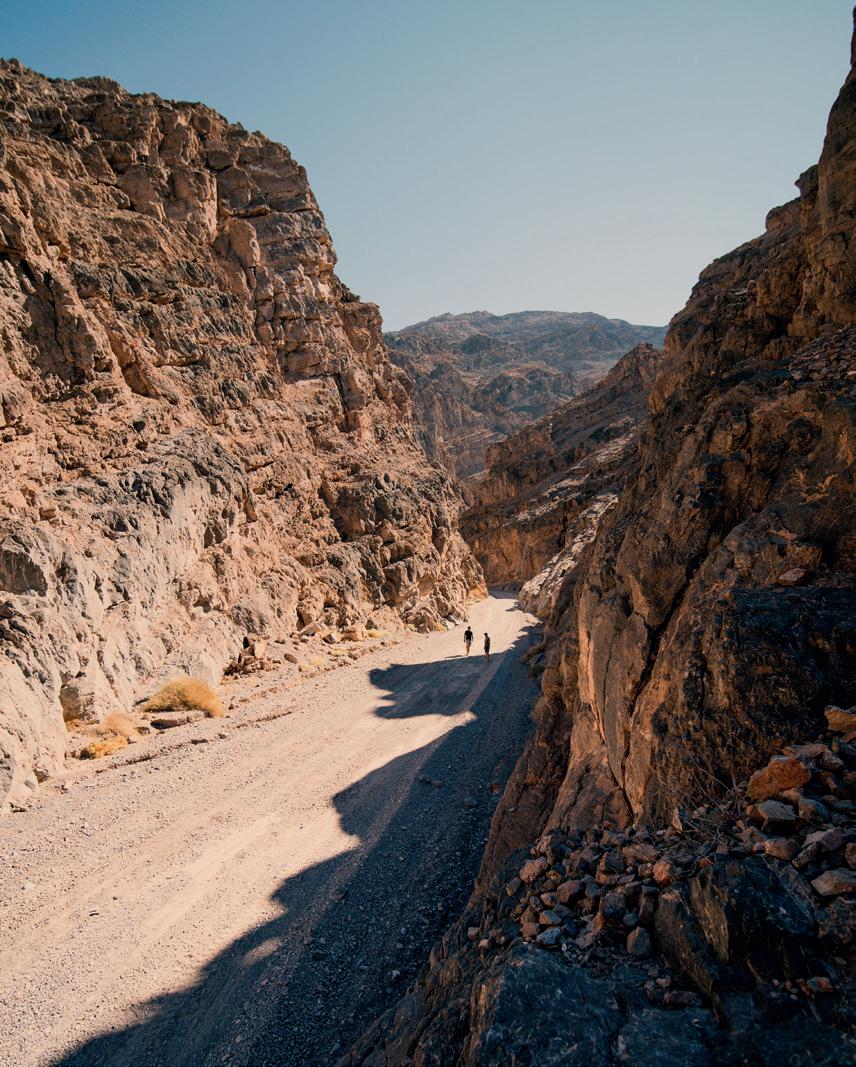
What drives you? The desire to know places that are still unspoiled in many ways, where I can expe rience a sense of emptiness where I, inexplicably, feel at home. In the Canadian Arctic a helicopter takes three days to arrive, if it has visibi lity, this means that within 700 kilo meters you have no life form except those that live there, so polar bears and arctic foxes. There is nothing more. Here, I find myself in a con text that is apparently problematic, but which, for me is inexplicably comfortable. I feel such a sense of communion in these places that after a week it feels like I am at home. I am made to be in the wildest of na ture. One of the last missions I did to accompany a group was in Arctic Canada and Baffin Island and the re in the evening I slept like a baby for ten hours straight, despite being inside a windswept tent and with polar bears outside, while at home I
can barely sleep for six hours. I am uncomfortable in the bed, there are noises outside, in short, I am never quiet. Here is home for me, so what drives me, in essence, is to go back home.
You feel at home in Arctic Cana da, but you’re often in the Death Valley too... Yes, Ray and I just fi nished a mission there. We crossed it from the east border to the west border in the hottest month of the year, with 50-55 degrees per day, running totally off the road into canyons and gorges, using water supplies we had buried days before every 30 kilometers, for a total len gth of 140 kilometers.
44
Mountains have always called me, even when I was a child: my birthday falls on September 2nd, and every year the gift I asked my parents was always the same: to go and spend the day in the mountains.

THE PILL HEROES
BY DENIS PICCOLO
4 words with Silvia & Pablo At Tor with SCARPA
For the thirteenth edition of TORX, thanks to SCARPA we immersed in a real live experience that made us observe even more closely the physical and mental preparation of the Giants who participate in this event. During the various stops at the refugees we were lucky enough to meet Silvia Trigueros Garrote and Pablo Criado Toca.
Silvia Trigueros Garrote is the fema le Giant par excellence: this was the sixth year in which the ultrarunner took part in the competition, after three consecutive victories. In 2022 she was unable to climb the first step of the Tor330 podium but she secu red the second place with a time of 84:58:32, just behind British Sabrina Verjee. She commented about her race: “This time I finished my Tor des Géants in second position. Towards the end of the race I just couldn’t manage to stay up to the pace of Sabrina Verjee, but I am happy that I have given my best! I admit that I am moved by the affection of the people I met, by their encouragement and their respect.”

Pablo Criado Toca is another name known among Giants: the Spanish ul trarunner, in the SCARPA team since 2015, arrived at the finish line of Tor des Géants six times and on two occa sions he brought the title home. This year he attempted Tor450 but, unfor tunately, an injury stopped his race at the Frachey Guide Refuge after about 300km and 97 hours after the start line. Born 46 years ago and father since two
years, for Criado Toca TORX is one of the most beautiful competitions ever: “I have an emotional bond with TORX: the place is beautiful, we are in the heart of the Alps. I also ran in Colorado, Those are more exposed but simpler places, the routes are cleaner. The difficulty lies a lot in the altitude. Then it depends whe re you go, whether in the desert or in the mountains. American races are perhaps more similar to marathons and ultrama rathons on road, while in Europe we have more steep differences in height. That’s probably why I prefer Alpine areas.”
About the people encountered du ring the competition, he says: “People are friendly, I felt at home! In the end I am Spanish, you are Italian, we are both Latin and you can feel this bond. However, in Spain, those who do not arrive first are not very considered. In these Alpine countries, however, every time I competed there were people who congratulated the position in which I ranked. They recognize that it is not easy at all what ultrarunners do. Here people understand the mountain, the role of the finisher.”
46
THE PILL HEROES

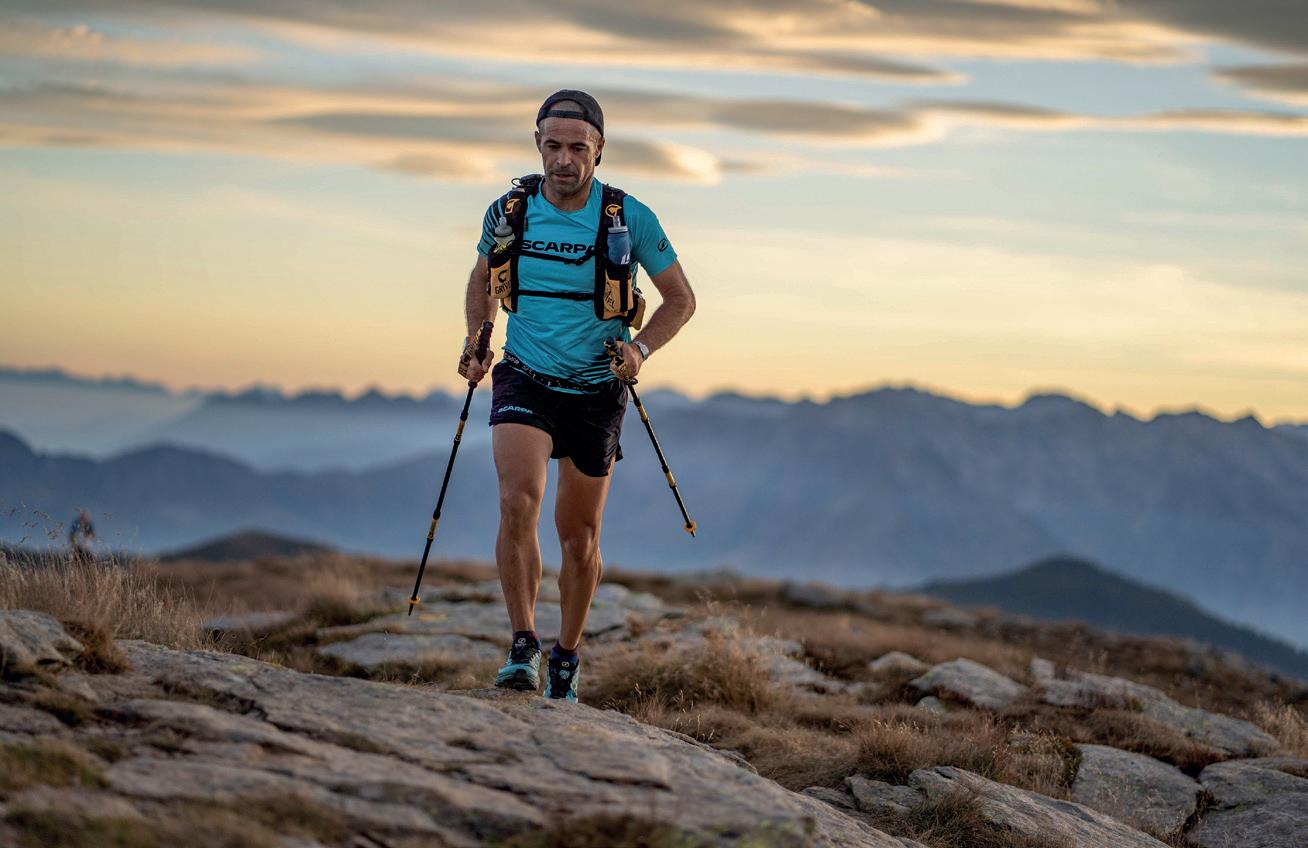
47
PHOTOS JOSE MIGUEL MUNOZE
THE PILL HEROES
BY DENIS PICCOLO
Among the transition to the various aid stations of these Giants, we wi tnessed the preview presentation of Spin Planet, a new trail running model, we were able to touch by hand and discover everything that unites and differentiates it from other trail running footwear.
It is designed for those who start approaching long distances, an affirmation supported in particu lar by the midsole with increased volumes capable of absorbing all types of impact at best, ensuring a protective cushioning. Those who know the Mojito Planet model of the Asolo brand will have already understood that Spin Planet also has a sustainable concept regarding the materials used. The lining is in recycled microfiber, the upper is obtained from 100% recycled yarns and the same goes for the previou sly mentioned midsole which is in EVA recycled at 45%. A fundamen tal point is also the tread made with 30% recycled rubber, the current percentage necessary to maintain the same performance as a new sole.
Regarding the performance of Spin Planet, Marco De Gasperi, SCAR PA brand manager, tells us: “What we have tried to obtain is a product that had specific certifications and that could be as recycled as possible while maintaining the performances that are essential for us. For example, we want to give the right care and attention in the research and deve lopment of the materials to make sure that the product does not get worn out too easily and that it maintains the suitable performances to deal with the classic mountain situations. Situa tions in which grip and reliability of the upper are of fundamental impor tance, because you can face routes that are not very beaten and with a lot of stones and rocks, where you can easily get a distortion.”
In terms of mileage, Scarpa designs its models to cover a minimum of 450km and the same goes for Spin Planet. Then, trail runners know it well, everything also depends on the type of terrain you will run onto.
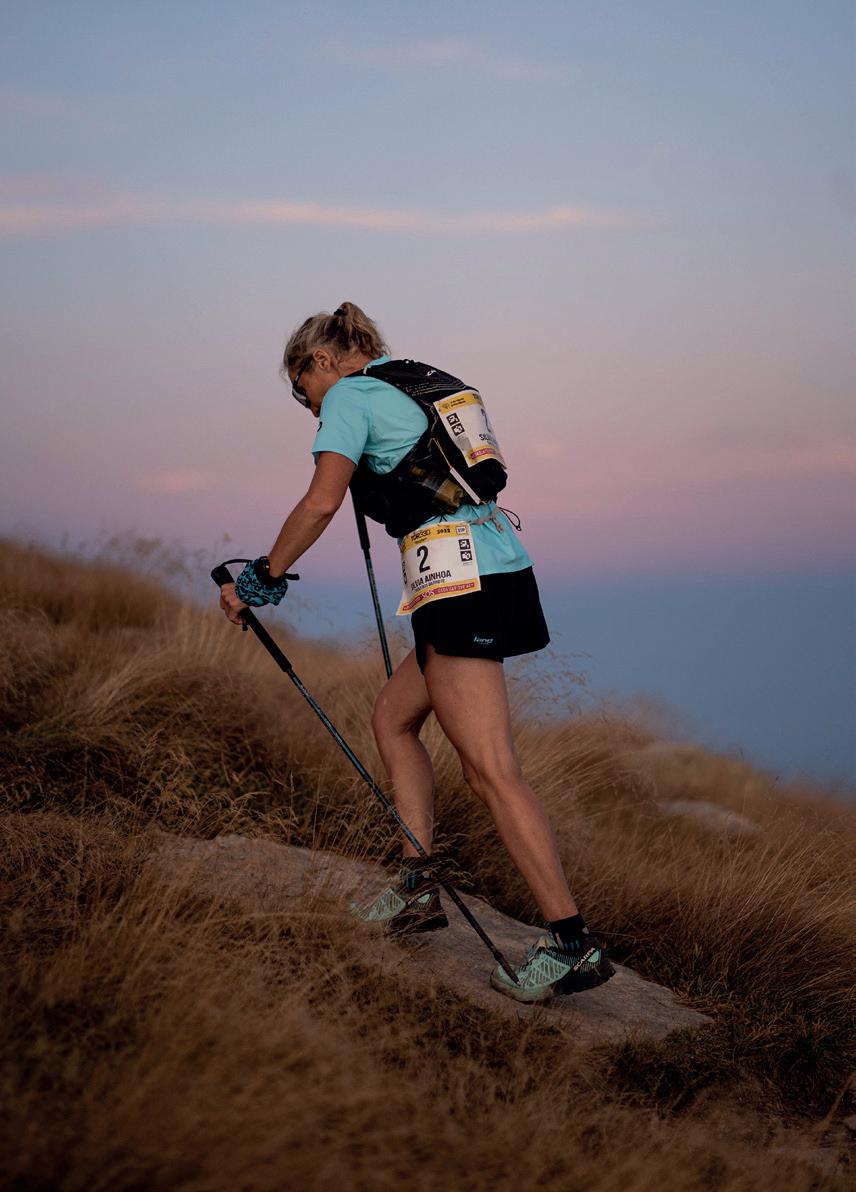
Every new recycled, recyclable or of natural origin solution is a step forward towards the well-being of the planet and we believe it is im portant that companies work con stantly and with dedication on this point, with less compromises as possible.
“This time I finished my Tor des Géants in second position. Towards the end of the race I just couldn’t manage to stay up to the pace of Sabrina Verjee, but I am happy that I have given my best! I admit that I am moved by the af fection of the people I met, by their encouragement and their respect.”
48
THE PILL HEROES

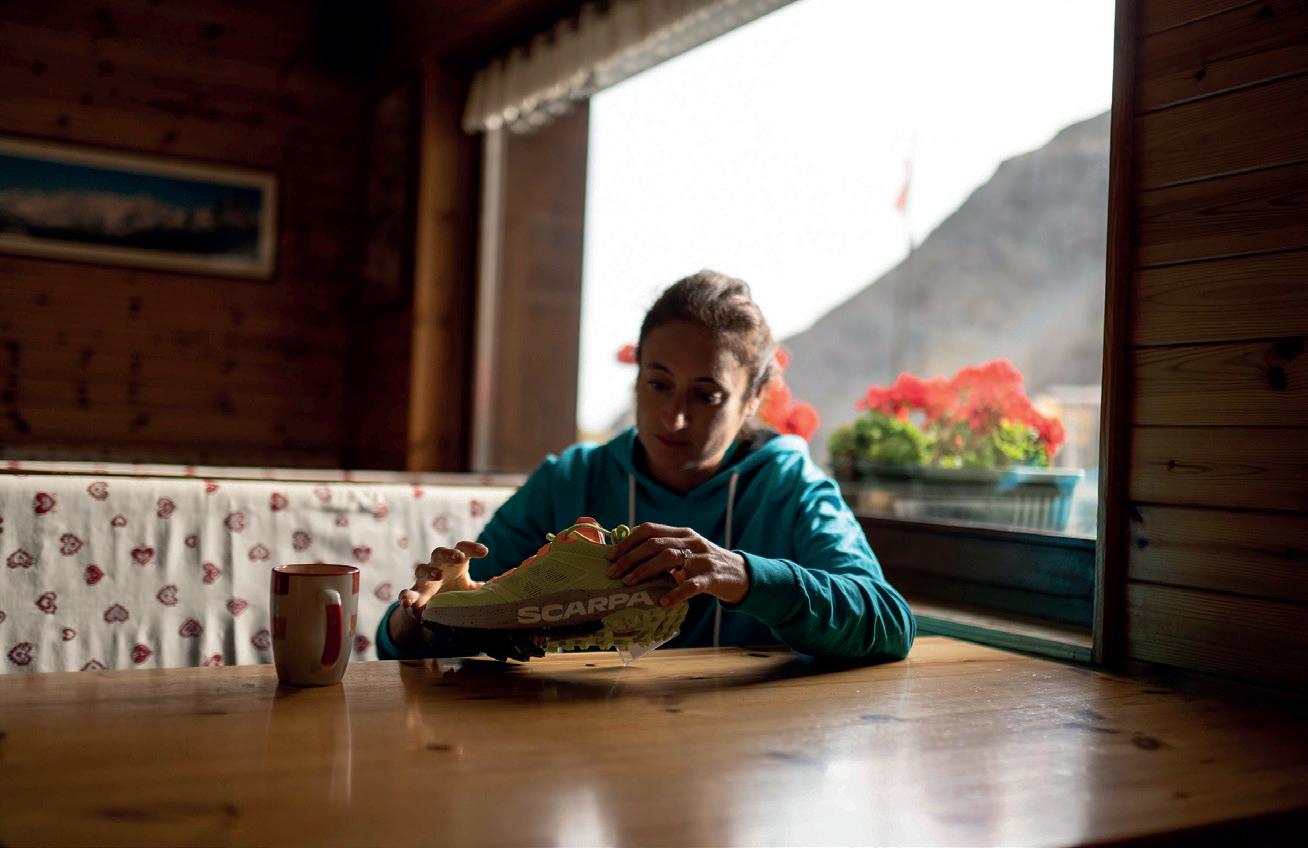 PHOTOS JOSE MIGUEL MUNOZE
PHOTOS JOSE MIGUEL MUNOZE

Andreas Reiterer
BY FILIPPO CAON PHOTOS ALBIN DURAND
In Chamonix it works like this: a brand, let's say that this brand is called Asics, book a hotel to host its athletes. To keep them away from the chaos of people that invade the village in the days of UTMB and from the stress that follows, it is likely that the ho tel is located in a residential area, secluded from the center: let’s call it the La Rosière district, and the hotel Eden. Now, to save the athletes from unnecessary trips to the village, the brand, Asics, organizes conferences and meetings with the press within that same hotel, keeping the athletes in a welcoming thermal war mth, a kind of pre-competition amniotic fluid, before throwing them into the fray with all the other horses, running a hundred kilometers in the rain. It is a well-established technique and, it must be said, it works.

51
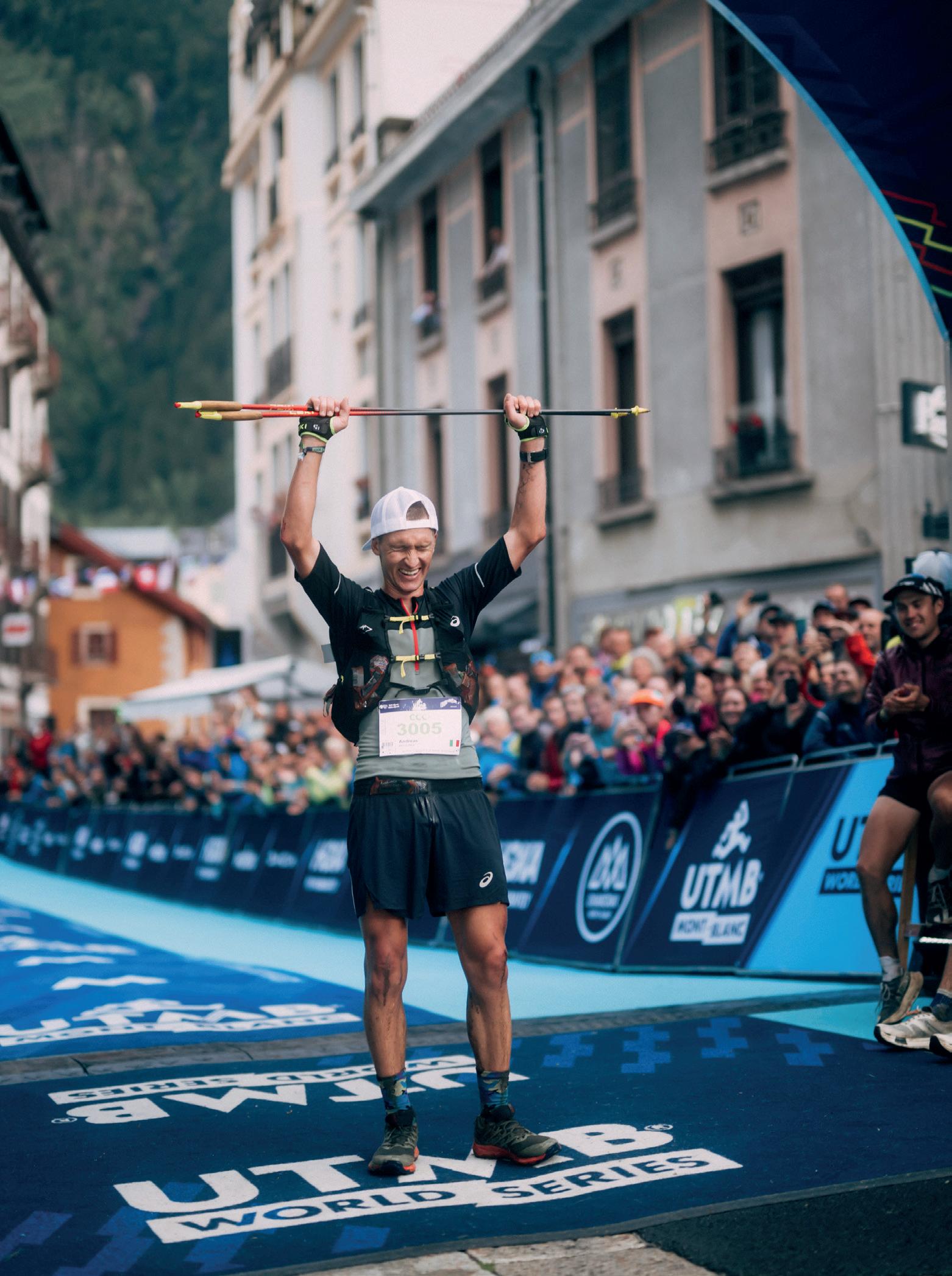
For a week that hotel becomes the corpora te headquarters, where different things take place: lunches, interviews, presentations. The foyer is transformed into a stand that showca ses the next year's products, window decals are applied to the windows and the garden is filled with company flags. The dining room is white, with large windows overlooking the Aiguille du Dru, everyone is talking softly so that I can clearly hear Andreas Reiterer spea king from the next table. Ten minutes is enou gh to be absorbed by that soft warmth. After coffee we move to a small room on the ground floor set up for interviews, and have a chat with Andreas.
He enrolled in CCC, which leaves Courmayeur the next morning. On those mileage Andreas is probably the strongest athlete in Italy. His sea son began with a fifth place at MIUT in Madei ra, behind Walmsley, Garrivier, Tschumi and Blanchard (three of these guys scored at UTMB respectively the second, fourth and tenth pla ces). In May Andreas raced the Italian Cham pionships, winning them, and in June he went to Cortina for LUT, where he retired for the se cond year in a row, at Malga Ra 'Stua. For some reasons LUT is not his race, and when I ask him why he replies, laughing, "dunno". Then he pau ses, and adds: "but I’ll try again every year, fuck it." Andreas doesn't utter rivers of words, but says what he needs to say. The thing I like about athletes like him is that they don't make excuses to explain why they are doing badly, he doesn’t need them: he trains like a damned man, he shows up on the starting line, and runs, the rest doesn't seem to matter that much.
He tells me about that withdrawal without too many worries: “I was with Hannes, I arrived in Cimabanche and I was fine but on the fol lowing climb I tweaked my back and I was no longer able to run”. Simple, straight. LUT and CCC are two relatively compatible races: LUT is a 120km race with 5500+, CCC is a 100km race with 6000+, the second is tougher, it has three 1000-meter ascents in succession in the last 50 kilometers, but still remains one race that the first athletes manage to run at a very
fast pace. In 2021 Andreas closed it in fourth place in 10:57, this year he is aiming for the po dium and to do a better time.
There is a widespread idea that Italy does not have athletes capable of competing for podiu ms in international competitions, at least over distances such as those of CCC or LUT, much less UTMB. In fact there are not many runners, but there is someone, and for some unclear reason, often that someone comes from South Tyrol. In ultrarunning South Tyrol is a paral lel world: no, South Tyrol is a parallel world in everything, and in general we really don’t know why. But from time to time it happens that an athlete arrives at the Italian Cham pionships speaking with a slightly harsh ac cent, and gets a first place by running with his mouth shut. That’s one of few moments when we remember that there is a community there too, some competitions too. One day we will ask Andreas what it’s like up there, a place that’s not really that far aeay. Anyway, in case you were wondering, Andre as finished third at CCC, lowering the time of the previous year by half an hour, behind only a Petter Engdahl (who got the course record: for the first time ran under 10 hours) and a Jona than Albon this time really from another world.
53
There is a widespread idea that Italy does not have athletes capable of competing for podiums in international competitions, at least over distances such as those of CCC or LUT, much less UTMB. In fact there are not many runners, but there is someone, and for some unclear reason, often that someone comes from South Tyrol.
The wild charm of Northern Europe routes Fjällräven Classic
BY ILARIA CHIAVACCI PHOTOS ANETTE ANDERSSON
It does not matter to get to do so mething necessarily extreme to test ourselves and move the bar a little further than our possibilities: Europe is dotted with routes, more or less dif ficult, more or less extreme. Everyo ne can choose how to modulate their commitment, but there is one aspect that can hardly be overcome, we’re talking about loneliness. Fjällräven came in our rescue with its "Classics": spectacular multi-day treks in which you share the experience of walking with hundreds of other people. The spirit of the first Fjällräven Classic ever organized in history, in 2005, was in fact precisely this: to demonstrate that anyone, equipped with the right gear and the right preparation, could be able to face a journey into the he art of the most uncontaminated natu re. The route chosen was, and still is, 110 kilometers long and crosses some of the most spectacular landscapes of the Swedish Lapland: the trek that leads from Nikkaluokta to Abisko is one of the most beautiful and sought after in all of northern Europe and is part of the legendary Kungsleden rou te. In 2005, 152 people responded to
Fjällräven’s call, the 2022 edition saw the presence of more than 2000 par ticipants from 49 different countries. The format of the event is extremely simple: each participant is required to complete a 110-kilometer route in about six days: that means sleeping in tents, cooking meals and walking at your own pace. All the equipment necessary for this adventure must be carried in a backpack: before le aving, everyone receives a camping gas cylinder (sufficient for the entire duration of the route), a bag to col lect the garbage (it is strictly forbid den to leave waste along the way), a roll of toilet paper and the first ra tions of freeze-dried food (the others are distributed day by day along the way). In fact, the route is not only well marked, but is also interspersed with checkpoints where both the staff and the volunteers of Fjällräven offer food and help, if needed. In Sweden then the Allemansrätten is in force, that is the Swedish right of access to public and private areas for recreational acti vities or physical exercise: it is there fore possible to camp anywhere for the night, each participant is therefore
free to establish both the day of de parture and the pace to follow: this al lows you to fully and completely live the experience of a trek in a wild and decidedly uncrowded area of Sweden.
It does not matter to get to do something necessarily extreme to test ourselves and move the bar a little further than our possibilities: Europe is dotted with routes, more or less difficult, more or less extreme. Everyone can choose how to modulate their commitment, but there is one aspect that can hardly be overcome, we’re talking about loneliness. Fjällräven came in our rescue with its "Classics".
54
Through the eyes of a pianist we have crossed a part of the Swedish Lapland: this is what happens during a Fjällräven Classic.


55
Tamara’s route
We lived the experience of Fjäll räven Classic through the eyes of Tamara Salcher, who is a passionate trekker, but certainly not an athlete, and who threw her heart and soul into the experience. "My partner works for the brand and for years I had insisted on trying to make the Classic too, because if it is true that I spend a lot of time immersed in nature, it is also true that I wanted to test myself, more than anything else in not having the comfort and the luxuries I have at home." Knowing how to overcome difficulties with what you have: even when living in the mountains today we are little used to being essential, here, an experience like Classic leads to confront one's own needs, trying to satisfy them with the bare minimum. "Participating in such an event goes far beyond the con cept of sport, because it is a way of life that our society has now lost.”
So, how did it go? Even better than I expected, I felt good, especially emotionally. Also because there is a constant mix of situations: you go from being in a group, from helping each others by bonding in a very deep way to being alone with your self. During the day, when I walked, I was mostly alone, then instead at the check points, or in the evening near the tents, it was nice to sit to gether and share the moment. But no one forces you to do anything: everyone can write their own perso nal story of this journey.
Did you face any problems? Luckily I am very trained, so from a physical point of view I did not suf fer (it must also be said that I had a top equipment, starting with the backpack that weighed very little) and that was my main fear, becau se I had a herniated disc just a short time ago. The truth is that after two days you also get used to the weight of the backpack, at a certain point I also loaded myself with some thin
gs of a girl who was very in trouble and suffering: if you are well equip ped you can get used to everything. To tell the truth, what put the most strain on me was the climate: it was very cold, the first two days it even snowed, and then the weather in those areas changes from one hour to the next, requiring you to adapt, even to sudden heat waves.
Would you do that again? I would leave immediately. For me it was an almost mystical experience, I was like in a trance: it was only a posi tive parenthesis, despite the fatigue. I didn't expect that I would miss it so much once the journey was over.
So are you going to do more? Ab solutely: with a friend of mine we are already looking at Colorado’s edi tion, because today Fjällräven Clas sic are all over the world, not only in Sweden. Compared to organizing alone, joining such an initiative gives considerable help even from a logi stical point of view. But I have remai ned so attached to the journey we have made in Sweden, which is only a part of a wider journey that takes the name of Kungsleden, that now I would like to do it all. I discovered that there is also the possibility of doing it faster, almost running, with a lighter backpack and with the pos sibility of sleeping in shelters.
If you had to summarize, what impressed you the most? The immensity of the landscapes, the mountains in the end are very si milar to ours, but there is a vastness of perspective to which we are not used: everything is much wider and then the landscape changes conti nuously: you pass from the rough ness of a stony ground to a luxuriant valley within a step. And then there is an incredible fauna, we have seen many reindeer, a moose and many different types of birds.
The most important lesson of these days? We should all re-learn
to be more surrounded by nature: in Sweden, for example, there is a respect for nature that we do not have. In the whole journey we have not seen a single piece of paper or a waste of any kind. When you have a goal to reach, you put a different grit in your approach to the moun tains, which is an environment that I live in every day, but the thing for which I am absolutely most grate ful is the fact that I constantly put myself to the test.
You are a pianist, did you feel particularly inspired in those moments? Ah, that always hap pens to me when I am in contact with nature! I realize that after spending a day in the woods I can do everything better: play well, but also relate to others and feel good about myself.
Rhythm is the heart of your work, how was your rhythm du ring the Classic? In the end it is all a matter of rhythm, not only on the route, but also in life: because everyone has their own, and if you find yours, you live well. You don't have to try to chase someone el se's rhythm, otherwise you will be miserable, in life as well as on the journey.
56
I would leave immediately. For me it was an almost mystical experience, I was like in a trance: it was only a positive parenthesis, despite the fatigue. I didn't expect that I would miss it so much once the journey was over.

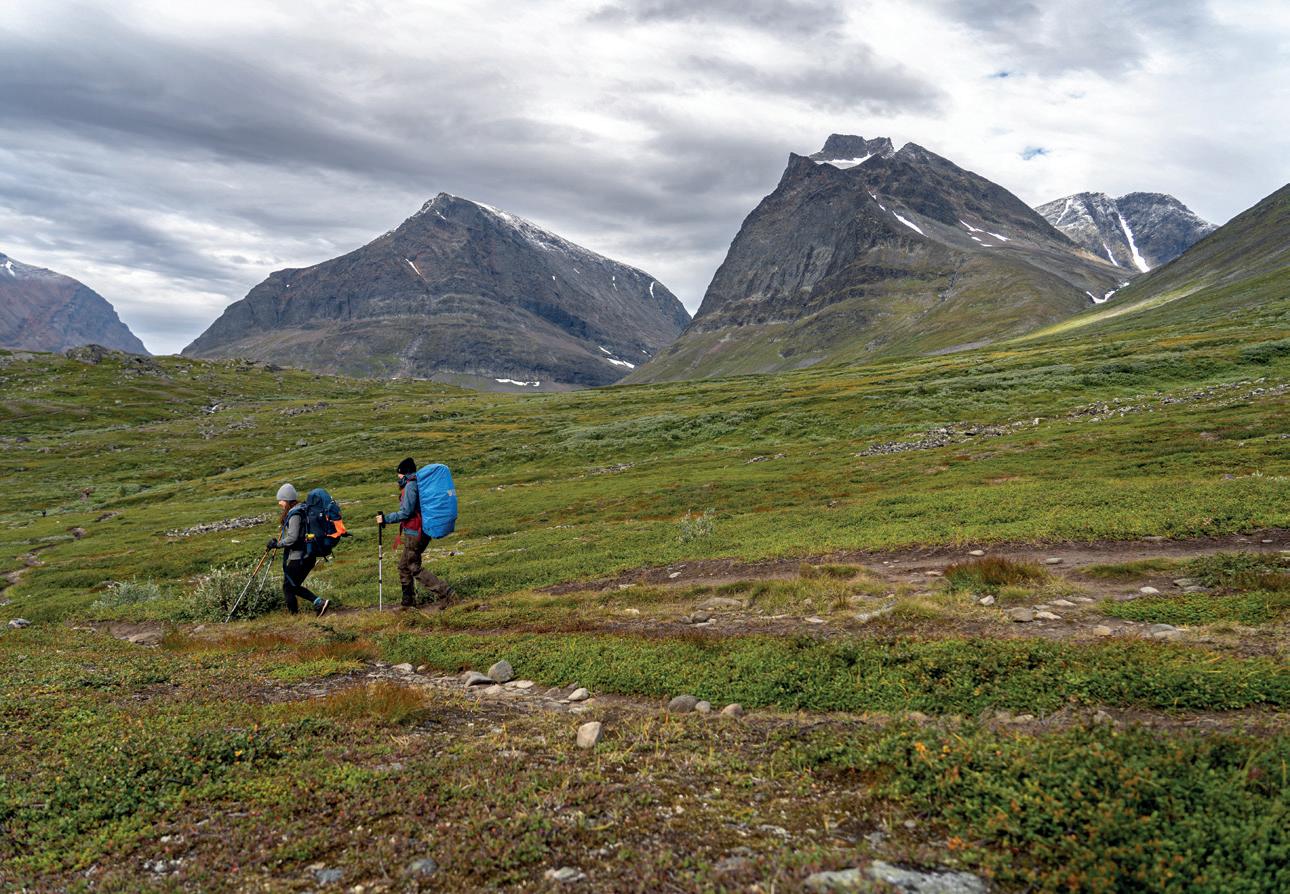
57
Free to Run
A documentary by The North Face
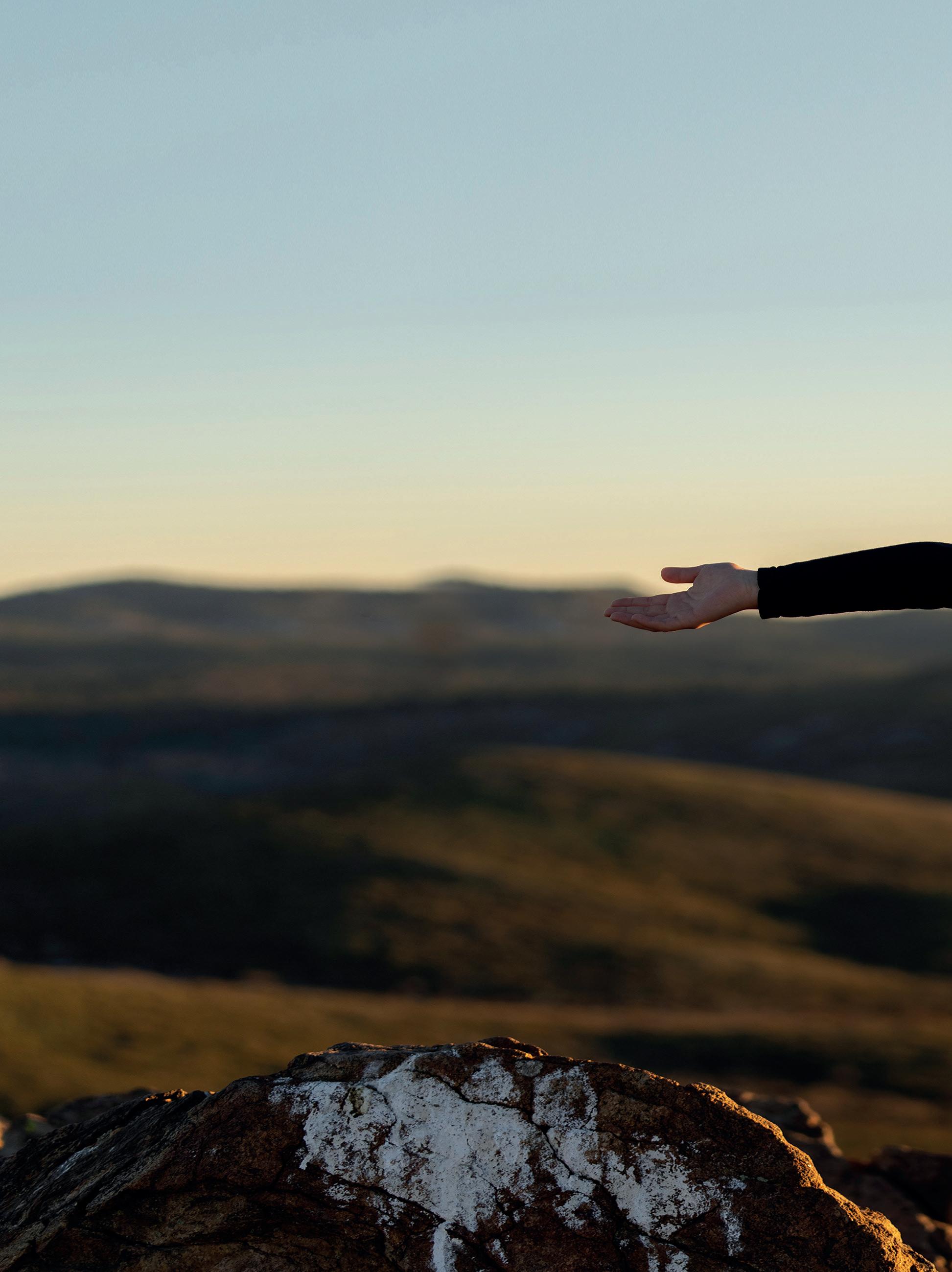 BY FILIPPO CAON
BY FILIPPO CAON

When it comes to social issues regarding other places I always feel a certain unease, this is because I realize that I am particular ly ignorant about it. I find it very difficult to make a judgment on topics like the value of women in the Middle East or the consump tion of forest in South America.
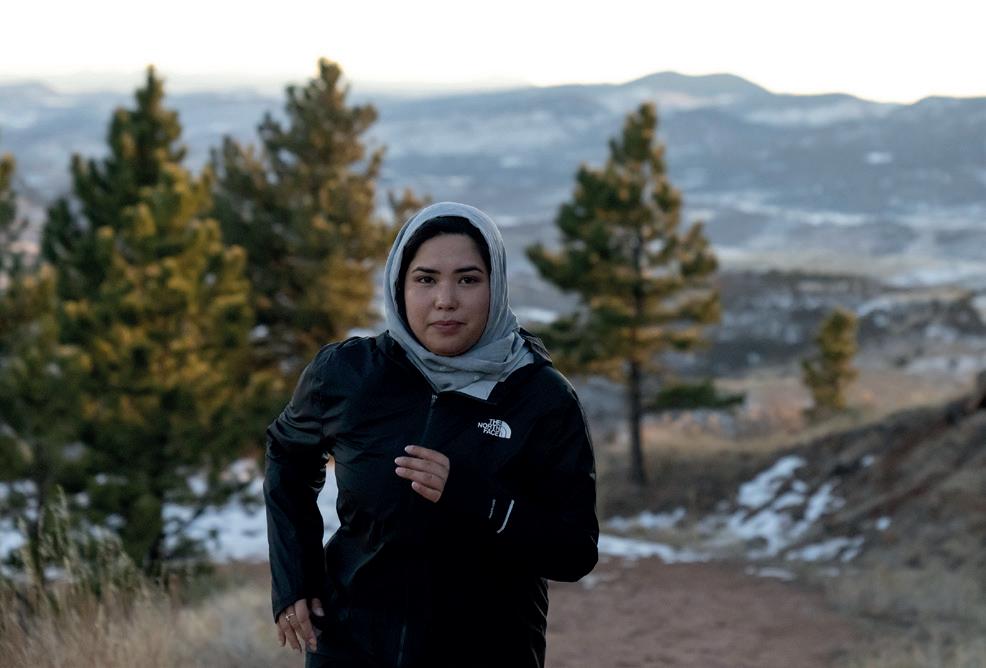
For example, when it comes to Afghani stan, a few confused images come to my mind, probably wrong. We are generally very ignorant about that part of the world, not just on a politically point of view. We don't even know exactly what Afghani stan is like, what shape the houses have, what the landscape is like, how far away one city is from another. In short, it is very difficult for any of us to be able to imagi ne ourselves walking through the streets of Kabul by closing our eyes: how are the streets in Kabul? Who knows, let alone have a clear idea of how the people who live there actually live. We know nothing, or if not nothing very little. And what little we know is the confused idea of an
abstract and distant piece of the world, the result of the sedimentation of half-he arted stories, deposited in our collective consciousness.
This is the first thought that came to my mind when I saw Free To Run. Free To Run is a documentary produced by The North Face, you can find it on YouTube, it lasts half an hour. The movie develops on two tracks, the first is the goal of the American athlete Stephanie Case to run and finish Tor Des Glacier (TOR450), the second is to tell the activity of Free To Run, an association founded by Stephanie which would like to enable women to safely and boldly en gage in outdoor activities in war-affected regions, through a combination of sports programs, life skills development and com munity outreach (this is what the website of the association says) in other words, hel ping women to reclaim public space and change their point of view on the roles they can (and should) play in a society (you can close the quotation marks).
60

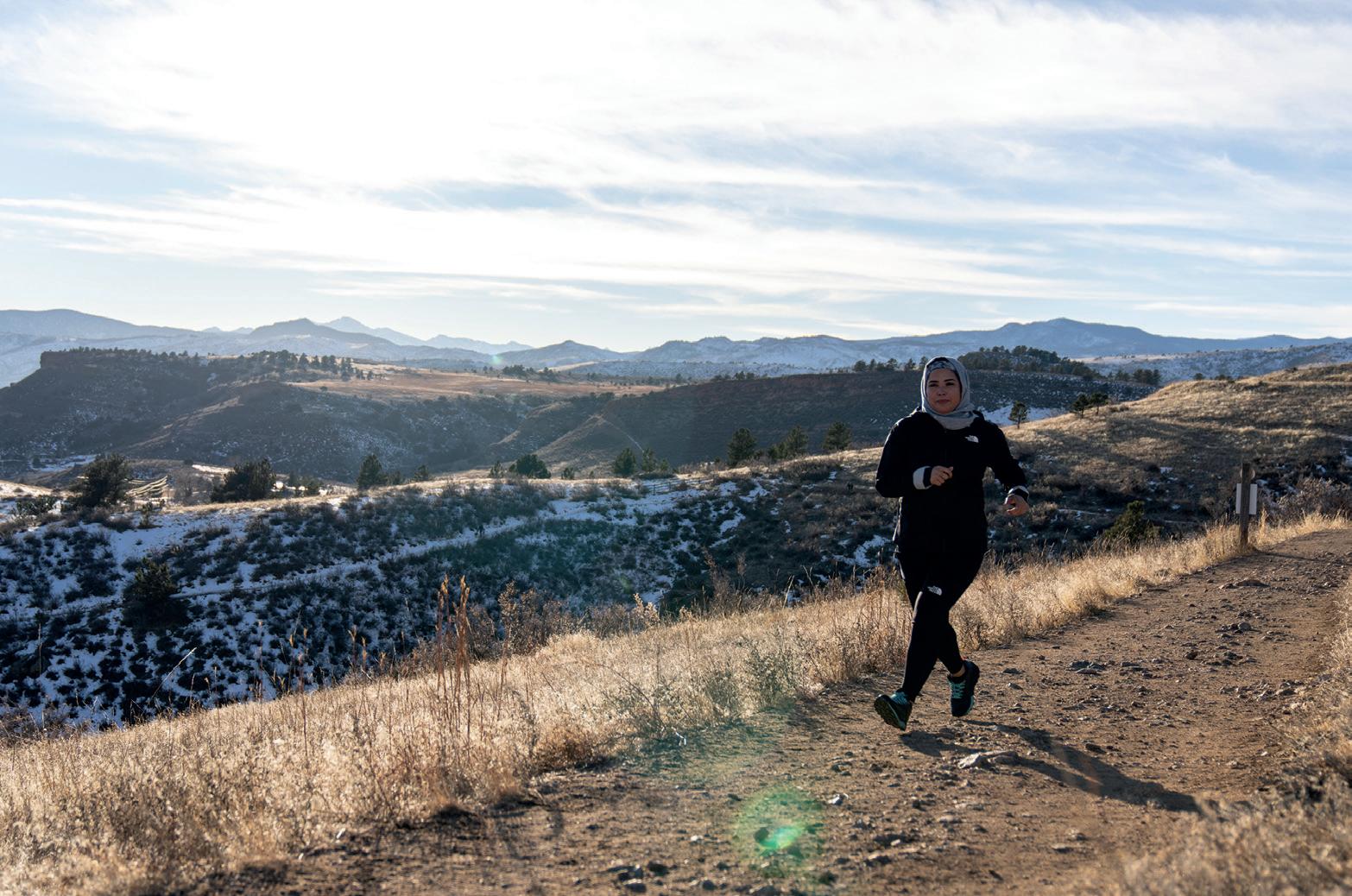
To be malicious, a question comes to mind: are we really sure that in a country with so cial and economic problems like Afghani stan what we can do for them is make them go for a run? Or is it not the result of Western hypocrisy, which for some reason makes us feel obliged to expire our sins, without un derstanding that a right that we take for granted for them is only the consequence of a system of social, thought, religious, use the word you want, that at those levels cannot be fought through symbolic actions?
In reality it is more fragmented than that. In order not to tell the history of Afghanistan in the last fifty years, and above all to avoid telling it with a thousand errors, it is enough to remember that up to a year and a half ago, before the Taliban regained control of the country, the quality of life in Afghanistan was such as to allow a Western association to work in a perspective that we would defi ne as progressive, including, through sports. All this ended in 2021: do you remember the images of people trying to get on the planes taking off from Kabul? That’s the moment. Stephanie's association was forced to leave the country, but managed to expatriate some girls. In short, at a time when helping Af ghan women to find independence through sports was clearly no longer at the top of the priority list (the bombings were more wor rying), Stephanie's association did not just
pack up and leave, but tried to the last mo ment to do what it was able to do, with the hope of not saying goodbye to that country, but rather a, however tragic, see you soon.
Put in this way it all takes on a different me aning, doesn't it?
Two of the girls who managed to leave the country, Zeinab and Zahra, are now stu dying and working with the association to preserve the rights of people like them, but not with that idiot respectability typical of us Westerners who do charity races and give money to charity, but with the aware ness of a person who has lived through that condition. As Zeinab says in the film: "yes, I'm grateful for the opportunity I had, and I'm going to run, but I can't help but think of all the people who are still there". In other words, we do not think we are doing so mething so subversive, so useful to someo ne else, we just run for ourselves, and at the same time we do something to free Afgha nistan, but the two things are not related. Stephanie's association did both: she tried to use sports when it seemed like an effective tool, and did more when that wasn't enough.
I don't think running has any social meanin gs, running doesn't give freedom, but if we can tie our shoes and go out it means we're free, so let’s work for a world where everyo ne is free to go running.
62
I don't think running has any social meanings, running doesn't give freedom, but if we can tie our shoes and go out it means we're free, so let’s work for a world where everyone is free to go running.
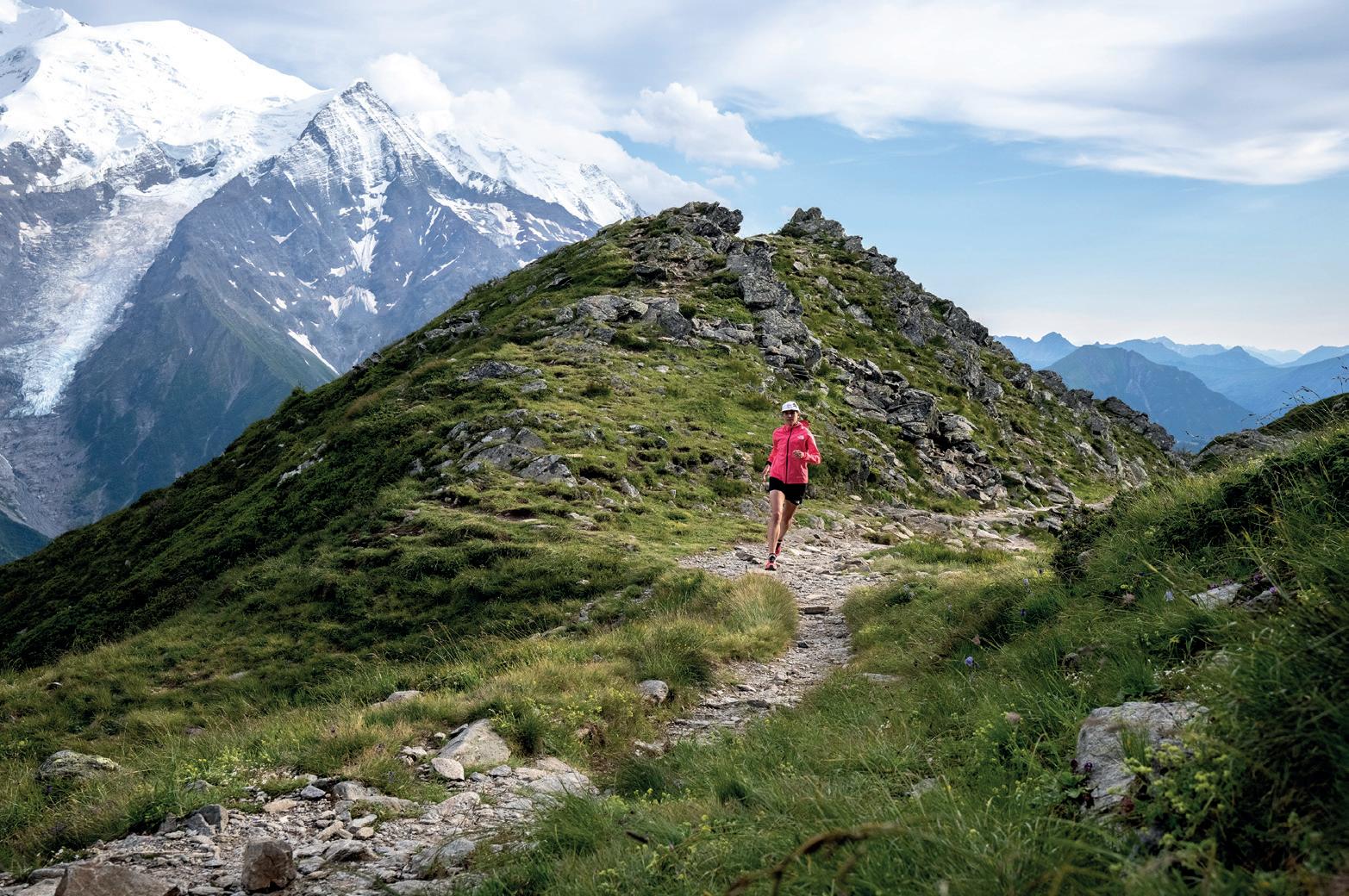
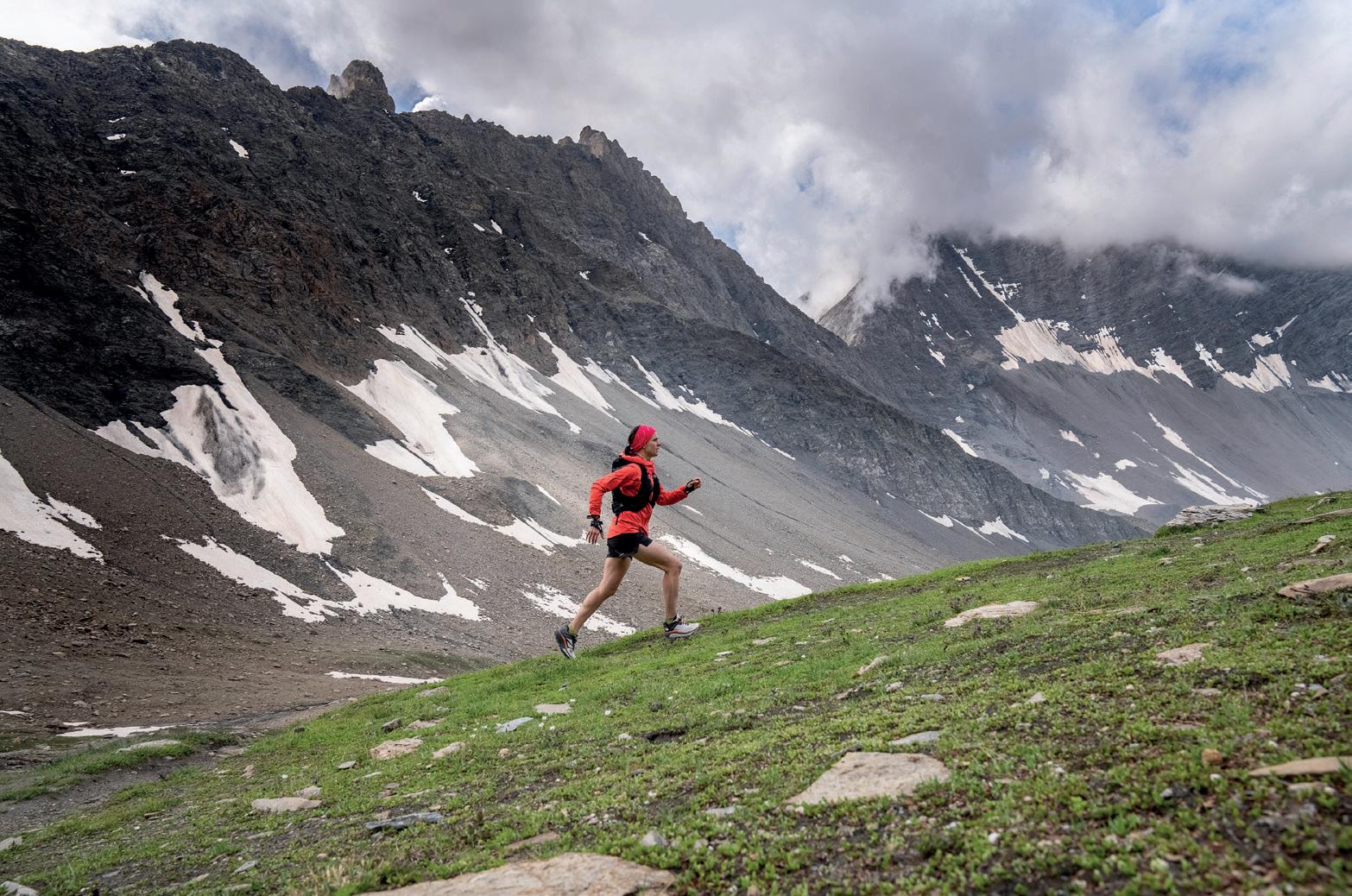 Through the Forest
Through the Forest
Running without a destination
BY CAMILLA PIZZINI
Every year, during summer, thousands of Finns with their families walk into the woods close to their homes and begin to look for something. There are those who wonder what is so important for bringing an entire family to the woods, but in fact there is something surprising: hundreds of square meters of blueberry plants. Finns collect huge quantities of them and freeze them in anticipation of winter. And this is how our journey begins: in the endless expanses of greenery and lakes of Finland to eat blueberries during a run.
64

The lakes region

We are in the Kymenlaakso region, in one of the southernmost and greenest areas of greater Suomi, surrounded by national parks and seemingly end less stretches of water. Every few kilo meters, while the car passes through cultivated fields, we find ourselves admiring lakes, small marshes and rivers, all arranged with an order and cleanliness that in my Italian spirit se ems almost utopian. The destination?
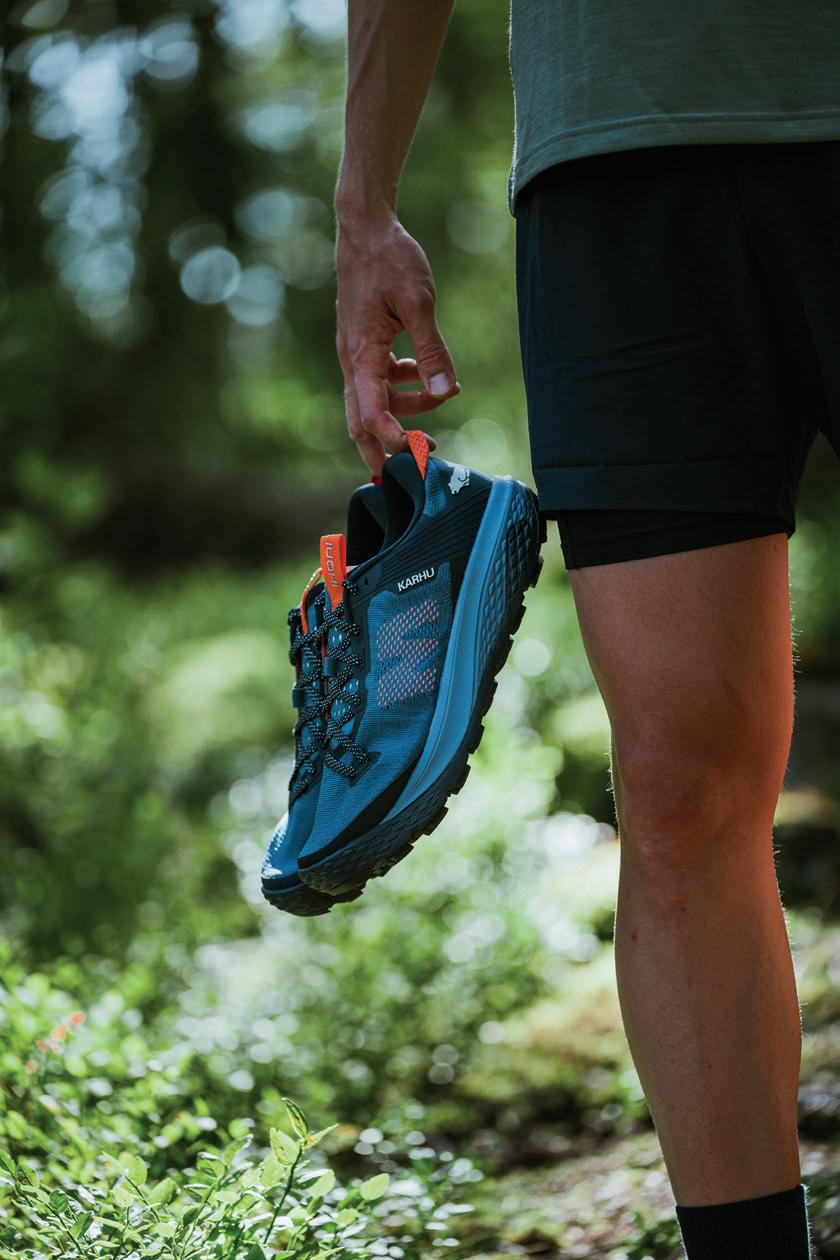
Repovesi National Park, a place that perhaps perfectly embodies the wild spirit and the feeling of: "Wow, what place is this?" Also known as "the lakes region", it encompasses dense forests that alternate with deep lakes and waterways, all connected to each other, across a hilly landscape. With its varied and technical terrain it is the perfect place to train and discover something new.

66
The new Ikoni Trail

On the occasion of the iconic and annual Running Camp Experience, we are with Karhu Running who presents us the new and original Ikoni Trail and we, waiting for an adventure, are already along on the routes at dawn to test them. Enlar ged volume to offer greater comfort to the foot and a raised profile to ensure extra protection, this is the trail newborn of a company that has made history in the running world. With the addition of Ascending Fulcrum, the AeroFoam Trail to cu shion the impact of running and finally a new redesigned sole, we will not have any problems on any terrain. Ikoni Trail will take us from rocky terrains to wood-covered forests, to the Arctic tundra.
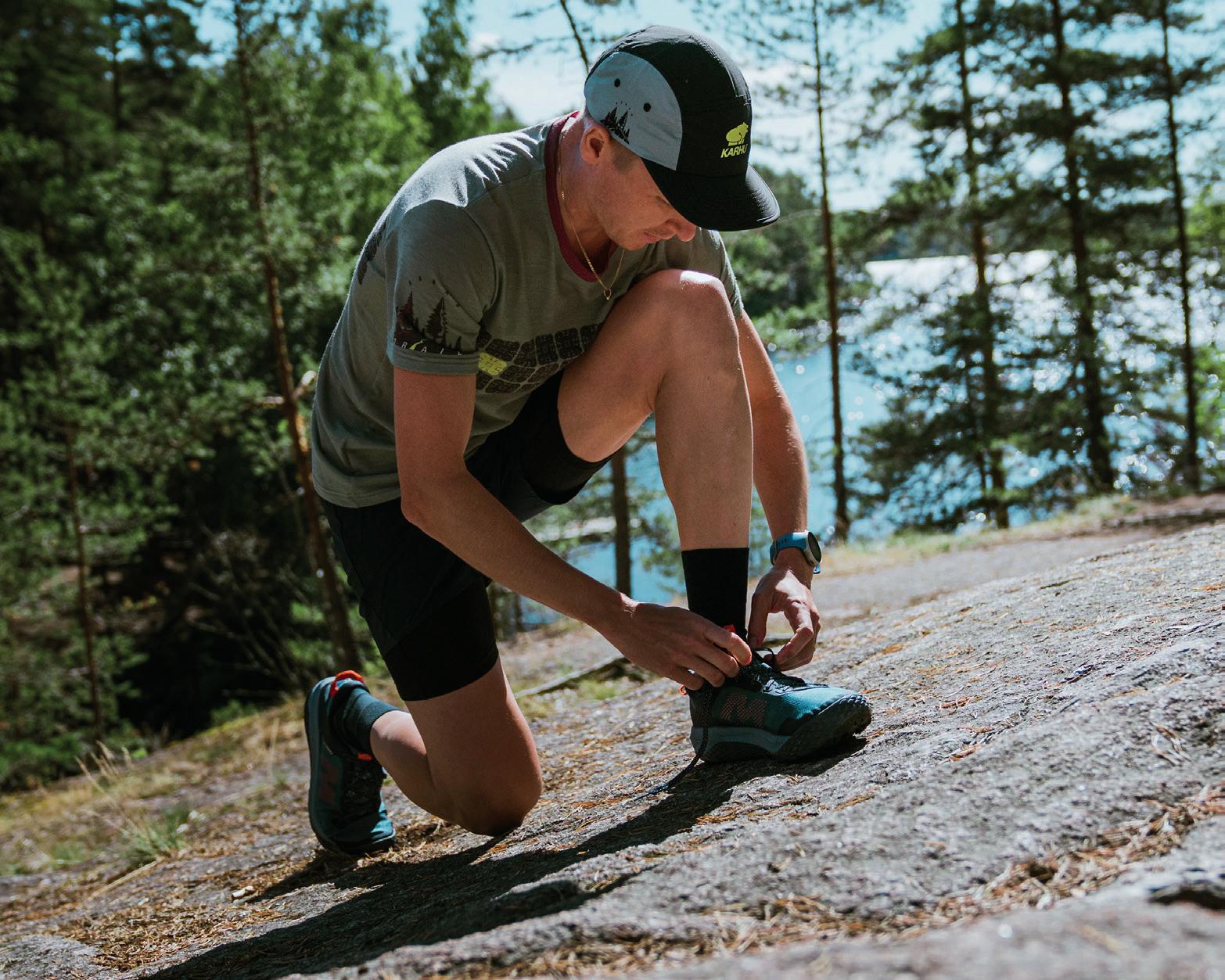
67
Running without a destination
We just need to discover something more of these lands. At our side two Finnish runners: Ossi Peltoniemi and Hanna-Maija Rantakylä who tell us little anecdotes and curiosities of these unspoiled places. Step by step, after a further feast of blueberries, it is also time to stop and why not, go for a swim. Although the national park is wild and distant from the city, many Finnish families walk and explore the trails, it seems that the favorite destina tion for each of them is the pristine nature. Although it is summer and we are in a hilly landscape, the temperatu res are reminiscent of those of alpine lakes and alongside us small boats sail on flat water.

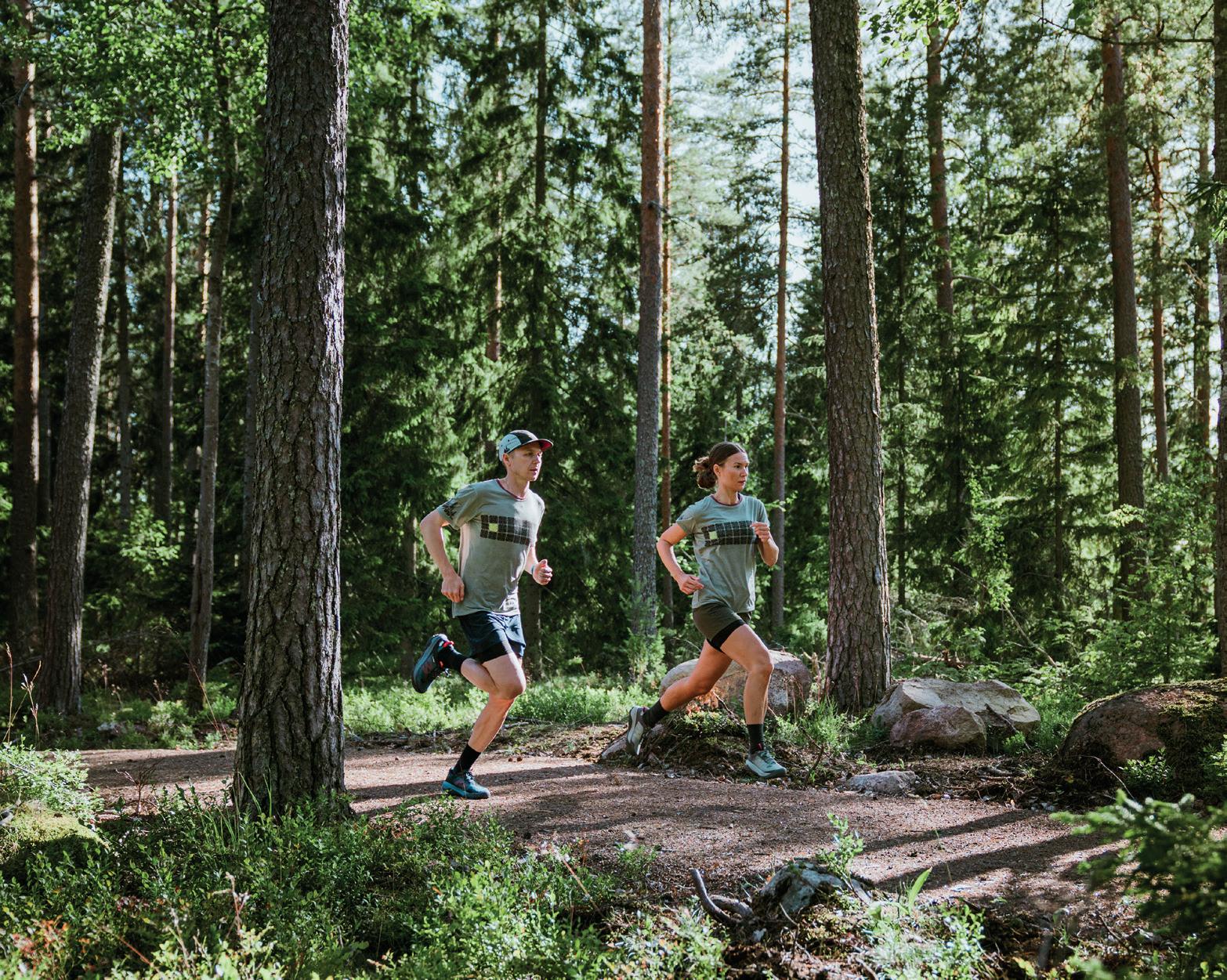
The Running Camp
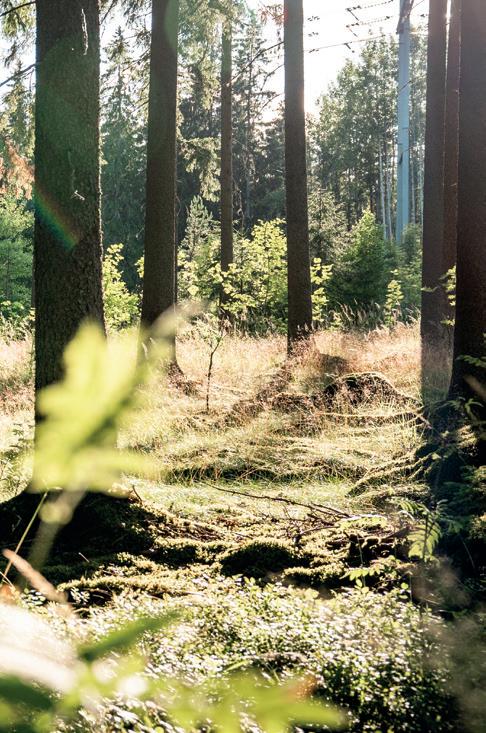
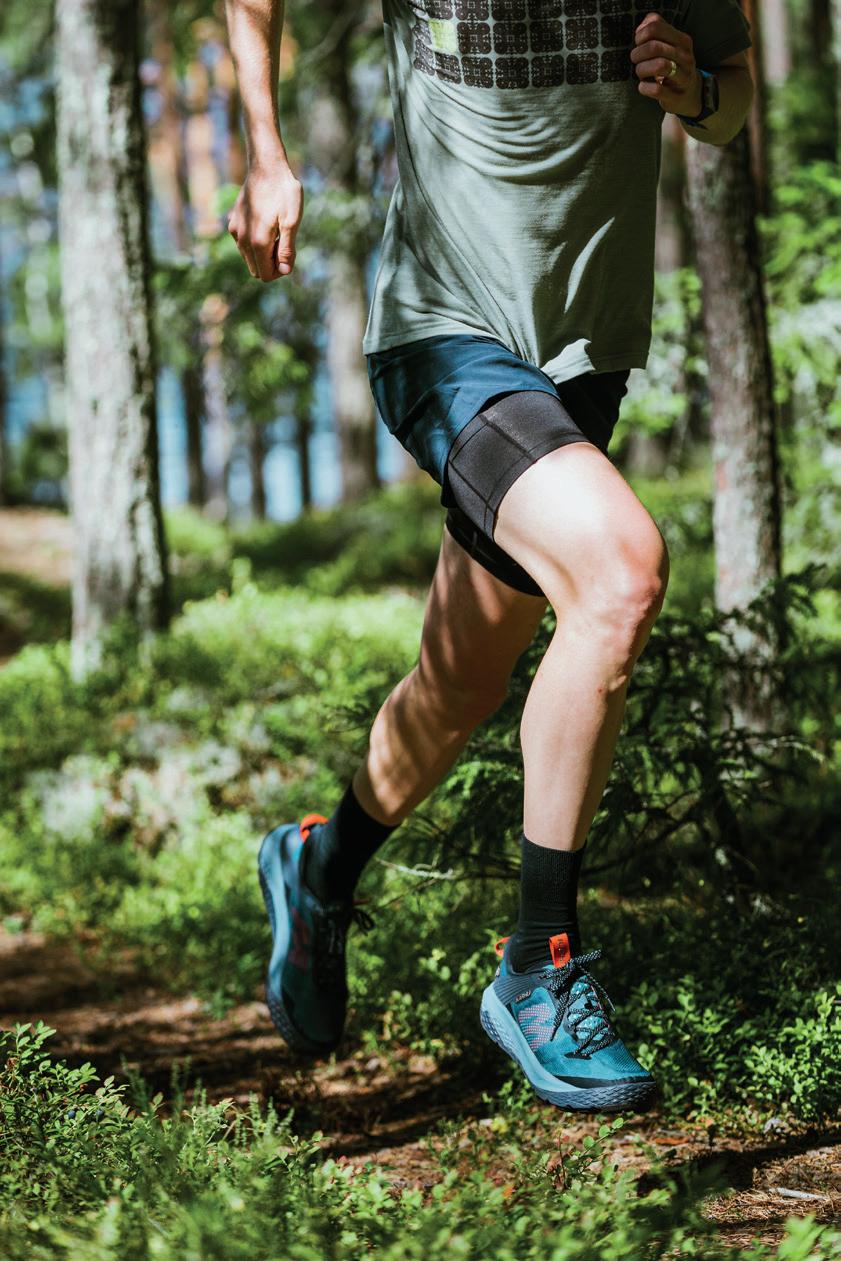
It's time to light a bonfire and enjoy a good dark rye bread and salmon sandwi ch. There is nothing more special than a training day in the forests and good chats with new friends. The beauty of these Running Experiences is just that: discovering new places and sharing the best runs with people who, like us, love this sport in all its forms. We just have to watch the sun go down on the horizon without ever setting. The golden hour in these hills never ends and we just have to keep running tirelessly. Running just for the sake of it, without a precise destination.

69

70
4T2

Gone running
BY FILIPPO CAON PHOTOS ANDREA SCHILIRÒ
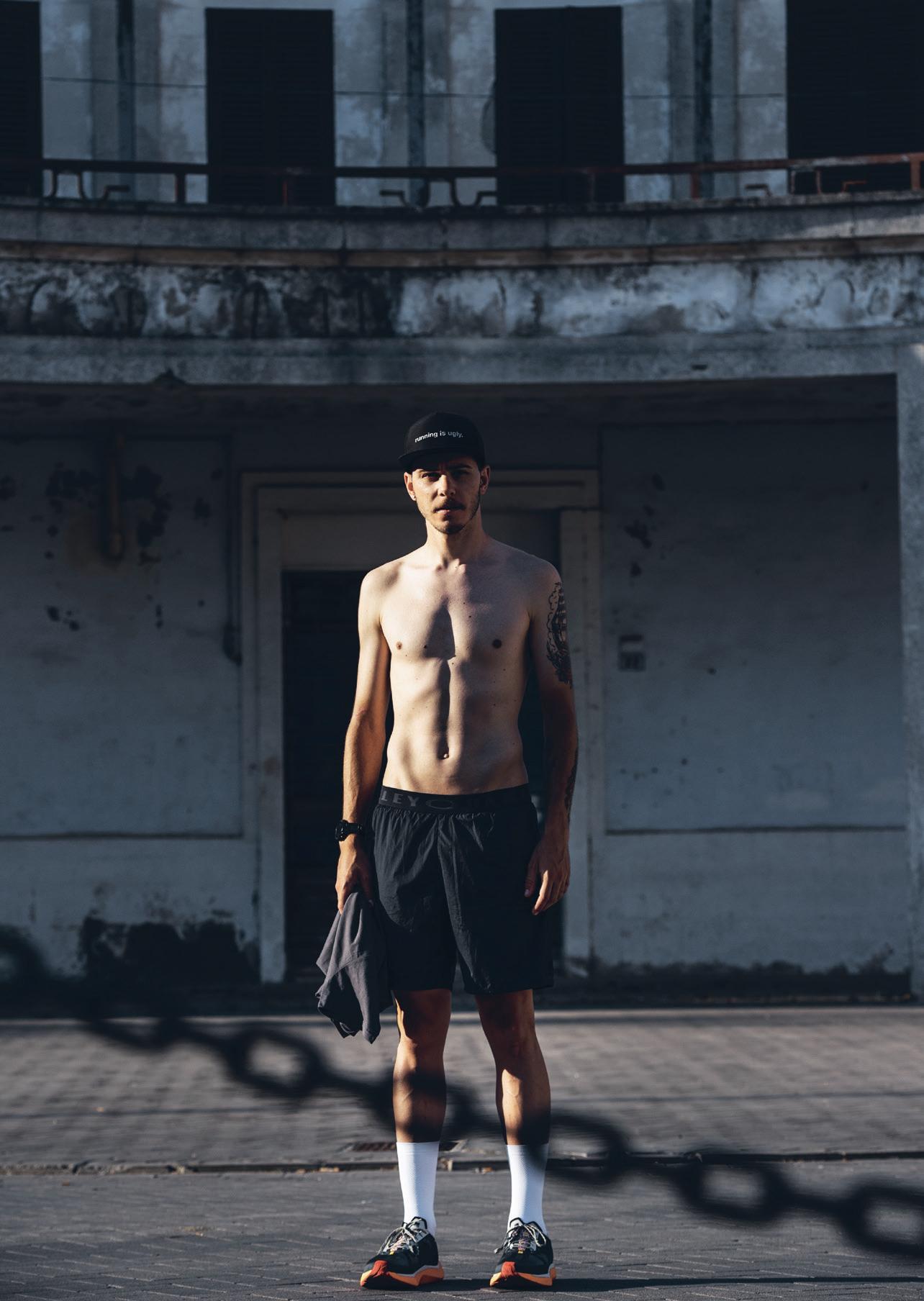
71
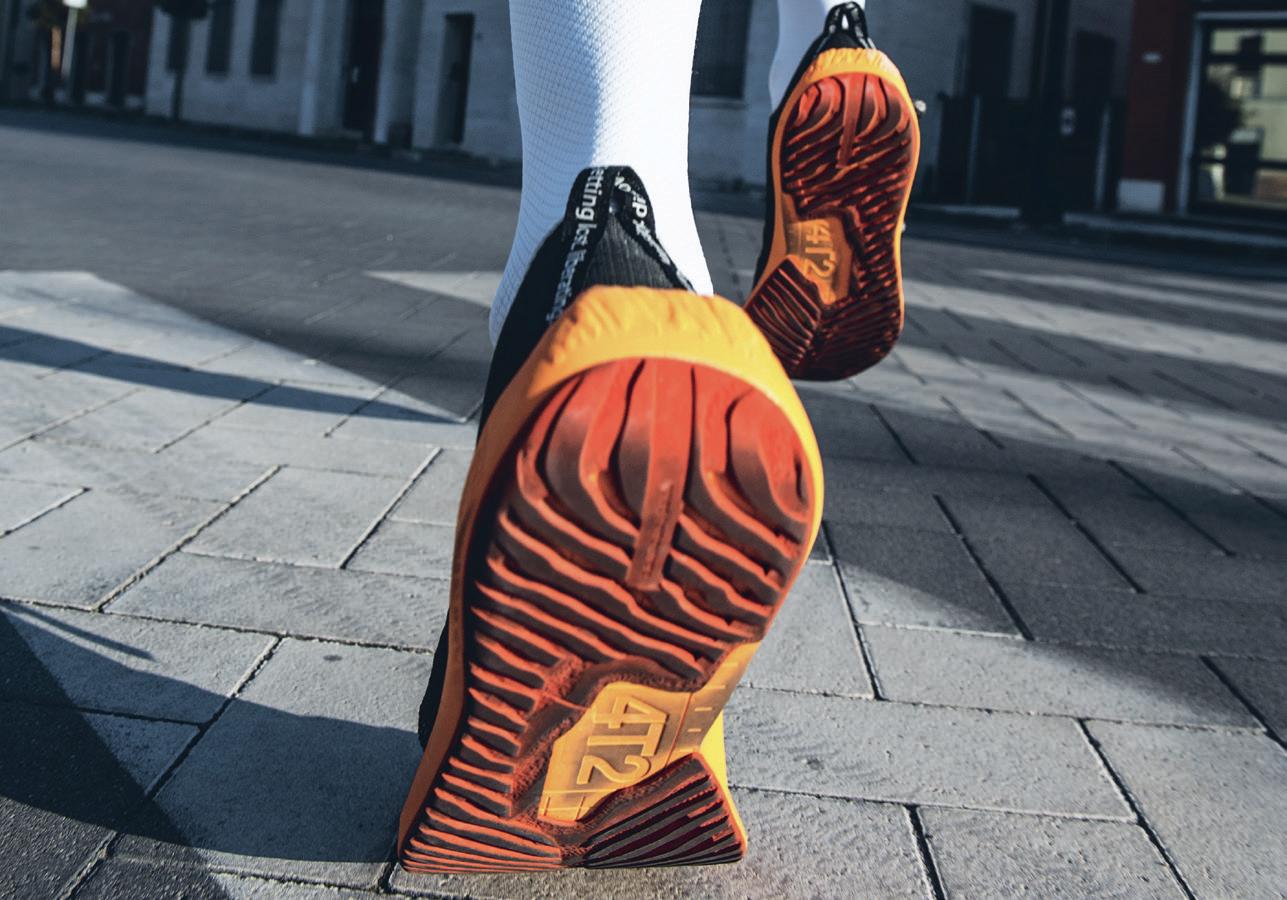

72
The Department of Finance reports that in Italy, in the second quarter of 2022 (April-June), 125,392 VAT numbers have been registered, 15% more than the same period of time in 2021.
To put it simply, this is what Jurian Elstgeest has done, with the difference that he did it in a more advanced country than ours, where the idea of opening a running shoe company sounds anyway bold, but not quite as crazy as it seems to us. After working for twenty five years in big sports companies, tired of the somewhat trite rhetoric of the sector perfor mance and marketing, Jurian felt the need to start a project that more represented his idea of running and sports, which, in short, can be summed up as: less rhetoric about performan ce, more feelings.
That’s how 4T2 was born (you can read it as forty-two), from there he began to develop first a company and then a shoe that reflected this idea, reducing the storytelling focused on products and on materials in order to have a simpler, more intuitive and essential approa ch. Then came weekdays., a shoe with a clean design and quality materials used and assem bled in a linear way: 6 millimetres of drop, a double midsole with different densities and a simple upper, in which the elements of support are reduced to the essentials. The idea behind the project was to develop a product not too structured, without technologies that force the
gesture of running or postural defects such as supports, plates and internal buttresses. In short, a no-frills running shoe: traditional la cing, upper, sole, double midsole, and that's it. According to Jurian, these were the features necessary to get closer to the idea he had: a shoe that does not look exclusively for perfor mance, a simple and intuitive tool for running which is an action that we are forced to com press in the midst of a thousand other things we do every day.
Chatting about various things, I ask Jurian what positioning he would like 4T2 to have in the running panorama of the next few years. It is a world that is changing fast, with many new companies born everyday, which for some un clear reason, manage to become noble before actually producing something interesting. In short, I asked him if he is not afraid (or maybe if he want to) that his products will become the status symbol of one niche of the niche, mainly in big city circles, where running is becoming more and more fashionable. “The problem with these brands” he told me, “is that they position themselves as exclusive. They have prices rather inaccessible, which doesn't have much to do with a sport like running. For this reason we have de
73
Who are these people?
Many of them are people who do not know what they are going to face, leaving a safe and comfortable job to embark on a new project, sometimes, when it goes well, creating new opportunities in an old country, other times unfortunately not creating anything, and often the fault of this failure lies within the old country.

74
cided to place our shoes in a fairly standard price range for today’s market (160 euros, ed), instead of selling them for 300 euros like some niche brands have done lately.”
In fact, that’s a good answer: 4T2 is not the only shoe brand born in recent years, but un doubtedly, unlike others, it was born to realize running shoes, and not for glossy photoshoots in Potsdamer Platz, using models with mullet haircut and who have never run a kilometer in their lives (nothing against mullet haircut, but you get the point). In short, if you misun derstand the fashion drift of this sport, fear not, it does not seem to be 4T2’s horizon. Jurian would like the design to be something in whi ch the customer recognizes his or her way of seeing running, and not something exploited for goals that do not concern the sport itself.
I find interesting the choice of not using any particular technologies, and even more not to develop a communication around this, in a world where it seems like that to make a good running shoe it is necessary to have technolo gies with registered names, written strictly in capital letters. That’s a bit too much. The guys from 4T2 gave two names to the compounds used for the midsole: joie. and flow., because, come on, does it really make a difference to know what they're made of?
Apart from this, the choice of materials is far from random, and it is made with attention to the origin of the products. About the issue of sustainability, Jurian has an interesting opinion, paraphrasing a bit, he told me: "see, it would be easy for us to say that our shoes are sustainable, as everyone does, because the com pounds we use are of biological origin. But the truth is that a running shoe is never sustainable, it is still made of chemical compounds, even if of vegetable origin. That’s why we don't say that our shoes are sustainable, but we try to make the pro
cess sustainable, creating a product in an intelligent and modular way. That means that the molds, from which the different components that make up the shoe are obtained, have a standard forms so they can potentially create different patterns depending on how they are paired. This, for example, applies to the double compound of the midsole, in which the layers of foam with different densities and different drops can be modulated and coupled in a different way creating different products.”
That means creating a shoe starting from sim ple and separate pieces that can be divided easily. For example, the side of the midsole on which the sole is applied is completely smooth, to allow a shoemaker to easily resole the shoe, giving to it a second life, as the brand itself writes on the website, to "cut the grass or to walk the dog ;-)” (the emoji here is theirs, ed).
It is an interesting project, of which we are cu rious to see the developments. There are inte resting news on the horizon but they forbade us to say anything about that ;-) (and that’s emoji is mine).
It would be easy for us to say that our shoes are sustainable, as everyone does, because the compounds we use are of biological origin. But the truth is that a running shoe is never sustainable, it is still made of chemical compounds, even if of vegetable origin.
75
Western States is always Western States Luzia Buehler

BY FILIPPO CAON

It is not known why, on the Saturday of LUT we all gather at Col Gallina. One goes to watch others suffer, to give extreme unction to those who have withdrawn, to complain about their problems, or to drink a beer, strengthened by the fact that, on the other side of the route, there is someone who is suffering. At Col Gallina we are always there, physically, but our heads are elsewhere.
After a morning sunbathing on the meadow of the hut, more or less around coffee time, on the other side of the world, in the Sierra Nevada mountains, another race begins, just when ours is about to end. It is Western States 100-Mile Endurance Run, the first 100-mile run in history, a legendary race won by the greatest ultramarathoners of all time, and that we poor people dream of every year, every time we lace a pair of running shoes.
I haven't understood why that race has become so important yet. Maybe it's awe, maybe it's that everything that doesn't have a solid anchor sooner or later slips to Cali fornia, as Frank Lloyd Wright said. I do not know. The fact is that every damned June, at Col Gallina, below the 3.224 meters of the south-east face of Tofana di Rozes, we don't dream of being there, but in the dusty canyons of the Sierra Neva da, sweating the last drop of soul, with a water bottle in hand and a wet bandana tight around the neck.
To make the race even more exci ting, this year there is also a small group of our Italian friends, and then there is another person I know, Luzia. I had seen Luzia for the first time in 2019, in Tren to, three weeks before her second Western States, but we didn't in troduce ourselves. Then I saw her again a few months ago in Liguria, at SciaccheTrail, where we ran the first kilometers together, at least until the race was stopped due to a snowstorm. Eventually, we recor ded this interview six days after Western, which she closed in four th position in 18:08:32.
I still don’t know what is your job exactly. I work as a social worker and work with people who need help.
It seems like a difficult job to re concile with training. Look, if I'm not mistaken, this was your third time in Auburn. 2016, 2019 and 2022. Did you enter with the lottery or did you win with a ticket?
The first time with a ticket, I only had one and I was lucky. It was really hard, it took me 27 hours and 6 minu tes. A long race. In 2019 I won the Ge orgia Death Race, and got the Golden Ticket for that same year, went there and ran it in 20 hours and 23.
You've done a lot of races in the United States: JFK, Sean O'Brian, Black Canyon, Georgia Death Race, Wasatch 100 that you won, three Western States. What do you find there that you don't find here? It's not that great to take a lot of planes, so I've competed more in Europe in recent years, but I like the people you find there. Everything is easier, here in Europe they are all focused on what they do, and they show up hours before the departure. At Western there are 350 people who show up there 5 minutes before the start. We wish each other good luck
and talk about funny things, and then off we go. It's that simple. It is really a different community compared to the European one.
Has the atmosphere at WS chan ged since you first were there? You know, in my opinion it hasn't changed that much. There are always 369 peo ple, and the race is roughly like six ye ars ago. Yes, there are many filmma kers, many photographers, but other than that not much has changed, We stern has remained Western.
And instead your way of approa ching the race, from an emotional point of view, has changed based on how your goals have changed (since it took you almost 10 hours less compared to the first time) or not? Yes, I would say so. In 2016
I realized it was a really nice race, it has a lot of climbing, but also a lot of runable terrain, it's very hot and you have to keep moving if you want to get to the bottom. That year I decided I wanted to go back, so I tried to get a Golden Ticket. In 2019 I came back with perhaps too much pressure on me, because I had the Golden Ticket and I wanted to get there in the best possible way. And in the end I didn't have a great day: I finished eleventh, it
78


took me seven hours less compared to the first time, it went well, but I knew I could do better. Now I have my time, and I think it's okay with me.
How do you prepare for a race like WS while living in Switzerland? I try to run all winter, but I also take the time to ski. So I do train on skis, doing 3000 meters in altitude, so metimes more, sometimes less, and then I try to give continuity to the run during the week by doing spe cific jobs, time run sessions, and easy runs. This year I had Istria, so I tried to work on the climb up to the race, and then I started training more in Ticino, so as to have more runable and Western-friendly trails, while continuing to do uphill work, whi ch helps me more than those based on speed. I have had sauna sessions after workouts, even up to fourteen saunas a week.
How did you manage the race?
As usual you managed to regain positions in the second part, it seems to me that you ran in ninth position for most of the course. The first 50 miles are the most tech nical ones. There are a lot of stones and I had to keep adjusting the pace. During the week before the race I felt quite tired, maybe because of the fli ght. So I walked a lot and ran a litt le, so much so that I said to myself “today will be tough”. When I got to Robinson Flat, and found my crew, I felt better, drank something fresh, ate and left. From Robinson Flat until after Forest Hill I felt good and was able to go on with a stronger pace. I think it was the part where I did best. I keep taking positions. The hottest part was between Forest Hill and Rucky Chucky, the air was burning. At Robie Point, which is the last mile, I passed Emily, who had run the first part of the race together with Ruth Croft. From Rucky Chucky to Pointed Rocks they kept telling me I had two girls in front of about 5 '. One was Marianne Hogan, who had
passed me at Rucky Chucky, but I di dn't know the other was Emily. After No Hands Bridge, on the last climb to Robie Point, I saw a front and saw it was Emily. I caught up with her, I told her to keep pushing, but she was really tired, so I went ahead and overtook her in the last mile.
It is more important for you the fifth place at UTMB last year or the fourth one at Western? They are very different races, different ter rains, different environments. I don't think it's the position that makes the difference, but the time. What I did at Western for me is a great time, as far as UTMB is concerned I think I can do even better. More or less the same feeling I had after the 2019 Western. I knew I could have done Western in two hours less, and now I did it and I'm proud of it. At UTMB I can still do better. You can have a great race but just have people in front of you that day faster than you, and who ca res? It is not the placement that mat ters, but the time you could make. When you know that's the best you can do, that's okay.
I'm interested in the emotional aspect of competitions, especial ly wit high-level athletes like you, who approach competitions with more ambitions than I do. Regar dless of the result, we all dream of racing WS one day, as well as UTMB. But which of them do you have a more intimate memory of? Or maybe you feel more fond of Wasatch, I don't know, even if it's a less important race, why not. Yes, I think I get what you’re saying. From this point of view, We stern is a much more emotional race than others. Maybe Georgia Death Race was equally thrilling. Not so much for the Golden Ticket, but be cause I had lived it really well, with friends and so on. You take away many memories of each race, and the memories of WS are more alive, even those of 2016, much more than
UTMB. In Chamonix you spend a lot of time alone, for me WS is a really nice place to run, people are all friendly, volunteers are nice, it is just a different level.
Have you ever cried at the end of a race? 2016. Because it was so hard.
Explain me this: what the fuck is a Schissihüsli?Ahah. I don't know, people keep putting pictures of be autiful mountains when on vacation, perfect places, beautiful landscapes, so I said, come on, that's enough. So I started taking pictures of the Schis sihüsli when I see them.
Ok I get it, but are they really wo oden baths in the mountains? Yes, of course they are true! They are used by the shepherds. Don’t you have them in Italy?
Haha, no, never seen that. Anyway, I promised you this interview in Sciacche but I would say that now there was really a good reason to do it, thanks Luzia. Thanks to you.
80
At Western there are 350 people who show up there 5 minutes before the start. We wish each other good luck and talk about funny things, and then off we go. It's that simple. It is really a different community compared to the European one.


From rocks to waves and back
BY ILARIA CHIAVACCI PHOTOS FILIPPO MAFFEI
A photographer and a climber compose a visual story that draws a line that unites surfing and climbing in a series of shots that have become an exhibition.
If you are born and raised in Versilia, Apuan Alps can only be a constant in your life: they dominate the landscape from practically any point, you see them driving, walking, surfing.
82

This is how photographer Filippo Maffei and SCARPA and Ferrino’s climber Luca Andreozzi met, united by having both grown up under the shadow of these fantastic mountains and by a passion for surfing and climbing. We meet in Filippo's studio in Camaiore, a village wedged between the sea and the mountains from whi ch some of the most popular rock faces in the area can be reached on foot in a few minutes. The studio is full of things, there are books by Richard Avedon and Henri Cartier-Bresson, but you immediately understand that Filippo's playground is the sea: in addition to the volu mes by Chris Burkard and Todd Glaser, there are also a thousand magazines dedicated to the world of surfing and skateboarding. After all, Filippo made his bones, even as a photo grapher, in the water, following athletes and shooting campaigns.
On the huge work table there are the ten prints of the project that Filippo and Luca created to gether, Lines in the Mind, shots of great visual impact that draw a line between two worlds, surfing and that of climbing, in some ways very similar, which were exhibited at the Manifattura Tabacchi in Florence. A line unites them, and for both of them the line is a fundamental element of the athletic gesture, whether it is a route or a wave. Luca, who surfs and started climbing at a very young age, made this connection expli cit thanks to Filippo. The first time on the wall for him was at the age of five, wearing old shoes from his father who, taken out of exhaustion by so many requests, accompanied him to climb. As soon as Luca touched the rock for the first time, he immediately understood that climbing would guide his entire life, only that at the time there were no gyms, or schools, as widespread as now and probably his approach to climbing now depends right from that. There were no other children climbing: Luca had to invent how and when to practice. A long journey that led him first to Turin, where he learned to draw indoor lines, and then to Florence, where he opened Area 51, his own climbing gym.
We are around the table, their project is there and you can feel how much passion they both feel for these worlds, which they have united together.
Filippo: I’ve spent practically all my life by sea, but Apuan Alps were always there, lo oking at me and exercising this enormous fascination on me. I used to go to quarries a lot for shooting reasons, but I had never tri ed climbing until recently, and the more this passion grew in me, the more I felt and gra sped affinities with surfing. I began to visit the Candalla area assiduously and so I met Luca, who involved me by making grow that need in me to try to climb those walls, which for me is an essential thing: whether it is water or rock I want have the same perspective as the athlete, share the same physical effort and the same element. My goal in following Luca on the face was to get as close as possible to what he himself sees it. The feeling between us was immediate: we took the first shots in Calafuria, near Livorno, a whole afternoon in which he climbed and I shot in total silence, with only the waves of the sea in the background.
Luca: When we started shooting, immedia tely came out the photos that would then become the exhibition, I had just put on my shoes and I was just warming up, while Filip po had started taking test shots. The harmony was immediately total, as if we had known each other for a lifetime.
Filippo: What I liked about Luca right from the start is his approach to climbing. Yes, he is technical, because he is very strong, but he also has his own artistic style. It’s his own way of experiencing the mountain, with Ray-Ban, jeans and hair all over the place.
Luca: I’ve been climbing all my life but, espe cially in recent years, I have tried to do things that truly reflect me, to give my vision of clim bing. For me it is a sport, yes, but also a way of being and of exercising my creativity. I dres sed in an atypical way compared to the clas
84

sic climber precisely for this reason, because I have always liked to give it my personal touch: today, for my tastes, the emphasis is placed too much on performance and we’re losing all the facets that for me are essential when it comes to climbing. In the gym I see people climbing every day, and it is clear how the freedom ap proach of this sport is going to be lost: it's all numbers, grades, codifications. Breaking the mold a little was great, Filippo put my vision of climbing on film.
Filippo: We both come from the world of sur fing and skateboarding, which is a well-roun ded lifestyle, these are not "just sports", but they embody worlds. Even just the fact of turning to look for the right spot to be able to express your self at best is something that belongs very much to the surf culture, or street skate, in which you have to choose where to practice and then find the way to place the functional lights for the shot: it is something that differs a lot from hard and pure performance. Thanks to Luca I discovered where to climb close to home, both on Apuan Alps and on Romito, a particularly unusual location even for locals. It all started with my request to find a spot from which you could see the sea.
Luca: Here, creativity in climbing for me lies precisely in this, in where to go to look for climbing: this is an indication of a research process that is very, very creative. Usually we tend to always go to the same places, where everything has already been discovered, alre ady cataloged, already done and we simply go to play sports, then repeat a gesture. For me, however, climbing is not this, but a process of research and adventure: to see a line where no one has ever seen it, or to look for it whe re no one has ever even wanted to look, as in the case of Calafuria, which is a place totally off the maps of climbing. It is a place that has natural shapes and crazy lines, where I have been going for years to look for new toys, so when Filippo told me about the project I had no doubts. But even in Camaiore itself, which
is certainly not unprecedented in the sport climbing panorama, we went in search of lines that were mainly aesthetic, not giving a damn about technical information or grades. On the contrary, I made Filippo choose the lines that captured his photographer's eye.
Filippo: Between climbing and surfing there are many connections, starting from the more mental aspects up to the purely physical ones, from the concentration, which both disciplines require, up to the fact of being totally immer sed in an element that is bigger than you, be it the sea or the mountain, which requires you to have a deep respect. You are alone with your self and in contrast with this element with which you have to find a balance, you have to find a way to deal with it, a line. You have to find a line whether you are riding a wave or whether you have to get to the top of a wall and you have to have it in your head before putting yourself into it, you must first visuali ze it and then put it into practice.
Luca: If there is a union between surfing and climbing this comes out clearly in Filippo's work, we both surf, we both come from Versilia and we both have found our way to tell about climbing, which for us is very close to the mood and the philosophy of surfing. It is a very fasci nating combination: if you think about it, clim bing, just like surfing, is an activity that can be experienced in many different ways, but it cer tainly calls you to stay outside, in nature. In one case it's just you, the board and the wave, in the other just you, the rock and your shoes. If you live it as we lived it, it is just like being at sea and having to choose which wave to take: cho ose the line you like, the one that captures you, and climb it, without thinking about the grade of difficulty or the technical aspects that a clim ber normally would look for. In this the appro ach, the two disciplines are similar and then they are both individual sports, where however you share the same element with others: the fact that you are there, both doing the same thing, makes you somehow accomplices.
86
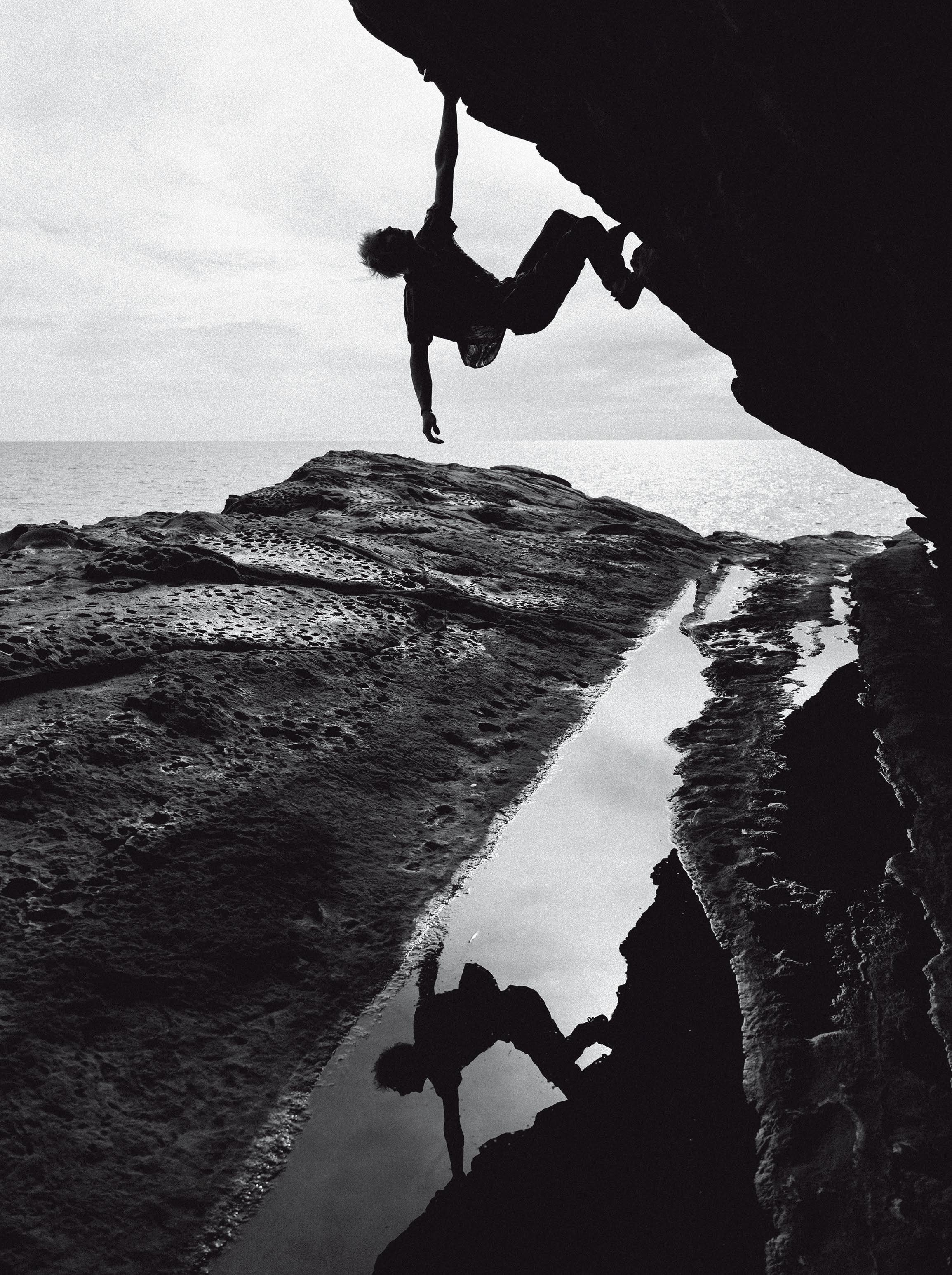

88
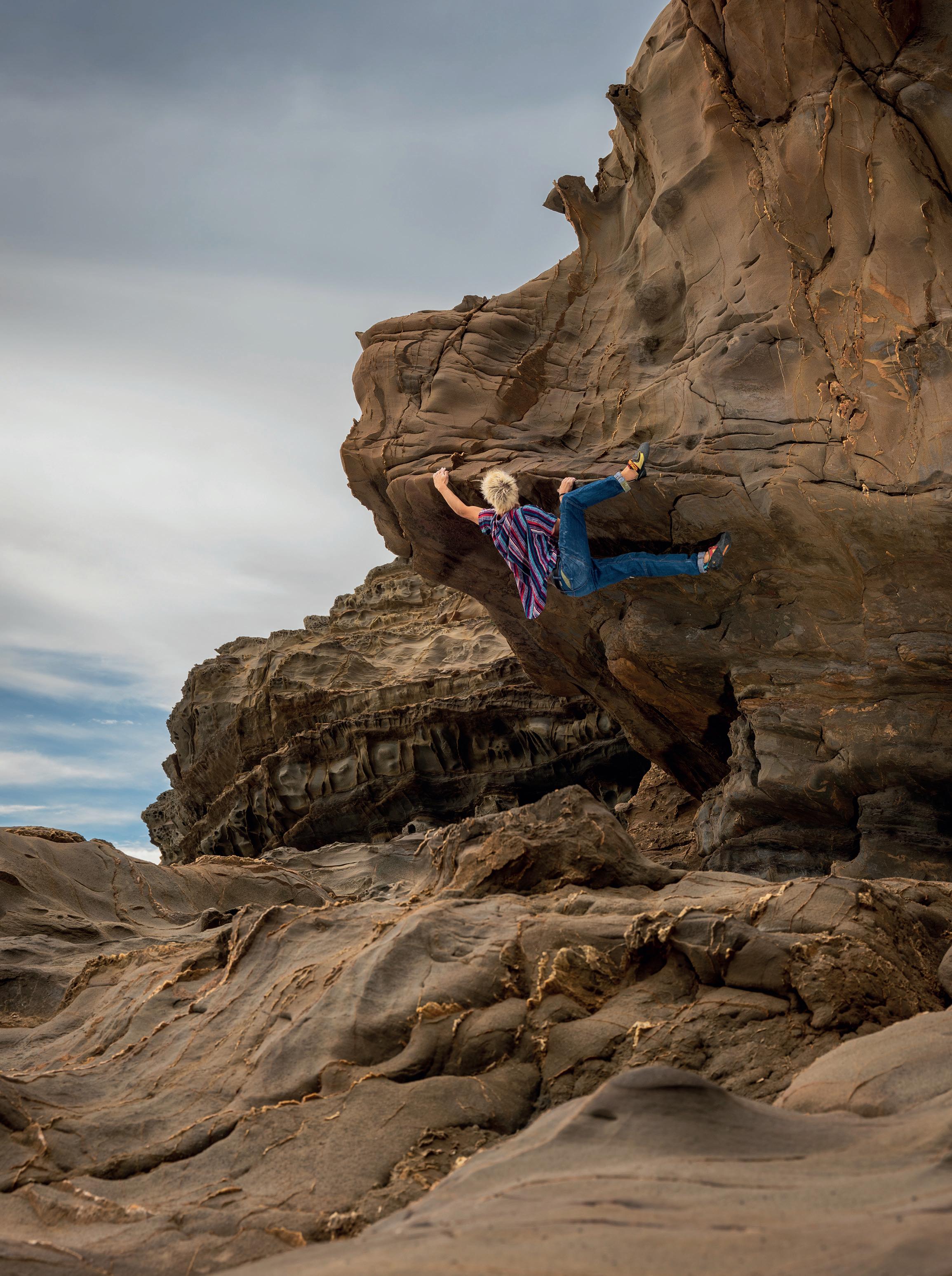
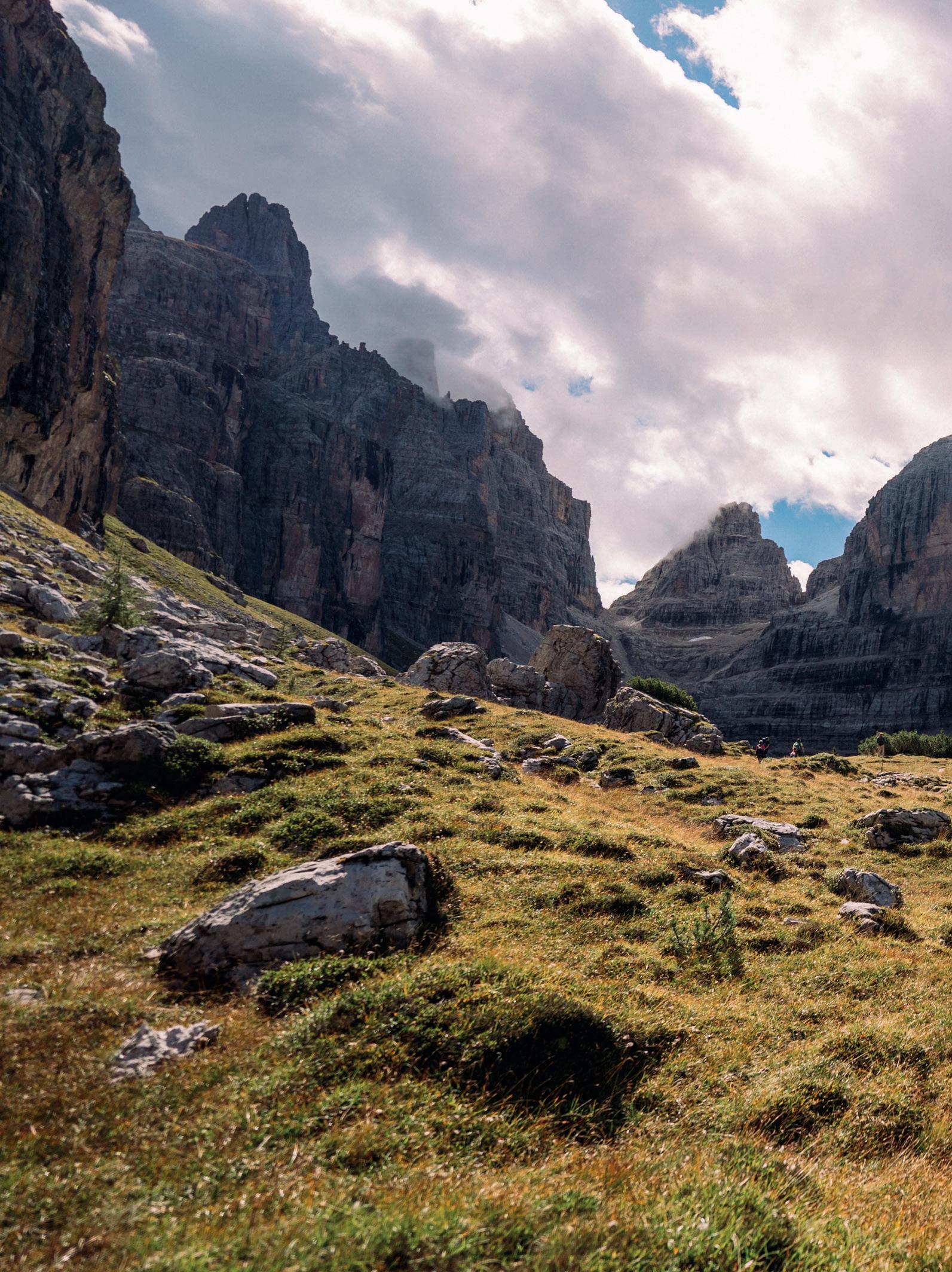
Dolomiti di Brenta Trail
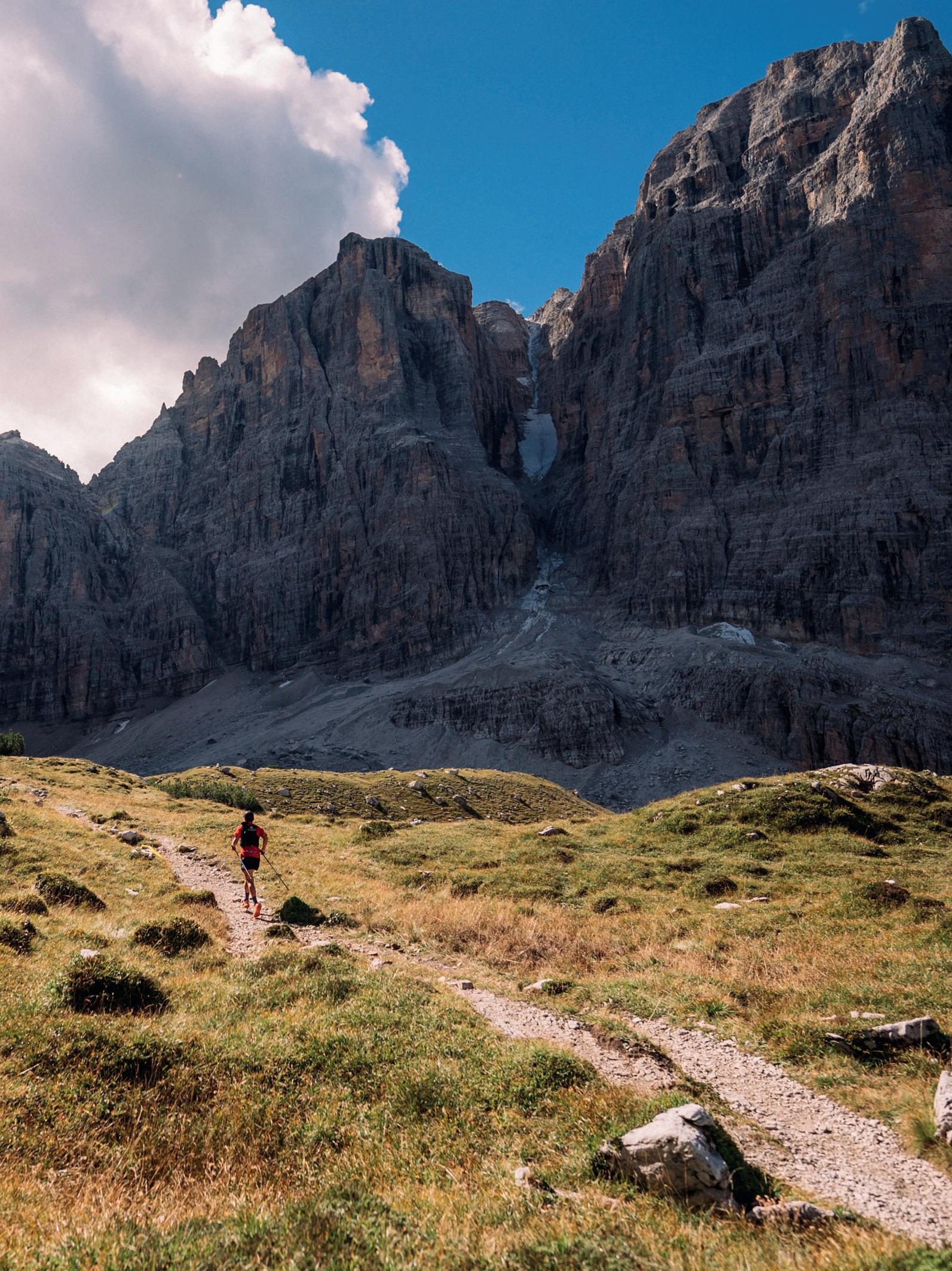 BY FILIPPO CAON PHOTOS ALICE RUSSOLO
BY FILIPPO CAON PHOTOS ALICE RUSSOLO
Last September with The Pill test team we spent a few days in Molveno for the Outdoor Guide tests and the next day some of us ran the race.
Alessandro Locatelli from Buckled and Manuel Crapelli from Varese’s Ciuk Running Team, two different runners but with very similar points of view.
Ale, you are now a regular in Molveno. This was the third time. I ran the 64k in 2016 (it was the first edition), the 45k in 2019, and again this year. Apart from the races with which I have an open account, it is rare that I go back to racing the same race, which already ma kes you understand what I think about Dolomiti di Brenta. The 64k course is nice, but in my opinion the true dimen sion of the race is lived with the 45k.

Manu, what brought you to Brenta? I was in the area with The Pill crew and I was curious about the race, friends who had run it really recom mended it, so I signed up.
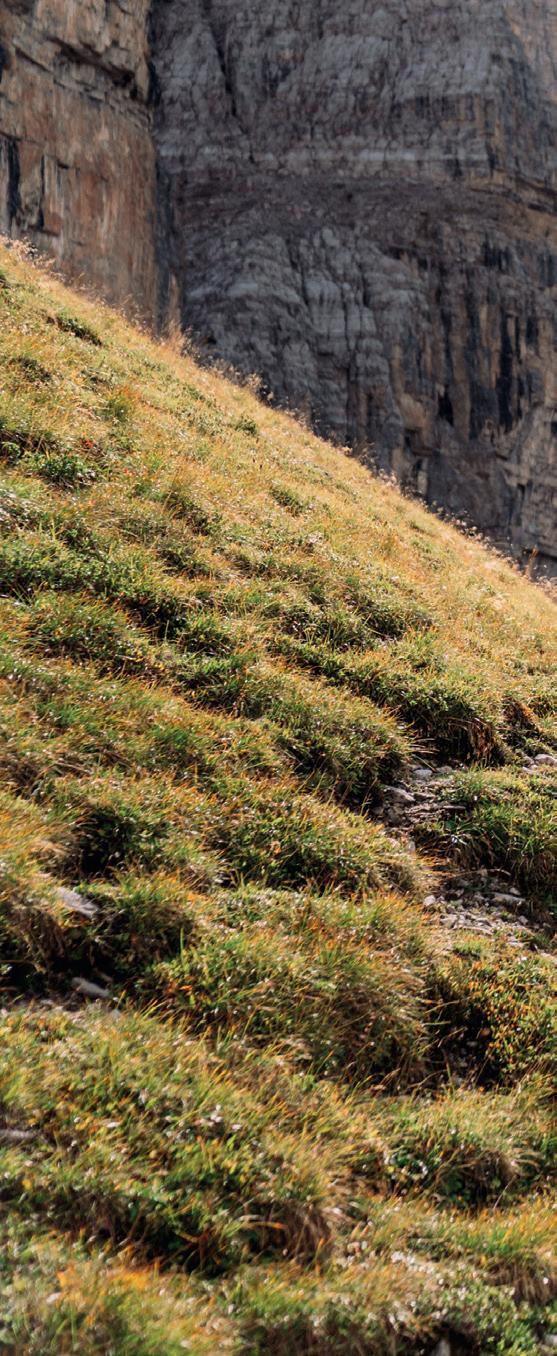
92
Tell us about the 45k route. There are three sections: after a first section of about 6k fast on the forest, you go up to the Gaiarda Pass. It is the lon gest climb, but it is quite regular, and once at the summit 1500m of elevation gain are gone. From here to Bocca di Brenta you always run above 2000m, in a wonderful setting with ups and downs and passages on slightly trea cherous stony ground. From Bocca we launch ourselves into a long descent that begins, first quite technical and bumpy, on single track that then beco mes more and more runable. Finally, from Croz dell’Altissimo a forest trail
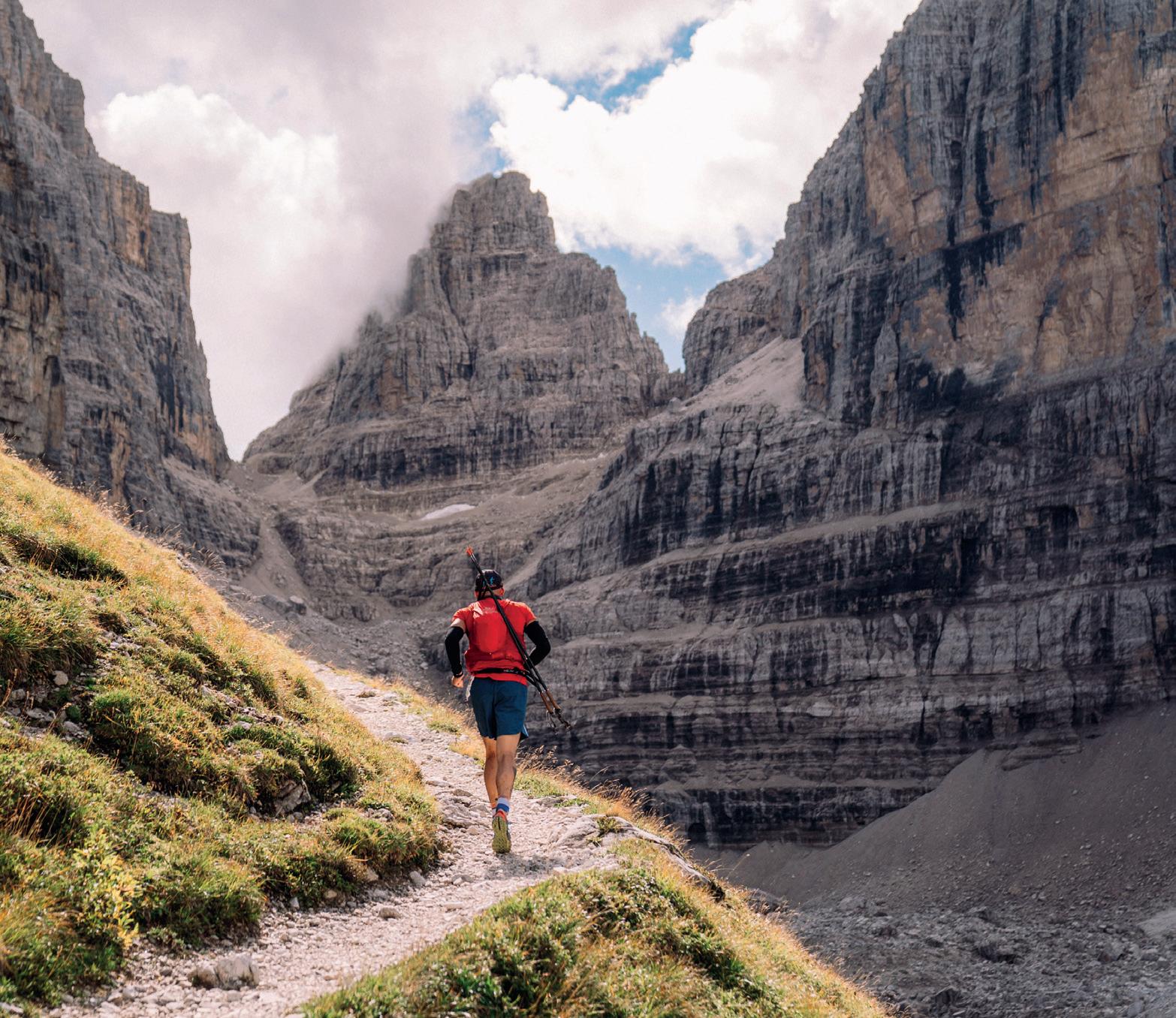
begins to run with some muscle revi talization, and then there are the last 4k of descent to Lake Molveno.
Ale, have you seen the race in very different conditions, which ones do you prefer? The first year we practically always had a sunny we ather. The second was very special, it had snowed the night before (the first snowfall of the season) and the day was always quite bad. This year the weather was a sum of everything: beautiful up to Graffer, cloudy up to Tuckett, rain up to Brentei, rain mixed with snow uphill towards Pedrot
ti and again sun downhill towards Molveno. A complete cycle. Absur dly, I usually like to complain about anything but this type of weather is absolutely part of the race and I would almost feel bad doing it all the way under the sun.
You had a somewhat strange sea son, you were enrolled in the Swiss Alps, then you fell back on North Downs Way. Why then did you go back to Brenta? My annual plans crumbled in May when I got a groin pain that I’m still carrying on, and I realized it was impossible to prepare
93
Swiss Alps. Having managed to make a good base in the first months of the year, with Davide Grazielli, my coa ch, I went in search of something that was at the same time a challenge but adapted to my condition. For Brenta I simply used the same training as in 2019: I hardly ran after the 100 miles and I went on by inertia. In reality, for the first time I was not here to com pete seriously but to have a quiet race together with a friend, so everything went in the right direction.
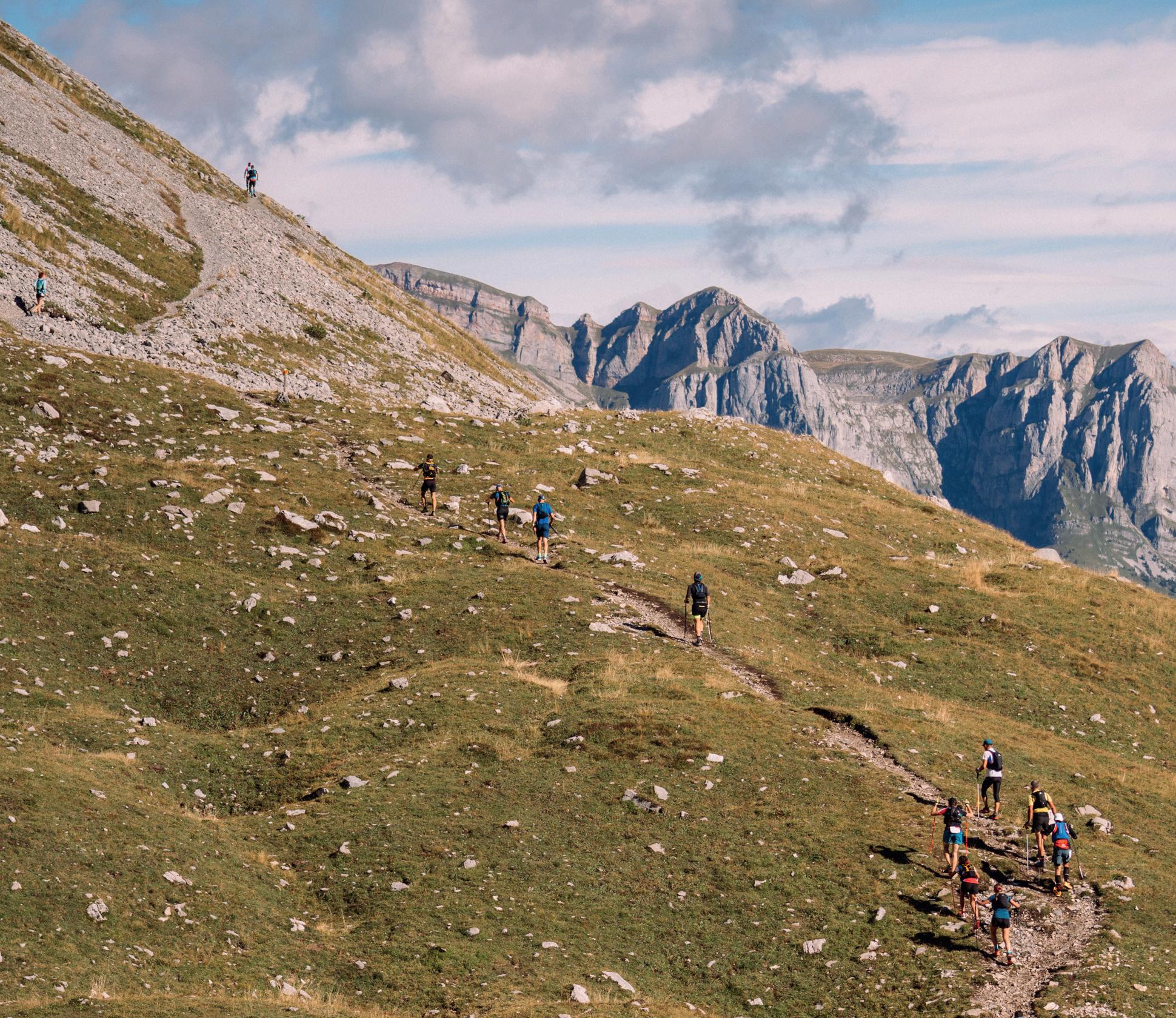
What is the positioning of Brenta in the racing scene? Unfortunately, the calendar is not on their side (I'm
talking about the elites) because DBT takes place between UTMB & sisters and TOR, two very different races from this one but which for many athletes are a fixed appointment. I was pleased to see so many forei gners this year too, and this makes me happy because I consider the race to be one of the most beautiful in Italy, and because I like them to have a taste of the Dolomites right here. What changes have you seen in the organization over the years? I think it's one of the least noticeable thin gs about the race, which as far as I'm concerned is the biggest compliment
I could pay it. DBT is a machine that requires a lot of work, but it works so well (for the athletes who run it) that it almost seems to run smoothly. It is well signposted, well communicated, the aid stations are always fantastic.
Manu, the day before the race we joked about the fact that I could not follow the classic strategy of the tigers of Varese, that is going ALL IN. Usually I try to prepare my self for the races methodically, but in the last two months I have run little and badly and before the start I knew that I would have to do a very con servative race, as well as having the
94
(stupid) fear of not making it. Going ALL IN implies the risk of being able to fail, but always starting from the awareness of being in good shape. This time there weren’t the right con ditions and it troubled me a bit not to be able to "compete", and I was not at ease having to go slowly and stay away from the chaos.
What's the coolest thing you've seen in the race? From Passo della Gaiarda onwards the landscapes are incredible with open views across the valley. Then the very hard and short climb to Bocca di Brenta is of rare be auty and a little intimidating.
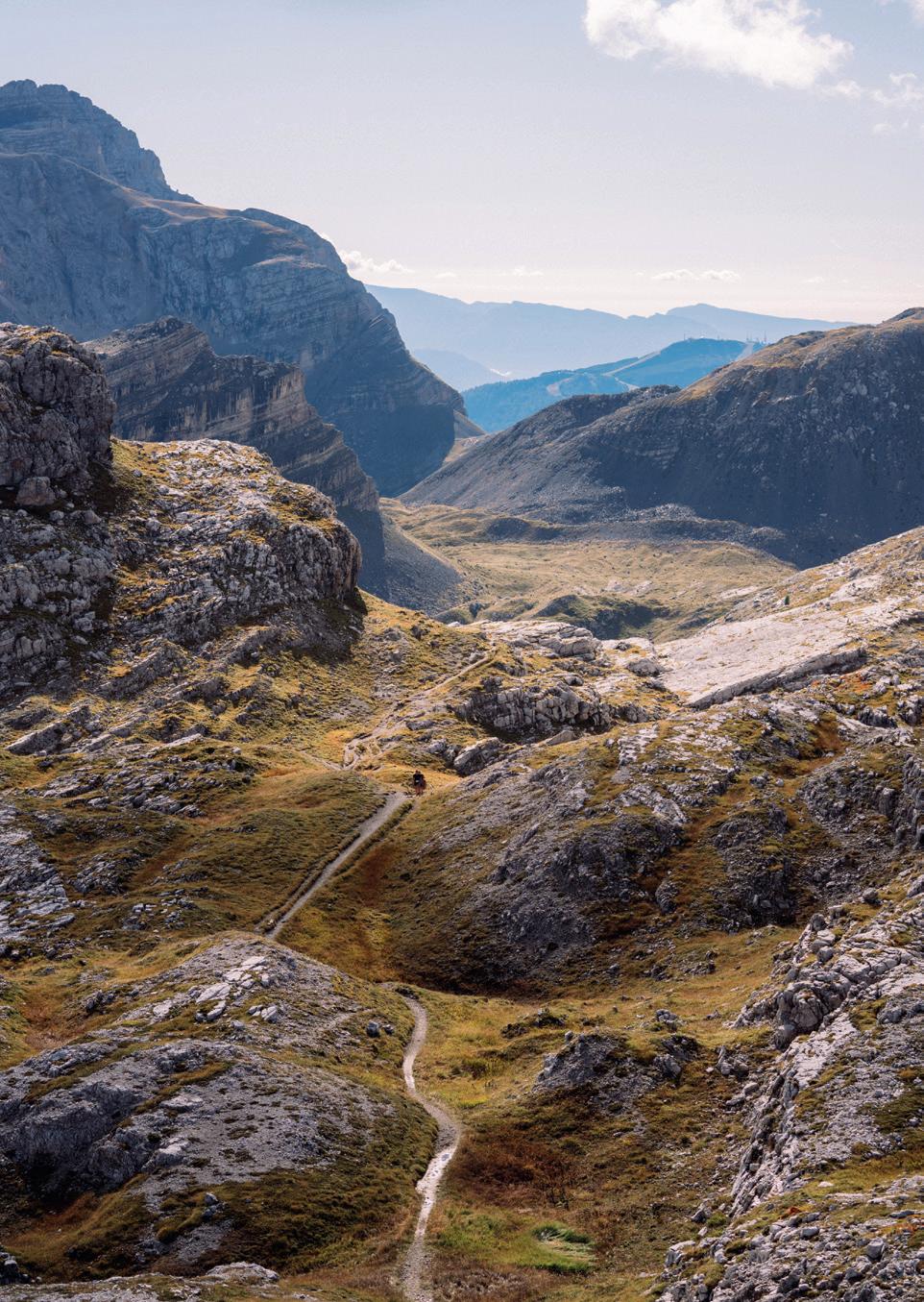
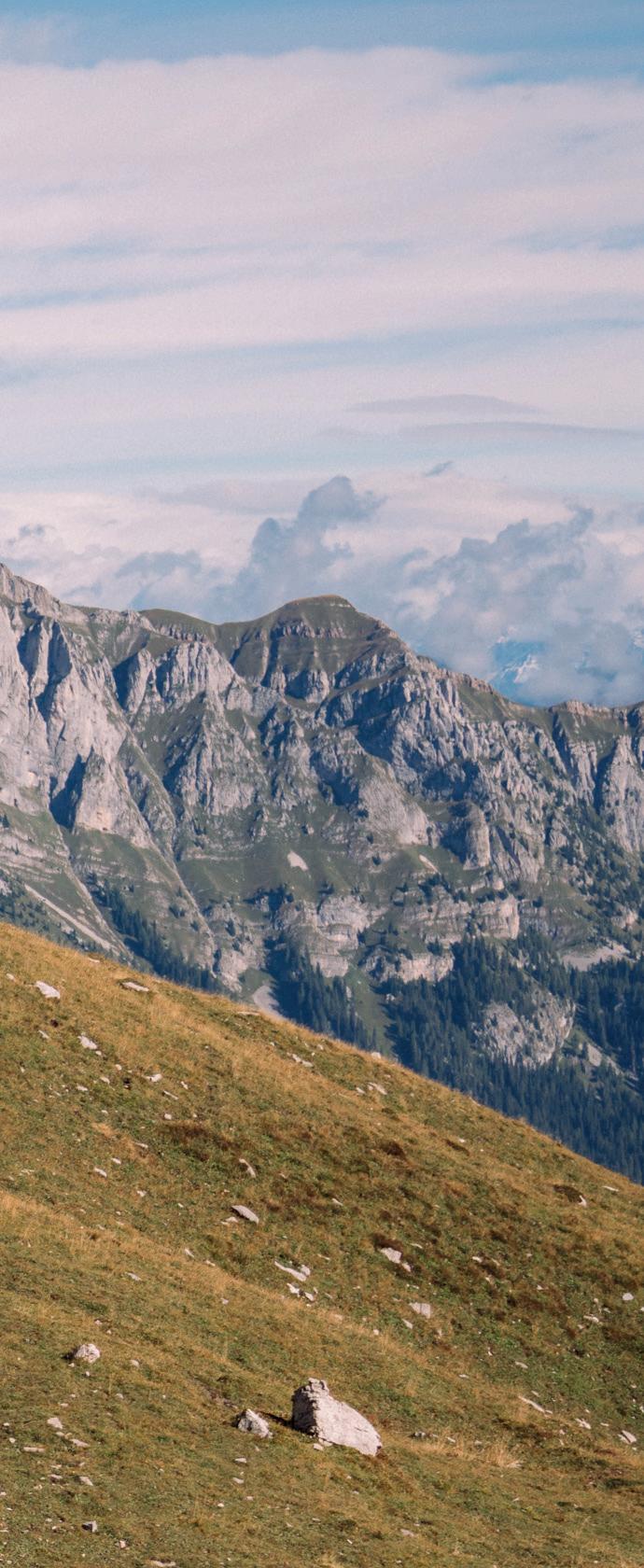
The worst moment? Before Passo della Gaiarda! I was intoxicated with bad thoughts about retirement, excu ses and unnecessary paranoia. Then, once I got to the top, I lay down on the grass and managed to chase away those thoughts, even insulting myself. I left with determination and with the desire to discover these mountains.
And what's the thing that bothe red you the most? Discovering, after the race, that there were people racing who had problems with doping in the past, that was not nice.
I was intoxicated with bad thoughts about retirement, excuses and unnecessary paranoia. Then, once I got to the top, I lay down on the grass and managed to chase away those thoughts, even insulting myself.
95
A marriage with Tor
BY TATIANA BERTERA
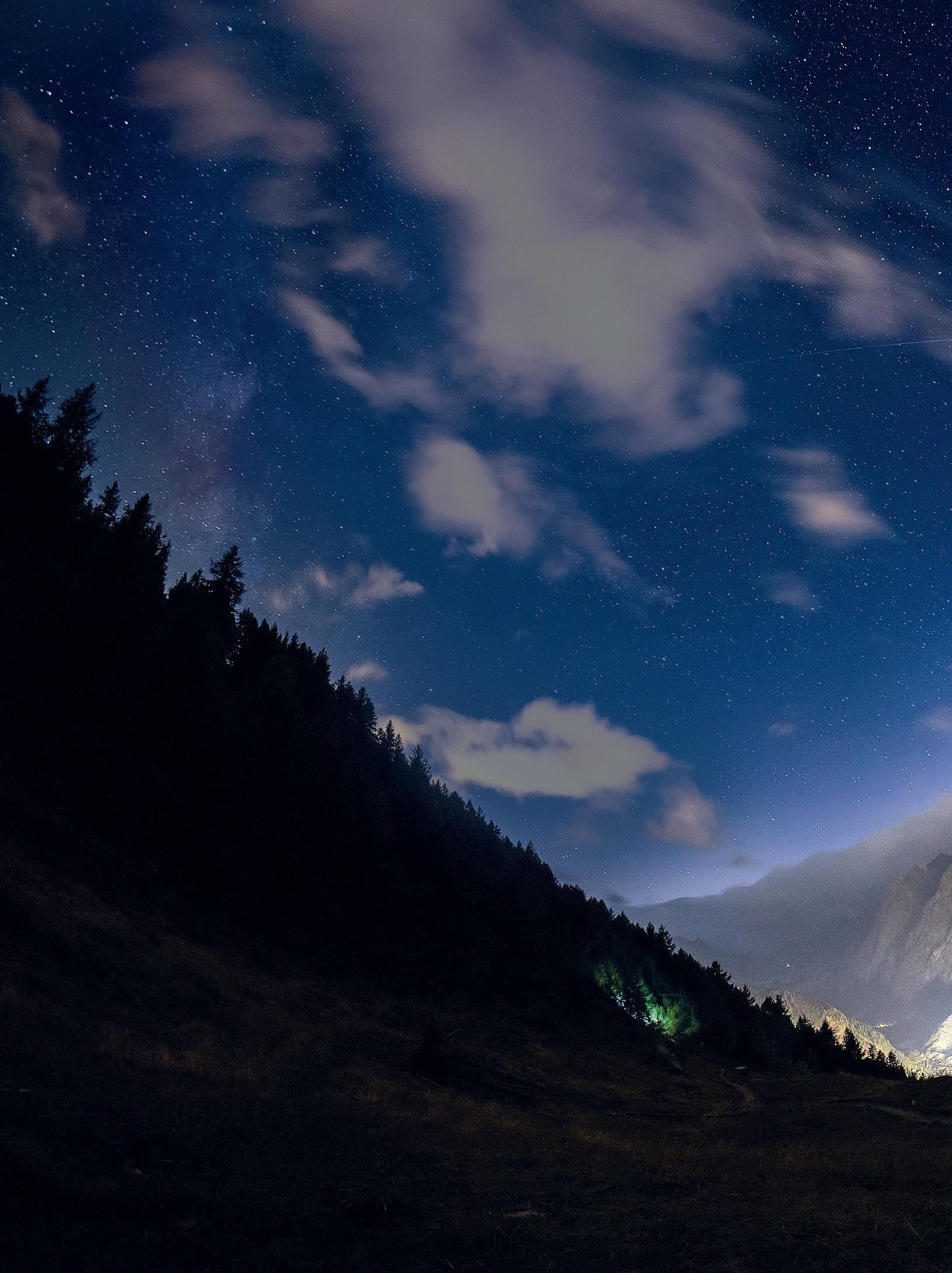

"Was it how you expected?"
If someone were to ask me now, less than a week after that desired goal, sought and reached with tears in my eyes, I would reply that “No, Tor des Géants did not live up to my expectations." Right now, with the crises of sleep that surprise me in the most disparate moments of the day, memories intersect like the threads of a spider's web, leaving room for lights and shadows. Yester day I had a ten-minute microsleep in the supermarket parking lot be cause I considered inappropriate to drive with eyelids that weighed like lead. A feeling that I remember well this, I mean sleep, so intense as to block the step.
But let's start from the beginning, actually from before that, from that day when I told my boyfriend that I would never run a Tor. And by never I really meant never, for no reason in the world. Tor was his big dream, not mine, and just ima gining walking for five or six days non-stop made me feel dizzy. Like when you are close to the precipice and the eye escapes down below. The idea did not put me at ease, that's all. If for everyone Tor was something mythical, huge, the best among travels, for me it was "a hike
that was a bit too long and with too little time available”. Time, that va riable that few calculate but that can make the difference. In fact, over time that "boy" became my husband, and the firm belief that Tor was not “all well and good" came less. Mind you, not that suddenly I had started to cultivate in my heart the desire to cross something like 350 kilometers on foot in the mountains of the Ao sta Valley, but my perspective had changed. At the end of 2021, having to give up my honeymoon due to the pandemic, I had developed the conviction that it would be wonder ful to share an experience capable of staying forever in the minds and hearts of both of us. Something special, which we would have been able to make unique through our experience. That would test us both physically and mentally. That would show us that together we are stron ger. His admiration for the Giants and the type of race led me to think of Tor des Géats as our honeymoon. Something alternative and outside the box, if you like, but it was imme diately welcomed with enthusiasm by the organization. And so, around November 2021, a training course began that led both of us to accumu late kilometers and elevation gain in view of the big goal.
1460 kilometers and 77.000 meters D+, to be precise. These are the numbers of a preparation that lasted more than a year and that absorbed us 100%. Because to have even the hope of arriving at the finish line of Tor, a few mountain walks and we ekly road sessions are not enough. We have dedicated every Saturday and Sunday to running, sacrificing both our other passions and, some times, our social life. In the evening we were so tired that as soon as we touched the bed we fell straight into Morpheus' arms. A good na tural contraceptive... And all this for what? To pursue that dream, his

98
“I thought I would never run Tor des Géants. In the end, this extreme competition between the Giants of the Aosta Valley became my unusual honeymoon.”
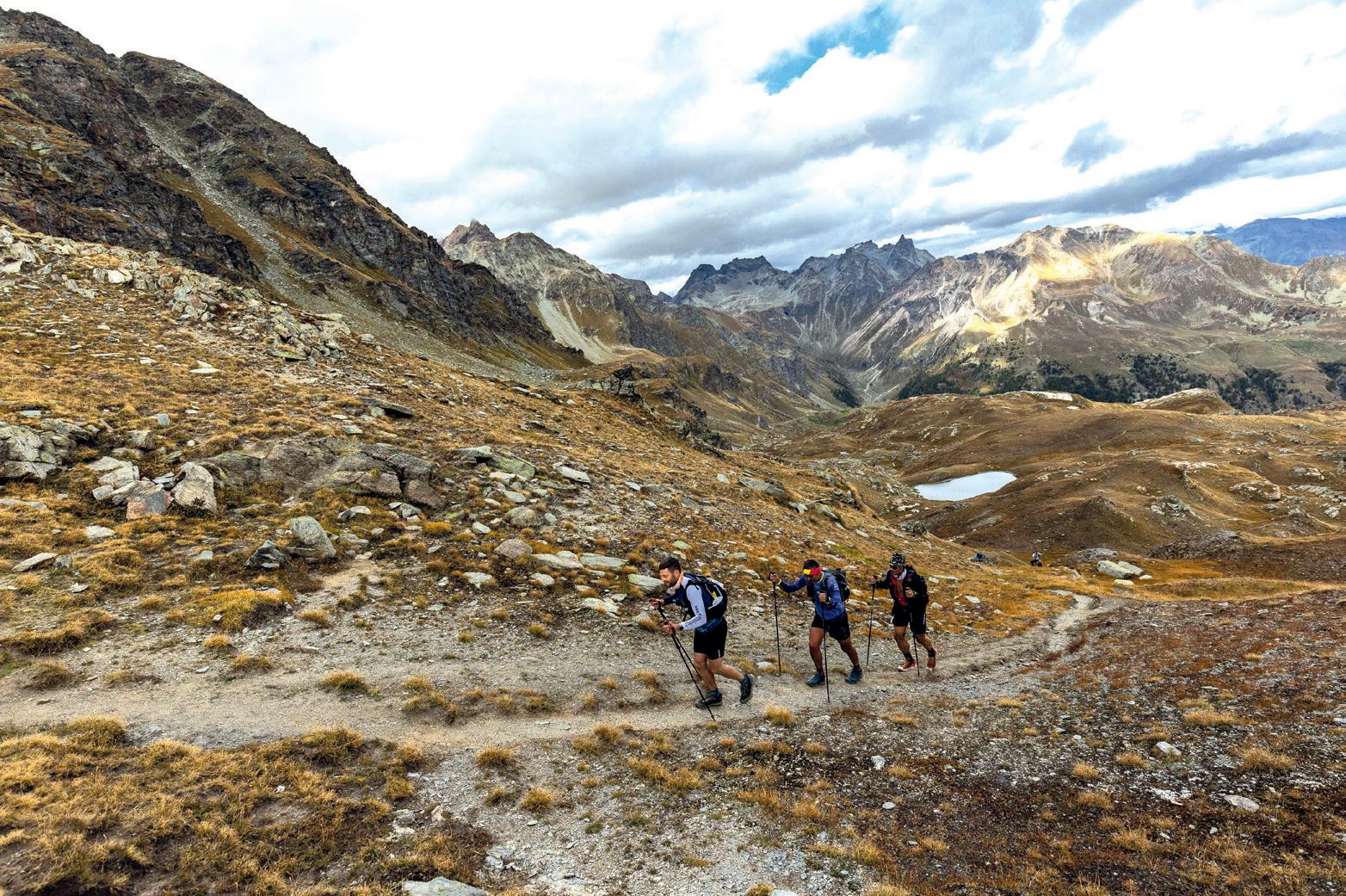
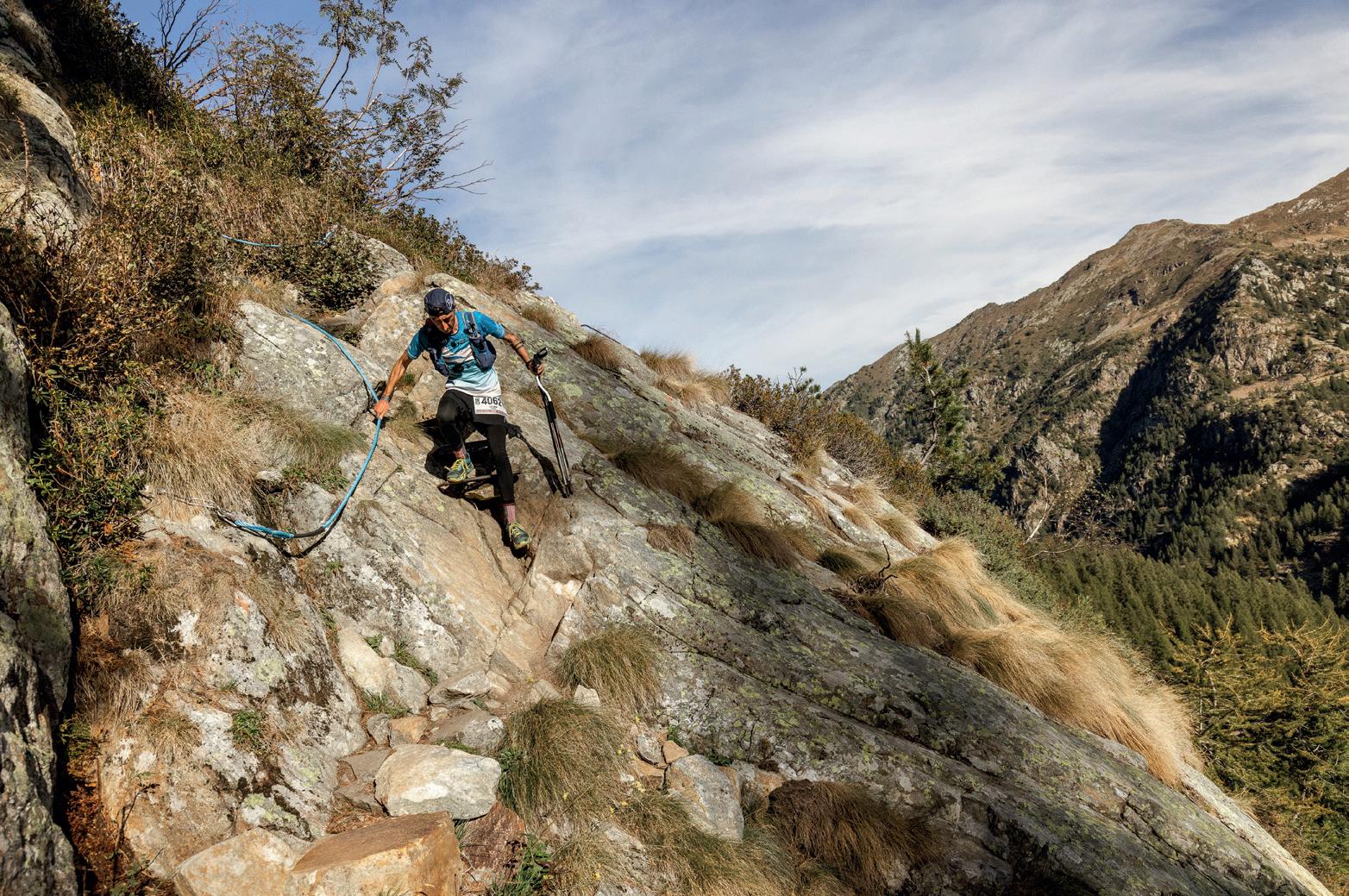
dream but which had now become mine too. Our story, so romantic and fictional, has emotionally in volved a lot of people who, through social media, have experienced the entire athletic preparation phase and, then, also the journey.
The magic of social media, which makes everything so close and wi thin reach. Which allow us to enter the lives of others, to almost live them. On the morning of September 11th 2022, one hour after the depar ture and fully dressed, I wanted to share my emotions in a story. I did not hide the tears for having finally arrived and after so much effort, at the moment of truth. Someone told me that our feelings must be lived rather than shared... Well, I believe that sharing does not take anything away from the experience. I didn't know how I would face such an experience, when my legs or my head would lead me, I didn't imagi ne how I would react. We also gave a name to our project: Tor in Tandem. Although I do not have a strong love for cycling nor a real connection with the two wheels, this figurati ve image seemed fitting to me. The agreements were clear: first of all, face the journey together. And cross the finish line together. The renun
ciation of one would have involved the voluntary withdrawal of the other, without ifs and buts. Because that’s only fair, because we promi sed ourselves that day, on that altar.
"In good times and bad times", put ting aside selfishness and personal ambitions and giving up something great. And giving up, those who frequent the mountains are aware of it, requires courage. I knew very well that for just one person to reach the finish line involves a mix of trai ning, head, heart (a lot!) and luck, for the thing to be replicated for two people a half miracle was necessary.
But if you don't believe in miracles, then you can also avoid races such as Tor, because in those three, four, five or six days, the human body re ally does something extraordinary. It struggles, evolves, transforms, learns to ignore pain and treasures that hour of sleep every 24 hours, it refines physiological functions, le arns to digest any food and it does that at the speed of light. It transfor ms everything into energy, which it gives slowly and in a rationed way, naturally led to self-preservation. And if in the first two days of com petition, also thanks to good trai ning, everything "seems" easy, just before the Cogne aid station (day 2
ROCCO DUCCIN & TATIANA BERTERA AUTHOR OF THIS ARTILCE AND TOR FINISHER
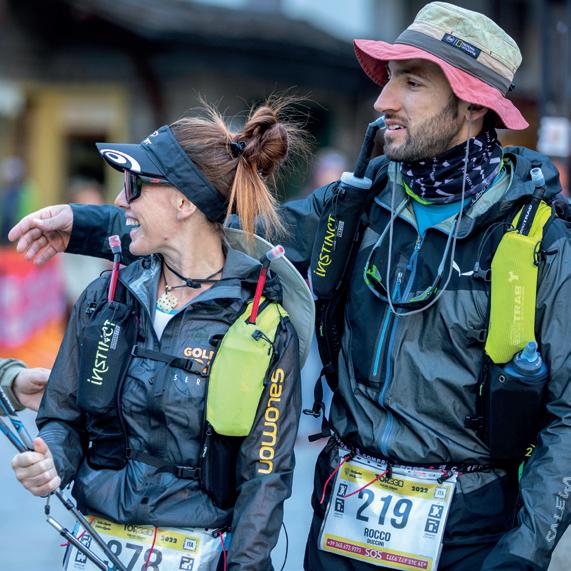
and a hundred kilometers from the start) comes Col Loson, which sud denly and with violence brings you back down to earth. It puts you in front of all the fragility and weak ness that characterize us as human beings, a handful of skin and bones that, once the energy reserves are exhausted, can no longer go further. Loson, the first big obstacle that le ads you to think that after all and in certain situations, soft drugs could also be legalized. Such a description brings to mind images of sharp pe aks and very steep routes. But no, Loson is flat, with a disconcerting flatness, at times unnerving: 5 hours of endless ascent zig-zagging from one side of the same mountain to the other. When we reached Loson we had already exhausted the imagina tion and the desire to play "names of things-animals-cities" that kept us busy on the first day. What a pity.
From the second night we begin to see the first “little corpses", a term with which we defined the people who at the side of the route and with their headlamps on (lucky us becau se we could see what was under our feet) allowed themselves a micro -sleep. I confess, on one occasion we too tried to "play corpses", only to be surprised by the rain. Always from
100
I didn't know how I would face such an experience, when my legs or my head would lead me, I didn't imagine how I would react.


the same night, or at worst from the third day, the various pains begin to list each other and it would be easier to say what does not hurt than what does and that makes the journey a little more difficult. But after all, we already knew that it was not a stroll in the park.
You discover that you have muscles that you didn't even know existed and that pain is divided into two large macro-categories: tolerable and intolerable. As long as the list of the former numerically exceeds the latter, all is well, otherwise the "MassaggiaTor" (the name we call Tor masseurs) intervenes. I prefer to call them the "Angels of the Tor" and they are all those volunteers who during the week of the event give antifatigue massages, apply patches and functional bandages, treat blisters as big as houses and tell you that "they will take care of getting back on your feet so you can continue your journey”. “We are waiting for you at the next raid station! Just don’t give up, we'll take care of the rest when you arri ve.” Thanks MassaggiaTor!
Donnas represents half of the jour ney and, it is said that, if you arrive in Gressoney and leave again, then
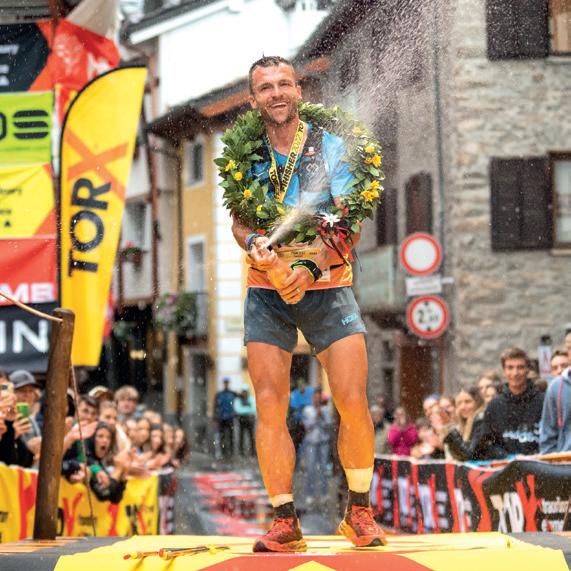
you can consider yourself arrived. I believe that Donnas, with its routes that step by step lead to the Coda re fuge, is an unfairly mistreated stage. Donnas is spoken of so badly, but deep down, if Orobic blood flows in your veins, you know that nothing can be worse than the nervous and shabby routes of the mountains of Bergamo. Thanks Bergamo!
The party that awaits athletes at refreshment points such as the per ched village of Perloz, the sunrises at high altitude, the wind that lashes your face and lowers the tempera ture forcing you to run even when you don't want to, the greatness of nature and the smallness of us Gian ts. And then the encounters, of tho se who walk and suffer like you, of those who believe in them as much as you do and share your emotions. Thanks Tor!
They told me "you will miss all of this once you get home". I did not believe it, I absolutely did not belie ve it that I would miss all this effort. You usually miss things that are be autiful, you miss eating cakes and making aperitifs, going out with friends and enjoying life, I said to myself, but you cannot miss this pain and effort. But they were right. What is missing is reaching the top of Col Fenetre or Pinter and looking down, thinking that there is still a long way to go, but being happy in that moment. The fateful "here and now" without thinking about what it was or what it will be. Sufficient in that precise moment and nothing more. I think maybe unhappy pe ople would need a Tor des Géants in their life. Just to learn to be hap py with every single little success achieved. Because Tor is just that: a series of small successes to be achieved one after the other. Until the end. No, Tor did not live up to my expectations, it even exceeded them by far.
102
They told me "you will miss all of this once you get home". I did not believe it, I absolutely did not believe it that I would miss all this effort. But they were right.
JONAS RUSSI WINNER OF THE TOR 330
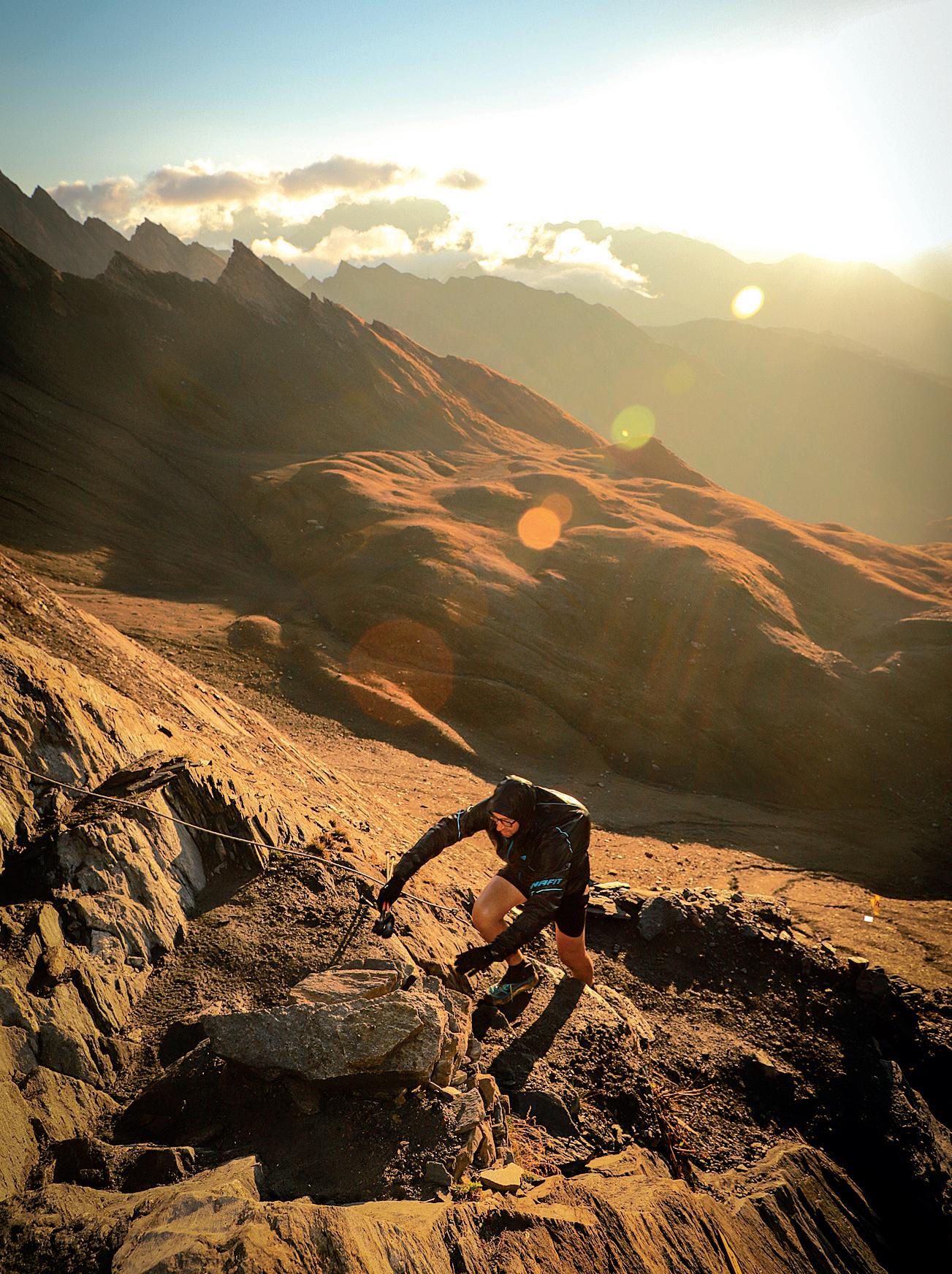
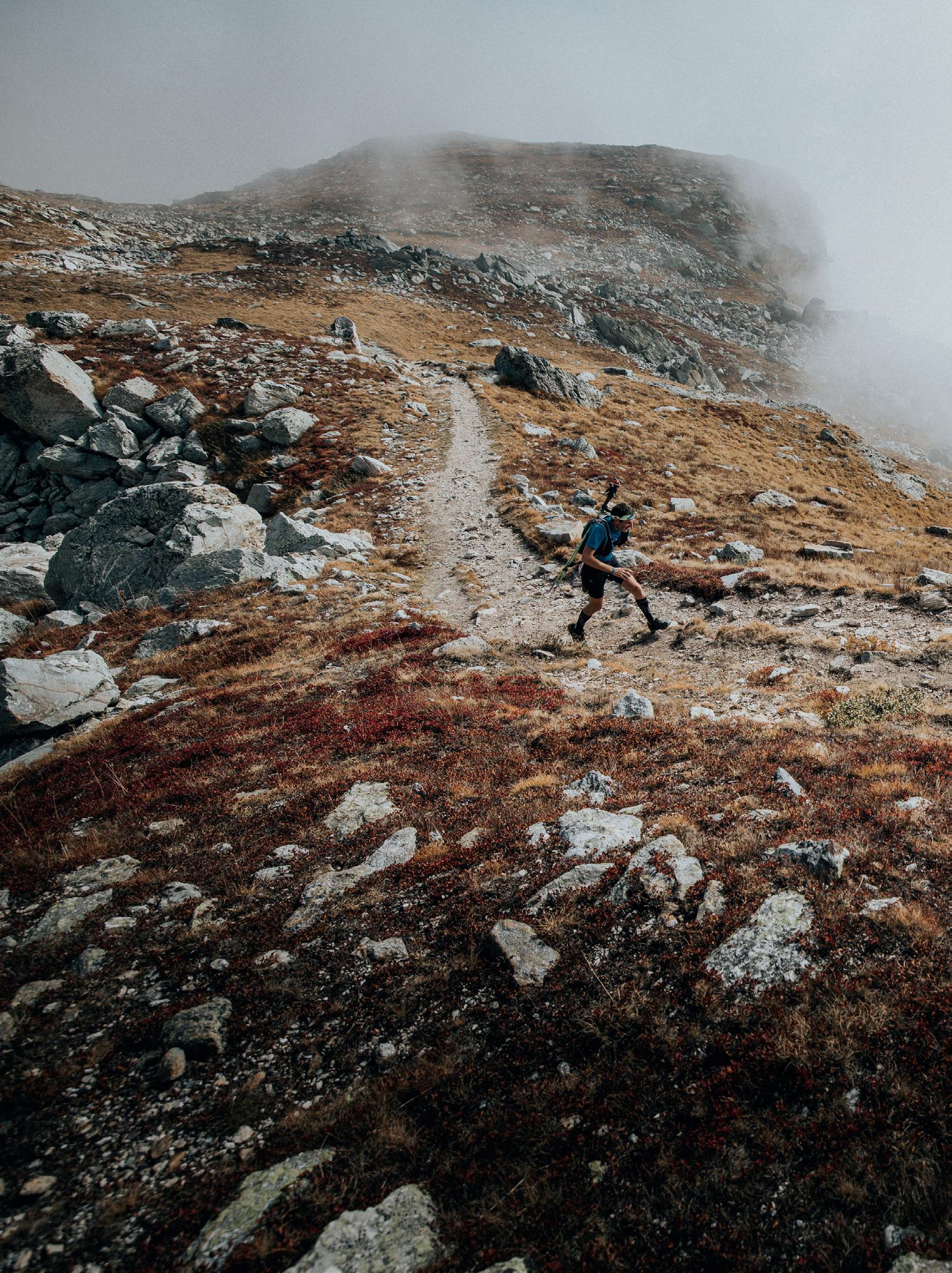
Maira Occitan Trail
 BY LUCA DALMASSO PHOTOS DANIELE BOFFELLI & DANIELE MOLINERIS
BY LUCA DALMASSO PHOTOS DANIELE BOFFELLI & DANIELE MOLINERIS
Occitania

Geographically, Occitania does not exist, it has no precise political bor ders as we understand them today, yet its history is practically mille nary. It is above all a linguistic-cul tural area where it is language that unites: it does not matter that it currently includes French, Spanish and Italian territories. In the past it was above all culture that identified these populations: literary compo
sitions, music, dances, poems that united an immense territory and that were literally brought throu ghout Europe by the "troubadours".
In recent years, many efforts have been made to try not to disperse this language and these traditions and today fortunately there are many associations, courses, events, festi vals that make Occitania more alive than ever.

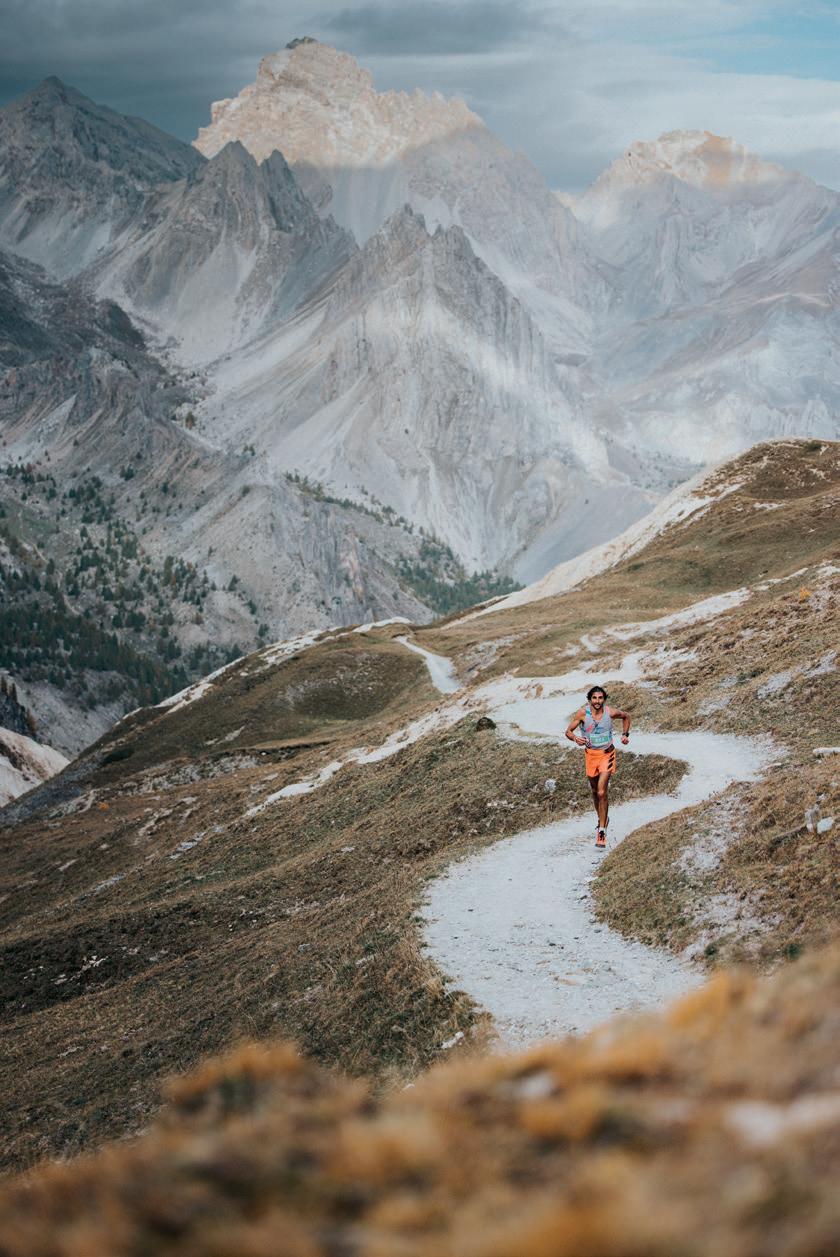
106
Valle Maira is part of the Occitan territory and, at least as regards tou rism from northern Europe and in particular the German one, it is cer tainly the best known valley among the ones of Cuneo. In the 1990s, following the virtuous examples of the transalpine cousins, a path was created that symbolically and physi cally unites the entire valley on its two sides, its hamlets, villages and accommodation facilities. 170km of
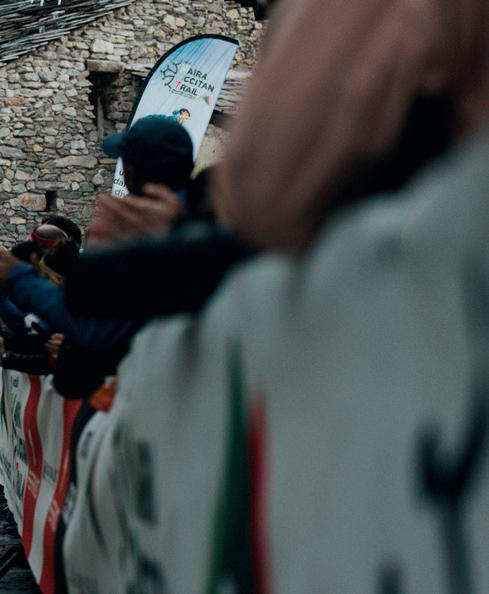
trails to be walked slowly, in 14 days, enjoying the peace and the silence that nature still reserves in this cor ner of Piedmont. Trying to enhance and exploit this itinerary, from the Valle Maira Tourist Consortium with the technical collaboration of the Fossanese Sportification com pany, was born the idea of a moun tain running race that follows these routes in a sporting and touristic way at the same time.
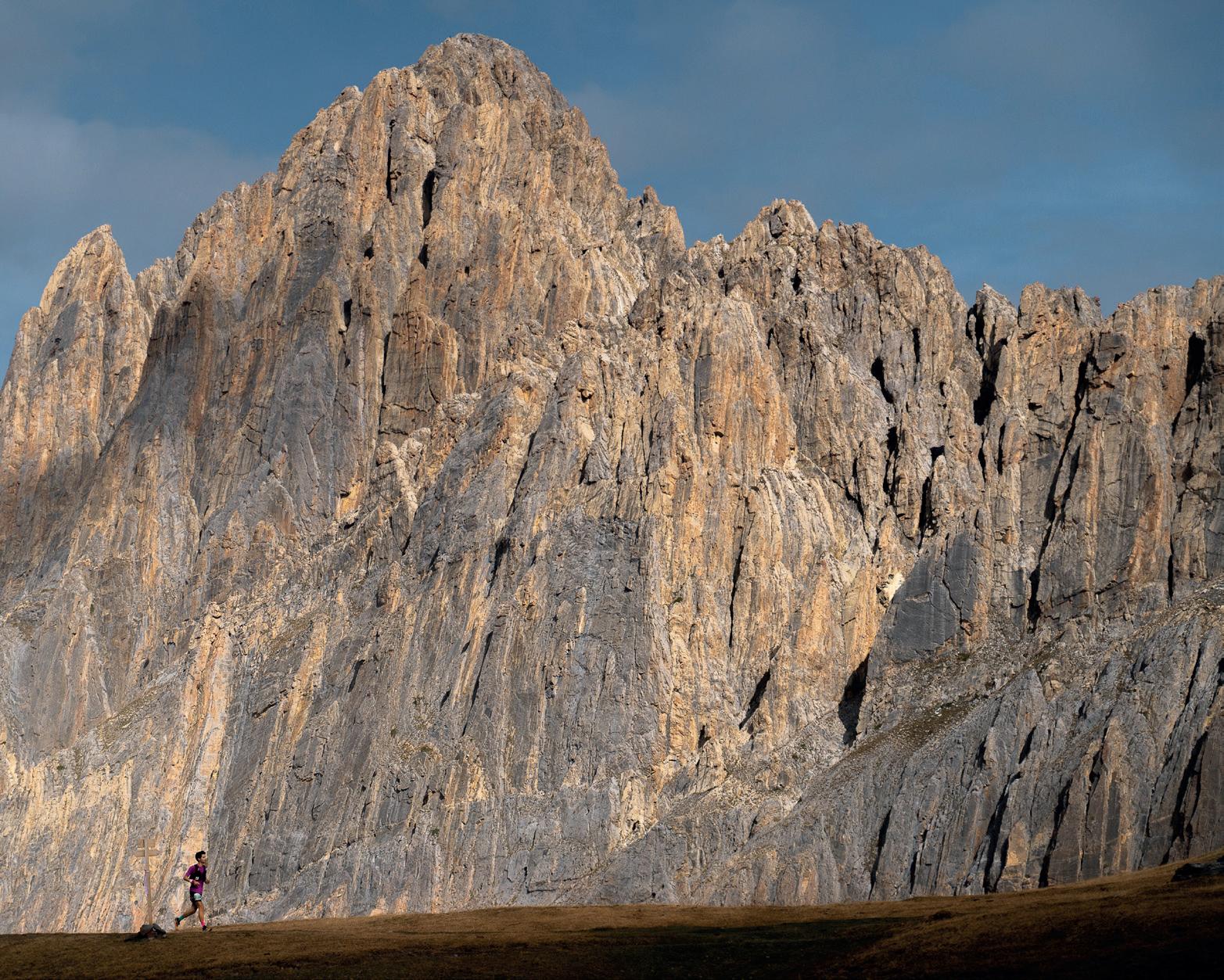
107
Maira
Trail


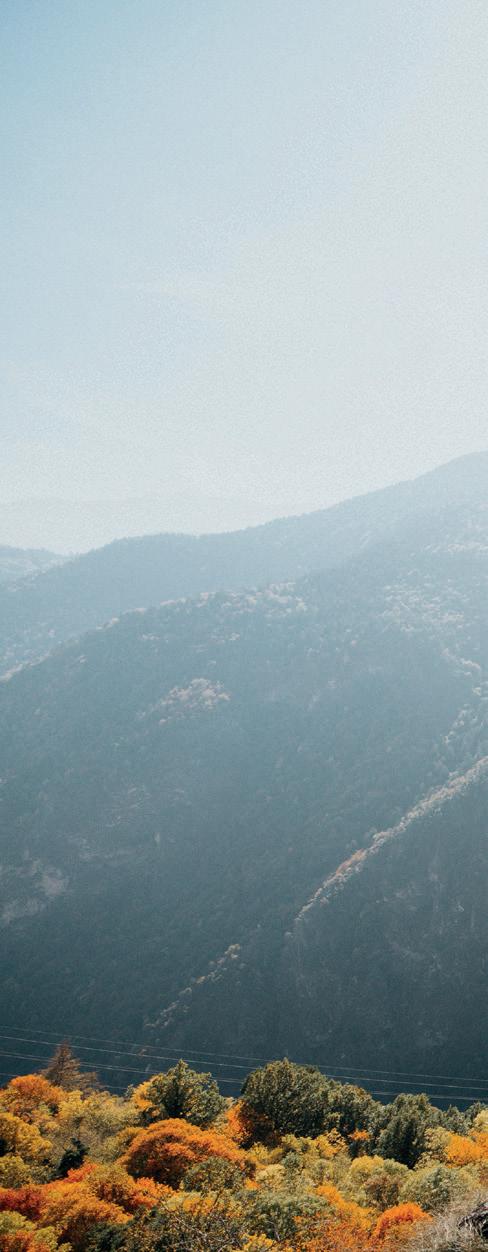
So it was born a race with different ti mes, as the home page of the Maira Occitan Trail website states in large print. An event different from what the national panorama offers today: a ring that runs through the entire valley counterclockwise but with an interesting, innovative, one-of-akind formula. Four stages, four days, 40km every day: in short, 40km in the mountains are not a joke, nor a walk, but at the same time they are
not like an ultra trail race that enga ges day and night. It all starts in the morning, walking along paths, mule tracks, crossing villages, meeting vo tive pillars, but also crossing trails on the ridge, high mountains, and then pine forests, beech woods, chestnut trees. In short, a great concentration of nature, trail, oxygen. But in the afternoon and evening the race takes a back seat.
108
Geographically, Occitania does not exist, it has no precise political borders as we understand them today, yet its history is practically millenary. It is above all a linguisticcultural area where it is language that unites: it does not matter that it currently includes French, Spanish and Italian territories.
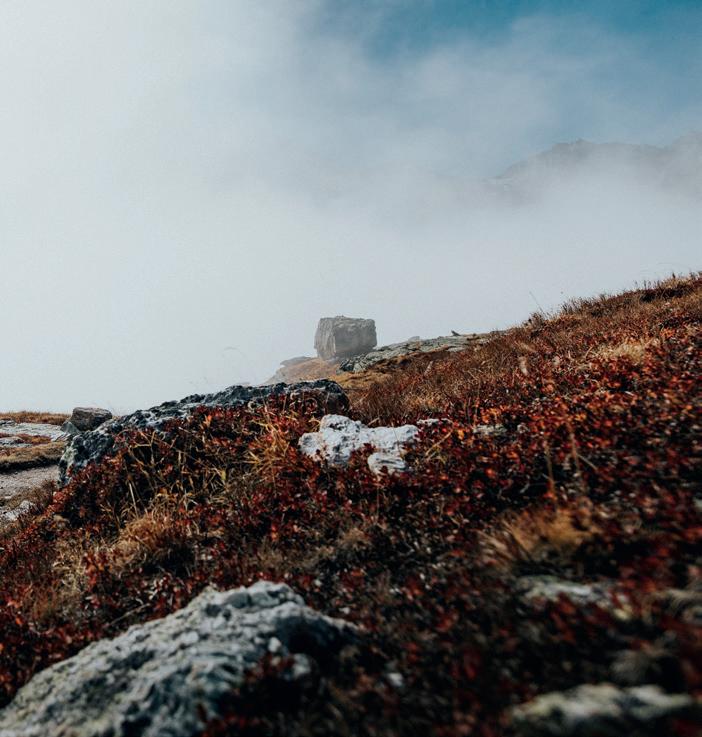

So it was born a race "with different times", as the home page of the Maira Occitan Trail website states in large print. An event different from what the national panorama offers today: a ring that runs through the entire valley counterclockwise but with an interesting, innovative, one-of-a-kind formula.


110
These are the premises
On the field, then, all this turns into a united group, a happiness that I have rarely seen in other trail runners. The re are thirty-one starters and within a few hours they become a family: we start together, we run together, we sha re refreshments. But after noon, once the physical fatigue is over, another hu man adventure begins: we all immerse ourselves in the fountains, eat lunch together, discuss the emotions of the journey, everyone's thoughts become the thoughts of the group. There are those who claim that that mountain pasture cheese at the restaurant was better than the other, those who wait their turn for getting a massage, those who repeats the ritual of unpacking and re-packing the backpack for the next day, those who get excited every morning at the start because this race has moved something inside them; everyone enjoys the "pampering" that the careful organization tries to give at any time of the day. When Daniele pi cks up the microphone, the atmosphe re is charged with electricity: he knows well how to stimulate athletes, whether they are starting or arriving from a sta ge. What used to be a race becomes a journey to be made together, not just by running, but throughout the day.
We can bet that some friendships born there will last for a long time.
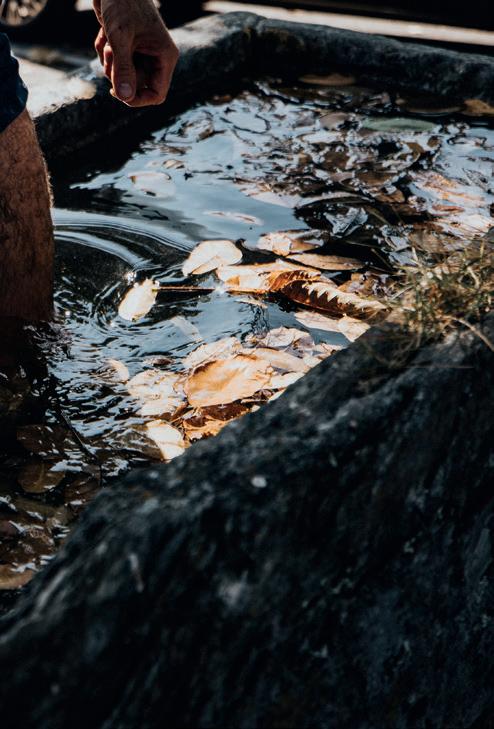
Then there is also a sports report, as it should be. Andrea Matteucci starts strong and wins the first stage, from Villar to Stroppo, a relatively runable part of the route. Dario Pedrotti inste ad starts slowly, the first effort gets him the seventh place but then he wins the second and third parts, from Stroppo to Chiappera and from Chiappera to Marmora: the two stages with more mountains, differences in altitude, te chnical trails. It will be enough to reach the podium but not the second place, defended with his teeth until the end by the "local" Andrea Barra, while Mat teucci flies on the last day to the finish line in Dronero to take the last stage and the general classification. Among women it is a dominion from the be ginning to the end of Enrica Demat teis followed by her twin Luisa: they are cousins of the most famous twins, symbol of mountain running, Martin and Bernard. Antea Pellegrino closes the podium.

Back in the car, with endless postcards that only the landscapes of Val Maira can give, with a single thought, next year I really want to ride this 4x40.
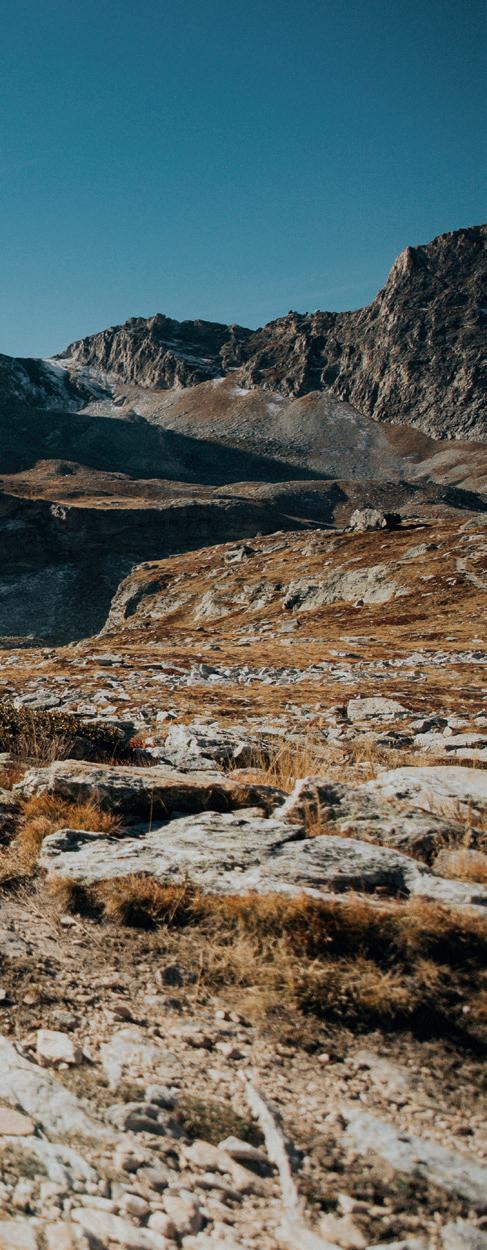
111
The charm of Ortles
BY DAVIDE FIORASO

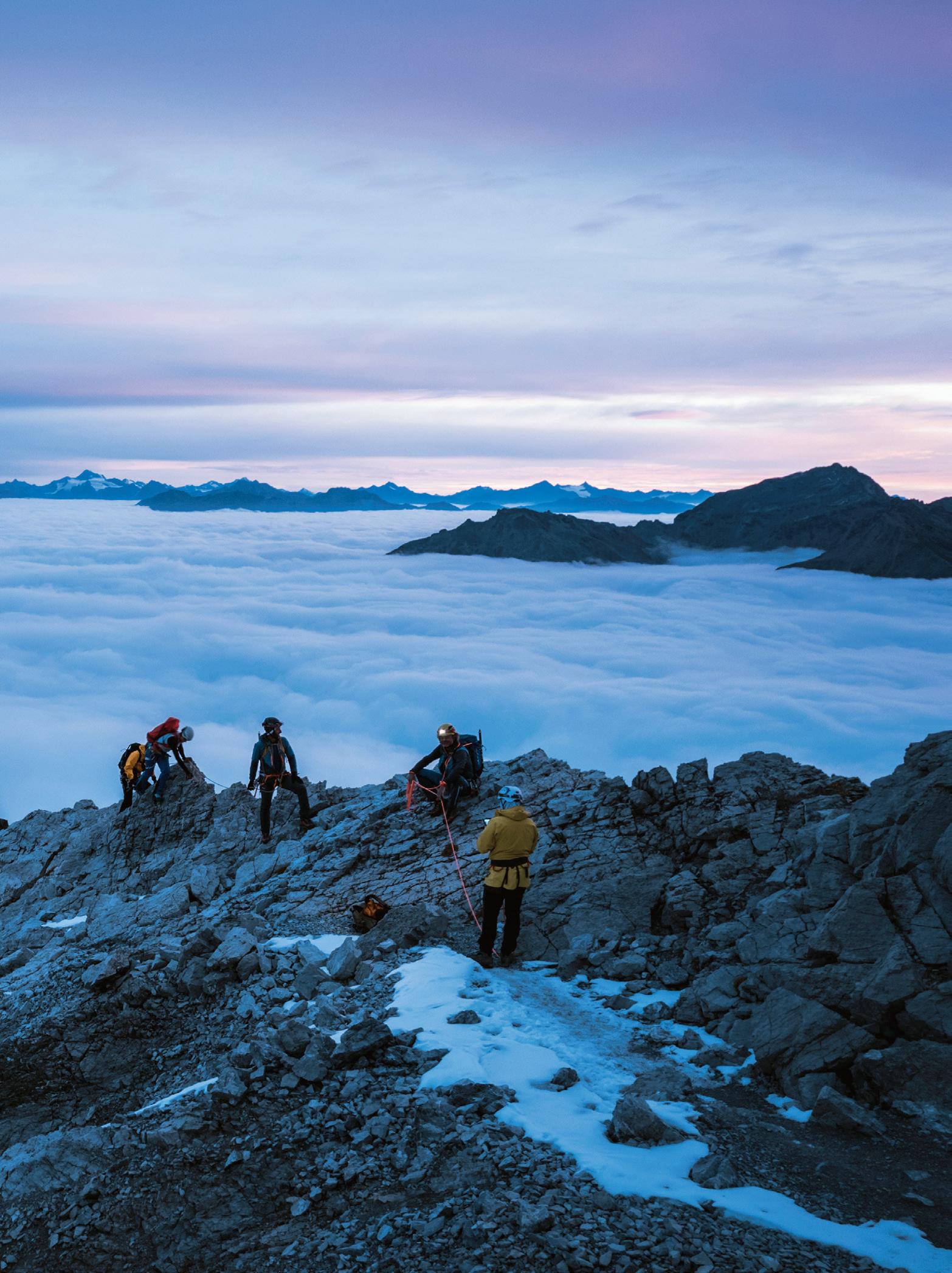
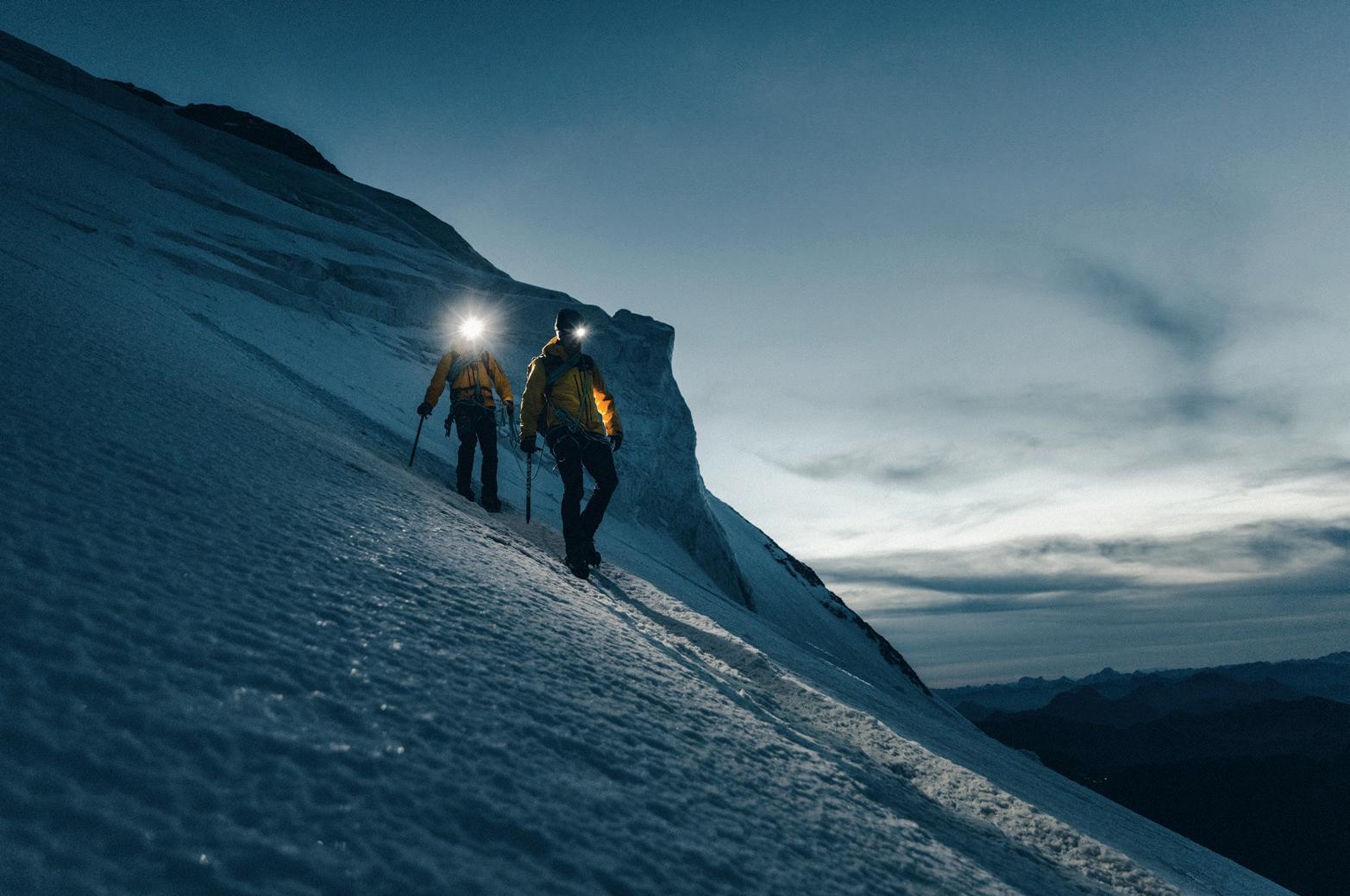

I walk through the streets of Solda under a light rain. From this morning to dawn a thi ck blanket of clouds is overlooking the entire Val Venosta. Before going down, I admired it from up there, looking out the window of the refuge, an ocean of cotton from which only Ba renkopfl and Val Müstair Alps emerged, much further north. I went inside letting myself be enveloped by a milky, almost warm haze, until I met the scent of larch trees that permeated the humid air, as if to remind me of the arrival of fall. The fog has muffled that frame of austere beauty that I had greeted on Friday afternoon. Now I can eliminate all shapes and imagine what I want. I can stop looking for a moment, I can breathe, I can close my eyes and focus on my feelings. Lines remain isolated, colors no longer speak, Ortles has retired. Yet, not even 24 hours ago, I was on its top, two thousand meters higher, and I feel its presence.
Last night, at 7.30pm, together with Ti tus Prinoth, I reached the highest peak of Trentino-Alto Adige, as well as of all the Alps east of Bernina. A direct line, without stopping, that from the church of San Gel trude took us to the 3905m of “King Ortles" along the north ridge, just in time to greet the sun setting over the Western Rhaetian Mountains. Just in time to sigh at the sight of Gran Zebrù and imprint in mind that world of ice that in a few decades will ne ver be the same.
Year after year, Ortles fascinates countless climbers. Although from Solda it appears resi zed, under a deceptive perspective distortion, what strikes is that summit cap, overflowing in impressive seracs that stand out against the blue of the sky. A painting sketched with ma stery by a nature whose strength and beauty
leave a profound mark on anyone who sets out to conquer it. Those who decide to climb Ortles are aware that they are going to face a fascinating and varied, yet severe, terrain.
I left for this experience with the desire to let myself be surprised, documenting only what is strictly necessary. But now I want to know more and to do so I pass through the doors of the Messner Mountain Museum, at the foot of Vedretta Alta, the one that the famous "Atlas Tyrolensis", designed in 1774 by Peter Anich, indicated as the "end of the world”. This mo dern underground structure, dedicated to the theme of ice, exhibits the largest collection of paintings with views of the Ortles. In Septem ber 1804, a good fifty years before the British overlooked the Alps, Joseph Pichler reached the summit by climbing the west face along the socalled Hintere Wandln. All this hap pened when mountaineering had less than 20 years of history and its spread, due to the Napoleonic wars, was very slow. There is no iconographic evidence of him, not a drawing or even an engraving. It was only known that he was a chamois hunter, skilled like no other. Small, strong, silent, determined. We also know that on the rocky slopes where others, in those distant years, barely climbed, he moved agile, safe and fast. For over half a century he maintained the exclusivity of the ascents on the highest mountain in Tyrol: from 1804 to 1854 (the year of his death), no group was able to climb to the top of Ortles without him.
But today I'm here because Ortles talks about something else. It speaks of South Tyrolean pri de, of roots, of mountain culture. It talks about a collection to which Salewa gave its name, and which is based on the concept of Quanto Ba
115
I walk through the streets of Solda under a light rain. From this morning to dawn a thick blanket of clouds is overlooking the entire Val Venosta. Before going down, I admired it from up there, looking out the window of the refuge, an ocean of cotton from which only Barenkopfl and Val Müstair Alps emerged, much further north.
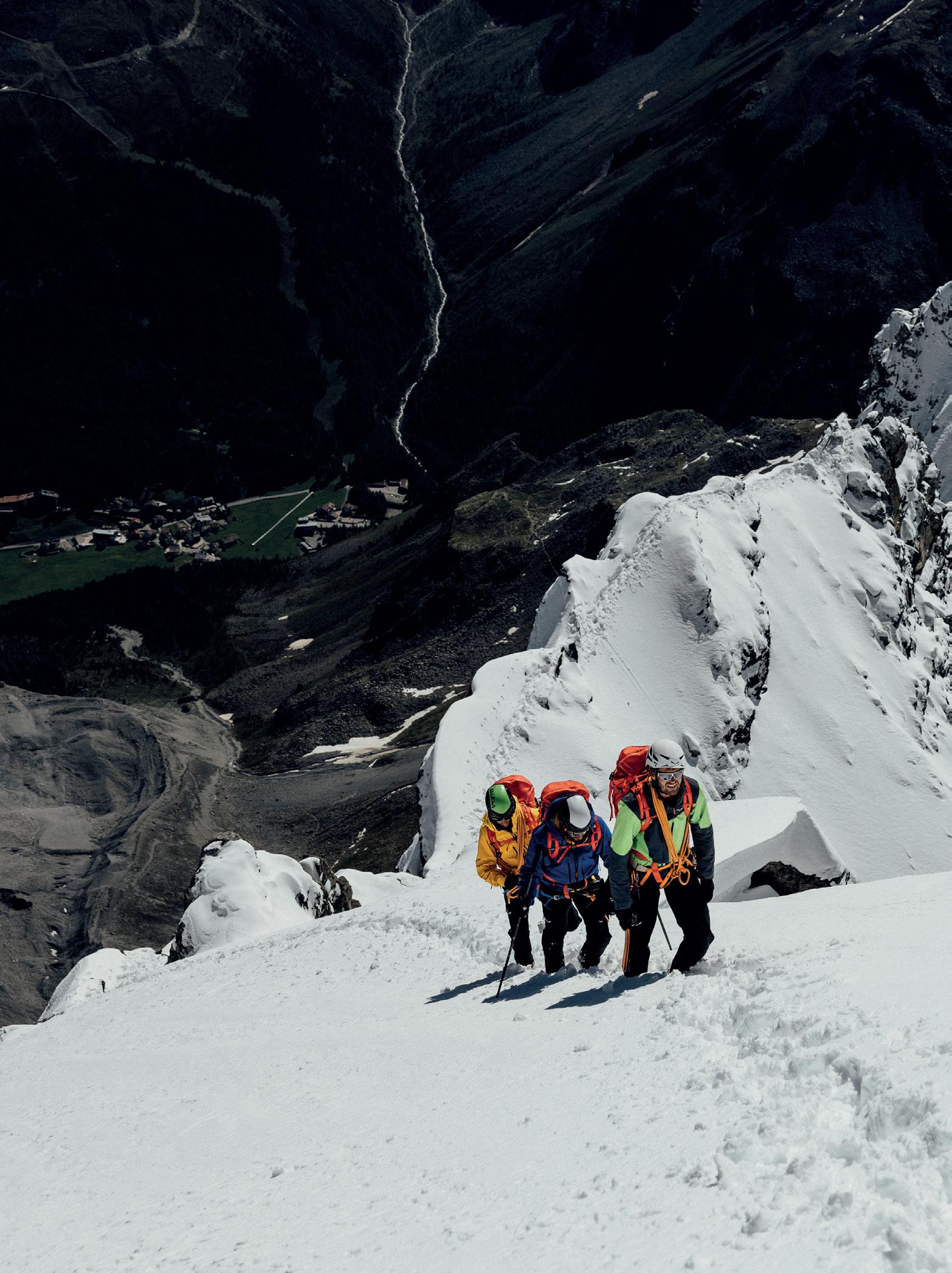

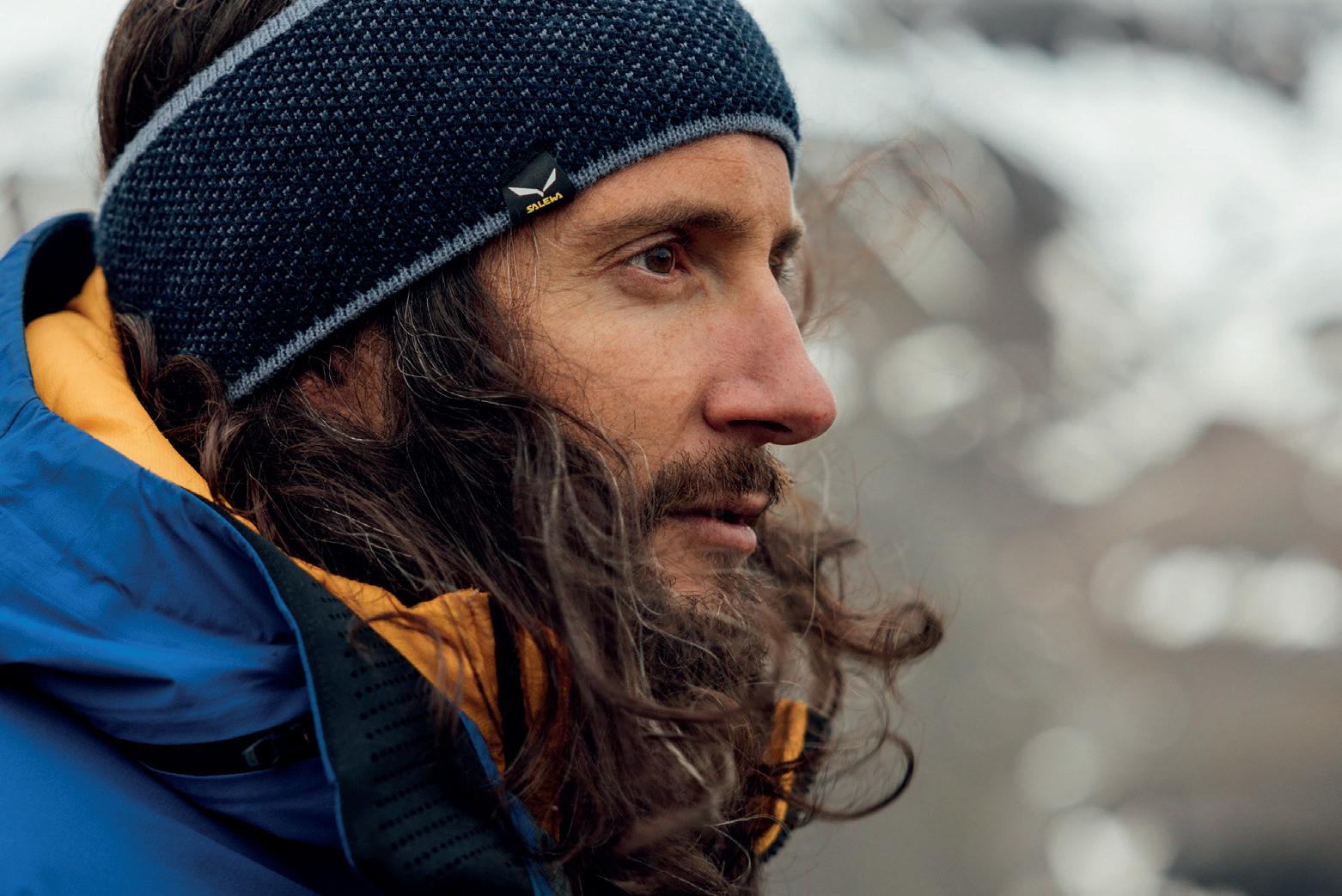
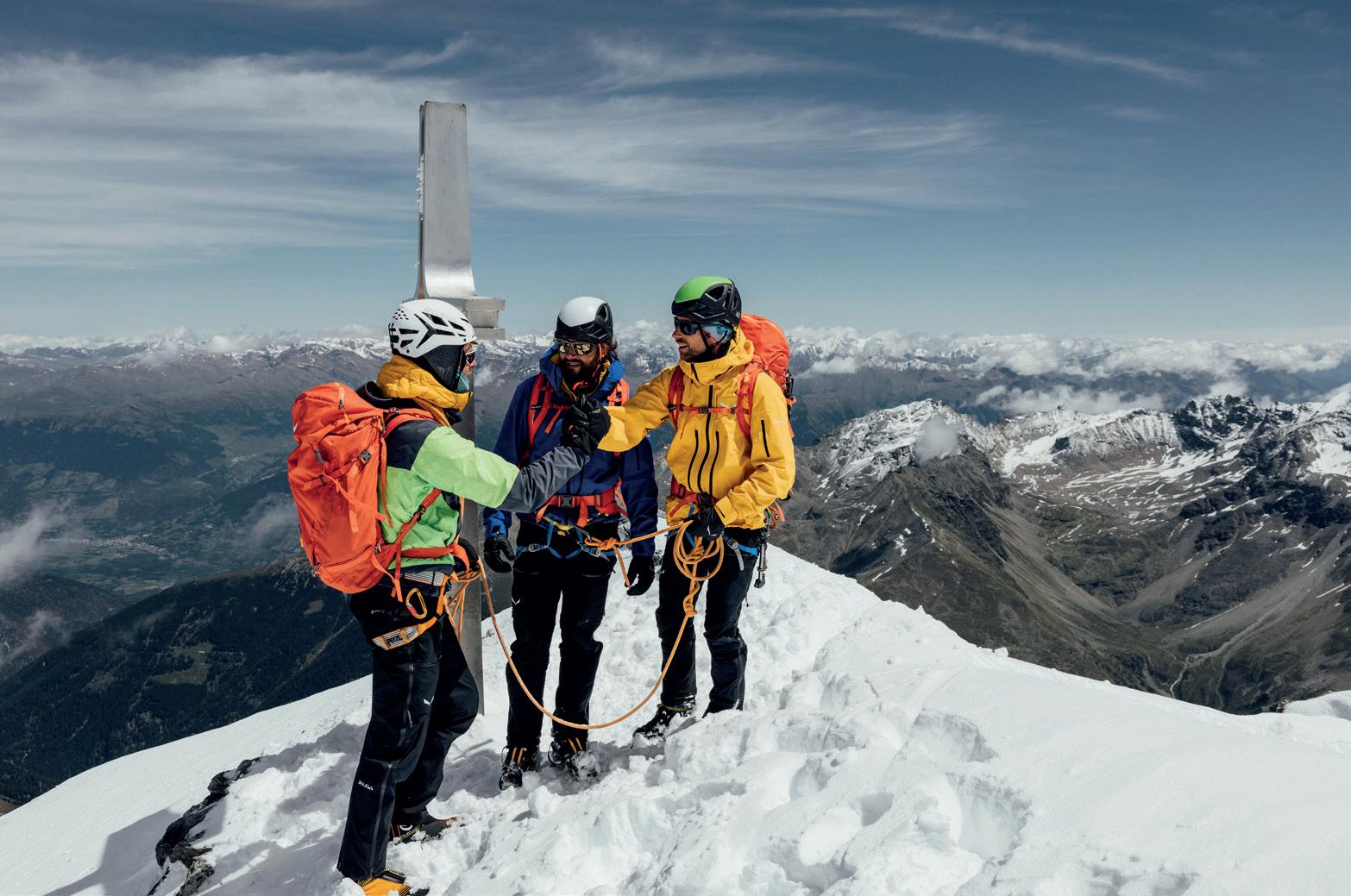
sta, few but fundamental ingredients: "When we are about to face our next challenge in the high mountains, we make a rather scrupulous selection of the objects to bring with us. On the one hand, the key word is lightweight but, on the other, you need to be ready for any even tuality. Those who aspire to greater agility and performance will bring with them only what they strictly need” explains Thomas Moe, Pro duct Director of Salewa, highlighting how at the center of the philosophy there is precisely the search for efficiency, essentiality and that “purity of design” on which the South Tyrole an brand has always been based.
The Ortles collection that Salewa is relaun ching for the 2022 fall/winter season offers a highly functional "head to toe" clothing line designed down to the smallest detail for the highest level of mountaineering. In addition to placing emphasis on the concepts already expressed, it has seen a parti cular focus on the use of cutting-edge tech nologies, such as the implementation of the Gore-Tex Pro Stretch fabric in combination with a hardshell process.
The campaign of the new collection is cente red around the story "Ortles Friends", a story of friendship and mutual trust that tells the ascent to Ortles by Gabriel Tschurtschentha ler, a visually impaired mountaineer suffering from a serious visual disturbance since chil dhood. Lights and shadows alternate in a dan ce of moving silhouettes, outlines that become more defined only when light and darkness embrace, at dawn and dusk. For him, what the eyes do not see is enhanced by the other senses. And it’s exactly relying on them that Gabriel lives the mountain: distinguishing the sound of the wind when it whispers the shapes
of the rocky walls or while it howls in the vast plains. Sensing, thanks to a strong sense of balance, the exact point where more attention should be paid and the stride shortened. But if in the course of his life Gabriel has learned to open himself to the feelings of his body, he has also learned to rely on those who are now much more than simple climbing companions: Vittorio Messini and Matthias Wurzer, roped brothers linked by a deep friendship. Self-confidence. Mutual trust. Trust in your equipment. Elements thanks to which the three mountaineers conquered not only Ortles (via the Hintergrat ridge) but, more recently, also some of the most challenging peaks in Pa tagonia, such as the Ragni Route on the west face of Cerro Torre.
Perhaps we are realizing that the time has come to experience the adventure without too much exasperation. No longer in fast-oriented mode but, as Gabriel does, looking beyond our own limits, perceiving the mountain in all its facets, relying on our senses. Being able to feel the energy of the rock, the strength of the ice, the warmth of the sun. We have to learn anew to get lost in these sensations and let a new perception of nature arise wi thin us breath by breath. We will then disco ver that we are much more than a cog, more than a simple spectator, but an active part in harmony with the great design. We will di scover that, by embracing this new freedom, heart and mind will acquire a new strength, capable of overcoming every obstacle, of rea ching every goal, every horizon.
We would all need, one day, to experience mountains like Ortles. Not the highest, not the most difficult, but one of the most emblematic.
119
Self-confidence. Mutual trust. Trust in your equipment. Elements thanks to which the three mountaineers conquered not only Ortles (via the Hintergrat ridge) but, more recently, also some of the most challenging peaks in Patagonia, such as the Ragni Route on the west face of Cerro Torre.

Nadir Maguet
BY MATTEO PAVANA PHOTOS PHILIPP REITER & MATTEO PAVANA
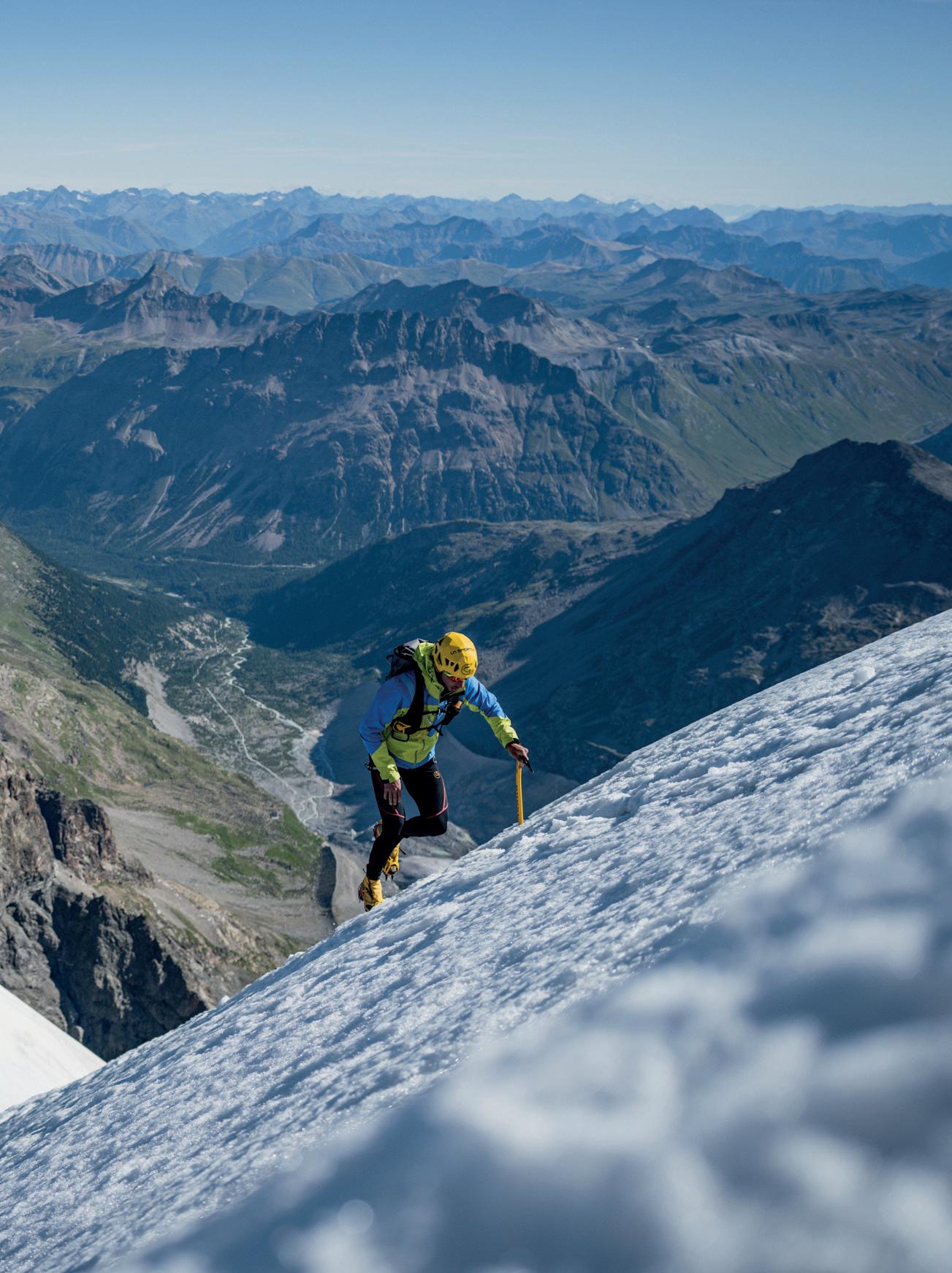
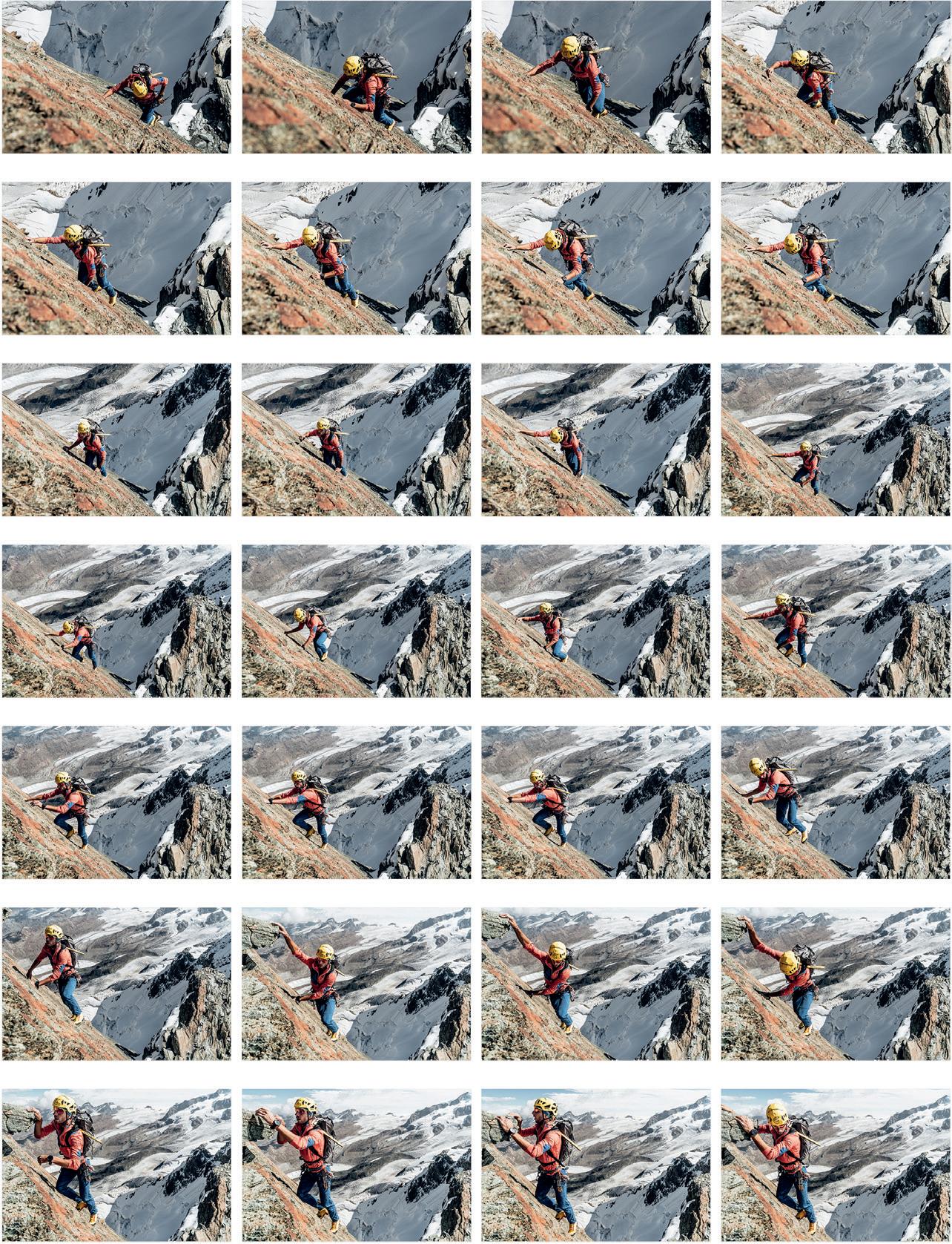
122
Originally from Torgnon, Aosta Valley, Nadir Maguet is an athlete of Centro Sportivo Esercito. Last summer he established three new FKTs on three symbolic mountains of the Alps: Piz Bernina (via Biancograt, 2:44:13), Ortles (via Hintergrat, 1:43:12) and Gros-sglockner (via Stüdlgrat, 1:30:23). He is Nadir, aka Mago, who tells us the behind the scenes story of this new venture.
Explain to the layman the meaning and reason for establishing an FKT. FKT is an acronym that in English stands for "Fastest Know Time”. It is not an official record, it is based on trust and on the data reported by the watch, in particular by the GPS track with the Intermediate times of performan ce. It is almost a certainty. FKT is a way to establish a chronometric time, whether it is an ascent and descent or only an ascent, as in my case. In the end, it is a stimulus for athle tes to push themselves further.
Again for the layman... Who is Nadir “Mago” Maguet? I am a guy, no longer that young, who has been involved in competi tive sports since childhood. I started with cross-country skiing at the age of 2 thanks to my dad. I tried different sports: biathlon and cycling in the first place. Only when I came across ski mountaineering I found my true nature: fully experiencing the mountains in a freer, wilder, faster way. I love to enjoy the mountains, especially in solitude. Having time exclusively for myself makes me feel good, especially when I can escape the hustle and bustle of the everyday life.
Is it possible to say that you are having a change of course? Which seas would you like to sail in? I wouldn't really say a change of course, but rather a natural transformation of my being as an athlete. I have never spent much time on a particular discipline, but I have always varied as much as possible accor ding to my passions and to what I like to do. I know I am in a phase of my career where I have very clear ideas about who I will be in 5/10 years. And versatility in this sense has always played a fundamental role: in addition to always keeping me motivated in what I do, it makes me feel happy. Monotony is boring.
Tell us about your summer project. It was born from the passion that I have re discovered in recent years of going to the mountains and practicing mountaineering. It was above all thanks to François Caz zanelli, my mentor in this field, that I was able to absorb the passion in imagining, elaborating and carrying out projects in the mountains. With François I realized that, by combining my athletic characteristics and my technical skills in the mountains, there would be room to create something diffe rent, something that would go beyond my self. And these FKTs were real tests to see if in the future I would be able to challenge myself on much more difficult goals. It was a summer full of satisfactions, a summer that showed me what I really like to do. How much mental and physical effort does it take to set these records? And what is the organizational effort? All of them in equal measure, I would say. Organi zing means planning every single FKT, both from a material, meteorological, communi cative point of view, etc. Mental effort, on the other hand, takes place every time the re is a decision to be made, there is always the question of whether what I am doing is right or wrong. This effort is also found during the attempt to break the record, as those mountains require mountaineering skills. For example, there are stretches where being alone without a climbing partner re quires a lot of concentration and attention. Physical effort, on the other hand, accompa nies me every single day of training to pre pare for this type of goal. After all, the day of the attempt is only the moment in which we express ourselves 100% after months of preparation.
123

124


125
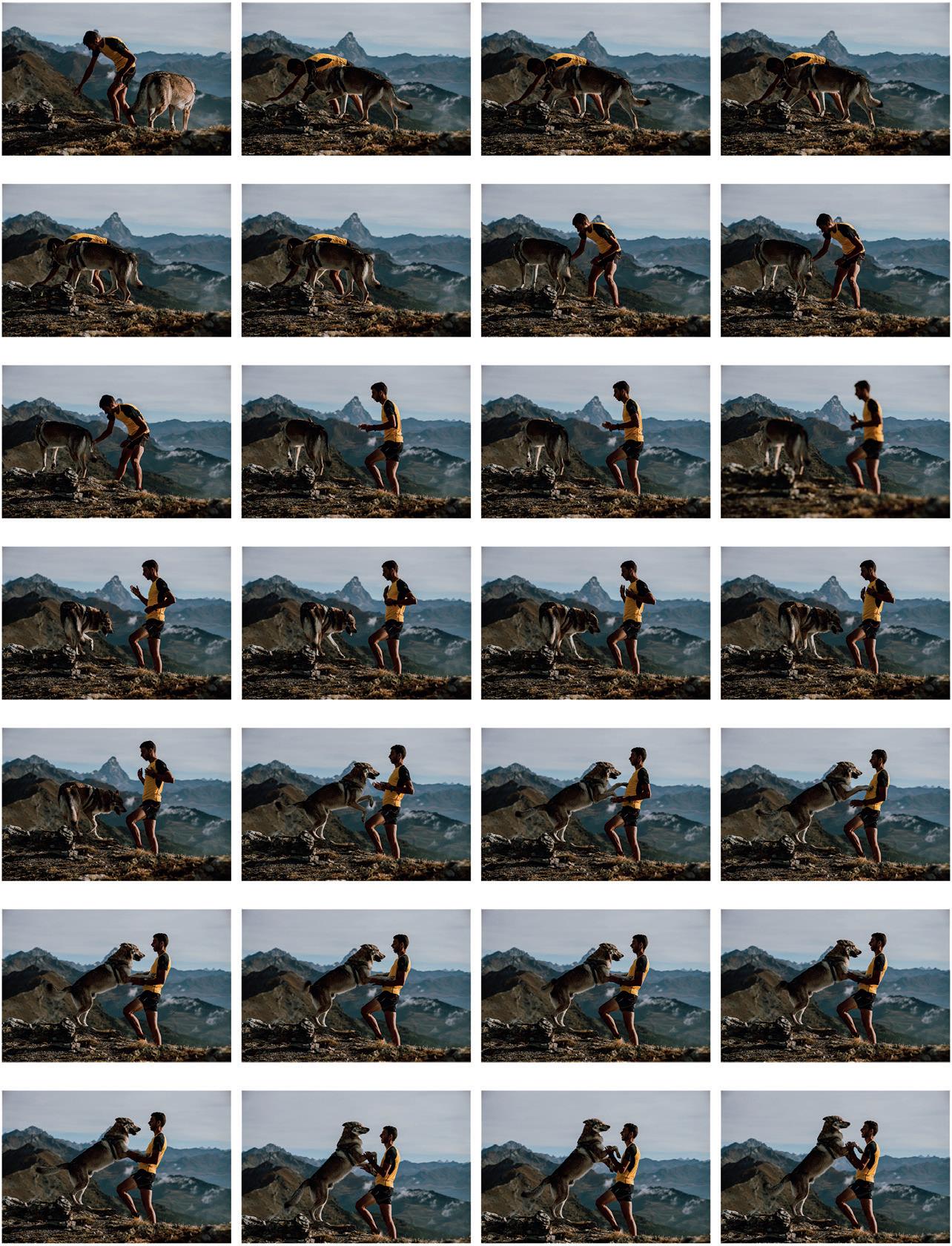
126
Were there people who helped you? One aspect that I like when you try your hand at a personal project like this is to create a circle of people who support you and accompany you in your challenge. For me they have been family and friends, that I totally trust. They supported me during the preparation and record attempt days. I take this opportunity to thank especially Robert Antonioli, Gian luca Vanzetta and Manfred Reichegger who sacrificed part of their time for me.
Let's talk about safety. How safe (or dangerous) is it to move so fast in the mountains? For me, being fast in the mountains is synonymous with safety. Nowadays, with the super light and per forming equipment that companies are able to provide us athletes, traveling fast in the mountains means spending less time in danger. Going fast alone is a personal and, if you will, selfish aspect. However, the emotions multiply. The best feeling I had during my FKTs was in the most technical points of the climbs, because it was as if I had entered a bubble: my mind was com pletely focused on what I was doing. Pure adrenaline. Then I also think that sharing mountain routes with friends, as a rope team, is something truly unique. It is up to each of us to decide how to face mountain experiences, there is no right or wrong but only what makes us feel good.
Do you see Fast & Light as a descendant of mountaineering or do you think they
are two activities running on parallel tracks? Fast & Light can be a descendant of mountaineering, especially if we consider the research and continuous development of the equipment carried out by companies. Mountaineers have always looked for new challenges and technology allows this acti vity to take on ever new facets. Fast & Light is a mountaineering style that encompasses not only the technical skills but also the physical and mental skills of mountaineers.
Tell us about the equipment and sho es with which you have tackled these climbs.The boot I used is called Aequili brium Speed, designed and developed by La Sportiva in collaboration with us am bassadors specifically for this style of fast climbs. In the development phase, other athletes and I gave our feedback in order to create a very light but at the same time per forming boot on mountaineering terrain. I think it can be a shoe used above all for classic routes that do not require particular technical difficulties, even by people who are approaching the world of mountainee ring for the first time.
Answer a question you would ask your self. How far could I reach in the next few years in this Fast & Light style and what is my true identity in this immense environ ment called mountaineering? The mountain is called Matterhorn. The record is of His Majesty Kilian. Will I ever be able to live up to such a difficult goal?
Fast & Light can be a descendant of mountaineering, especially if we consider the research and continuous development of the equipment carried out by companies. Mountaineers have always looked for new challenges and technology allows this activity to take on ever new facets. Fast & Light is a mountaineering style that encompasses not only the technical skills but also the physical and mental skills of mountaineers.
127
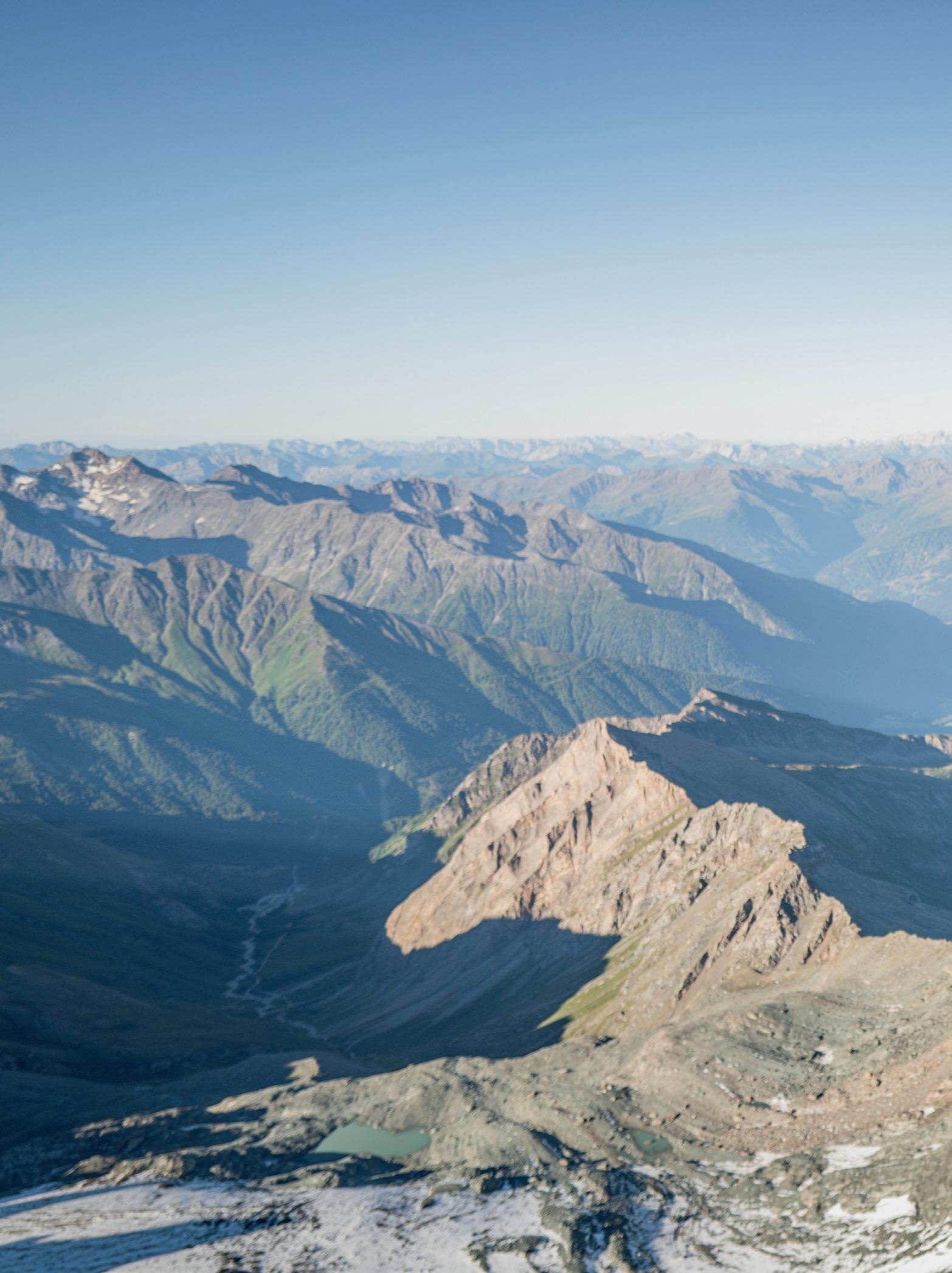
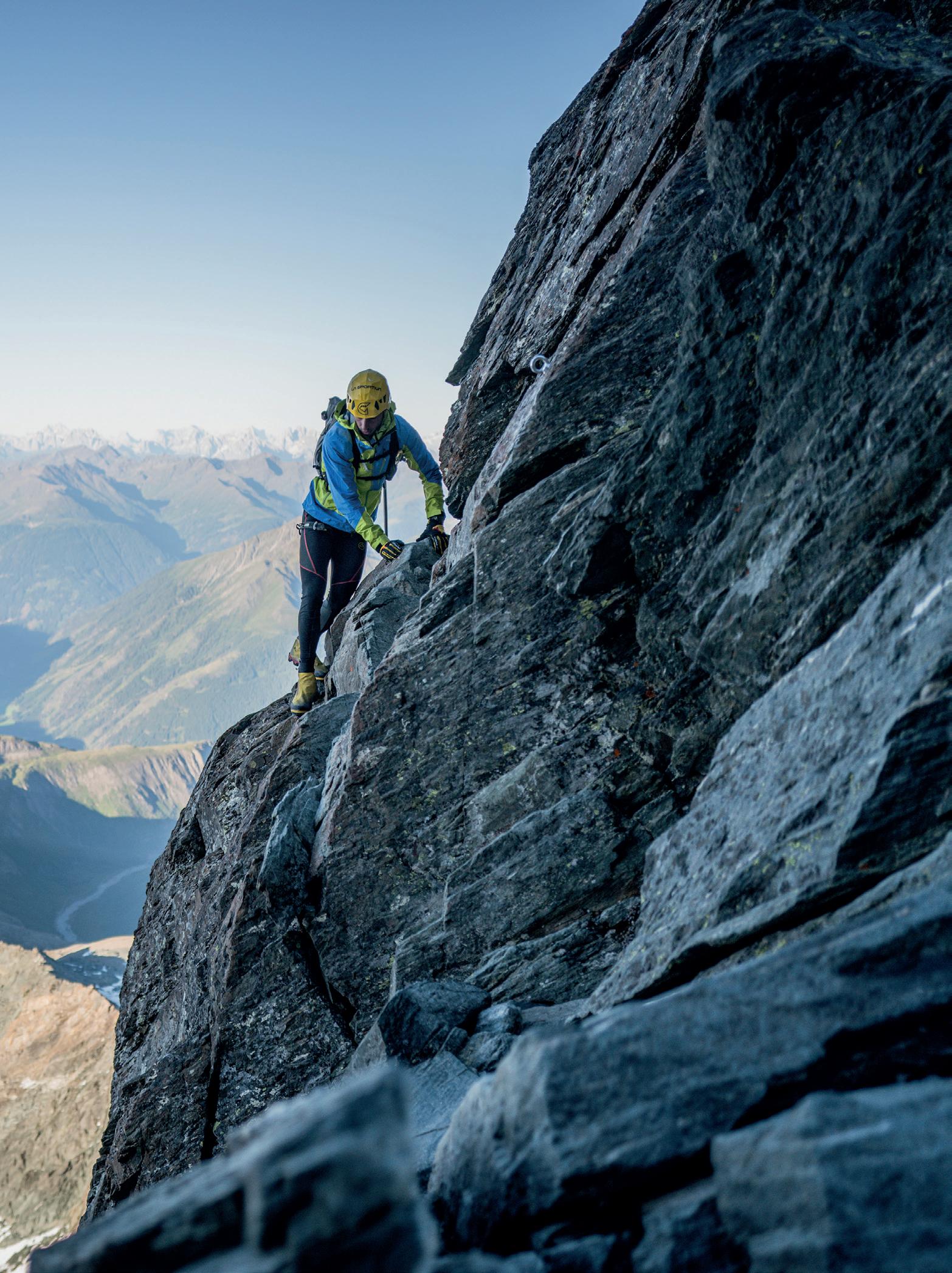
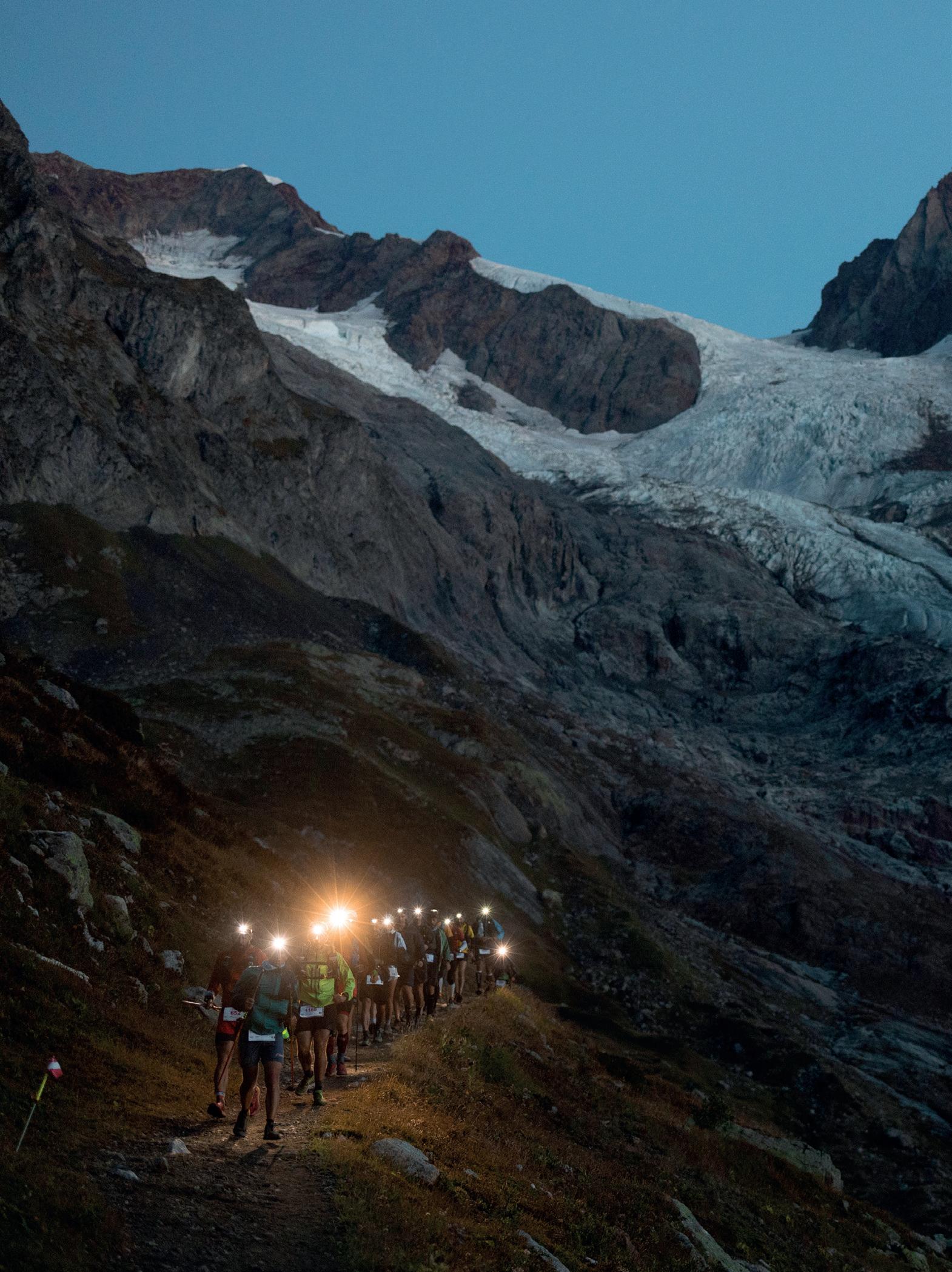
Back on my miles UTMB Chamonix
 BY FILIPPO CAON PHOTOS ALEXIS BERG
BY FILIPPO CAON PHOTOS ALEXIS BERG
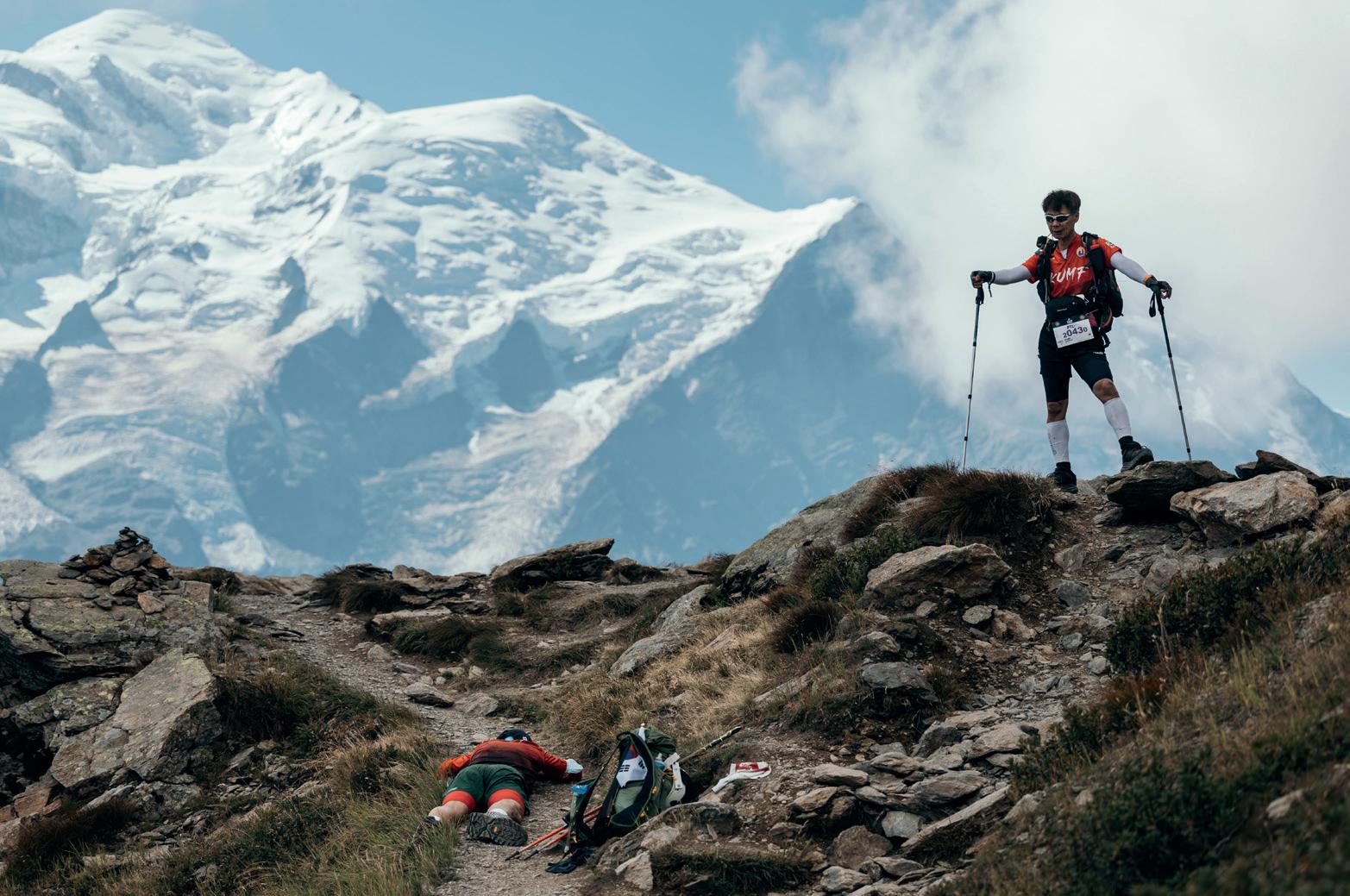
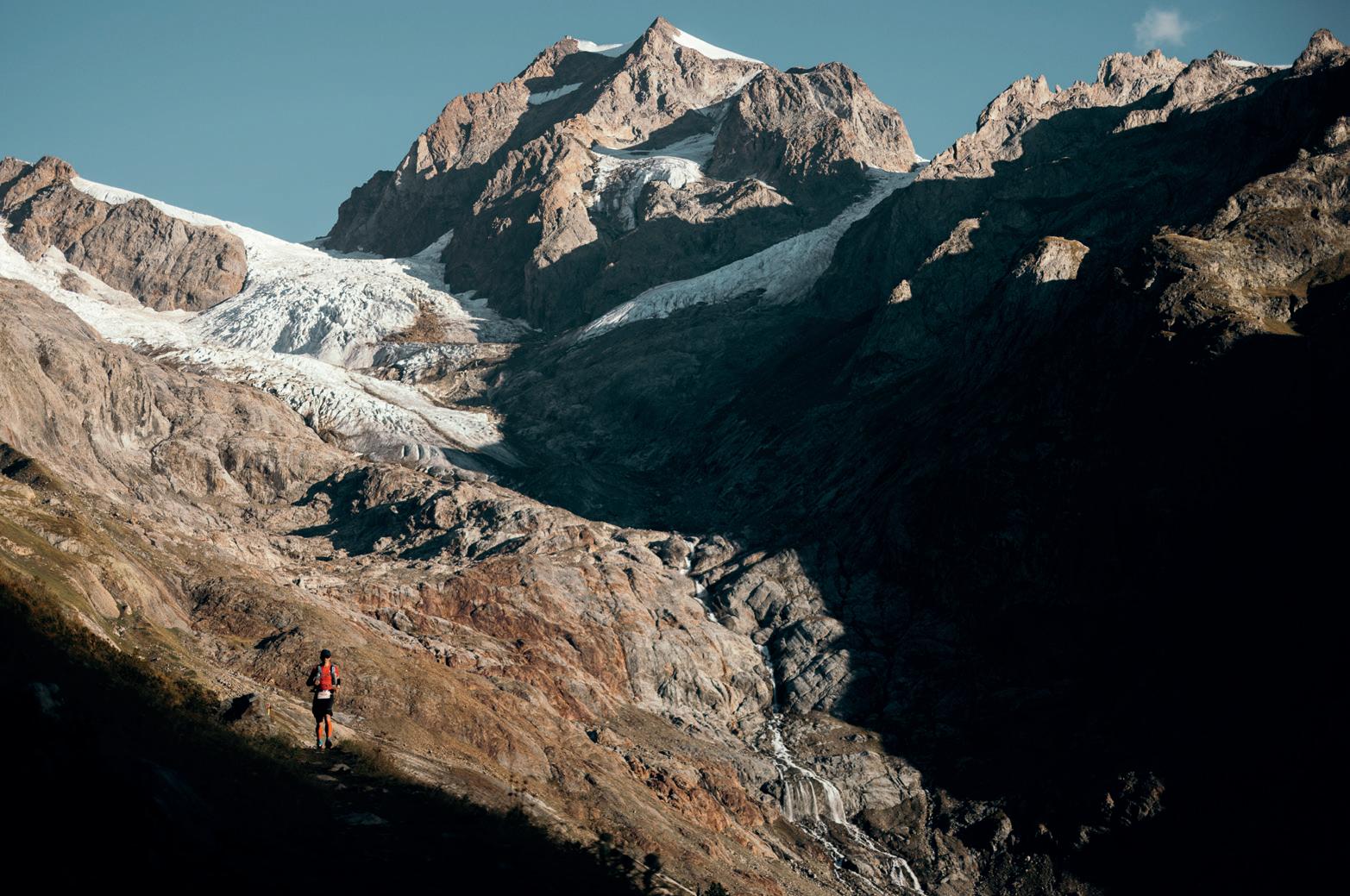
I turn my computer on for the first time in four days on a train from Turin to Vicenza. Ale is sitting three seats in front of me and is edi ting Buckled's recap, which he recorded in the car with Marcello this morning, as we were driving away from Chamonix. I have been fighting for a few minutes with the A on my computer keyboard while the gentleman in front of me is reading an article about the Pope in a gossip magazine. I am wearing a racing shirt, the only one that’s clean after these four days. When I open the bag to take the compu ter out, an acrid smell comes out, a mixture of sweat from the still wet running shirts and condensation from the tent mixed into a sin gle ammonia concoction. It is difficult to hope otherwise after four days of washing just par ts of myself in the bathrooms of Majestic, the conference center that the organization reser ves for the press, housed in an imposing Art Nouveau complex with rooms five meters high and there meters high paintings, hanging on the few walls without windows.
There, a few days earlier, as I empty my sweaty racing backpack onto the press room carpet, I watch the girl behind me googling "Kilian Jor net" on the computer. After reading a few lines, she posts a brief update on the website of her newspaper, a French generic magazine. She will be about my age and she makes me think that maybe I should be sitting at my desk like her, writing something somewhere and upda ting the world about Kilian having covid. Then I think that Kilian is quite capable of letting the world know even without my help, and that I am in Chamonix during the UTMB week and I absolutely have no intention of passing my time here in the press room of a hotel. So I
change clothes and go out to tour the city. I go to the expo more as ritual than for pure interest, but I don't stop to look at anything, so I try to resist a little longer. After another five minutes of effort, I tie my shoes and go running. I think back to the year before, and I think I miss it. I walk along a dirt road along Arve, up to a route that leads nowhere. The road becomes a single track that cuts the hair pin bends of a softer road, so I start walking pushing with my hands on my thighs until I reach a small terrace with a large granite blade in the center, overlooking the valley. I sit on the rock and close my eyes, stop thinking about the past and listen with my skin to the sun fil tered by the leaves of the birch trees and the sound of the glacial water that descends above me. I stay like that for ten minutes. Then I go down and back to the city.
Outside The North Face store there’s the pre sentation the new movie about Pau Capell and his project to run UTMB in less than 20 hours, a dream destined to shatter a few days later, when he will retire in La Fouly and Kilian and Mathieu Blanchard will finish the race re spectively in 19h49’30'' and in 19h54'50''. This reminds me of a saying of TRC: first do thin gs, and only then, possibly, talk about it. But I don't worry too much, the event is beautiful and someone gives me a Coke that saves me from dehydration. After the screening I go for a beer with Destination Unknown at Elevation 1904 where they serve East IPAs of Brooklyn on tap, I pay it 8 euros.
Beer makes me think that Chamonix-MontBlanc is one of the best outcomes of Alpine gentrification, which, it must be said, does not
133
I turn my computer on for the first time in four days on a train from Turin to Vicenza. Ale is sitting three seats in front of me and is editing Buckled's recap, which he recorded in the car with Marcello this morning, as we were driving away from Chamonix.
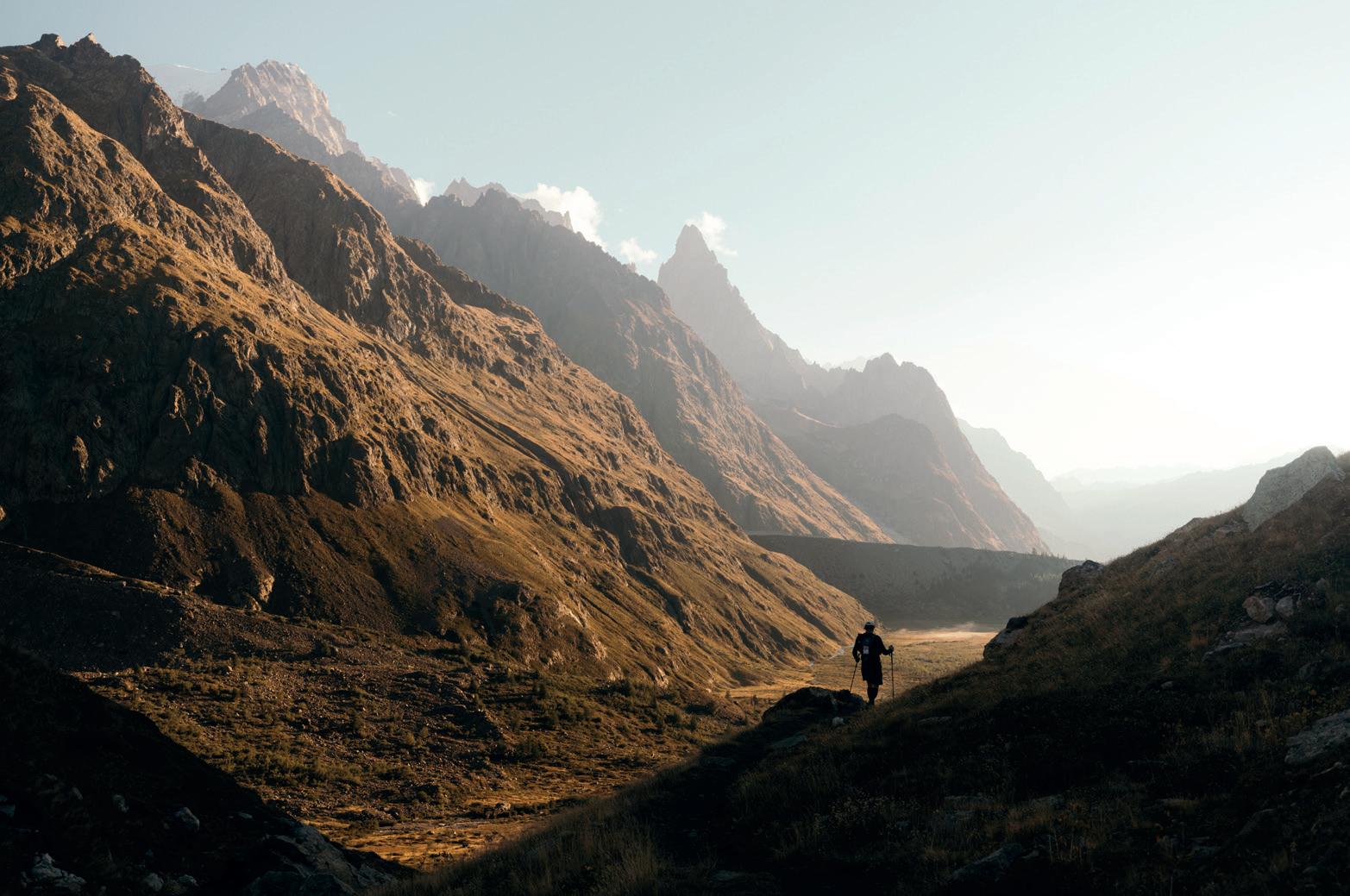
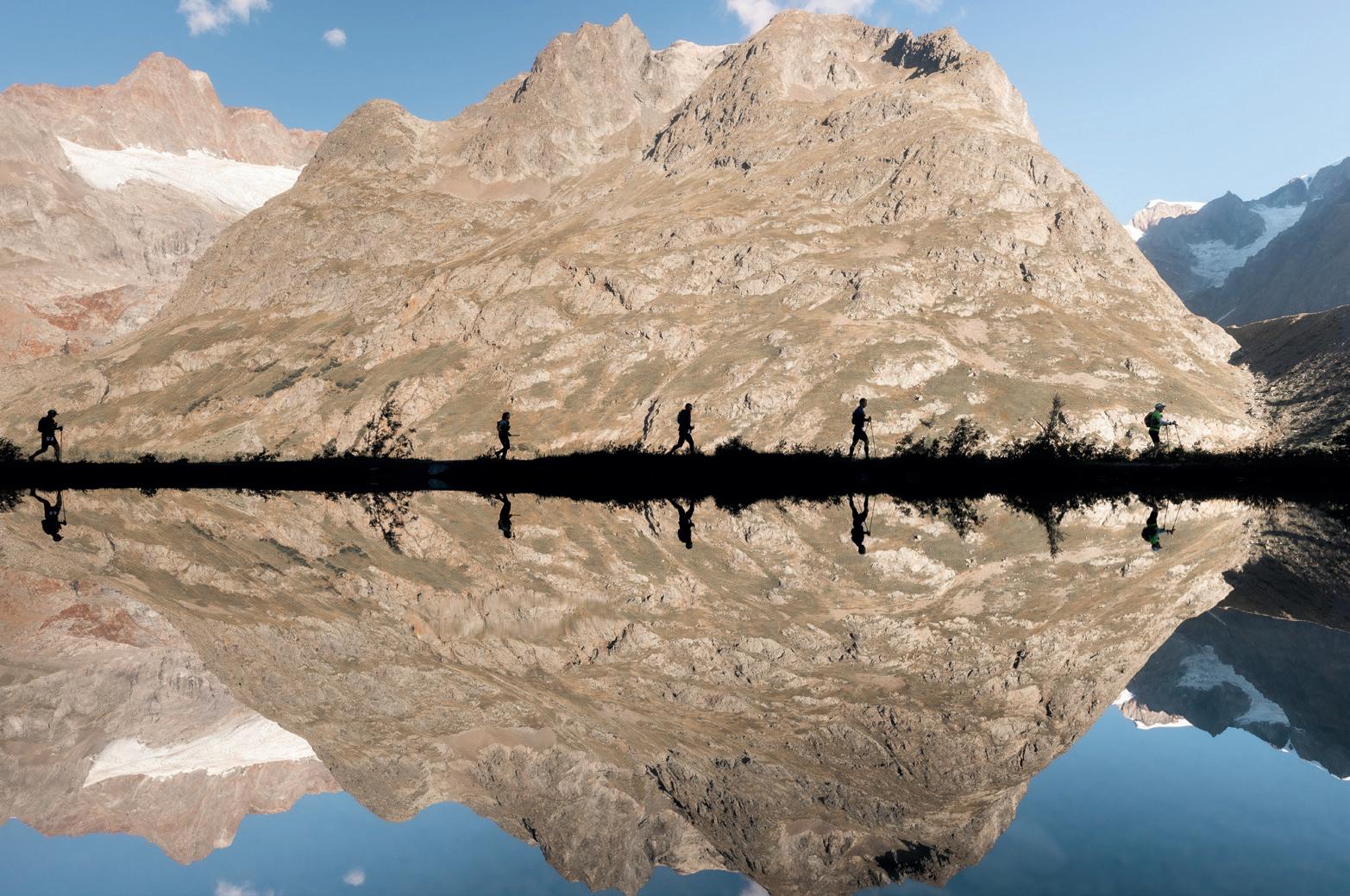
boast great results. Cham is inhabited by a fauna of skaters, freeriders, mountaineers and athletes who are not sure if they give it the al lure of the golden age or the avant-garde city, in fact perhaps both of them. It is the European capital of outdoors, in its own right, a corner of the world where bohemia is encouraged through very little bohemian prices. In short, it is the place where marginalized people feel welcomed, as long as they are marginalized of a certain stature. The gentrification of Cha monix attracts athletes from all over the wor ld, but not enough to hold them back for long, so much so that sooner or later they all leave, even Kilian. However, for four days a year it is the place where I dream of living, despite the cold, the prices of alcohol and anything else.
On Thursdays I walk through the cafes and pubs of Avenue Michel Croz to the statue of Paccard, turn left on Quai d'Arve and pass un der the statue of Balmat and Horace de Sassu re, then right and left again to Rue du Dr. Pac card. Here I make my way through hipsters, outdoor stores, overweight tourists and ath letes already dressed for the next day's race. I enter Volcom where I am greeted by an inten se smell of weed. They have the same shirts as last year, and on the third disappointment I decide to give up and head to Les Rosières, where Asics has organized a media meeting.
UTMB is not only the biggest race in the wor ld, but it is also a moment in which companies decide which path to take next year, presen ting products and athletes and speaking to the press. Although not a fair, over the years UTMB has become one of the central moments in the economy of this sport, for better or for worse. For this reason, companies establish he adquarters by renting entire hotels, restauran ts or transforming pubs into private lounges.
One evening I end up at an ON Running event at La Folie Douce Hotels, of which the Swiss have rented the entire terrace. The balcony is 50 meters wide and 20 deep and is packed with people, there is loud music and you can't talk, let alone work, which is what I suppose everyone is here for. At the bottom of the terra
ce there is a stand displaying next year's new shoe, and not far away a guy in his thirties, not very tall, blond and with the face of a child. I ask Tommy to turn around, and point to him, then I say, “See that guy? That kid has won UTMB three times.”
Altra Running gives a presentation with com pany founder Brian Beckstead at the Chai Guillaume Hotel. He has the typical American enthusiasm, which at first seems almost fake: he is not. He has bright eyes and talks about UTMB as something he knows. He is one of the few people I've met in this environment who really runs, and I'm not talking about jog ging twice a week, but about UTMB, six Wa satch 100, Bear 100, and Cascade Crest 100 in 23h40. I manage to slip into a slot to interview him and we talk about anything but shoes. He's a nice guy, he leaves me his business card and asks me to write to him if I go to Utah, I probably will.
Despite these side events, I still haven't mana ged to forget about UTMB. The rites of Friday evening do not change: Vangelis, the thing with the hands, the speaker, and for the first time after Covid also the non-staggered start. This is the second time I have seen the start of the race live, and the first time that I’m not run ning it, that impresses me a bit. We are three hundred meters from the start line and it takes 8 minutes for all the runners to pass, which roughly corresponds to a linear development of two kilometers. We look at the arrivals of CCC and eat the first of many pizzas from Ne apolis, on Arve. Around midnight we collect our things and move to Courmayeur to see the first half of runners pass by.
I remember the aid station of Courmayeur crowded with already exhausted runners, who wander barefoot through the gym looking for something that can exhume them after a ei ghty kilometers run at a pace too fast for them, then there are those who sleep in a corner, que stioning their stomachs about their intentions. But at this time of night that moment still se ems far away, and for now what would have become a military hospital at the first light of
135
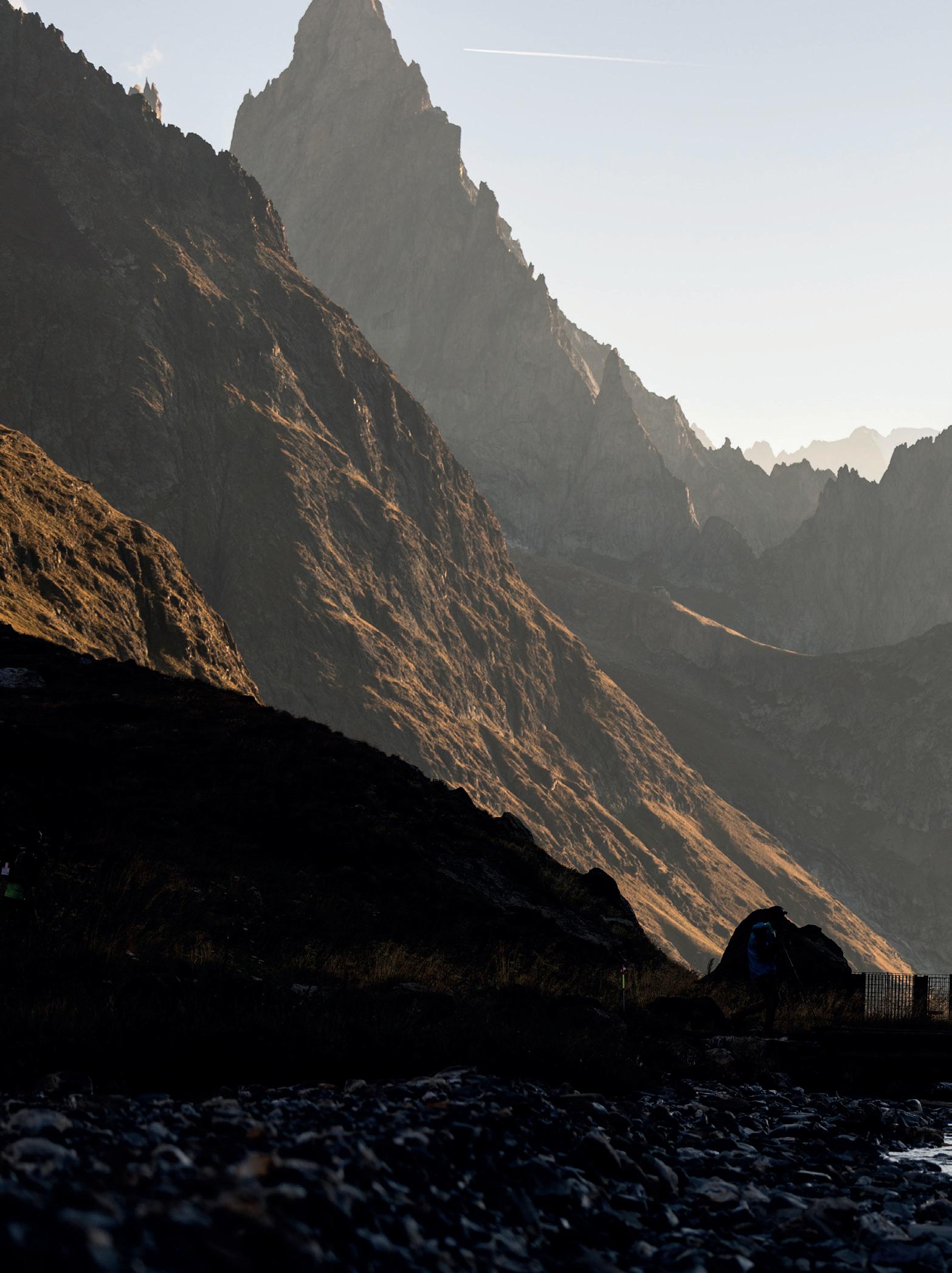


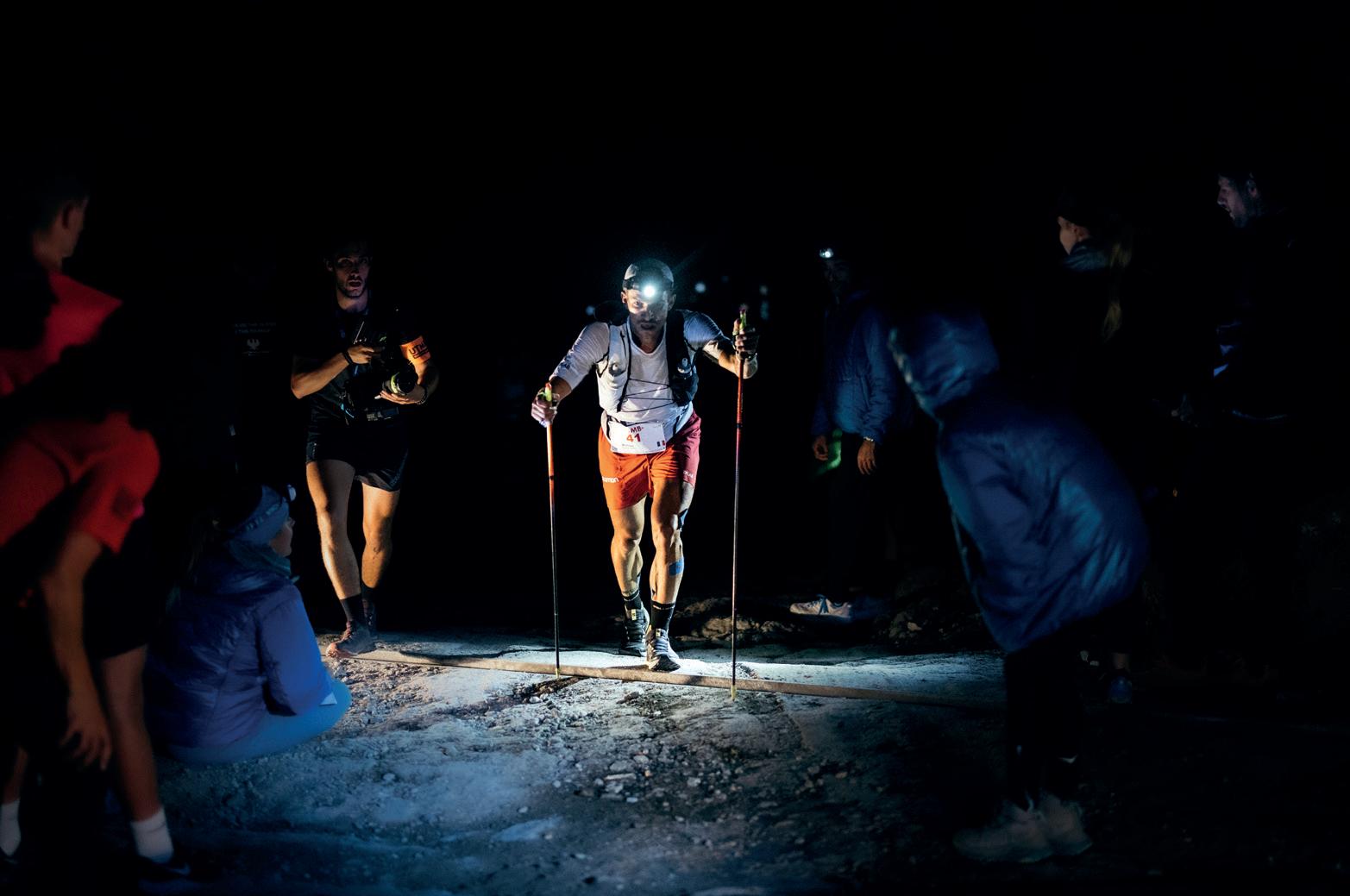
day is still only a large tidy gym, populated by photographers and journalists who wait si lently. In the area dedicated to athletes there are only the assistant of Kilian Jornet, and Jes sica Brazeau, the wife of Jim Walmsley.
I am leaning against a barrier that separates me from the table, crowded together with fifty other journalists standing there at two in the morning waiting for the arrival of two people to watch them while they eat, it must be said, we could have done better. On Kilian's table there are only three black and white Maurten gels, a small bowl of hydrogel, three paper pla tes with tasteless and odorless food that is the same color as the plates, and a blood glucose meter. On Jim's table there are colorful gels, Coke, gummy bears, Haribo licorice swivels, and a tube of Pringles. In the silence of the gym a voice on the other side of a radio says 10 minutes, then 5. Then you hear an applause, you see Jim's headlamp, and after 90 seconds the one of Kilian.
The silence that surrounds the room is broken by the noises of the cameras and the voices of the two athletes. They stay in for 240 seconds, then they get up, the silence is broken by a col lective roar. We are waiting for the first thir ty runners, that we can distinguish based on their running style, even before we see their faces, even though we have never seen them live in our life. Sage Canadey retires, Hannes Namberger enters the aid station and leaves after three minutes barefoot and limping.
Been here a year later leaves me with a mixture of feelings. I miss the emotional involvement of the race and the amazement of the first time, and I wonder if this is also the case for them, who run it every year. They remember the editions based on the results, they are happy if it goes well or if it goes wrong, and someti mes not even with that, like Kilian, who arri ves quite catatonic in Chamonix. The country is covered by thousands of people with their arms raised and their mobile phones all poin ting in the same direction, to pick up other arms and other mobile phones. You can guess at what height of the crowd Kilian is based on
how the mobile phones that rotate, but he is just one head among many others.
Internet stops working, connection slows down. Ale will tell me that it will take Bryon 8 minutes to upload the tweet of Kilian's victory. I am on a barrier in the third row, the organi zation has not reserved a place for the press and I am forced to elbow like everyone else. As soon as Vangelis finishes, Kilian sits down, I move away from the barrier, hitting whoever I have in front of me and leave Chamonix to go back up the last 20 kilometers of the route up to Vallorcine. I find Jim just above La Floria, in full crisis, he runs badly and he seems like he has forgotten his perfect run, round, with high knees and full heel call, but he is lucid enough to wave his hand when I whisper to him "come on Jim, you did it".
Three hairpins above there’s Zach Miller, even more exhausted, after having run his race of a lifetime beyond all expectations. From La Flég ère I go up towards Tete aux Vents on an an gry and damn long traverse, on which I meet Katie Schide, she has a blood-soaked handker chief stuck in her nose but she runs better than many others I’ve met. Sometimes we think that for these athletes it is just a matter of winning or losing, but in their eyes I see the same de speration of the last ones, as they count down the kilometers, and as they stumble on a root, and I see their desire to sit on any stone and stay there forever. I go back down to the climb of Tete aux Vents, undoubtedly the hardest of the whole race. At first I find Alberto Ferretto very close to Kaytlyn Gerbin, the third woman. Alberto is still pushing and climbs well, he is lucid, but he asks me if there are 20 minutes left at the Flégère, "something more" I answer (the re’s still an hour and a half to go).
After him there’s Tyler Green, who at that mo ment thinks he knows me, "I don't think so" I tell him, who knows what he sees. Emily Haw good arrives at Vallorcine's aid station. Emily is a girl from Zimbabwe but she lives in Idaho. She is one of the most positive figures in the ultra running scene, and above all she has a great power, she is the sixth woman now and
139

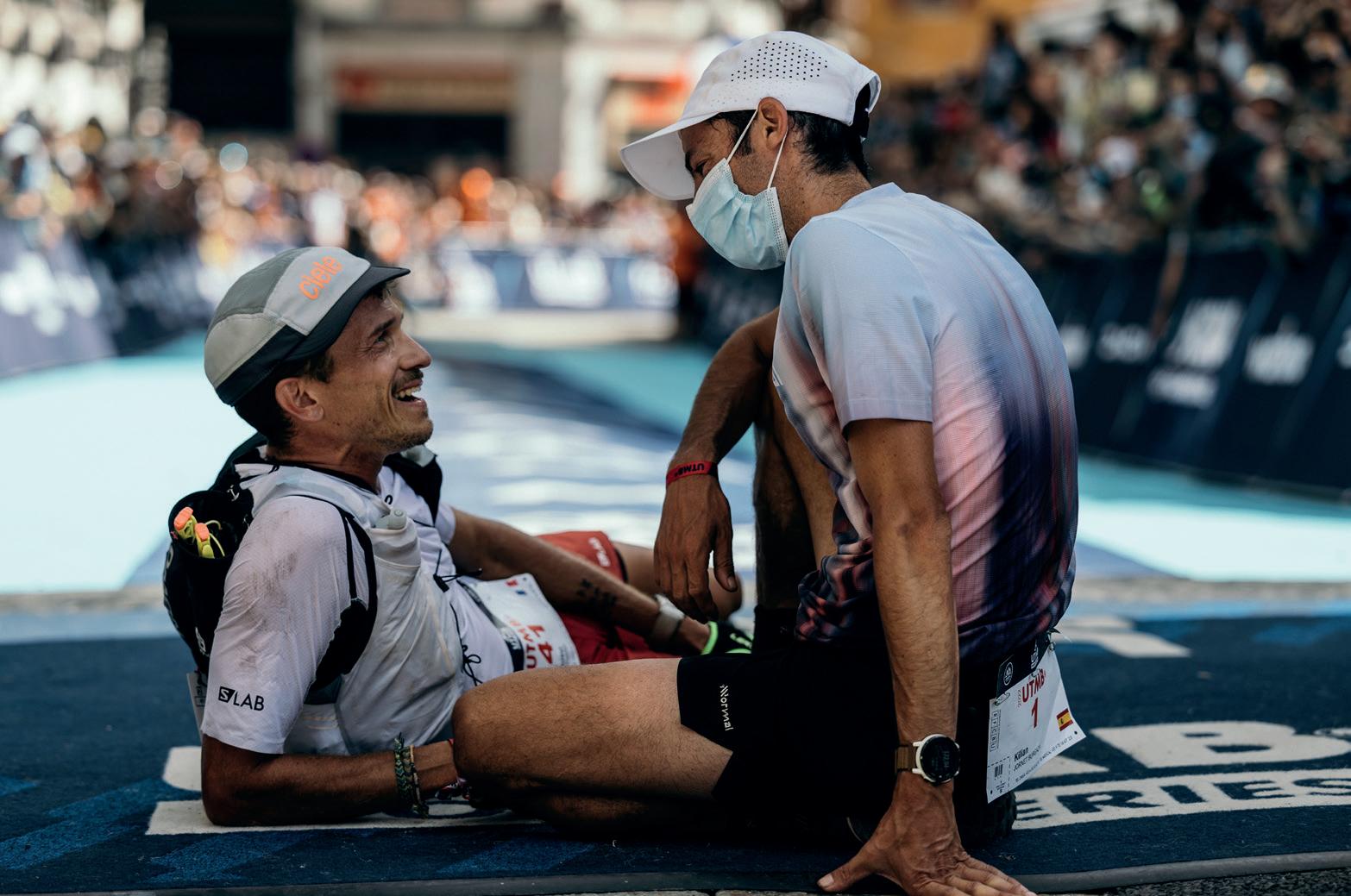
she is obviously very happy about it. After a while, Francesca Pretto also arrives. The seven th, eighth and ninth women are very narrow, but Francesca takes her time to eat because she knows that the last section is so hard, is the ri ght choice. When she comes out of the aid sta tion we scream at her, she looks down and tries to mask an expression, I think she would like to cry, but she doesn't, at least not in front of us. I don't know Francesca very well, but enough to think that she wants to live that moment alo ne, sharing it with Tommy. She is running the race of a lifetime and she knows it, and she is doing a time that a few years ago would have earned her a podium. It's nice to see that sense of liberation in others, and there are few races that give it, and UTMB is one of them.
I spend the following night in a tent in a lawn of Chamonix municipal wood. I wake up under a dawn that hugs Mont Blanc, in from of me, ia greenish blur of September. I warm up my coffee by staying curled up in my sleeping bag and trying not to move the condensation that has created inside the tent. A low layer of fog rises from the lawn which hides the trunks of the larch trees, which seem to be suspended in nothingness, then as you look up, everything becomes clearer and clearer, the tips of the tre es, and a few centimeters above the Dru spire, the crest of Aiguille du Midi, Dôme du Goûter.
I stay there for a while looking at the profile of the mountain, which still covers the sun, then
I face the humidity and leave the tent. Are your running this year?
No, should I?
Didn’t you like it enough to run it again?
No, I liked it so much that I didn't want to do it again. I only understood what UTMB was after running it, and I think it's simply the best race ever. It is for this reason that I will no longer run it, or at least not for a while. I don't understand the consumerist need to overdo the experience, continually overwriting me mories. Traveling too much, running too many races, all immediately, without having desired, dream, imagine tem. Five, six races a year, one of them alone would be worth the whole year. But that’s a personal limit.
I would like to run UTMB continuously, over and over again, with Camilla in Champex-Lac, Paco in Greece doing ctrl-R on live tracking, Ale that comes picking me up at night one ki lometer from the finish line, and Switzerland, the months of preparation, the mileage to get there, the process, the amazement. But that perfect day, and those months and those per fumes and those sensations, which seem those of dreams when we wake up, those things are still there and I will not relive them putting a bib on me. It went well, and I know how to be satisfied. There are so many other races out the re. I want to respect memories by experiencing new ones, to be where I am, without projecting the future or binding it to an expectation. This year I was thinking of finding a paler Chamo nix, and maybe it was, just as it was pale this summer. But going back on the miles of that race and seeing the eyes of those who ran it was nice, and that's enough for me.
141
This year I was thinking of finding a paler Chamonix and maybe it was, just as it was pale this summer.
But going back on the miles of that race and seeing the eyes of those who ran it was nice, and that's enough for me.
Vast Ladakh Little Tibet
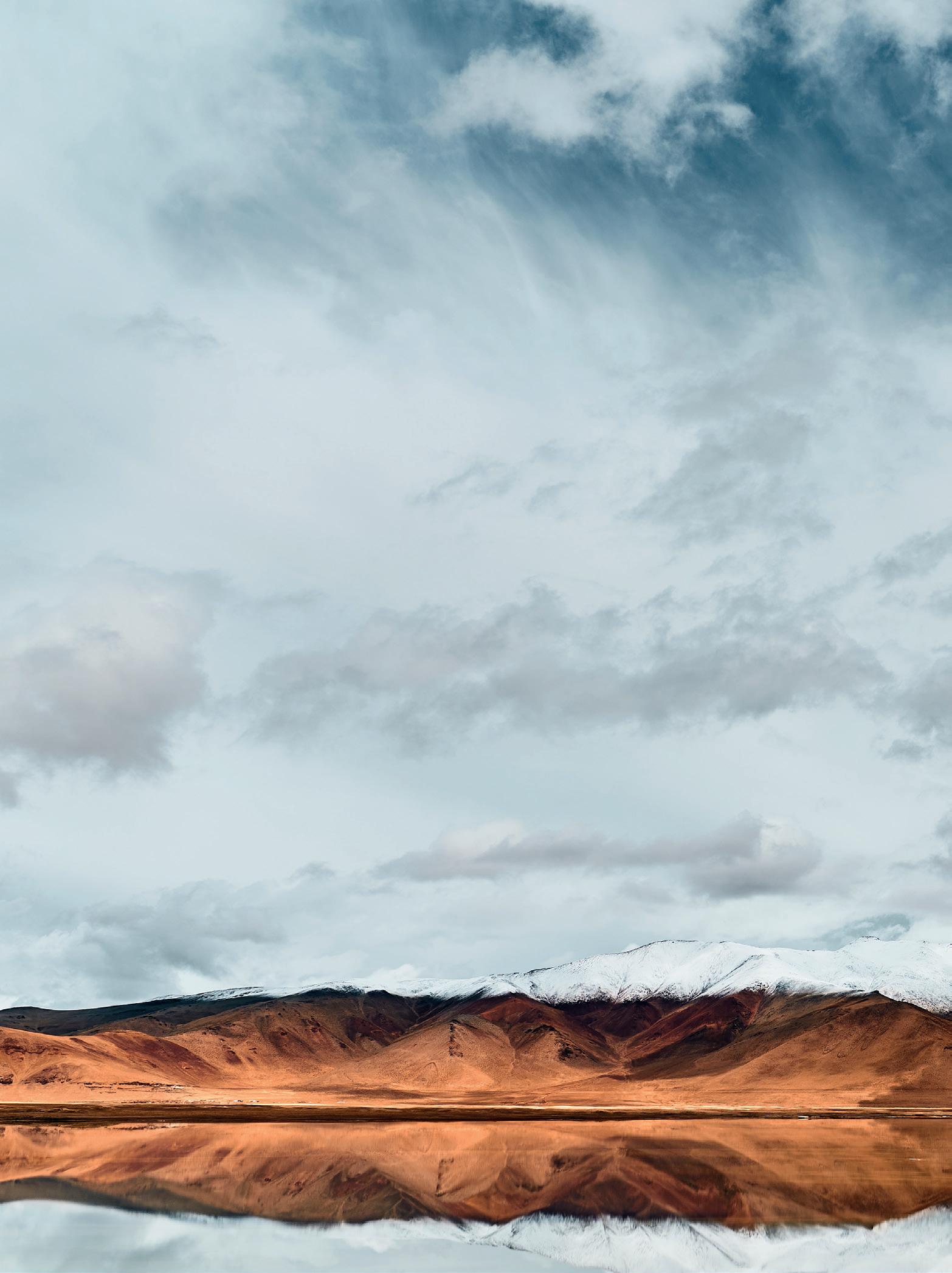 BY CHIARA GUGLIELMINA
BY CHIARA GUGLIELMINA

Fifth of August.
It all started on August 5th, in Italy. Incorpora ted into the sofa at home, damp and exhausted by the scorching summer. On my left an old worn book, recovered by my father in a secon dhand book shop: "History of Mountaineering". It must be over, one might think, if its history has already been written.
“Mountains and literature” is the title of the twelfth chapter. The eighth line reports a quote from Lord Conway the first time he saw a great mountain: “For me, it was not part of the earth, it had nothing to do with the world of experience. That, finally, was the other world, visible, inacces sible perhaps, but present; real but incredible; solid, with the appearance of what lasts forever, and at the same time ethereal; of an overwhelming and fasci nating majesty at the same time. In my spirit there was not even the desire to climb it.”
In less than a week I would be walking up high, in the Ladakh plateau, on that mountai nous land in the north of India, nestled betwe en Pakistan and Tibet (or what remains of it). I leave like this, with the desire to walk that other world, visible, inaccessible perhaps, but present, with the need for something real but incredible, for something that is there to stay there forever.
A country in a crystal.
It is not my vision, that one of seeing it as so mething crystallized. Personally, what I found looks more like fresh clay, the easily malleable one. In the driest region of India we walked under water and hail for four consecutive days. This too is a world that is changing rapidly: at an environmental and cultural level. The only feature I find in the crystal is the fragility of a transparent world, whose immense culture is
courageously guarded in the face of the expan sionist aims of Pakistan and China.
However, wet or dry, the land covering the area is sandy but without dunes. It is a land of cum bersome absences. You feel naked in Ladakh, but safe. The hours are not enough to calculate the distances, the days mark the stages of the journey. From time to time a blue trickle cracks the brickcolored sand, or dovegray, sometimes terracotta, rarely purple: magnificent. And when the dryness is interrupted, the green, en vious and vain, joins the composition. it embra ces the water as if to enhance its presence. We walk between 4000 and 5500 meters high, but each horizon is higher and each mountain has more snow. Everything tends inexorably to the sky, as if, against all odds, the destiny of a lost world was nothing more than growing up.
Them.
The skin is neither light nor dark. Thick, as a shield against sun and wind. The narrowed eyes and the mostly small, but strong build body. Hands of those who work and gazes of those who peer into the distance, half closed. Those "they" for us are Santosh, the one who walks, Dawa, the one who cooks, and Jampa, the horseman. Men who live at the rhythm of the Earth, without artifice to dictate the ti mes. They go to bed when they are sleepy and wake up when they are rested. Coincidental ly, everything coincides with the setting and rising of the sun. Apart from Dawa who eats and sleeps when and where he likes, a 90kilo child. They move between a fading tradition and overbearing progress. Around their necks they wear heavy amulets, a legacy of ancient ancestors, while on their feet they wear plastic Crocs shoes. Perhaps it is an East in progress, perhaps a West in decline, more likely simple globalization.
144 * BASED ON REAL EVENTS
About this third trip to the foot of the Himalayas
I will tell what there was: the good and the bad. And I leave the interpretation to those who read.


Us.
We are weaker than them, especially as the altitude grows. The skin, lighter and thinner, cracks until it splits. We should be more massi ve, but I embody the classic ruleproving excep tion, ending up being the smallest of the bun ch. Eyes trained to reflect any type of monitor, accustomed to light but not to this immense one, they are tired at the end of the day, they burn. We jostle between the days at a frenzied, unnatural pace: a flood of maddened ants. We wear more plastic than the simple Crocs shoes and we still haven't figured out what to think of globalization.
The journey.
Having made the necessary introductions, these are five of us walking towards the mountains: two Italians, two Indians and a Nepalese. The trip starts from Leh, like everything in Ladakh. The city is the capital of the entire region, the center of absurd contradictions. It enjoys rai sed spaces full of sacredness, but coexists with a market that has adapted to tourism and the West. Terraces high above the busy downtown streets serve what would like to be margherita pizzas and “Everest” beers while listening to Ja mes Blunt, sometimes to Bob Marley. Around an impromptu worldly life, dark streets surround the area marking the boundary between the In dia of tourism and the one of sandy silences, the one of that other world.
Everywhere, in and around Leh, people are building stuff: new roads, new buildings. The deployment of military forces throughout the area takes away further sanctity and pollutes what once was India. Of the small surviving Tibet, there are few monasteries perched whe re ancient monks and new soldiers coexist. A wooden sign, “the way to the monastery”, is an arrow pointing to the right and there, on the right, a soldier in uniform holds a rifle. Confu sion is king.
More or less disoriented, we are officially on the way, five different cultures sharing the same ef fort. I am not talking about every step here be
cause it is not the single step that counts. Here is my selection.
*from my diary. August 14th.
Santosh and I walk closely, Mattia is behind us taking pictures. Beyond yet another horizon, at the bottom of the steppe there’s a flock of goats and sheep, thin and small. I tell Santosh about our goat cheeses. I explain to him that each of our valleys has its own shepherd, and each she pherd has his own flock and, often, each flock produces a cheese or a toma. I tell him it's de licious but he doesn't believe me. And while he talks about the Himalayan blue sheep cheese, I reply with our blue goat cheese, with its veined white texture and the sweet and spicy flavor.
*conversation.
C: When we go to the mountains, Mattia and I try to buy things like cheese directly from local producers, from our mountain people.
[…SANTOSH NODS…]
C: Not only the product is better, but it is a way to survive for alpine activities. To allow those who live in the mountains to live in the mountains. We also talk at long time about the roads: the shortcuts to the mountains. People do not rea lize that the idea of making remote places more accessible and better accessible, in part share able, destroys ancient cultures and buries pri celess traditions. Which are then memories and testimonies transmitted from one generation to another, essential for orientation.
We are weaker than them, especially as the altitude grows. The skin, lighter and thinner, cracks until it splits. We should be more massive, but I embody the classic ruleproving exception, ending up being the smallest of the bunch. Eyes trained to reflect any type of monitor, accustomed to light but not to this immense one, they are tired at the end of the day, they burn.
146



A thousand-year-old heritage is abandoned in exchange for a handful of wellbeing. Having your ass warm is nice, the belly full is even nicer, but if you are not satisfied you are impoverished. Even in wellbeing, especially in wellbeing. And the human being is not satisfied.
*lunches.
Dawa prepares our lunch boxes every morning. I still wonder how such a small amount of food can weigh so much. It may be te effort of the walk, but the specific weight of that single po tato seems similar to the one of uranium. The container is a heavy metal jar that houses a bi zarre 100% Indian watermelon juice, a boiled egg, the potato mentioned above, a Willy Wonka style chocolate and, when you're lucky or when Dawa remembers, a pinch of salt wrapped in an aluminum foil.
*from my diary. August 16th. It’s raining outside. Inside the tent, everything is humid but warm. Dense fumes are mixed; Ne palese cigarettes, a pipe, burnt kerosene used to cook more dahl and everyone's breath. On the ground there is soil and at the edges, where the water filters, a red mud. Santosh, Dawa and Ja mpa will sleep there. We are on the third day of walking and I have now abandoned the idea that the pile of stuff piled up everywhere has some logical order. On the side most sheltered rom the wind, the grease that drips from the cloth and the rusty iron stove delimit the kitchen area. On the one hand, dirty and rolling, some halfrotten pears, peppers and lots of beautiful red tomato es. From a damp and torn box broccoli, kale and strange spinach appear more limp every day, like me. Tired. To the smoke, that night, is added the alcohol of an improvised Cuba Libre, made of rum of dubious quality and the remains of a Coca Cola. We get drunk and take pictures. And while a bolder Dawa shows us the sign of the
I read, some time before leaving, about a terrifying project: the new Silk Road. A huge thing, wanted by that mammoth Chinese power. The network of new infrastructures, of new tar flows to design roads to connect all of Eurasia and Africa, will further increase CO2 emissions on this wornout planet.
Nepalese civil war (a bullet in his leg), a woma nizer Santosh tells us about the women he had and the ones he desired. In these trips it happens often: all life is mixed together. *from my diary. August 17th. What will remain of this surviving Tibet in nor thern India? Things have already changed, but in the cracked skin of the nomads and in the purity of pristine spaces, I still feel a lot. I read, some time before leaving, about a terrifying project: the new Silk Road. A huge thing, wanted by that mammoth Chinese power. The network of new infrastructures, of new tar flows to design roads to connect all of Eurasia and Africa, will further increase CO2 emissions on this wornout planet.
*from my diary. August 18th.
I have a bad luck and a fortune in life, more or less like everyone else. I am terribly thin, patho logically it can be said, with a fat mass of 12%. The reasons are known to those who must know them, but of course this is bad luck, because there is nothing beautiful in not being able to eat. We are working on it, however, we are a good team. My fortune however is not to suffer the altitu de and indeed, the more I climb the better I feel. Genetics is a strange thing. I like to think I was born to see this immense up close: the moun tains I dream of. Mattia says I'm a little yak, they don't survive below. Sometimes I feel like this at
150
“People who ignore their past will never know anything about their present.”
- INDRO MONTANELLI
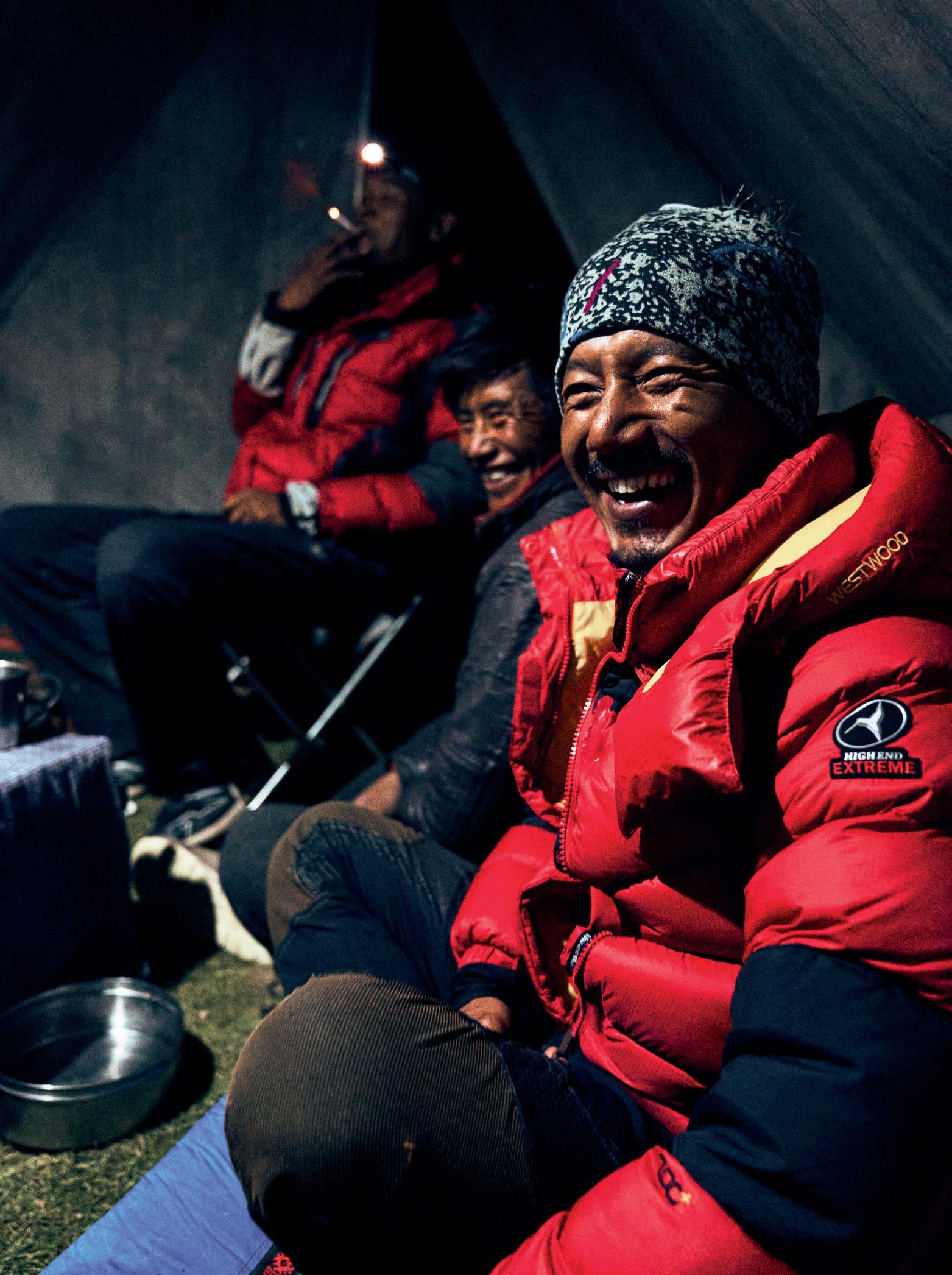
home: I don't know how to be in the world. Up here, far away, I am free, more proud, even more a woman. And suffering is sweet to me too. The higher we go, the rarer the green becomes. Glit tering stones herald the highest steps. And up there, infinity is total. Like our precariousness in this everything. Chörten covered with Buddhist prayers hold yak skulls. There is magic and my stery in the way man marks his passage. I like to touch and feel everything I meet. Ten days lived so close to the truth I would trade them for two whole years of daily life. I would just like to give more strength to my voice to enter your homes, to invite you to leave together. To share.
“Happiness is real only when shared.”
- LEV TOLSTOJ
*travel notes.
I don't know if my photos are any good. I ho nestly don't care if they are. It's just that things change and I want to remember them.
125 kilometers. 8 actual days of walking. 179,188 steps. 6000 meters of elevation gain. A crossing at 5420 meters. Minimum temperature -5° C. Zero showers.
Stock of the situation.
It is the morning of August 20th and a ridge of rock and snow, on the right, overlooks us: the Mentok Range. The peaks are blurred, at ti mes merged with the clouds, at times sharper. Dark, almost black beams stain the sky. With the strong wind the figure comes alive: there is a storm up there. The plan turns in my favor, I feel tired and I don't mind the idea of leaving that top to its fate. In fact, I would always like to be so tolerant with my goals. It ends one day in advance therefore. I hear the voice of my family, the hot water peeling off my head and the thirst quenching for beer. Mattia's profile sleeps next to me after a brief visit to the village of Korzok, on the shore of one of the largest lakes in the Hi malayas, Tso Moriri. Legend has it that no one
has ever wet even a finger in it, they fear curren ts and… “There’s an abnormal force of gravity that sucks towards the bottom." They say. In fact, there is nothing: an immense puddle as blue as oil, dense, with no beginning or end. The dirt is not comparable to what I have seen in Pakistan, not even in Nepal. Dead dogs here and there, shit all over the place. On the roofs of the huts never finished furs, full and empty canisters, plastic, tires, rotten food scraps, more plastic and other shit. Beautiful and dirty children play on it. Taking pictures is hard work, it seems like a lack of respect.
Around here nobody does anything. Someone drinks, someone else shells a Buddhist rosary, the children play and the women, as everywhe re, chat. I wonder if instead of praying a lot, so meone could build a decent toilet. I don't judge, I question myself. Because in India, in the same air in which harmful dust, kerosene fumes and the stench of shit fly, the hanging and tattered mantras rise to the sky, whispered by prayers fluttering everywhere. And we, what do we make fly?
Help me to answer to that. For real. Write to me and I will reply: chiara.guglielmina93@gmail.com
P.S. I do care.
I don't judge, I question myself. Because in India, in the same air in which harmful dust, kerosene fumes and the stench of shit fly, the hanging and tattered mantras rise to the sky, whispered by prayers fluttering everywhere.
And we, what do we make fly?
152

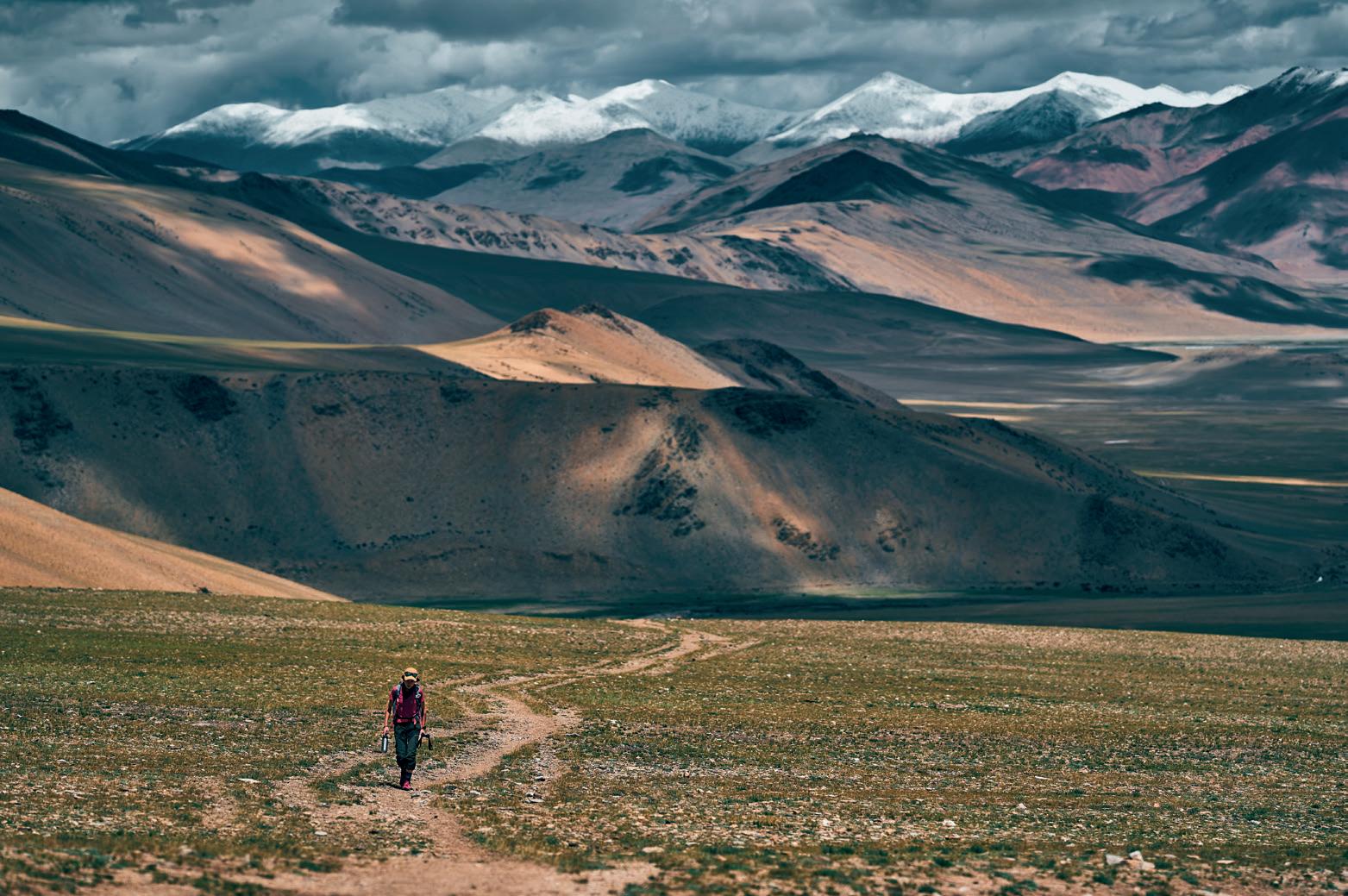


ITA
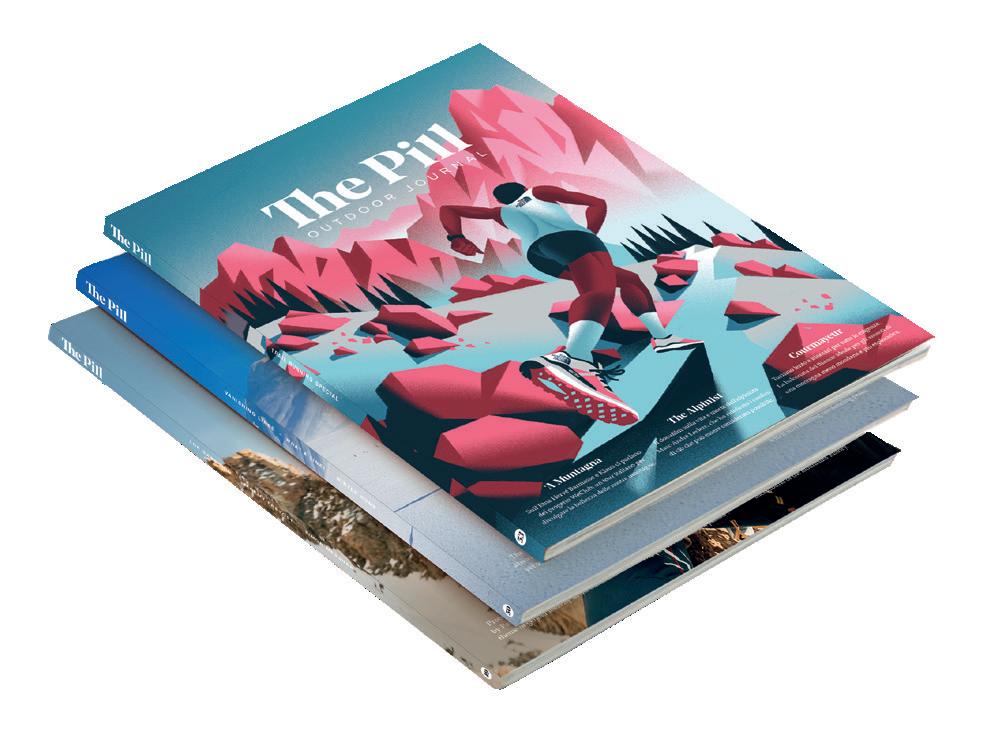
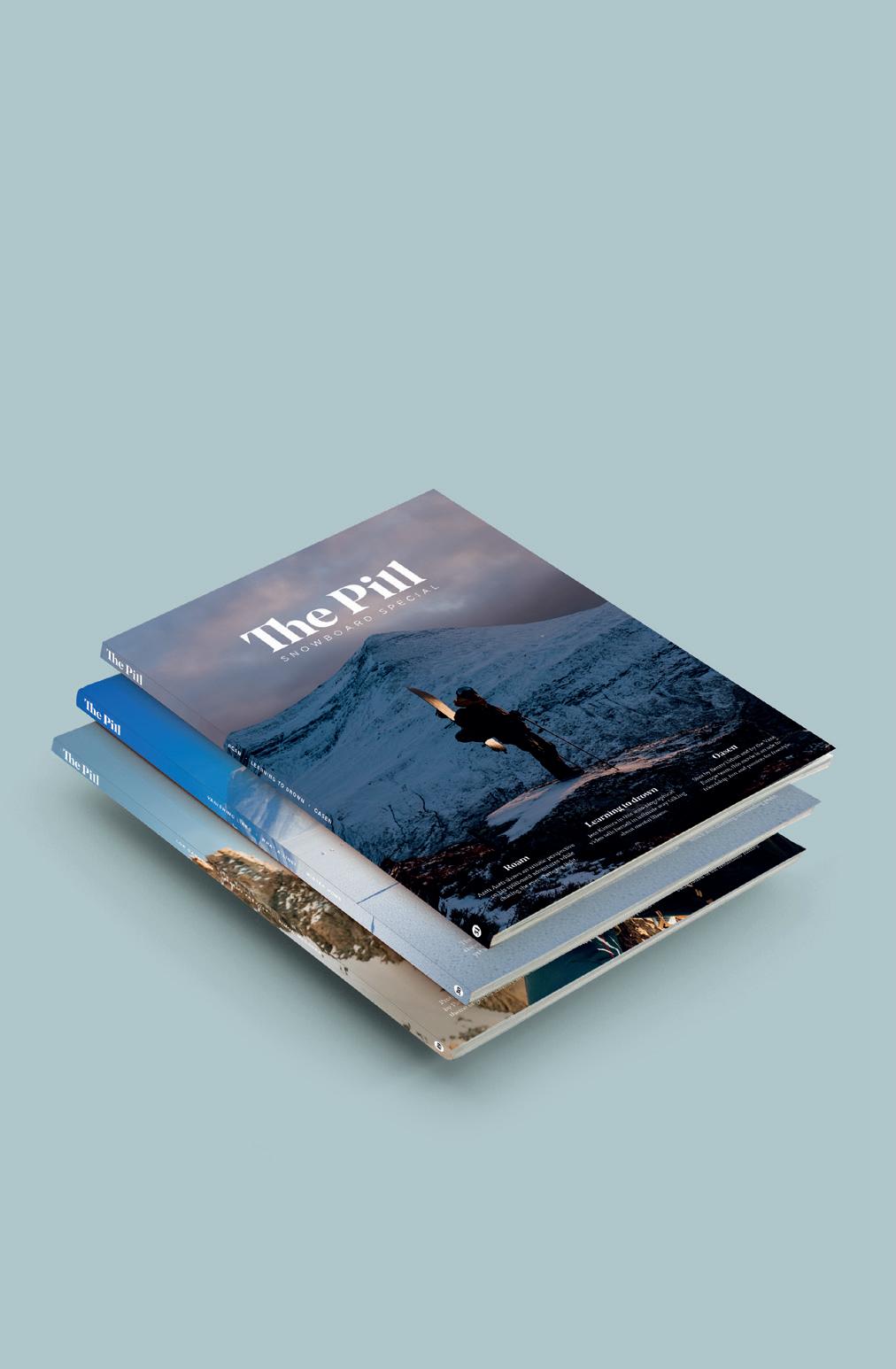
ITA ITA ITA ITA
ITA ITA
ITA ITA ITA ITA ITA ITA ITA ITA ITA ITA ITA ITA ITA ITA ITA ITA ITA ITA ITA ITA ITA ITA ITA ITA ITA
ITA ITA ITA ITA ITA ITA ITA ITA ITA ITA ITA ITA ITA ITA ITA ITA ITA ITA ITA ITA ITA ITA ITA ITA ITA ITA ITA ITA ITA ITA ITA ITA ITA ITA ITA ITA ITA ITA ITA ITA ITA ITA ITA ITA ITA ITA ITA ITA ITA ITA ITA ITA ITA ITA ITA ITA ITA ITA ITA ITA ITA ITA ITA

SANTA
D’OULX SAUZE D’OULX
SAUZE D’OULX
SELVA DI VAL GARDENA SELVA DI VAL GARDENA SELVA DI VAL GARDENA
SELVA DI VAL GARDENA SELVA DI VAL GARDENA SELVA DI VAL GARDENA SELVA DI VAL GARDENA SELVA DI VAL GARDENA SELVA DI VAL GARDENA SELVA DI VAL GARDENA SELVA DI VAL GARDENA SELVA DI VAL GARDENA SELVA DI VAL GARDENA SELVA DI VAL GARDENA SELVA DI VAL GARDENA SELVA DI VAL GARDENA SELVA DI VAL GARDENA SELVA DI VAL GARDENA SELVA DI VAL GARDENA SELVA DI VAL GARDENA SELVA DI VAL GARDENA SELVA DI VAL GARDENA SELVA DI VAL GARDENA SELVA DI VAL GARDENA SELVA DI VAL GARDENA SELVA DI VAL GARDENA SELVA DI VAL GARDENA SELVA DI VAL GARDENA SELVA DI VAL GARDENA SELVA DI VAL GARDENA SELVA DI VAL GARDENA SELVA DI VAL GARDENA SELVA DI VAL GARDENA SELVA DI VAL GARDENA SELVA DI VAL GARDENA SESTO SESTO SESTO SESTO SESTO SESTO SESTO SESTO SESTO SESTO SESTO MOSCO SESTRIERE SESTRIERE SESTRIERE SESTRIERE SESTRIERE SIUSI SIUSI SIUSI SIUSI SIUSI SIUSI SIUSI SIUSI ALLO SCILIAR SIUSI ALLO SCILIAR SOLDA SOLDA SONDRIO STRESA
TARVISIO TARVISIO TIRANO TIRANO
TREMEZZINA
VALDAORA VALDAORA VALDAORA VALDAORA VARENNA VARENNA VARENNA VERBANIA VERBANIA VERBANIA VERBANIA VERMIGLIO VERMIGLIO VIPITENO ZIANO
1607. LEADING RELAX HOTEL MARIA 1608. RESIDENCE LASTÈ 1609. RESORT DOLCE CASA 1610. HOTEL BELLAVISTA 1611. WINE HOTEL SAN GIACOMO 1612. HOTEL ALPECHIARA 1613. HOTEL PIANDINEVE 1614. SPORT HOTEL VITTORIA 1615. ALPIN HOTEL SONNBLICK 1616. HOTEL WALDHOF 1617. HOTEL BARRAGE 1618. HOTEL VILLA GLICINI 1619. HOTEL EUROPEO 1620. BEVERLY HOTEL 1621. DOLOMEET BOUTIQUE HOTEL 1622. HOTEL CRISTINA 1623. LEFAY RESORT&SPA DOLOMITI 1624. OLYMPIC PALACE 1625. BLU HOTEL ACQUASERIA 1626. GRAND HOTEL PARADISO 1627. HOTEL GARNI SORRISO 1628. HOTEL MIRELLA 1629. JOLLY RESORT&SPA 1630. RESIDENCE CLUB 1631. CHALET LA CIASETA 1632. FAMILY HOTEL GRAN BAITA 1633. HOTEL ANDA 1634. HOTEL TERME ANTICO BAGNO 1635. WELLNESS FASSA 1636. HOTEL CASTEL PIETRA 1637. FALKENSTEINER HOTEL 1638. HOTEL RUDOLF 1639. K1 MOUNTAIN CHALET 1640. MAJESTIC HOTEL & SPA RESORT 1641. PARKHOTEL SCHÖNBLICK 1642. ROYAL HOTEL HINTERHUBER 1643. GRAND HOTEL LIBERTY 1644. GRAND HOTEL RIVA 1645. HOTEL ANTICO BORGO 1646. HOTEL EUROPA 1647. HOTEL LIDO PALACE 1648. HOTEL LUISE 1649. HOTEL PORTICI 1650. HOTEL SOLE RELAX 1651. VILLA NICOLLI 1652. HOTEL LEON D’ORO 1653. HOTEL BELLERIVE 1654. HOTEL LAURIN 1655. HOTEL SALÒ DU PARC 1656. RIVALTA LIFE STYLE HOTEL 1657. HOTEL ORSO GRIGIO 1658. HOTEL VILLA STEFANIA 1659. NATURHOTEL LEITLHOF 1660. PARKHOTEL SOLE PARADISO 1661. POST HOTEL 1662. RESIDENCE SILVIA 1663. SPORTHOTEL TYROL 1664. ZIN SENFTER RESIDENCE 1665. HOTEL LA VETTA 1666. HOTEL LADINIA 1667. RENÈ DOLOMITES BOUTIQUE 1668. X ALP HOTEL 1669. HOTEL MONTE SELLA 1670. CHRISTOPHORUS MOUNTAIN 1671. HOTEL AL SONNENHOF 1672. HOTEL CHALET CORSO 1673. HOTEL CONDOR 1674. HOTEL MAREO DOLOMITES 1675. HOTEL TERESA 1676. RESIDENCE PLAN DE CORONES 1677. SPORTHOTEL EXCLUSIVE 1678. HOTEL BAITA FIORITA 1679. HOTEL RESIDENCE 3 SIGNORI 1680. HOTEL VEDIG 1681. CHABERTON LODGE 1682. HOTEL LA TORRE 1683. RELAIS DES ALPES 1684. AGRITURISMO MASO LARCIUNEI 1685. APARTMENTS SUNELA 1686. ARTHOTEL ANTERLEGHES 1687. ASTOR SUITES B&B 1688. BIANCANEVE FAMILY HOTEL 1689. BOUTIQUE HOTEL NIVES 1690. CHALET ELISABETH 1691. GRANBAITA DOLOMITES 1692. HOTEL AARITZ 1693. HOTEL ACADIA 1694. HOTEL ALPENROYAL 1695. HOTEL ANTARES 1696. HOTEL CHALET S 1697. HOTEL CONTINENTAL 1698. HOTEL DORFER 1699. HOTEL FANES 1700. HOTEL FREINA 1701. HOTEL GARNI DOLOMIEU 1702. HOTEL GENZIANA 1703. HOTEL MIRAVALLE 1704. HOTEL OSWALD 1705. HOTEL PORTILLO DOLOMITES 1706. HOTEL SOMONT 1707. HOTEL SUN VALLEY 1708. HOTEL TYROL 1709. HOTEL WELPONER 1710. LUXURY CHALET PLAZOLA 1711. MOUNTAIN DESIGN HOTEL 1712. MOUNTAIN HOME VILLA ANNA 1713. RESIDENCE ISABELL 1714. RESIDENCE VILLA FUNTANES 1715. RESIDENCE VILLA GRAN BAITA 1716. THE LAURIN SMALL&CHARMING 1717. WELLNESS RESIDENCE VILLA 1718. RESIDENCE VILLA AL SOLE 1719. HOTEL TRE CIME SESTO 1720. ALPENWELLNESSHOTEL ST.VEIT 1721. APARTMENTS RIEGA 1722. BERGHOTEL SEXTEN 1723. CIMA DODICI B&B 1724. FAMILY RESORT RAINER 1725. HOTEL ALPENBLICK 1726. HOTEL DOLOMITENHOF 1727. HOTEL MONIKA 1728. HOTEL MONTE CROCE 1729. BAD MOOS 1730. GRAND HOTEL SESTRIERE 1731. HOTEL CRISTALLO 1732. HOTEL IL FRAITEVINO 1733. HOTEL SHACKLETON MOUNTAIN 1734. PRINCIPI DI PIEMONTE 1735. ACTIVEHOTEL DIANA 1736. ARTNATUR DOLOMITES HOTEL 1737. HOTEL WALDRAST DOLOMITI 1738. MIRABELL ALPINE GARDEN 1739. NATUR RESIDENCE 1740. SCHWARZER ADLER 1741. SENSORIA DOLOMITES 1742. DOLMITES NATURE 1743. BAD RATZES 1744. HOTEL CEVEDALE 1745. PARADIES MOUNTAIN RESORT 1746. GRAND HOTEL DELLA POSTA 1747. GRAND HOTEL BRISTOL 1748. GRAND HOTEL DES ILES 1749. HOTEL ASTORIA 1750. HOTEL LA PALMA 1751. HOTEL MILAN SPERANZA 1752. HOTEL REGINA PALACE 1753. HOTEL EDELHOF 1754. HOTEL IL CERVO 1755. CURT DI CLEMENT ECO 1756. HOTEL CENTRALE 1757. HOTEL DOSSES 1758. ALPINHOTEL VAJOLET 1759. GRAND HOTEL TREMEZZO 1760. HOTEL LENNO 1761. ALBERGO ACCADEMIA 1762. BOUTIQUE EXCLUSIVE B&B 1763. GRAND HOTEL TRENTO 1764. HOTEL AMERICA 1765. HOTEL BUONCONSIGLIO 1766. BÄRENHOTEL 1767. BERGHOTEL HOTEL 1768. HOTEL CHRISTOPH 1769. KRONPLATZ-RESORT 1770. HOTEL DU LAC 1771. HOTEL ROYAL VICTORIA 1772. HOTEL VILLA CIPRESSI 1773. GRAND HOTEL MAJESTIC 1774. HOTEL ANCORA 1775. HOTEL BELVEDERE 1776. HOTEL PALLANZA 1777. GRAND HOTEL MIRAMONTI 1778. HOTEL DELLE ALPI 1779. HOTEL RESTAURANT LILIE 1780. WELLNESS PARADISE MOENA MOENA MOENA MONTEBELLUNA PADERNO DEL GRAPPA PALLEUSIEUX PASSO DEL TONALE PASSO DEL TONALE PERCA PERCA PINEROLO PINEROLO PINZOLO PINZOLO PINZOLO PINZOLO PINZOLO PINZOLO PONTE DI LEGNO PONTE DI LEGNO PONTE DI LEGNO PONTE DI LEGNO PONTE DI LEGNO PONTE DI LEGNO POZZA DI FASSA POZZA DI FASSA POZZA DI FASSA POZZA DI FASSA POZZA DI FASSA PRIMIERO RISCONE RISCONE RISCONE RISCONE RISCONE RISCONE/BRUNICO RIVA DEL GARDA RIVA DEL GARDA RIVA DEL GARDA RIVA DEL GARDA RIVA DEL GARDA RIVA DEL GARDA RIVA DEL GARDA RIVA DEL GARDA RIVA DEL GARDA ROVERETO SALÒ SALÒ SALÒ SALÒ SAN CANDIDO SAN CANDIDO SAN CANDIDO SAN CANDIDO SAN CANDIDO SAN CANDIDO SAN CANDIDO SAN CANDIDO SAN DOMENICO SAN GIOVANNI DI FASSA SAN GIOVANNI DI FASSA SAN GIOVANNI DI FASSA SAN VIGILIO DI FAREBBE SAN VIGILIO DI MAREBBE SAN VIGILIO DI MAREBBE SAN VIGILIO DI MAREBBE SAN VIGILIO DI MAREBBE SAN VIGILIO DI MAREBBE SAN VIGILIO DI MAREBBE SAN VIGILIO DI MAREBBE SAN VIGILIO DI MAREBBE
CATERINA SANTA CATERINA SANTA CATERINA SAUZE
STRESA STRESA STRESA STRESA STRESA
TIRES TIRES
TREMEZZINA TRENTO TRENTO TRENTO TRENTO TRENTO
DI FIEMME
ITA ITA ITA ITA ITA ITA ITA ITA ITA ITA
ITA ITA ITA
ITA ITA ITA
ITA ITA ITA ITA ITA ITA ITA ITA ITA ITA ITA ITA ITA ITA ITA ITA ITA ITA ITA ITA ITA ITA ITA ITA ITA ITA ITA ITA ITA ITA ITA ITA ITA ITA ITA ITA ITA ITA ITA ITA ITA ITA ITA ITA ITA ITA ITA ITA ITA ITA ITA ITA ITA ITA ITA ITA ITA ITA ITA ITA ITA ITA ITA
To you want The Pill in your store or hotel? That’s easy hello@thepilloutdoor.com SUBSCRIBE RECEIVE THE PILL DIRECTLY TO YOUR DOORSTEP #SUPPORTYOUROUTDOORJOURNAL LINKTR.EE/ABBONAMENTI
LAST WORD
BY DAVIDE FIORASO PHOTO CHIARA GUGLIELMINA
Eisenhower said that “What is urgent is seldom important and what is impor tant is seldom urgent.”
Urgency now seems to be an inesca pable condition. If the clock measures time, the ur-gency flattens its passing. Urgency to speak, to work, to leave, to arrive, with the result of losing the op portunity for reflection, the need for a thoughtful choice, the need for work done calmly. In marketing, urgency
is the language that today guides the "creators of need", whose victims are often unwitting consumers. Whoever is capable of constructing "situations of urgency" holds the power to decide for the other people. If you can create a strong sense of urgency, then you can easily get consumers to do and buy what you want. Yes, because the strategies to create urgency elimina te the so-called cognitive friction, the mechanism by which we tend to
think and reflect adequately.
Acting under the pressure of urgency is not a sign of efficiency or even spe ed. The result is often the one of Pi nocchio, who always takes the wrong one between two paths, blind and deaf to the voices and reflections that necessarily take time.
When everything is urgent, probably nothing is (really) important.

160
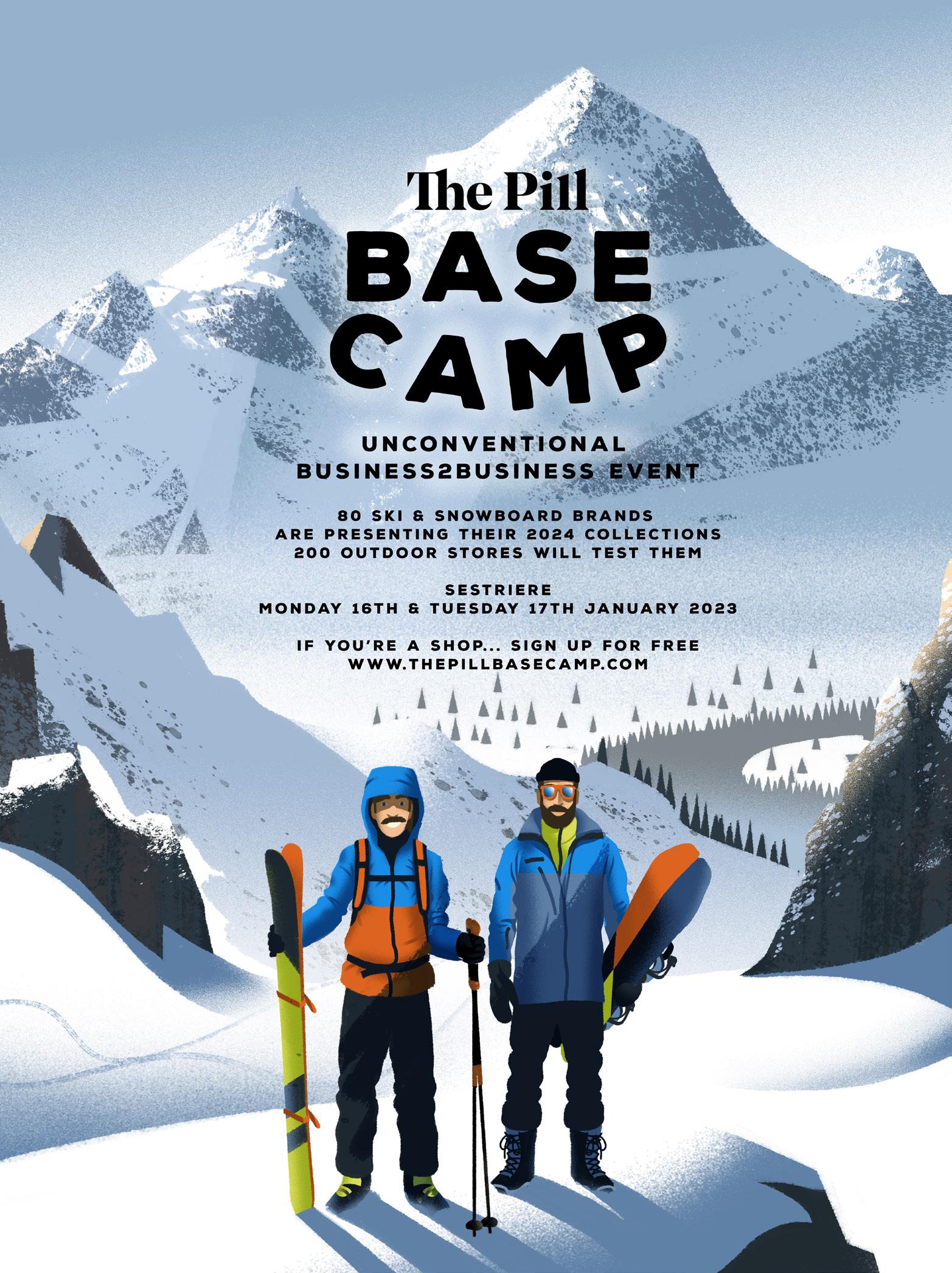
ON YOUR BEST FRIENDS

ORTLES GORE-TEX ® PRO STRETCH JACKET THE ORTLES FAMILY RELY




 Christina Lusti / Baffin Island
Christina Lusti / Baffin Island

































































































 BY LUDOVICA SACCO
BY LUDOVICA SACCO

































































 BY DENIS PICCOLO
BY DENIS PICCOLO



 BY LUDOVICA SACCO
BY LUDOVICA SACCO

























 PHOTOS JOSE MIGUEL MUNOZE
PHOTOS JOSE MIGUEL MUNOZE







 BY FILIPPO CAON
BY FILIPPO CAON





 Through the Forest
Through the Forest





























 BY FILIPPO CAON PHOTOS ALICE RUSSOLO
BY FILIPPO CAON PHOTOS ALICE RUSSOLO

















 BY LUCA DALMASSO PHOTOS DANIELE BOFFELLI & DANIELE MOLINERIS
BY LUCA DALMASSO PHOTOS DANIELE BOFFELLI & DANIELE MOLINERIS

































 BY FILIPPO CAON PHOTOS ALEXIS BERG
BY FILIPPO CAON PHOTOS ALEXIS BERG










 BY CHIARA GUGLIELMINA
BY CHIARA GUGLIELMINA
















